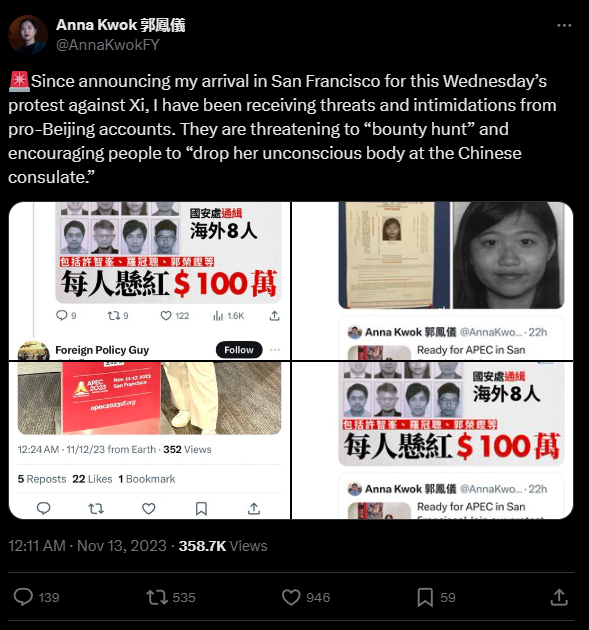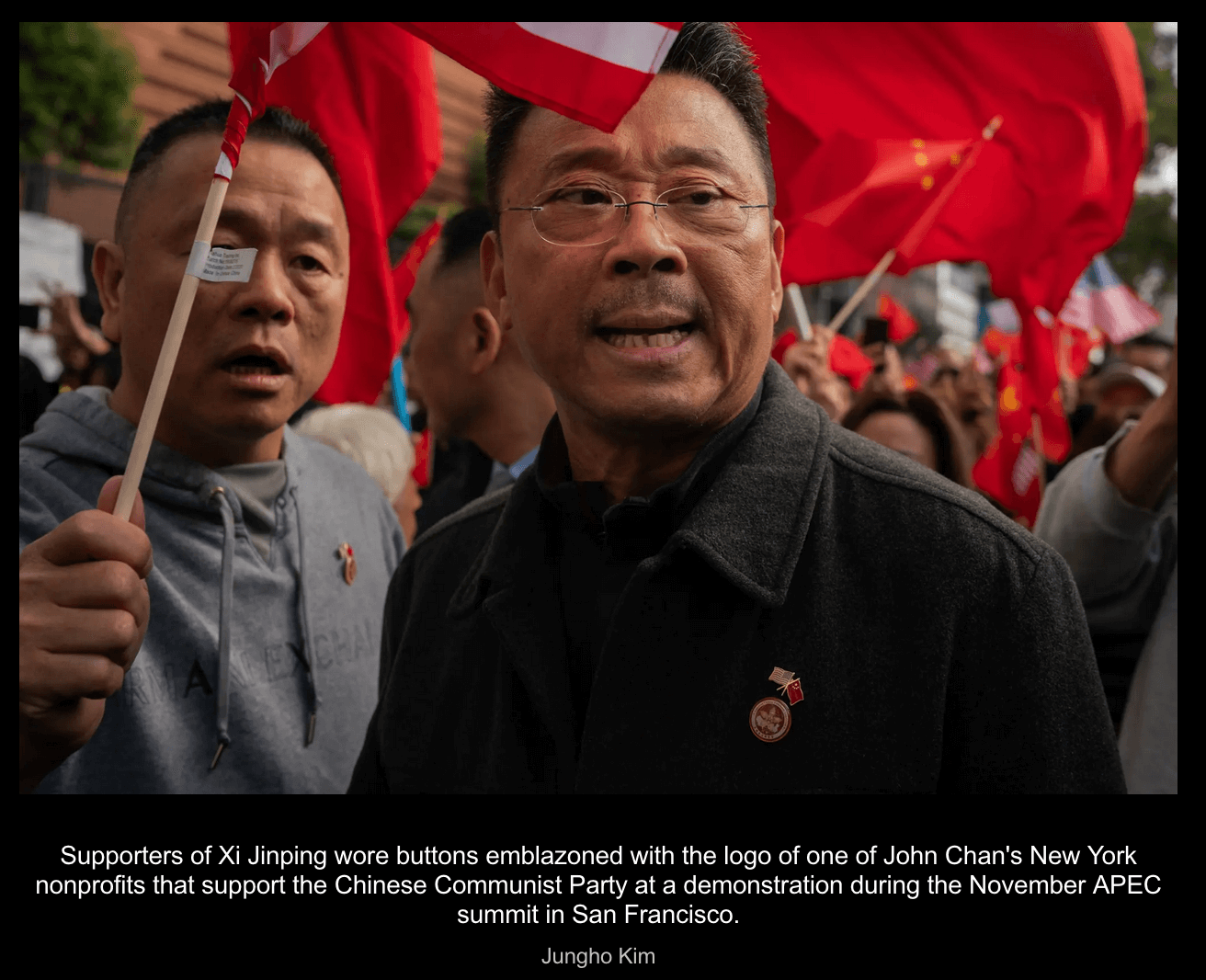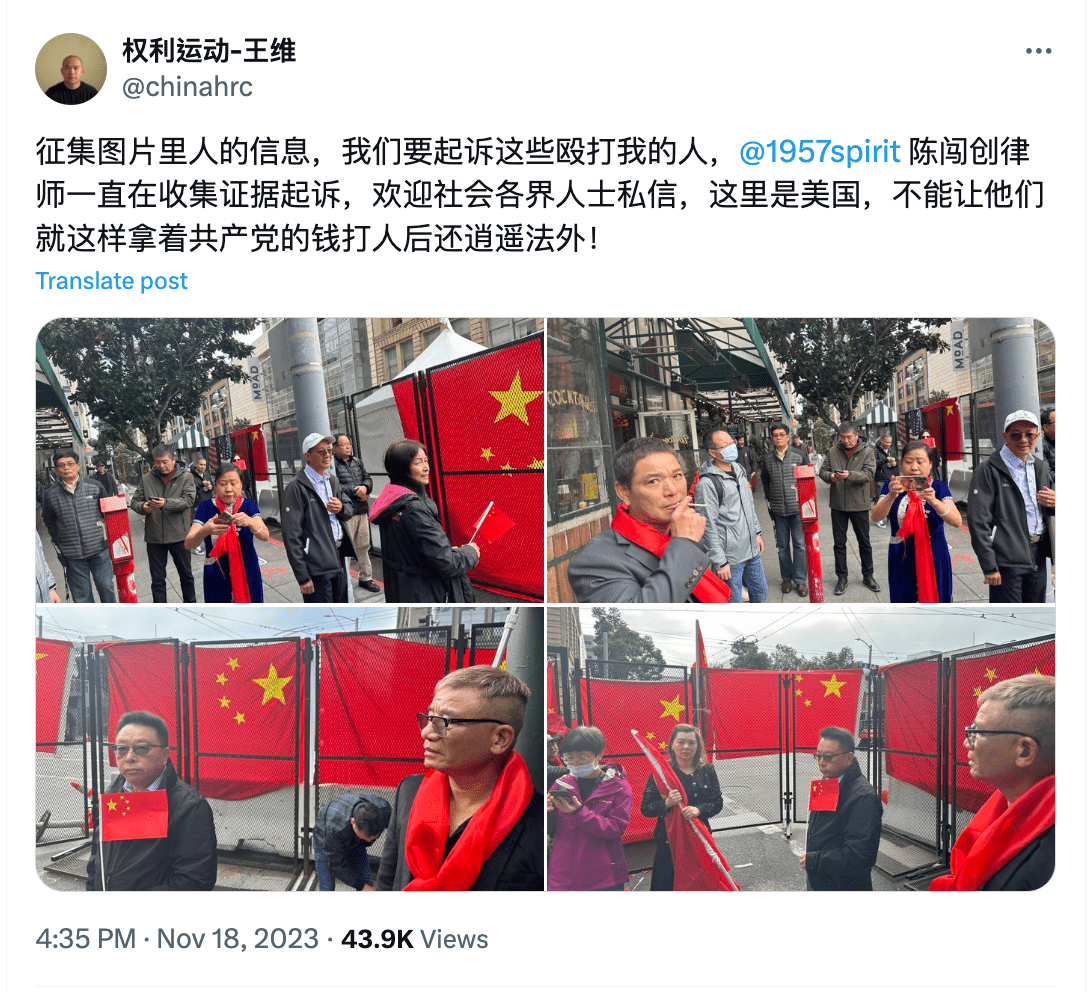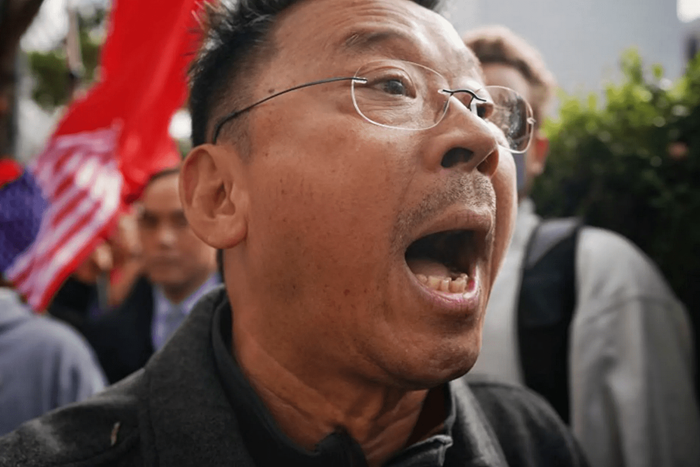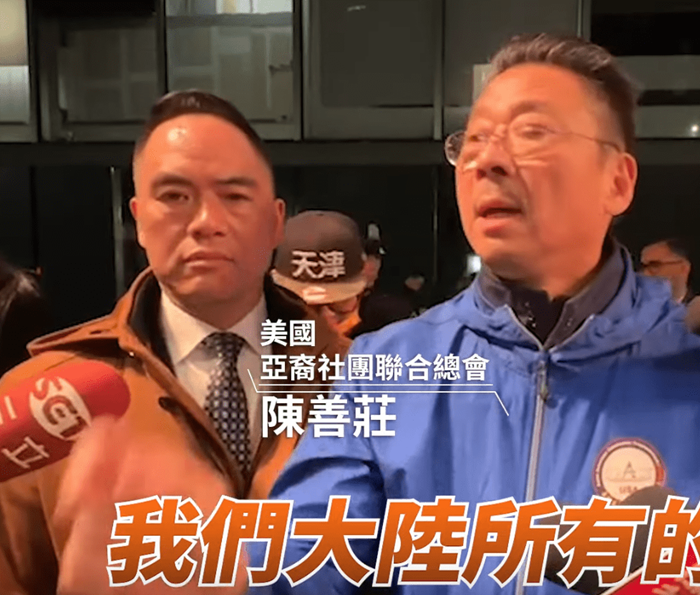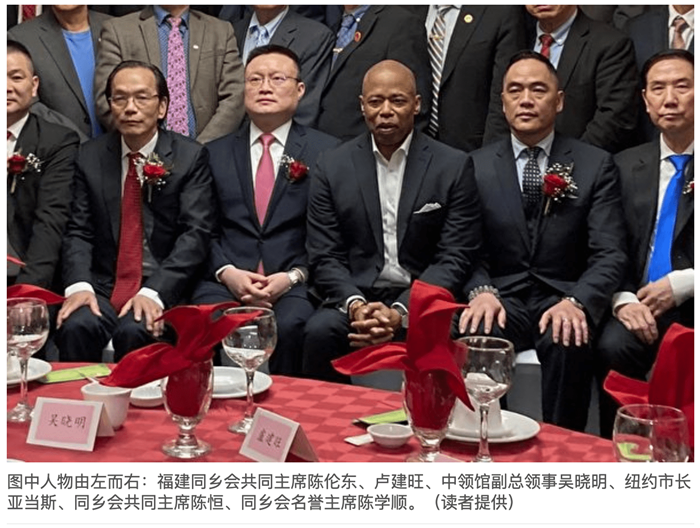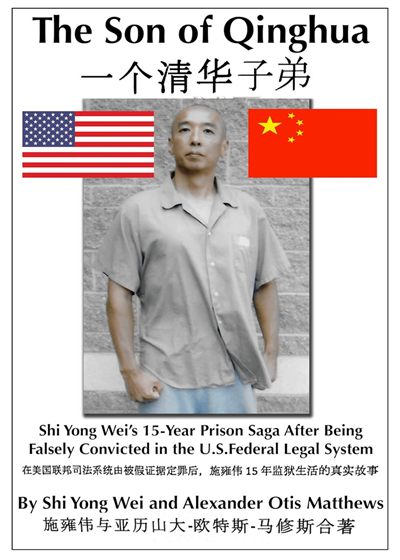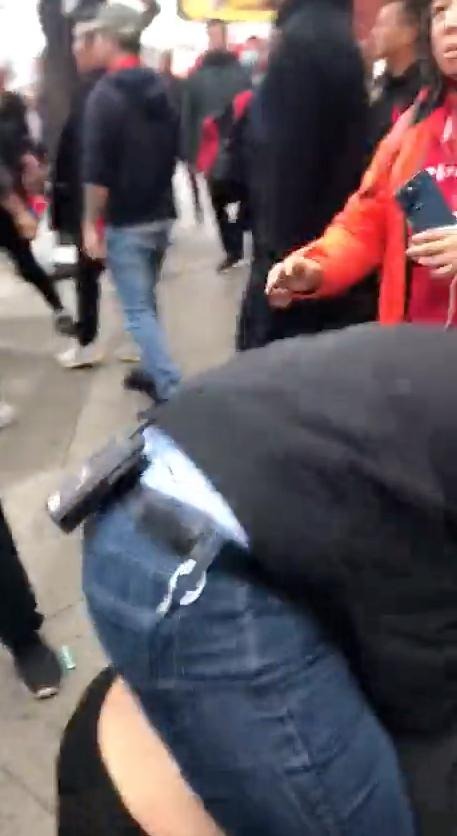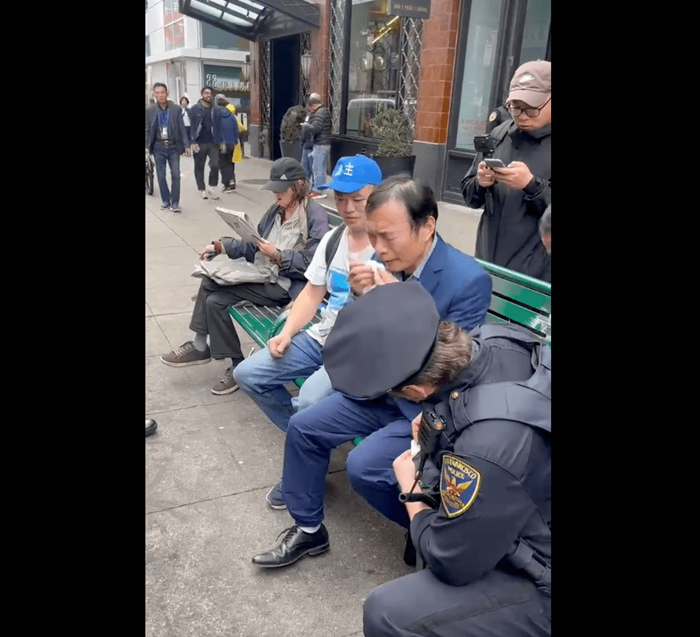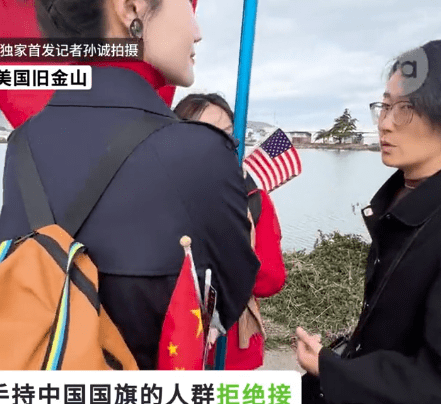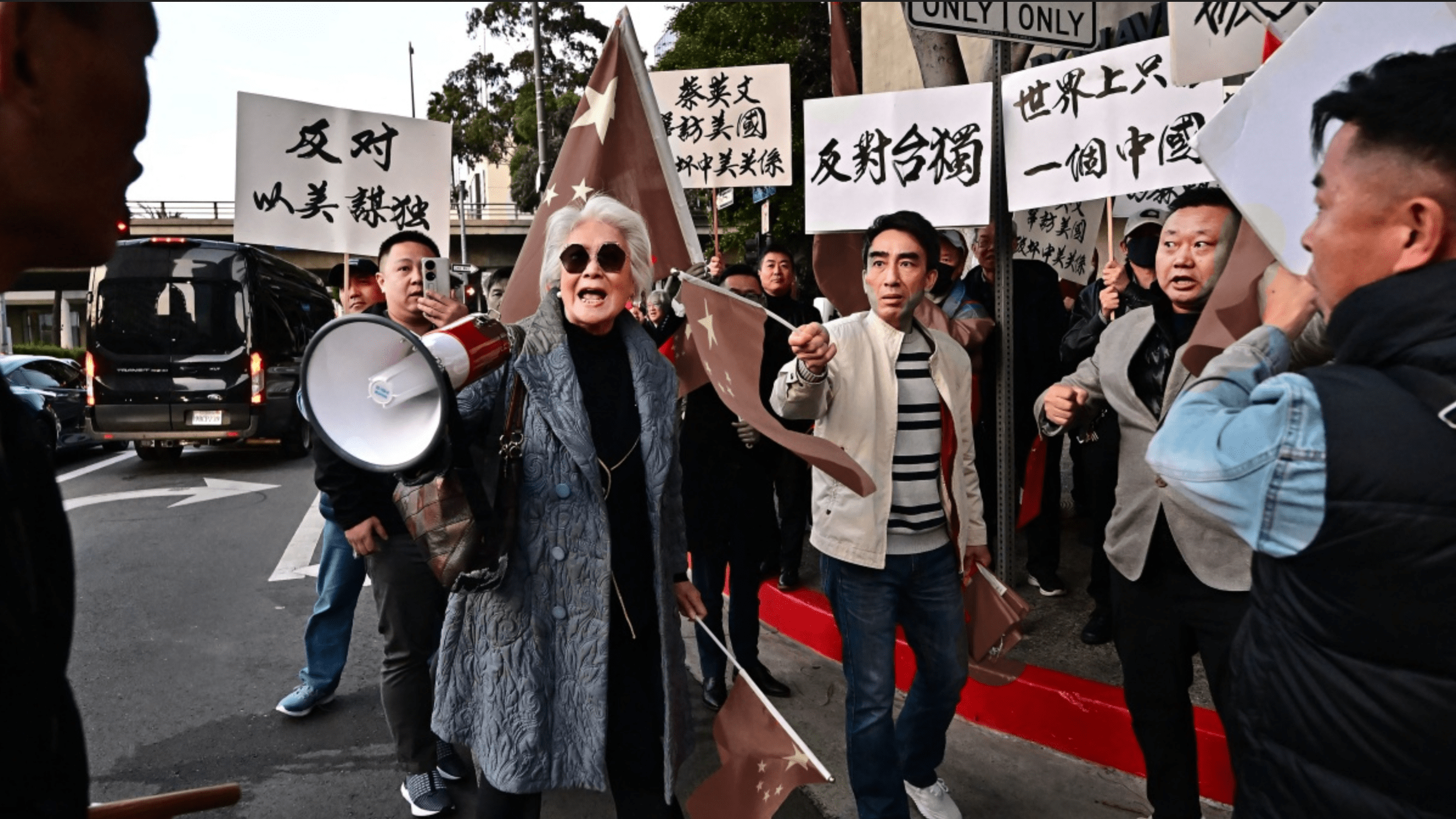Foreword
On November 15, 2012, Xi Jinping stood before thousands of members of the Chinese Communist Party in his first public speech as the leader of the unfree world. He vowed to fulfill one ultimate goal: the “great revival of the Chinese nation.” During the 11 years between the day Xi gave that speech and the day he attended the dinner hosted by US-China Business Council and National Committee on US-China Relations in San Francisco on November 15th, 2023, Xi’s repressive, hardline policies have changed China beyond recognition, for the worse.Under Xi’s reign of terror, the National Security Law imposed by the CCP in 2020 has eradicated any semblance of democracy in Hong Kong. Thousands of bright student leaders, brave youth activists, opposition politicians, and journalists have been arrested. As of May 31, 2024, Hong Kong Democracy Council’s database had documented 1,875 political prisoners in Hong Kong. In occupied Tibet, a vast system of colonial boarding schools has separated over 80 percent of Tibetan students from their parents. Along with other extreme attacks on Tibetan identity, these policies threaten the very continuation of Tibet’s language, culture, and way of life.
But the CCP has shown that its ambitions extend much further: over the past decade, China has invested great effort in strengthening its long arm of control through tactics of transnational repression. In November 2023, on the streets of San Francisco, this transnational repression took the form of alarming cases of physical violence and harassment by organizations and individuals affiliated with the Chinese government, aimed at intimidating and discouraging activists from confronting Xi during his visit. Countries around the world have identified China’s transnational repression as a direct threat to freedom everywhere, yet there remains a significant gap between rhetoric and action. This report by Hong Kong Democracy Council and Students for a Free Tibet emphasizes the urgency of enacting meaningful measures against transnational repression. Each case outlined in this report represents a brazen attempt by the Chinese government to stamp out dissent in broad daylight on American soil.
As masked thugs with metal poles openly roamed the streets of San Francisco, Tibetans, Hong Kongers, Uyghurs, and Chinese democracy activists, some as young as 16 years old, were often left to fend for themselves. Rather than hopelessness, though, what we witnessed was the sheer grit and resilience of our communities: a determination by activists and human rights defenders to exercise our right to free speech and peaceful protest. We saw young people using creative tactics to outsmart one of the world’s best resourced authoritarian governments, while documenting everything along the way. Activists used mass group chats and buddy systems, Hong Kongers shared useful tips gleaned from their dark experiences protesting in the streets of Hong Kong, and Tibetans spread their resilient sense of community developed through decades of organizing in exile.
During the 11 years since Xi took power, while he has relentlessly chipped away at any remaining spaces to advance democracy and freedom, community organizers and youth activists fighting against China’s colonial rule have learned one crucial lesson: we can stand together, or perish alone. In our shared struggle, we bring our cross-movement spirit from the streets of San Francisco to this report. Hong Kong Democracy Council and Students for a Free Tibet jointly publish “Exporting Repression: Attacks on Protesters During Xi Jinping’s Visit to San Francisco in November 2023.”
HKDC Executive Director Anna Kwok and SFT Executive Director Pema Doma
July 30, 2024
Executive Summary
This report documents acts of transnational repression (TNR) carried out by supporters of the Chinese Communist Party (CCP) against protesters during the visit to San Francisco in November 2023 of Xi Jinping, President of the People’s Republic of China. In all, 34 cases of harassment, intimidation, and assault are presented.
The report shows the mobilization and involvement of the CCP’s “united front” network in the United States (US). In many cases, united front groups and figures were present during acts of assault, intimidation, and harassment, and some actively participated in them. The report also documents coordination among CCP supporters that suggests direction and planning. Their actions created a pervasive atmosphere of intimidation that not only had a deterrent effect on protests throughout the duration of Xi’s stay but also interfered with protesters’ exercise of their free speech rights.
Most of the victims of the attacks were American citizens and residents, and all but one of the victims of the attacks had roots in China, East Turkestan, Hong Kong or Tibet. All were targets of TNR in San Francisco for demonstrating their opposition to Xi and the CCP. Some had previously been targets of repression in their homelands, or targets of CCP TNR, or both.
The report also examines the response mechanisms of US policymakers and law enforcement authorities at both federal and local levels. Despite strong awareness of CCP TNR at the federal level and a general commitment to countering it, agencies were unprepared to do so in San Francisco. Local law enforcement authorities exhibited a lack of awareness of TNR, were often unresponsive when alerted to the attacks, and took little and inadequate action in response to the attacks. The result was that protesters were insufficiently protected and perpetrators have not been held accountable.
This report makes 18 recommendations to the White House, relevant federal agencies, Congress, state and local authorities, and the United Nations, and includes the following recommendations:
- Investigate whether united front groups in the US are acting as unregistered foreign agents of the PRC in violation of the Foreign Agents Registration Act.
- Implement additional vetting for diplomatic visas issued to PRC applicants and screening for applicants connected to TNR activities.
- Offer protection to groups on US soil that are subject to TNR, including by expediting asylum cases and upgrading the existing Deferred Enforced Departure program for Hong Kongers to a Temporary Protected Status (TPS) designation.
- Pass legislation creating resources to combat TNR, such as the Transnational Repression Policy Act (H.R. 3654/S.831), the Stop Transnational Repression Act (H.R. 5907), the Combating Transnational Repression Act of 2024 (H.R. 7443), the Law Enforcement Support and Transnational Repression Hotline Act (H.R. 7433), and the Strengthening State and Local Efforts to Combat Transnational Repression Act (H.R. 7439).
- Maintain relations with a diversity of Asian American, Native Hawaiian, and Pacific Islander (AANHPI) groups representing different political views and identities and conduct due diligence on these groups’ backgrounds.
Methodology
This report is based primarily on the testimonies of 26 protesters and one journalist who were present in San Francisco during Xi Jinping’s visit from November 14 to 17, 2023, as well as on video and photographic evidence provided by protesters. Media reports and social media posts have also been of some assistance.
We have attempted to document all cases of harassment and intimidation of and assault on protesters that we came across. All cases described in detail have been substantiated by testimonies of participants and witnesses and/or video and photographic evidence.
We have attempted to identify those involved in attacks on protesters through the use of open-source research and facial recognition technology.
We have identified some groups and individuals as belonging to the Chinese Communist Party’s “united front,” meaning that evidence was found indicating that they have associated with Party organs and/or officials and/or representatives of the People’s Republic of China, and have taken actions aligned with the Party’s agenda. In most cases that evidence was found in reporting by Chinese-language media and on websites of Party organs or united front groups.
We have attempted to contact all of those identified in the report as CCP supporters as well as private security firms perceived to be associated with CCP supporters through email, telephone calls and letters. We notified them that they are mentioned in the report, asked if we might ask them some questions, and offered them the opportunity to respond and comment. As of May 15, 2024, most have not responded. None has responded affirmatively. In many cases, these groups and individuals have little to no online presence or website. Many of the email addresses and phone numbers they have made available online or in tax documents proved to be incorrect, out of date, or inoperative. In the first instance, we contacted them by telephone or email at the numbers and addresses that could be found. Where that did not succeed, and in cases where post addresses could be found, we sent letters to them. Only two could be reached by phone. Both made clear they did not wish to speak with us. One responded to email inquiries. None responded to letters. Of those identified in the report as being present on the streets of San Francisco during Xi’s visit, we have not been able to find contact information for three leaders of united front groups, one CCP member based in the PRC, and one convicted felon with no known united front leadership position.
We have also reached out to the San Francisco Police Department, the South San Francisco Police Department, and the San Mateo Sheriff’s Office for information and comment.
Where we have received responses, we have included those in the report.
The URLs of sources cited in the report were operative as of April 4, 2024. They were also saved at Internet Archive on or before that date.
Introduction
In November 2023, Xi Jinping, President of the People’s Republic of China (PRC), came to San Francisco to attend the Asia-Pacific Economic Cooperation (APEC) summit and meet United States (US) President Joe Biden. During Xi’s stay in the city from November 14 to 17, hundreds of Chinese, Hong Kongers, Tibetans, and Uyghurs demonstrated against Xi and the CCP’s harsh crackdown in their homelands.1 Dozens of protesters were harassed, intimidated, and assaulted. These attacks were carried out by CCP supporters or those acting on their behalf in what appeared to be an organized and coordinated manner. Leaders of united front groups in the US that have been linked to the CCP were involved in the attacks. The attacks constitute transnational repression (TNR) as they targeted opponents of the CCP in the US. Although the US government has identified countering TNR as a top priority, awareness and preparation on the part of law enforcement authorities in San Francisco appeared inadequate.2
This report describes the attacks on protesters in detail and is based primarily on interviews and testimonies of 26 protesters and one journalist, most of whom were victims of harassment, intimidation, and assault, as well as on photographic and video evidence. It highlights the attacks as a serious instance of transnational repression. It also identifies united front figures involved in the attacks. The report calls on the US government as well as local governments and law enforcement authorities at both the federal and local levels to identify shortcomings and improve efforts to:
- prevent and counter transnational repression;
- protect the rights of protesters and human rights defenders; and
- hold perpetrators of transnational repression accountable.
The protesters were from different backgrounds. Most have their origins in China, East Turkestan, Hong Kong, and Tibet. Many are American citizens, and almost all reside in the US. This is a story that needs to be told because it is part of the history of these peoples—Chinese, Hong Kongers, Tibetans, Uyghurs—fighting for their freedom and their human rights, but it also needs to be told to assist authorities in the US and other countries to more effectively counter CCP transnational repression on their own soil.
At the center of the report is a detailed, chronological narrative of the attacks perpetrated by CCP supporters on protesters while Xi Jinping visited San Francisco. Preceding that are brief sections on the CCP and its overseas united front and on the US government’s prioritization of countering TNR in general and CCP TNR specifically. Following the chronological narrative are sections on responses and reactions to the attacks in San Francisco, analysis, and recommendations.
The CCP and Its Overseas United Front
In order to understand the transnational repression that took place in San Francisco, it is important to understand the network of organizations that enabled the repression and appeared to coordinate in organizing it.
The CCP puts enormous effort and resources into exerting influence and control over what it considers to be Chinese diaspora communities around the world, including not just Chinese immigrants and their families but also Hong Kongers, Taiwanese, Tibetans, and Uyghurs living abroad.
These efforts to control diaspora communities are closely tied to the CCP concept of the “united front” (統一戰線), the idea that the cultivation of support of and loyalty to the Party at home and abroad is central to maintaining the CCP’s power. To that end, the CCP employs both a set of directly-controlled party organs and a larger number of loosely linked overseas groups to carry out its united front strategy. In practice, the term “united front work” (統戰工作) is used rather elastically and can refer to activities carried out by both official agencies and informally associated overseas groups.3
United Front: Main Organs and Overseas Affiliates
Though these types of organizations are often grouped together as part of a loosely-defined “CCP united front,” this report takes care to differentiate between the two:
Specifically, this report uses the term “united front” (capitalized) to denote organizations which are constituent parts of the Chinese Communist Party, fully folded into Party infrastructure and directly controlled and operated by CCP authorities. On the other hand, this report uses the term “united front” (lowercase letters) to describe overseas groups which may not necessarily have formal ties with the CCP and its united front agencies, but are often used to carry out the CCP’s agenda.
The united front Work Department (中共中央統一戰線工作部/UFWD) is the CCP organ formally in charge of the CCP’s united front strategy. Its work is supplemented by that of the All-China Federation of Returned Overseas Chinese (中華全國歸國華僑聯合會/ACFROC), a key united front organization that, in 2018, was designated by the CCP as the main organ responsible for relations with overseas Chinese.4 ACFROC maintains provincial and municipal offices within the PRC that help maintain relations with Chinese expatriates from these localities. This report documents several connections between members of united front groups and local ACFROC offices.
PRC embassies and consulates also play a key role in cultivating united front groups overseas, often providing them with guidance and direction at key junctures. This report documents many instances in which key figures in united front groups met with or participated in events together with high-ranking PRC consulate officials.
Typically, CCP officials overseeing united front groups prefer that they preserve a facade of autonomy from CCP united front organs like the UFWD and ACFROC, as well as from PRC consulates. As noted by Anne-Marie Brady, an academic and expert on the overseas united front, the CCP “wants to avoid being seen to ‘lead’ [領導] the overseas Chinese community, but rather prefers to be seen to ‘guide’ [引導] them.”5
In actuality, however, united front groups rarely if ever deviate from the CCP’s official stance on any matter. Generally speaking, CCP united front officials strive to create a situation where overseas united front groups will know the Party’s will and do the Party’s bidding without requiring official direction or supervision. Brady notes that “[t]he goal of successful overseas Chinese work is to get the community to proactively and even better, spontaneously, engage in activities which enhance China’s foreign policy agenda.”6
Because of this strategy, civic organizations in diaspora communities may have united front links. united front groups may take the form of hometown associations, business associations, Chinese Students and Scholars Association chapters at foreign universities, or associations for the so-called “peaceful reunification of China” (the CCP’s preferred term for its efforts to bring Taiwan under CCP rule). Groups of this nature tend to display strong signs of united front links, and often have members who maintain close communication with CCP united front organs and appear at public events with PRC officials.
These groups also often seek to cultivate relations with politicians and officials—especially local politicians and officials—in the countries in which they operate, claiming to broadly represent the political views and concerns of the “Chinese community” or even the “Asian community,” crowding out a far more diverse representation of voices, especially those with views different from the CCP’s. In the US, local politicians and officials often meet these united front groups without appearing to be aware of their links to the CCP. While there is no official public list of united front organizations, organizations that exhibit many of the characteristics mentioned above appear frequently in this report as they and their leaders were present on the streets of San Francisco during Xi Jinping’s visit.
Additionally, many Chinese-language media outlets which are widely read in diaspora communities are nowadays controlled or influenced to one extent or another by the CCP or by businesses and interests loyal to the CCP.7 As such, they too may be considered part of a broader united front strategy. Much of the information about united front groups found in this report comes from pro-CCP Chinese-language diaspora media.
United Front: Understanding its Goals through the 1989 Tiananmen Massacre, 2008 Beijing Olympics, and 2019 Hong Kong Pro-Democracy Protests
While CCP efforts to cultivate the loyalty of overseas Chinese to the regime date back to the founding of the PRC in 1949 and even before, the current objectives of CCP united front work are multifaceted. The development of these new objectives can be traced to the 1989 Tiananmen Massacre, which marked a turning point in CCP relations with the diaspora.
In 1989, many overseas Chinese were shocked and outraged by the Tiananmen Massacre on June 4. The CCP realized it had a significant problem on its hands: criticism and doubts about the regime’s legitimacy were widespread at home and abroad. The political crisis led the CCP to increase its efforts to cultivate the loyalty of groups in Chinese-origin communities abroad, with the goal of securing the CCP’s political power among overseas Chinese.
The 1990s in particular, but also the following decades, have been a boom time for the development of the united front in the US. This development coincided with increased migration from the PRC to the US and a large increase in the number of Chinese students at US universities. Recent migrants and Chinese students became the main targets of united front work and often the main groups tasked with carrying it out. The PRC also experienced rapid economic growth in this period, allowing the CCP to exert greater influence around the world, including on diaspora communities.
While the earlier model of united front work focused on securing the CCP’s political power and exerting the CCP’s influence, the united front work this report examines in San Francisco includes a broader range of goals; among them, astroturfing public support for the CCP in the United States and neutralizing public displays of opposition.
These objectives of CCP united front work have been observed as far back as the 2008 global Olympic torch relay.8 The CCP considered the Beijing Olympics of 2008 as China’s grand coming-out to the world, and its global Olympic torch relay the glorious prologue. Therefore, when large numbers of protesters turned out during early stops on the torch’s tour and seriously damaged the effectiveness of the propaganda campaign, the CCP rapidly mobilized united front groups in Australia and Japan to ensure that the same wouldn’t happen in those places. The torch relay in San Francisco was also targeted for united front mobilization. These mobilized united front groups gathered to display overseas support for CCP leadership and to identify, manage, and neutralize any signs of opposition to CCP leaders and policies (i.e., protests).
The CCP regarded these efforts as so successful that they still serve as the template for overseas public events the CCP considers to be related to its core interests, such as foreign visits of top Party leaders and sovereignty over East Turkestan, Hong Kong, Taiwan and Tibet.
It is important to the CCP that it hide its controlling hand in the mobilization of overseas support. For the global Olympic torch relay stops in Australia and Japan in 2008, CCP officials and their agents initially boasted of their mobilization efforts, but when the Party began to perceive an international media backlash amid accusations of “rent-a-crowds,” it did what scholar James Jiann Hua To referred to as a “public ‘about face’ on openly supporting” these groups. Consequently, according to To, Chinese state media reports “emphasized that students had mobilized themselves and established the rallies at their own will,” and statements by PRC officials either “denied any involvement or deflected questions surrounding the embassies’ provocation of [overseas Chinese] nationalism. Furthermore, student groups were instructed to deny any links between the rallies and the embassy…”9 Since then, the same denial has followed countless welcoming parades and events.
The mass protests in Hong Kong in 2019 were another moment when the CCP felt its political leadership challenged and threatened, not just in Hong Kong but globally. Hong Kongers around the world showed support for the protests, with demonstrations in dozens of cities. The CCP mobilized the united front to counter these protests. According to a report by Alliance Canada Hong Kong, threats against and harassment of Hong Kong demonstrators were reported in 25 cities worldwide, including Australia, New Zealand, Japan, Germany, Denmark, France, the United Kingdom, Ireland, Canada and the US.10
This report describes a repeating pattern of attacks on protesters during Xi Jinping’s 2023 visit to San Francisco. This pattern is defined by the following aspects:
- united front groups and figures involved in the CCP-supporting and counter-protest efforts are non-state actors. While their exact relation to the CCP as an institution may be somewhat vague or unclear, they are not formally, openly, or explicitly incorporated into Party structures. In other words, the CCP is effectively “outsourcing” repressive actions.
- There are clear and well-documented connections between (i) the state organs of the PRC such as embassies and consulates, (ii) united front organs that are formal parts of CCP infrastructure in the PRC, and (iii) overseas united front groups that are informally connected to the party structure.
It is worth noting that while the pro-CCP public assemblies “welcoming Xi” were intended to present a peaceful face of “patriotic” support for China and for good relations between China and the US, in fact their motives also involved neutralizing any manifestation of opposition to Xi or the CCP. The strong motive to neutralize dissent has led to repressive actions including of harassment, intimidation, and assault, and as such, has resulted in acts of transnational repression. It is further worth noting that not all individuals associated with these groups participated in harassment, intimidation and assault.
Attacks on Protesters as a Form of Transnational Repression
While many different forms of CCP TNR against Chinese, Hong Kongers, Tibetans and Uyghurs have been documented, attacks on protesters at public events is a particular form of CCP TNR that has received relatively little attention, a gap which this report seeks to fill.
There is copious documentation of CCP transnational repression targeting diaspora communities, to which the protesters who were attacked in San Francisco belong. Cases of TNR against Hong Kongers include not only the harassment and intimidation at the 2019 global solidarity protests mentioned above but also the arrest warrants and bounties issued for exiled Hong Kongers in 2023 (for more on that, see below) and the extraordinary assault on a Hong Kong protester by Chinese consulate staff in Manchester, England in October 2022.11 Tibetans and Uyghurs in the diaspora have also been targeted for TNR, as recent detailed reports have shown.12
Freedom House, which monitors transnational repression worldwide, notes that “China conducts the most sophisticated, global, and comprehensive campaign of transnational repression in the world. Efforts by the Chinese Communist Party (CCP) to pressure and control the overseas population of Chinese and members of minority communities are marked by three distinctive characteristics. First, the campaign targets many groups, including multiple ethnic and religious minorities, political dissidents, human rights activists, journalists, and former insiders accused of corruption. Second, it spans the full spectrum of tactics: from direct attacks like renditions, to co-opting other countries to detain and render exiles, to mobility controls, to threats from a distance like digital threats, spyware, and coercion by proxy. Third, the sheer breadth and global scale of the campaign is unparalleled. Freedom House’s conservative catalog of direct, physical attacks since 2014 covers 214 cases originating from China, far more than any other country.”13
The US Government on Countering Transnational Repression
All cases of transnational repression documented in this report took place in the United States. Federal authorities in the US have articulated as a priority countering TNR in general and CCP TNR specifically and have taken some measures to do so in practice. This section reviews the US government’s main statements on the matter and actions taken prior to November 2023. After documenting the cases of TNR that occurred in San Francisco, the report will identify governmental shortcomings in responding to and preventing TNR.
The United States has identified countering transnational repression as a national security and human rights priority. Statements to that effect can be found in the National Security Strategy, the Department of Justice’s (DoJ) strategy on countering nation-state threats; the webpage of the Federal Bureau of Investigation (FBI) focusing on TNR; the Declaration of Principles to Combat Transnational Repression at the 2023 Summit for Democracy, and other official documents.
The White House and the Department of State
The US National Security Strategy of 2022 states, “Together with our allies and partners, we are… holding states accountable for violations and abuses of human rights, including… countering transnational repression [emphasis added], and standing with people around the world on the front lines of the fight for dignity, equality and justice.”14
In 2023, one year after the publication of the National Security Strategy, the US was one of 11 countries that endorsed the Declaration of Principles to Combat Transnational Repression at the Summit for Democracy.15 The US has also reported on CCP TNR in its annual Country Reports on Human Rights Practices.16 In January 2024, the US asked about CCP TNR at the PRC’s Universal Periodic Review at the United Nations Human Rights Council.17
In 2022, the Department of State took action against PRC officials involved in TNR.18 On three occasions in 2023, the Department of State issued statements denouncing PRC transnational repression in response to the arrest warrants and bounties of HK$1 million each issued by the Hong Kong national security police against Hong Kongers in exile, some of whom reside in the United States and one of whom is an American citizen.19
The Department of Justice and the Federal Bureau of Investigation
In February 2022, the Assistant Attorney General for National Security at the Department of Justice announced a new Strategy for Countering Nation-State Threats. While naming four states as particularly problematic, the strategy says “the government of China stands apart… The PRC government threatens our security through its concerted use of espionage, theft of trade secrets, malicious cyber activity, transnational repression[emphasis added], and other tactics to advance its interests — all to the detriment of the United States and other democratic nations and their citizens around the world.”20
The FBI’s definition of transnational repression is the following: “When foreign governments stalk, intimidate, or assault people in the United States, it is considered transnational repression.”21
Much of the DoJ and FBI’s work countering transnational repression focuses on cases perpetrated by individuals acting on behalf of the PRC. From the start of 2020 to January 2024, at least 78 individuals were charged with federal crimes related to CCP TNR for a variety of actions including harassing and threatening Chinese pro-democracy activists, operating an illegal overseas Chinese police station, conducting an online harassment campaign against Chinese dissidents, and attempting to forcibly repatriate a Chinese national living in the US. They have been charged with various crimes, such as acting as an agent of a foreign government without providing notification to the US Attorney General, stalking, transmitting interstate threats, committing interstate harassment, obstructing justice, and bribery, among others.22
Limitations and Challenges
In spite of the US government’s classification of countering transnational repression as a priority and its related law enforcement efforts, a Government Accountability Office report of October 2023 concluded that the US government is failing in its efforts to counter transnational repression.
Currently, there is no specific law criminalizing TNR. FBI officials say gaps in US law limit the bureau’s ability to counter TNR. At the same time, no government-wide definition of TNR has been established either by agencies or through legislation.
There is a lack of coordination between federal, state, and local authorities. While federal authorities and officers are aware of TNR as an issue and a concept, local authorities and officers, who are often the first to encounter victims of TNR, are neither trained nor equipped to handle TNR. Thus, cases of TNR are sometimes treated as “ordinary” crimes without identifying the actual or potential involvement of foreign actors, including foreign governments.23 (See the “Analysis” and “Recommendations” sections below for further discussion.)
It is clear that countering transnational repression—and TNR carried out by the CCP in particular—is a priority for federal authorities, but they have so far been silent in regard to the harassment and intimidation of and assaults on protesters in San Francisco during Xi Jinping’s visit.
Attacks on Protesters in San Francisco
Overview
Hundreds, if not thousands, of CCP supporters were mobilized and transported to San Francisco to “welcome” Xi Jinping. Some came from the Bay Area, while others traveled from as far away as southern California; Portland, Oregon; Seattle; Philadelphia; and New York. It appears that their transport and accommodations were paid for. The mission of “welcoming Xi” was framed as a glorious patriotic duty. united front groups and their leaders were mobilized. Chinese students at universities in the Bay Area and in other areas of California were recruited through chapters of Chinese Students and Scholars Association with close ties to PRC consulates.
It appears that the purpose of the mobilization of large numbers of CCP supporters was twofold: firstly, to show strong support for Xi Jinping; and secondly, to obscure, neutralize, and, if possible, eliminate any sign of opposition. The ultimate aim was to present a “sea of red” to the “great leader.” Toward that end, the large numbers were crucial. They were used to crowd out and drown out protesters. Among the large numbers, those who would adopt more aggressive measures could blend in and hide. Ordinary items, especially flags and flagpoles, were deployed by some CCP supporters as weapons against protesters. Flags were regularly used to obscure protesters, both to prevent others from seeing them and to block views of assaults. Flagpoles were regularly used to stab and hit protesters. Protesters interviewed for this report frequently had the impression that the actions of CCP supporters were orchestrated and coordinated to a high degree.
This report documents 34 cases of harassment and intimidation of and assault on protesters that occurred over the course of the four days (November 14–17, 2023) that Xi Jinping was in San Francisco . These actions include threats, attempts to prevent protest, physical attacks and beatings, thefts of cell phones, and incidents of stalking. Other incidents of harassment, intimidation, and assault were reported by the media and/or on social media and are mentioned in the report. The FBI’s definition of transnational repression—“when foreign governments stalk, intimidate, or assault people in the United States”—is certainly applicable in this instance, as many or all of these acts were perpetrated in San Francisco by people taking part in a coordinated mobilization campaign with links to the CCP.24
Significantly, most incidents of harassment, intimidation, and assault occurred at locations where Xi Jinping was present or expected to be—in particular, the San Francisco International Airport on his arrival on November 14 and his departure on November 17; and three places in downtown San Francisco: the St. Regis San Francisco Hotel, where the Chinese delegation was reported to be staying; the Hyatt Regency Hotel, where Xi attended a banquet held in his honor by US business groups; and the Moscone Center, venue of the APEC summit.
Generally, the actions taken by law enforcement authorities to prevent the attacks, to protect victims of the attacks, and to apprehend and hold accountable perpetrators of the attacks were inadequate. In some cases, police officers appear to have witnessed an attack but to have taken no action. In other cases, protesters reported the attacks to police officers either while they were ongoing or immediately after they took place, but police officers declined to take action. In still other cases, police officers attempted to separate the CCP supporters from the protesters, though they only did so in response to urgent requests from protesters. Where police continued to monitor the situation, the safety of the protesters improved; where they failed to do so, protesters were attacked in the very areas police had set up to protect them. While activists were threatened before Xi Jinping’s visit and law enforcement agencies were made aware of the threats, little to no preventive actions were taken. Police officers on the scene often appeared to have little awareness of the dynamics of what was happening before their eyes and appeared at times indifferent or even hostile and callous toward protesters’ appeals for protection. On only one occasion did anyone interviewed for this report witness a CCP supporter—a man who tried to cross a police barricade to approach protesters—being taken into custody by the police for an aggressive action toward protesters. The inadequate action by law enforcement authorities put protesters in the position of having to take their own precautions, without which, some protesters interviewed for this report believed, things would have been much worse.
The following section traces the incidents of harassment, intimidation, and assault in chronological order:
- November 11: threats to activists before Xi Jinping’s arrival;
- November 12 to 14: mobilization and transport of CCP supporters;
- November 14: Xi Jinping’s arrival at the San Francisco International Airport; harassment and intimidation at the airport and along the expected route of his motorcade; an assault at the St. Regis, where the Chinese delegation is reported to be staying;
- November 15: another assault at the St. Regis; multiple attacks at the Hyatt Regency, where a banquet for Xi Jinping is held;
- November 16: multiple attacks near the Moscone Center where Xi attends the APEC summit; and
- November 17: multiple attacks at the San Francisco International Airport when Xi Jinping departs.
Interspersed with accounts of the events as they unfolded are identifications and profiles of united front figures and groups that, to varying extents, were associated with and/or involved in the harassment and intimidation of and assaults on protesters.
Saturday, November 11
Three days before Xi’s arrival in San Francisco
Threats against activists were made even before Xi Jinping’s arrival on November 14.
Threat against Yao Cheng
At least one Chinese activist residing in the United States, Yao Cheng (姚誠), reported that, on November 10, his daughter was summoned to a Ministry of Public Security office in Anhui Province and instructed to tell him not to go to San Francisco to participate in protests. Yao’s message to the Anhui PSB was, “You inviting her to tea [a common euphemism for interrogation in the PRC] is actually a threat to me.”25
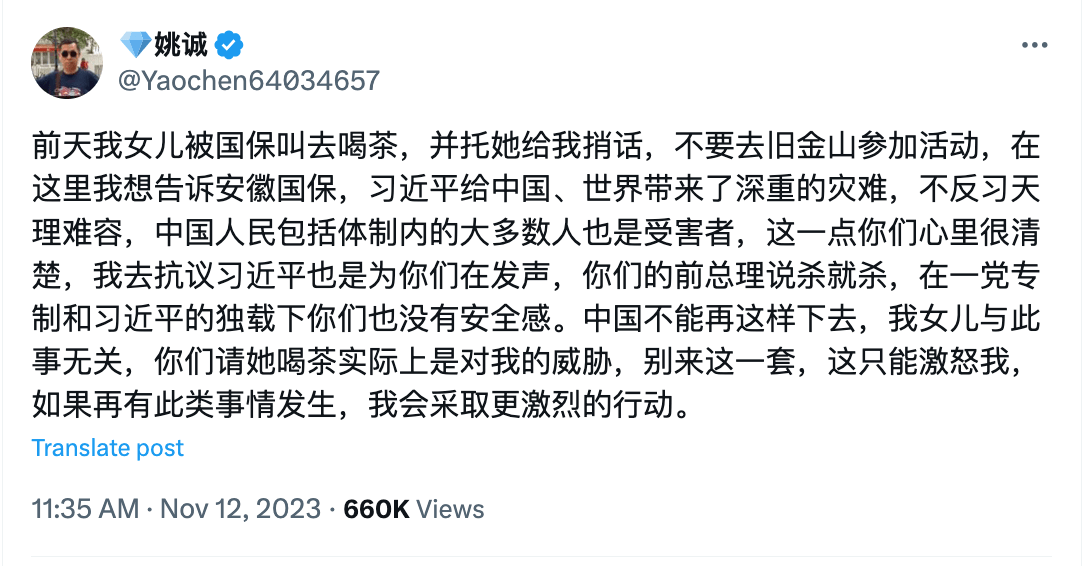
Threats against Uyghurs
Uyghurs also reported cases of Uyghurs in East Turkestan and/or the PRC being contacted by PRC authorities and instructed to tell their relatives living in the United States not to attend any protests against Xi Jinping in San Francisco. A Uyghur leader in the US has confirmed these cases but has said that the Uyghurs in the US whose families were contacted in the PRC do not wish to go on the record about the incidents. The use of families in the PRC/East Turkestan to convey threats to Uyghurs in the diaspora is a well-documented tactic of the CCP.26
Threats against Anna Kwok
On the morning of November 11, Hong Kong Democracy Council Executive Director Anna Kwok announced on social media that she had arrived in San Francisco and was going to protest against Xi Jinping.27
In response, about 12 hours later, she was inundated with online threats. Some encouraged others to apprehend her. Others threatened kidnapping. One said, “Can somebody drop her unconscious body at the Chinese consulate/embassy?”28 The threats, all sent from what appear to be pseudonymous accounts, appeared to be coordinated. The accounts shared and commented on each other’s comments. Many used the same image: her face on a Hong Kong Police Force wanted poster that offered a bounty of HK$1 million for information or assistance leading to her arrest. The US Department of State and governmental authorities in other countries had already denounced the arrest warrants and bounties against Hong Kong activists in exile as transnational repression.
Kwok said, “All the comments appeared at once. Most of the comments encouraged others to act on the arrest warrant and bounty and hunt me down; they didn’t say they’d do it themselves. They sought to rile up lone wolf patriots who would be mad enough to do it. That way, [those who made the posts on social media] wouldn’t have to pay the legal consequences themselves. It was the same group of 10 or so accounts making the threats. I assume they were coordinated and instructed.”30
She reported the threats to the Federal Bureau of Investigation on the morning of November 12, sending screenshots as evidence. On November 14, an agent at the FBI’s San Francisco office contacted her. She was told to call 911 if she faced any life-threatening event. The agent told her that the FBI had contacted relevant authorities in San Francisco about the incident and provided San Francisco Police Department precincts with her name and photo.31
Over the following days, Kwok said, “There were multiple moments when I knew others were threatened and harassed. When I reached out to the FBI, likely because I was the one who had well-documented threats prior to the occasion, I was the ‘person of interest’ in the system. In other words, the process catered more toward my safety and well-being instead of protecting all protesters on site. When asked about actions they could take, the options are limited. The FBI could not intervene in the on-site command chain of local law enforcement. When I spoke to the police on site, they were not equipped with knowledge of the situation; nor did they understand that this was transnational repression happening before their eyes. Some of them were even unaware of the fact that there were two sides and one was intimidating the other. The FBI agents wanted to help but struggled to find the mechanisms to do so”.
November 12 to 14
and other days leading up to Xi Jinping’s arrival
In the days leading up to Xi Jinping’s arrival in San Francisco on November 14, reports began to emerge that large numbers of CCP supporters were being transported to San Francisco from southern California, New York, and Philadelphia. (Later, evidence of groups from Portland, Oregon; Seattle, Washington; and the San Francisco Bay Area itself also emerged.)
Mobilization of Chinese Students through CSSAs
Hundreds of Chinese students were bused in from California universities, including the University of California (UC) at San Diego, UC Santa Barbara, UC Los Angeles, and California State University, Northridge.32
Chinese Students and Scholars Association (中國學生學者聯合(誼)會) branches at California universities were used to recruit Chinese students to “welcome” Xi, as could be seen in messages circulating among students and scholars at California universities.
CSSAs have a record of surveilling and reporting on Chinese students. They are collectively overseen by the CCP’s united front Work Department and are often controlled, funded, and/or closely watched by Chinese embassies or consulates. The US Department of State says, “…the CCP created the Chinese Students and Scholars Association (CSSA) to monitor Chinese students and mobilize them against views that dissent from the CCP’s stance. That directive has not changed.”33 The United States-China Economic and Security Review Commission says CSSAs “receive guidance from the CCP through Chinese embassies and consulates—governmental ties the CSSAs frequently attempt to conceal—and are active in carrying out overseas Chinese work consistent with Beijing’s united front strategy.”34
An email message from “BCSSA Official” at UC Berkeley told Chinese students that transport to welcoming events for Xi Jinping and meals would be arranged and provided.
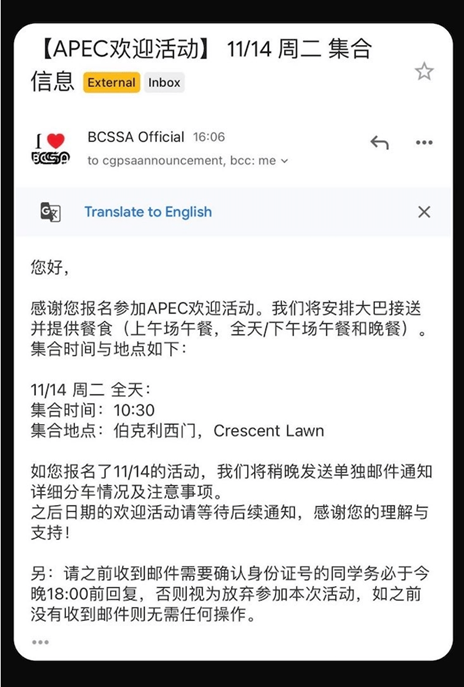
Berkeley CSSA students were later seen on November 14 at the “welcome” gathering for Xi Jinping near the San Francisco International Airport. As many as 45 students posed for group photos with the Berkeley CSSA banner.
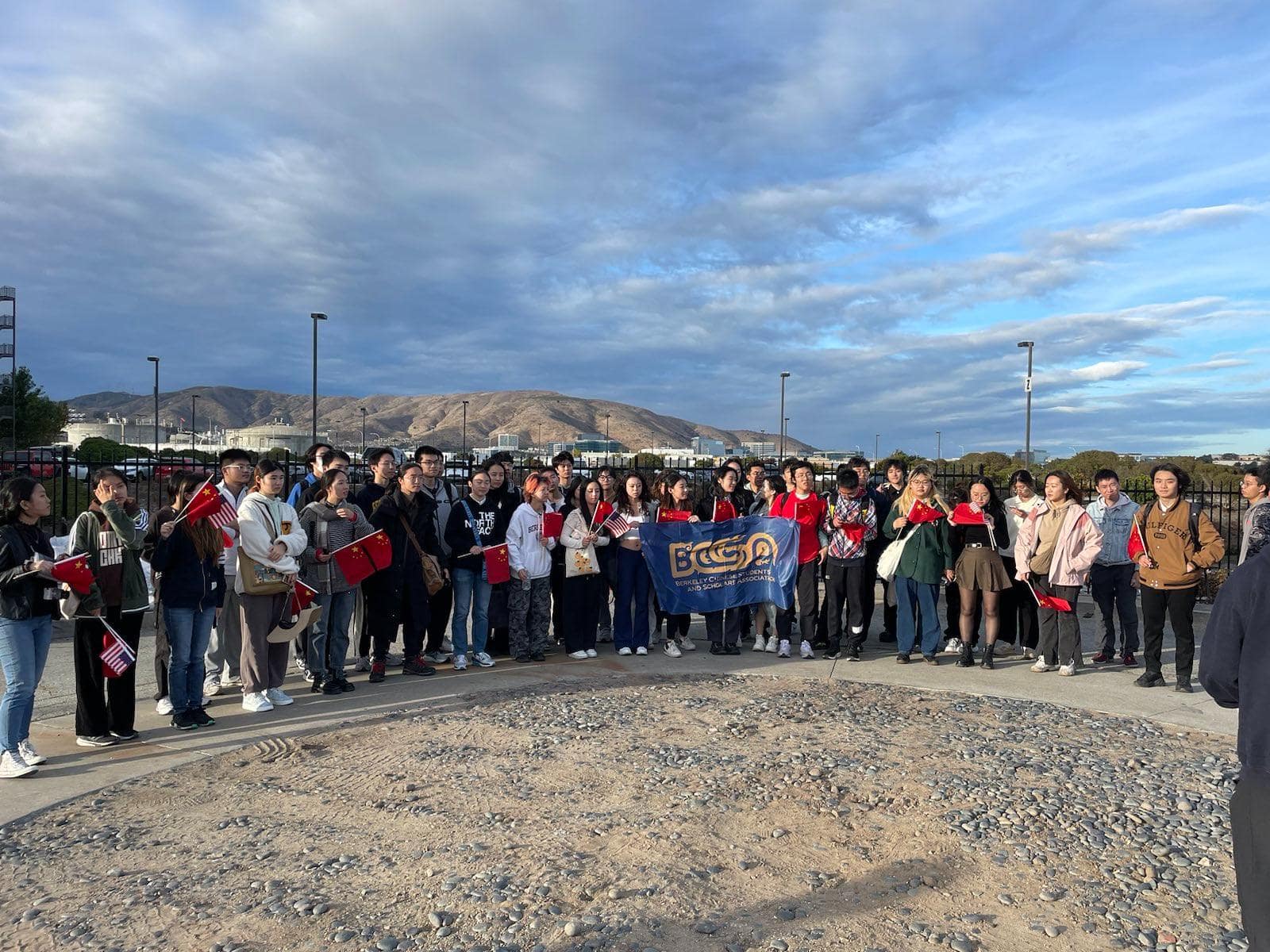
A message addressed to “executive committee members” said that CSSA representatives at University of Southern California were informed by the Chinese consulate in Los Angeles that Xi Jinping would be visiting and that students belonging to the USC CSSA were invited. Students were expected to stay in San Francisco for three or four days, the duration of Xi’s visit, and, “for everyone’s safety,” would not be allowed to go out on their own or engage in separate activities. This message also said that all travel, accommodation, and food expenses would be covered, notified students that this “glorious mission” was a significant duty, and advised addressees not to share the contents of the message with others. The message also said that once people signed up, they could not withdraw.
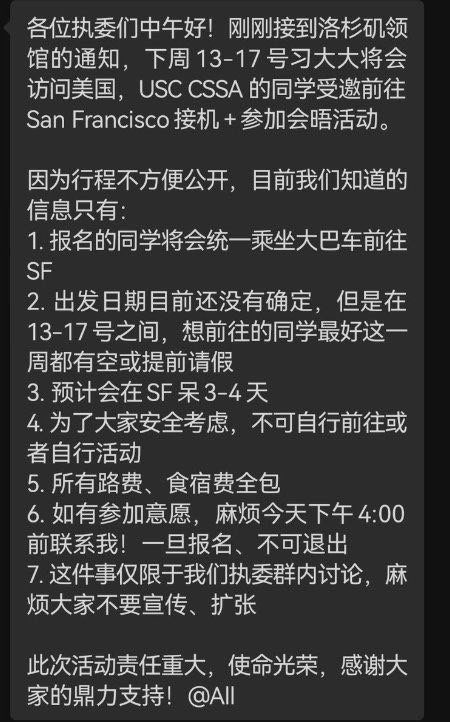
The same message addressed to executive committee members of the USC CSSA was also sent to the UCLA CSSA executive committee members.
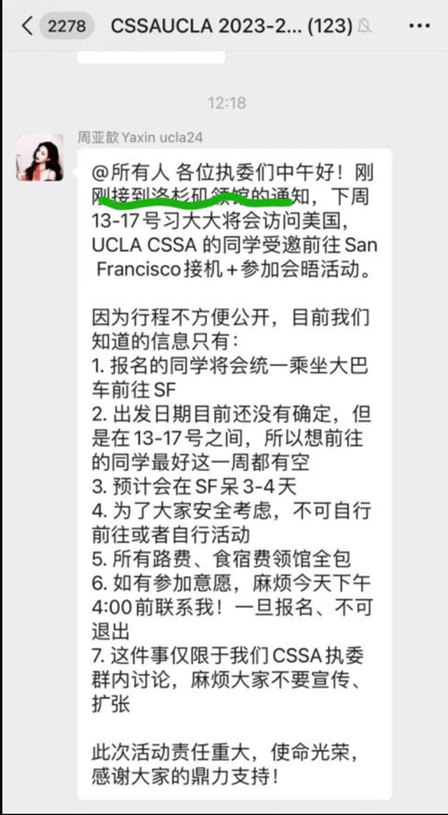
A video posted online by a Chinese student in the US confirms that, while the event was coordinated by CSSAs, the buses and meals were provided by the PRC Consulate.35 A Chinese student who traveled to San Francisco said the PRC Consulate paid for flight tickets from New York City and accommodations.36
It is highly likely that CSSAs at other California universities and in other states were used to mobilize Chinese students in a similar fashion.
Many young people who were presumably students were, in particular, gathered along the airport access road with PRC flags on November 14, the day of Xi Jinping’s arrival.
Mobilization and Transport of Other united front Groups
In fact, over the course of the four days of Xi Jinping’s visit to San Francisco, students in general did not appear to make up a large percentage of the CCP supporters at events and locations other than those at the airport on November 14. The majority of CCP supporters appeared to be associated with other united front groups.
It was reported by Chinese-language media with good relations with the CCP supporters that between 16 and 20 buses transported about 800 CCP supporters from southern California to San Francisco. The daily cost of each bus rental was at least $5,000. At least 400 rooms were reserved at five different hotels at a rate of at least $150 a night. The entire mobilization from southern California alone was said to have cost hundreds of thousands of dollars. Almost 1,000 CCP supporters from New York and other areas were transported to San Francisco. The report estimated that altogether as many as 10,000 CCP supporters from various regions would gather in San Francisco.37
Overseas Chinese from southern California were also reported to have hired 10 armed, uniformed security guards to “maintain order on site.”38 Over the coming days, security guards who appeared to be associated with CCP supporters were present at all but one of the locations where protesters were harassed, intimidated, and assaulted. At least two private security firms were employed.39 The guards of one firm dressed in distinctive black suits that protesters came to recognize. The guards of the other wore uniforms, and many appeared strikingly young. (For more details on these security firms, see below). Apart from a united front leader from southern California who claimed to have hired the 10 guards mentioned above, it is unclear who exactly hired the security guards. In response to our query regarding who hired the security firms, a representative of one of the firms said, “I recommend contacting the Chinese consulate directly for the details you’re looking for.”40 The security guards were seen at times to be working with individuals who may have had direct ties to the PRC. The guards’ exact responsibilities and purpose often appeared unclear; at times, they themselves appeared not to know. Some protesters reported that the security guards acted aggressively towards them and asserted the authority to determine where they were and were not allowed to be, while other security guards appeared to have little idea of what they were doing or remained inactive in response to incidents of harassment, intimidation, and assault.
united front groups that traveled from southern California to San Francisco include the All American Chinese Association41 (南加華人華僑聯合總會/美國南加州華人華僑聯合總會), the Chinese American Unity Alliance (洛杉磯華埠大聯盟), and the Taishan Friendship Association of Southern California (南加台山聯誼會).42
Other united front groups that traveled to San Francisco include the Philadelphia Fujian Association (費城福建同鄉會), the American Lianjiang Association (美國連江同鄉會; Lianjiang is a county in Fujian Province), the American Fujian Association (美國福建同鄉會), the North American Zhejiang Overseas Chinese Association (北美浙江華僑聯盟社團), and the Los Angeles-based Beijing Association USA (美國北京聯合會).43
While some united front groups seek to obscure their close links with CCP entities and officials, others proudly display them. For example, on the front page of Beijing Association USA’s website are two letters congratulating it. One is from the All-China Federation of Returned Overseas Chinese (中華全國歸國華僑聯合會), the top-level CCP united front group tasked with overseeing relations with overseas Chinese that is mentioned in the Introduction above. The other is from China Overseas Friendship Association (中華海外聯誼會), the external name of the 9th Bureau of the CCP’s united front Work Department, one of two UFWD bureaus tasked with overseeing overseas Chinese affairs.44
Beijing Association USA was one of many united front groups seen lining the route to the Filoli Estate where the meeting between Xi Jinping and President Biden took place on November 15.45
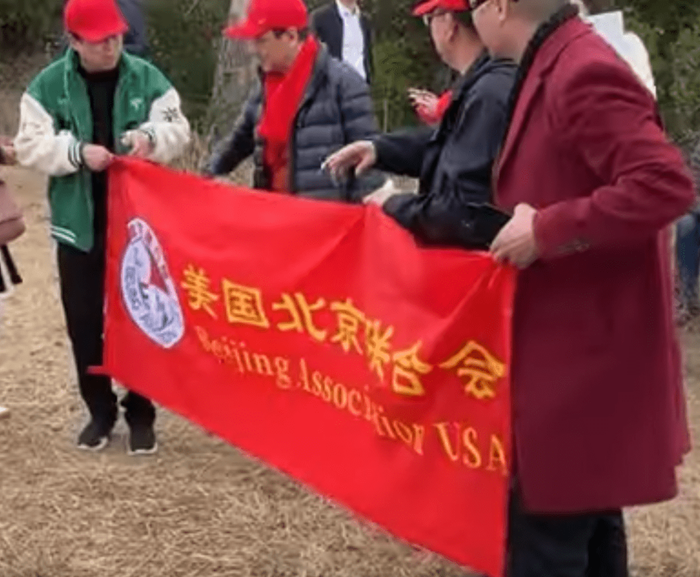
Another group present along the Filoli route on the 15th was the America Cultural Center Of Chinese Minorities (美國中華民族文化中心) based in Arcadia, California.46
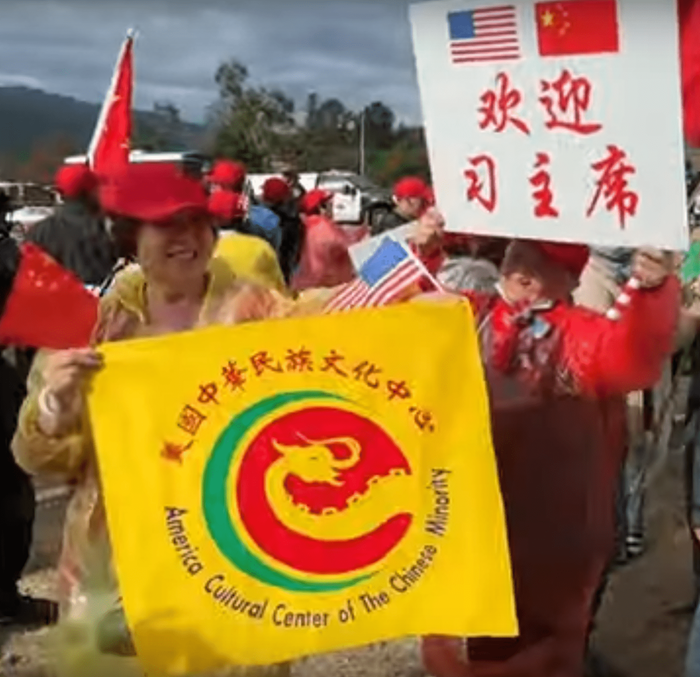
Like many united front groups in the US, the America Cultural Center Of Chinese Minorities has a minimal public profile, but it is registered as a 501(c)(3) nonprofit.47
united front Leaders Who Organized Mobilization and Transport
Two individuals were prominent among united front leaders who organized the mobilization and transportation of CCP supporters to San Francisco.
One of these individuals is Charles Lu Qiang (鹿強). Chinese-language media outlets Sing Tao and World Journal reported that he organized the mobilization of CCP supporters from southern California. The other is John Chen Shanzhuang (陳善莊) who reportedly organized the mobilization of CCP supporters from New York.
Brief profiles of these two individuals reveal their ties to the CCP. Tracing these ties helps to indicate how the CCP uses united front groups to carry out its agenda abroad.
Charles Lu Qiang (鹿強), a travel agent based in the Los Angeles area, reportedly organized the transport of 16 to 20 buses of CCP supporters from southern California to San Francisco. Lu utilized the resources of his travel agency to secure transportation.48
As recently as September 2023, two months before Xi Jinping’s visit to San Francisco, Lu attended the 11th National Congress of Returned Overseas Chinese (第十一次全國歸僑僑眷代表大會) in Beijing, where Xi Jinping and other top CCP leaders spoke.49
Lu has served as an overseas committee member of the Shanghai Overseas Chinese Association (上海市僑聯), a local group of the All-China Federation of Returned Overseas Chinese (中華全國歸國華僑聯合會) in Shanghai. 50 ACFROC (中國僑聯 [簡稱]) is the top-level CCP united front group responsible for maintaining relations between the CCP and overseas Chinese.51
In 2015, Lu was one of 38 overseas Chinese invited to attend the main annual session of the Chinese People’s Political Consultative Conference (中國人民政治協商會議; CPPCC), the very highest united front organ of the CCP and an advisory body to the PRC government composed of some of the highest-profile CCP supporters. An invitation to an overseas Chinese to attend the annual session of the CPPCC is considered recognition of exceptional contributions to united front work abroad; only “well-known leaders in their host countries” are invited to attend. Lu claimed the conference had an especially good democratic atmosphere. The CPPCC session took place in the Great Hall of the People in Beijing.52
Lu is the honorary founding chairman of the Roundtable of Southern California Chinese-American Organizations (RCAO; 美國南加州華人社團聯合會[簡稱南華聯]). As of 2022, RCAO was a coalition made up of at least 170 member organizations. At a ceremony in 2022 inaugurating its 10th leadership team—of which Lu is part in his capacity as honorary founding chairman—Zhang Ping, the then-Consul General of the PRC consulate in Los Angeles, expressed admiration for the work of the RCAO as well as gratitude to its past and present leaders. Lu is prominent among them in photos of the event. In one, he stands next to Zhang Sujiu, daughter of General Zhang Zhizhong, whom Mao Zedong appointed to several high-ranking positions in the early decades of the PRC. Zhang herself is, like Lu, an honorary chair of RCAO.53
Lu is also reputed to be a major convener of “patriotic” gatherings of overseas Chinese in southern California to “oppose Taiwan and Hong Kong independence.”54
In addition to having transported 16 to 20 buses of CCP supporters to San Francisco, Lu Qiang himself, along with hundreds of other CCP supporters, was apparently present along the route to the Filoli Estate where the Xi-Biden meeting was held on November 15.55
John Chen Shanzhuang (陳善莊), (sometimes spelled “John Chan” in English) reportedly played a leading role in mobilizing CCP supporters from New York. He is reported to be the chair of Asian American Community Empowerment (美國亞裔社團聯合總會).56 He was interviewed on the streets of San Francisco during Xi Jinping’s visit, and the accompanying photograph shows him wearing a lapel pin of the American Chinese Commerce Association (HK) (美國(香港)旅美華人總商會), another group of which he is the chair. 57
On November 8, only days before he led CCP supporters to San Francisco, Chen met Deputy Consul General Wu Xiaoming (吳曉明) of the PRC consulate in New York.58 The occasion was a ribbon-cutting ceremony for a new office for his organization, Asian American Community Empowerment. Wu publicly praised Chen, indicating a close relationship between PRC officials and Chen as a leader of united front groups.
Chen has been a leader of united front activities in New York City for upward of three decades, regularly organizing public gatherings to express support for PRC government positions on matters ranging from the US bombing of the PRC embassy in Belgrade in 1999 to the Falun Gong.59 In March 2023, Chen was prominent at a protest of CCP supporters in New York City against the visit to the US of the Taiwanese then-president Tsai Ing-wen.60
In 1999, he co-founded the American Fuzhou Langqi United Association (美國福州琅岐聯合總會). He is also listed as the chairman of the American Chinese Commerce Association (美華總商會會長), which shares a website with the American Chinese Commerce Association (Hong Kong) (美國(香港)旅美華人總商會), of which he is also president. Besides the organizations mentioned above, he is also reported to be the convener of an organization called Coalition of Asian-Americans for Civil Rights (CAACR) (亞裔維權大聯盟).61
In San Francisco, Chen led supporters in “welcoming” Xi outside the St. Regis Hotel, where the Chinese delegation was staying, on November 14. Some of them harassed and intimidated protesters.62
Besides united front figures like Lu Qiang and Chen Shanzhuang, who reportedly organized the mobilization and transport of CCP supporters to San Francisco from, respectively, southern California and New York, several other prominent united front leaders participated in the “welcoming” of Xi Jinping in San Francisco. They will be noted as they appear in the timeline of events below.
Patterns emerge that resemble previous mobilizations of the overseas united front to neutralize protesters going back to the Olympic torch relay in 2008:
- The united front groups have strong ties with the PRC government and are organized by individuals with a record of strong ties with the PRC government.
- Their mobilization is organized and transport and accommodations are provided.
- Those associated with united front groups, including Chinese students, are exhorted to fulfill their patriotic duty and take part in a “glorious mission.”
While a small percentage of CCP supporters who showed up on the streets of San Francisco directly engaged in acts of harassment of and assault on protesters, the mobilization of large numbers was meant to “flood the zone,” taking up space especially in locations where Xi was present. This was effected both to ensure support for Xi and to neutralize potential protests. The CCP supporters blasted patriotic songs and slogans on megaphones at high volume and sought to obscure any views of protesters and their banners and flags. Within the crowds of CCP supporters, many of whom were quite passive, were smaller numbers of people who were tasked or who took it upon themselves to more aggressively harass, intimidate, and even assault protesters. A number of those who did not directly take these more aggressive measures were nevertheless sometimes perceived as complicit with those who did, if they used, for example, their PRC flags to block any view of the harassment, intimidation, and assault. Kennedy Wong, a Hong Kong protester and member of Hong Kong Democracy Council, said, “I was quite frightened because we were outnumbered by CCP supporters; more importantly, some of them were very aggressive.”63
On several occasions, protesters changed their plans due to safety concerns. Tibetan and Uyghur groups had originally planned to march on November 15 to the Hyatt Regency, where Xi was the guest of honor at a banquet, but when they saw the large numbers of CCP supporters gathered outside the hotel and an absence of separate protest zones, they decided against this course of action as they feared it could lead to a potentially violent confrontation. Several dozen Tibetans proceeded to the area near the Hyatt Regency, but many Tibetan elders along with Tibetans with children left.64 (In fact, those protesters who did brave the crowds of CCP supporters were attacked, as shall be seen.) Once on site, protesters quickly developed protocols and strategies to ensure their safety. Often, the effort required of protesters to protect themselves from pro-CCP attackers distracted significant attention from their original objective, namely, protesting against Xi Jinping. All protesters interviewed for this report said they felt in significant danger and were on constant high alert for attacks, stalking, and other forms of harassment, intimidation, and violence. The mobilization of the united front as well as more aggressive agents affiliated with the CCP did, in fact, deter protest and create an unsafe environment for protest, thus interfering with protesters’ free speech rights as well as infringing their basic human right to freedom of peaceful assembly.
Tuesday, November 14
First day of Xi’s Visit to San Francisco
Xi Jinping arrived at the San Francisco International Airport. He and the Chinese delegation were rumored to be staying at the St. Regis hotel. Hundreds of CCP supporters lined the route from the airport to the hotel and also gathered near the hotel. Some protesters also went to the airport, a few were present along the route of Xi’s motorcade, and a few more were near the hotel. The first incidents of harassment, intimidation, and assault occurred on this day.
Among the serious incidents of the day were these:
- the harassment and intimidation of Uyghur camp survivor Tursunay Ziyawudun and other Uyghurs at the San Francisco International Airport;
- the harassment and intimidation of Chinese activist Li Huanjun on the route from the airport to the St. Regis;
- the assault on Chinese activist Jia Junwei outside the St. Regis.
Near San Francisco International Airport
Beginning in the morning, both CCP supporters and protesters gathered along the airport access road in anticipation of Xi’s arrival. They remained there until shortly after 3 p.m. when Xi was reported to have arrived. Many of the CCP supporters on the airport access road on this day appeared to be students, presumably recruited through CSSAs.65
Elements appeared — intimidation by numbers and utilization of flags and flagpoles — that would become familiar in subsequent days. In particular, CCP supporters used their superior numbers to hound and crowd out protesters, attempting to block or obscure both protesters and their banners and flags from the road. Unmarked white trucks delivered massive flagpoles and PRC flags to the CCP supporters.66 While at first glance, use of flags and flagpoles may seem relatively mild as a form of repression, they were consistently singled out by protesters interviewed for this report as among the items most frequently used to harass, intimidate, and assault. The flags were often enormously large and used to cover protesters, both so that their protest could not be seen and so that assailants could not be seen attacking them. The flagpoles were used to hit and stab protesters. PRC flags and flagpoles appear to have been CCP supporters’ weapons of choice throughout Xi Jinping’s visit, presumably because their dual purpose provided a cloak of plausible deniability.
Topjor Tsultrim, Communications Coordinator at Students for a Free Tibet, reported that CCP supporters near the airport pushed into areas where protesters were gathered and surrounded them, apparently at the direction of their leaders or organizers. The CCP supporters attempted to unfurl a large banner in front of the protesters so as to block view of them from the road where Xi was expected to pass. They yelled at the protesters and blared megaphones in their faces. They did not chant slogans; they just had pre-recorded chants and patriotic songs blaring on a loop out of loudspeakers. They persistently tried to drape their flags over the protesters.67
Security guards on the side of the CCP supporters placed themselves in between the CCP supporters and the protesters and asserted, “This is our space,” “our” clearly referring to the CCP supporters. This was the first appearance of security guards. They would be seen wherever CCP supporters appeared in the coming days. They were dressed in all-black suits. (Other security guards employed by another firm would also be seen working for the CCP supporters at another location this same day.) One news report featured an interview with a security guard who was said to work for the Chinese consulate at the scene of confrontations between protesters and CCP supporters.68 Lu Qiang, the united front leader from southern California, told a Chinese-language publication that he had hired security guards.69
The security guards in all-black suits were employed by a firm called Critical Synthesis Security, apparently based in San Francisco.70 Several protesters were confused by these guards’ role in the streets during Xi Jinping’s visit. According to the reports of several protesters, the guards themselves appeared at times confused, or even unenthusiastic, about their role. Some protesters said some guards appeared to assert authority that went beyond anything they could conceivably be legally entitled to.
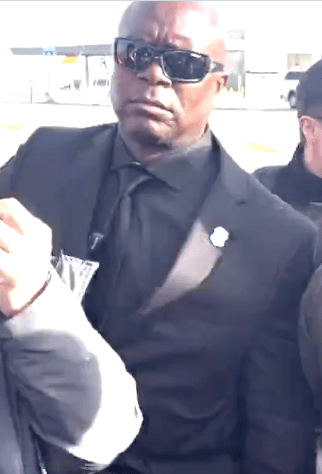
Another pattern seen at the airport that would recur in subsequent days was that, while protesters were happy and often eager to speak with journalists, CCP supporters more often than not declined to do so and were media-shy. They often appeared uncomfortable answering questions about their reasons for being at a public demonstration.71 Almost all reports that exist in which views of and information about CCP supporters are presented are in Chinese-language media with a pro-CCP slant.72
Harassment and Intimidation of Uyghur Camp Survivor Tursunay Ziyawudun and Other Uyghurs
Of particular note is the harassment of Uyghur camp survivor Tursunay Ziyawadun and other Uyghurs.73 CCP supporters attempted to surround her and use PRC flags to cover the flag of East Turkestan she was carrying.
This episode is redolent with ironic symbolism: having escaped from both a CCP concentration camp for Uyghurs and other Turkic Muslims and CCP-ruled East Turkestan, Tursunay found herself harassed once again by people loyal to the regime who had persecuted her, but this time on American soil. The CCP supporters who harassed her most likely had no idea of who she was or what she had been through. The feeling that they, as Uyghurs and other targeted peoples, had come to the US to escape persecution at the hands of PRC authorities and now here they were experiencing it again in the US was a sentiment shared by many of the protesters in San Francisco who were originally from China, East Turkestan, Hong Kong and Tibet.
On the Route from the San Francisco International Airport to the St. Regis Hotel
Along the route from the San Francisco International Airport to the St. Regis Hotel, where the Chinese delegation was rumored to be staying, many CCP supporters, as well as some protesters, awaited Xi’s motorcade.
Harassment and Intimidation of Li Huanjun
One protester in particular posted a video of herself being harassed and intimidated along the route on the afternoon of November 14.74 Her name is Li Huanjun (李煥君).75
Li Huanjun’s family were victims of forced demolition in the PRC. After years of advocating on their behalf and suffering persecution, Li went into exile.76 She had blocked Xi’s motorcade on two of his previous visits to the US.77
In the video she posted of events on November 14, Li Huanjun can be seen being jostled by CCP supporters. They repeatedly hold a large PRC flag in front of her to hide her from view. Whenever she attempts to get away from them, they follow her and continue to hold the flag in front of her. Near the end of the video, she is hit in the head with a flagpole. She says she was also pinched on the arms, waist, and other places multiple times.78
Here, then, is the already-familiar pattern of flags being used to obscure protesters, flagpoles being used as weapons, and the repeated jostling.
Several elements of united front operations, as well as some united front figures, can be seen in this video. For that reason, it is worth dwelling on some detail.
Near the end of the video (01:27), a man with a mohawk appears from behind a flag. He is Chen Longkui (陳隆魁), one of the people who held the flag that was used to cover Li Huanjun.
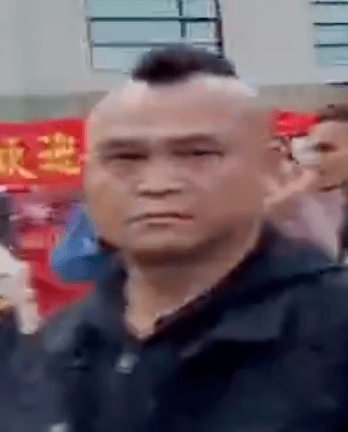
According to articles in Chinese-language pro-CCP publications, based on information provided by an official at the united front Work Department of Guilin City, Chen came from Guilin in the Guangxi Zhuang Autonomous Region in the PRC to the US in the 1980s to study, later settling there. As of September 2023, he was president of the Guilin Qiaozi Enterprise Federation (桂林僑資企業聯合會), board chair of the Guangxi Tourism Development Group (廣西景區通旅遊發展有限公司), and an overseas committee member of the All-China Federation of Returned Overseas Chinese (中國僑聯/中華全國歸國華僑聯合會/AFROC). AFROC is the same organization to which Lu Qiang (see above) belongs, the top-level united front group with overall responsibility for overseeing relations with overseas Chinese.79 In fact, Chen attended the same event as Lu, the 11th National Congress of Returned Overseas Chinese, in September 2023 in Beijing, just two months before Xi Jinping’s trip to San Francisco. Xi Jinping and other top CCP officials addressed this Congress, and Chen posed for a photo in the Great Hall of the People in Beijing.80
Another man who appears prominent and centrally in the video in which Li Huanjun is harassed and intimidated is also a united front leader.
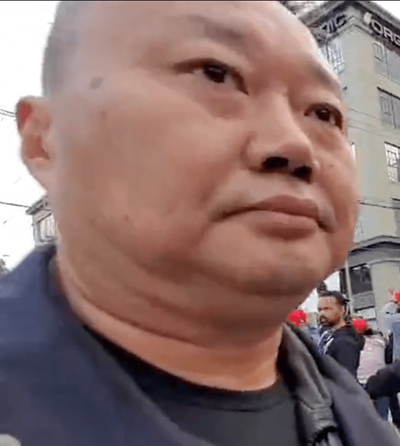
His name is Jing Dongsheng (靖東升). He is reported to be the president of the united front group, Oregon Association for the Promotion of the Peaceful Unification of China (俄勒岡州中國統一促進會),81 Executive Chairman of the Oregon National Day Organizing Committee (俄勒岡州國慶籌委會),82 and the Honorary Chairman of the American Chinese United Association Oregon Chapter (美華總會俄勒岡州分會).83 Associations for China’s “peaceful unification” are prototypical united front groups affiliated with the China Council for the Promotion of Peaceful National Reunification, which was set up by the united front Work Department. In November 2019, Jing hosted a delegation from the China Council for the Promotion of Peaceful National Reunification led by its Deputy Secretary-General Sun Lingyan (孫凌雁), a meeting reported on by the Alliance for China’s Peaceful Reunification, USA.84 In August 2022, he hosted a banquet to welcome Zhang Jianmin, the Consul General of the PRC consulate in San Francisco (中國駐舊金山總領事張建敏), to Oregon.85
In addition to having participated in the harassment and intimidation of Li Huanjun, Jing Dongsheng appears also to have been a “scout,” one of the people apparently stationed at various “sensitive” locations where Xi’s delegation stayed or was expected to appear around San Francisco to keep a lookout for protesters. He appears in this video posted by Ma Yongtian (馬永田) photographing her with his camera in a taunting manner.86
Ma Yongtian is from Jilin Province. Her factory was forcibly seized in 2001, and since then, she has been seeking compensation. She was arrested in 2017 in Florida for blocking Xi Jinping’s motorcade.87 In San Francisco, she was searching for a place where she might do the same when she came across these scouts. Not only is Jing Dongsheng present, so are other recognizable united front figures. Two of them appear together with him in the same frame, as can be seen in the following photo:
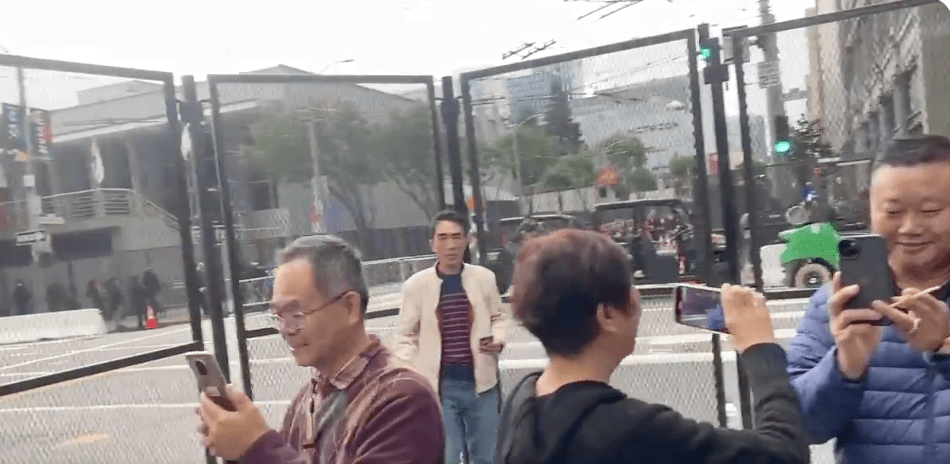
These two were seen elsewhere on the streets of San Francisco as well. One is named Yu Yingqiang (余穎強; to the left in the above photo). He was seen acting as a lookout near the Hyatt Regency Hotel on November 15 and was among the crowd of CCP supporters that assaulted Tibetan protester Chemi Lhamo near the airport on November 17. On the evening of November 15, Yu assaulted an elderly Hong Kong protester near the Hyatt Regency where a banquet for Xi Jinping was being held (see below for details).88 The other man is Rong Junwu (容鈞武; in the middle of the above photo). He was part of a group of CCP supporters that assaulted several Chinese protesters near the Moscone Center on November 16 and at the San Francisco International Airport on November 17 (see below for details).
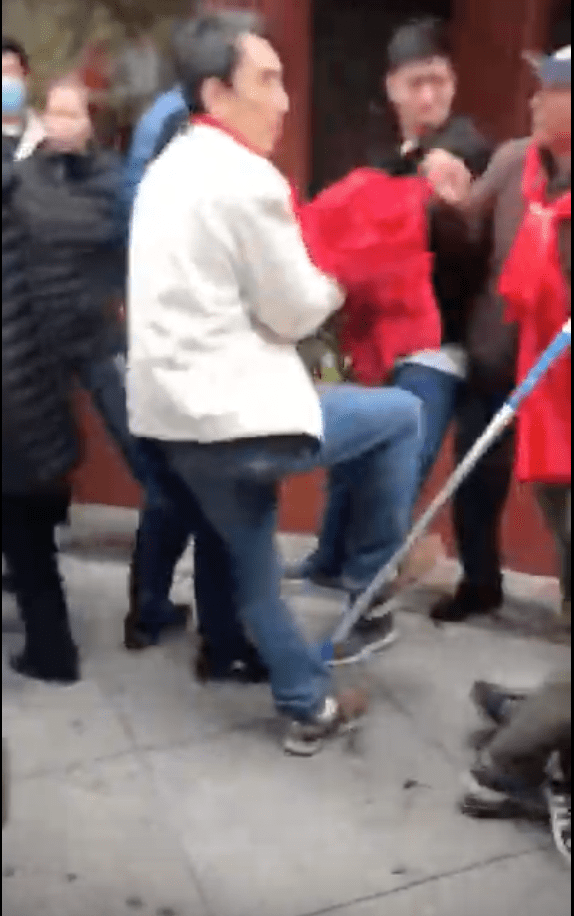
It seems that, like Jing Dongsheng, both of these men are from the Portland, Oregon, area.89
Jing Dongsheng has also been seen at united front street demonstrations on other occasions. In March 2023, he was among the CCP supporters protesting against Taiwan’s then-president Tsai Ing-wen’s visit to Los Angeles. There he can be observed with the other two united front figures, He Konghua (何孔華) and Chen Zhaojin (陳兆進), both of whom showed up in San Francisco (see below for information about their activities in San Francisco during Xi Jinping’s visit), as well as with Rong Junwu.
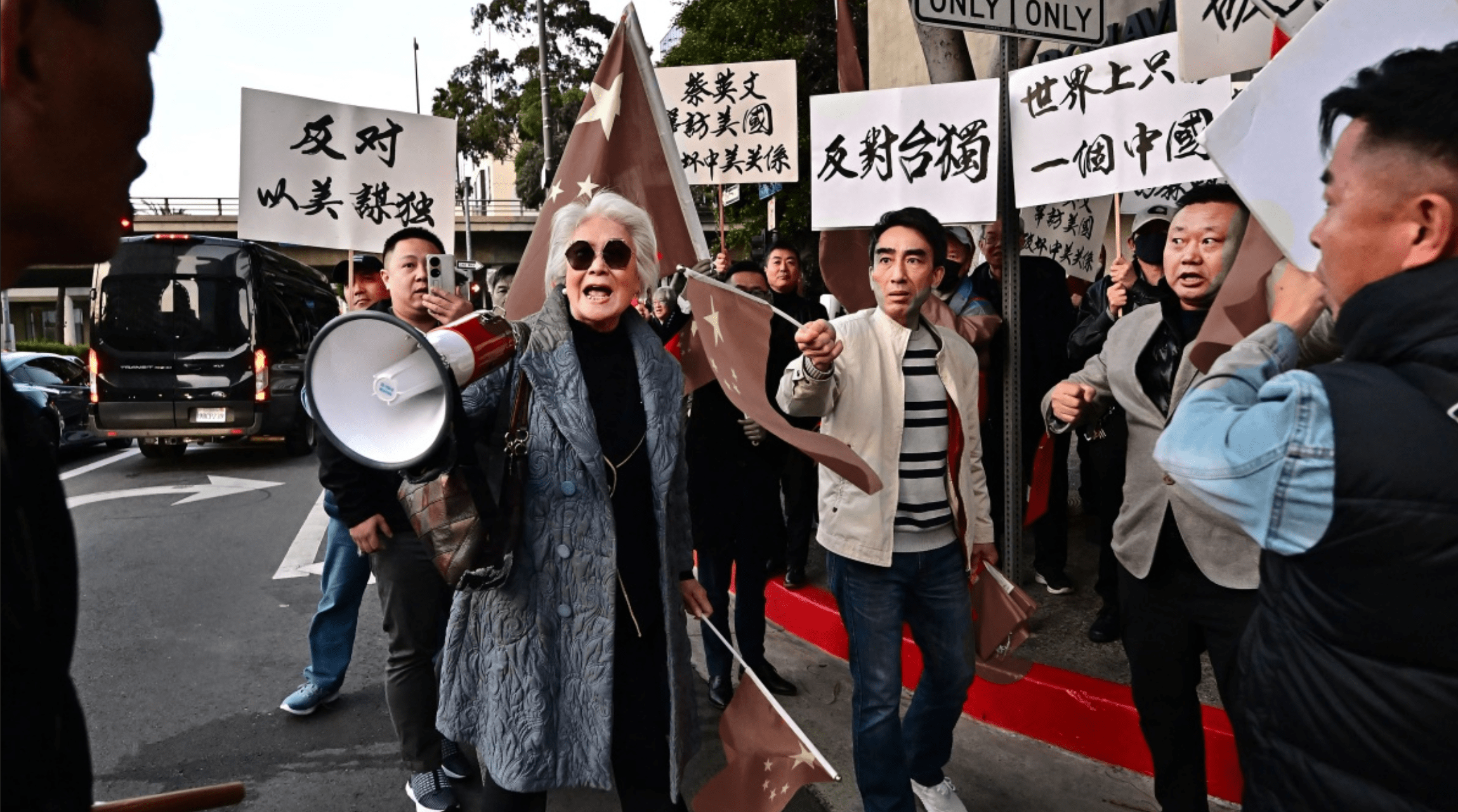
In this photo taken in Los Angeles, the woman in sunglasses and carrying a megaphone is He Konghua, the leader of the Beijing Association in San Francisco. The man to her left in the white jacket is Rong Junwu, who was scouting and also part of the group that assaulted Chinese protesters in San Francisco where he wore the same white jacket. The man to his left is Jing Dongsheng, and the man behind He Konghua and holding a phone is Chen Zhaojin, another united front figure from San Francisco. Newsweek reported that the pro-CCP demonstrators against Tsai were offered $400 each by Deputy Consul Li Chunlin of the Chinese consulate in Los Angeles for each day of the protest.90
Jing Dongsheng also attended a united front protest against Taiwan then-Vice President William Lai Ching-te’s visit to San Francisco in August 2023.91 Another united front figure, Yang Baohai (楊寶海; he also goes by the name, Liu Baohai/劉寶海) also attended. Yang would later be seen on November 15 among a group attacking Tibetan protesters outside the Hyatt Regency Hotel (see below).
The other scouts in Ma Yongtian’s video are the men dressed in similar black tracksuits.
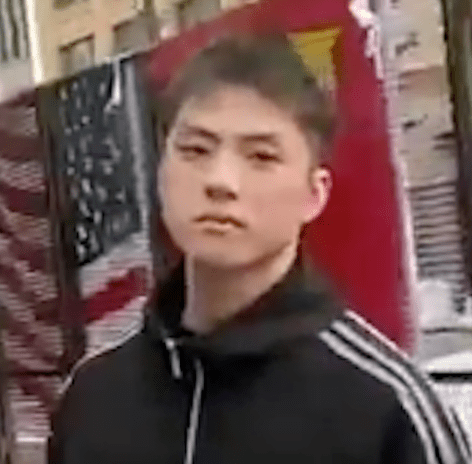
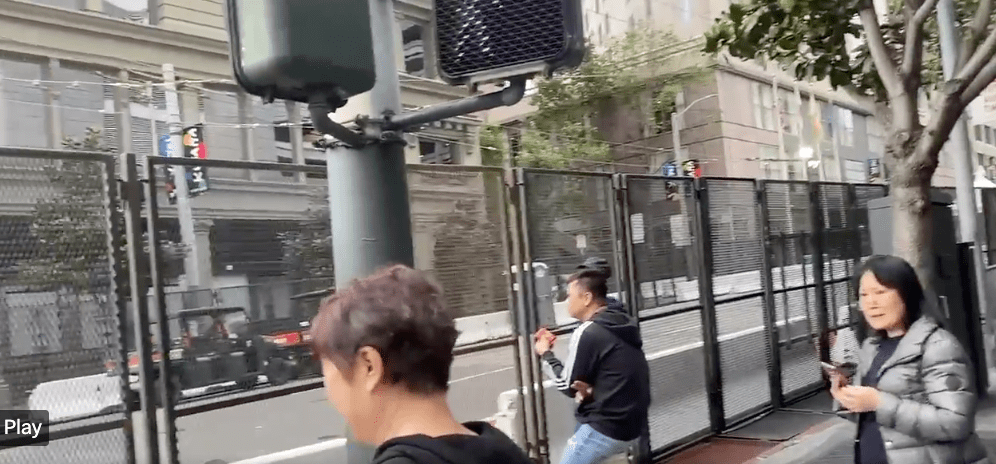
Men in black tracksuits were spotted repeatedly conducting similar scouting activities in the downtown San Francisco area during Xi Jinping’s visit.
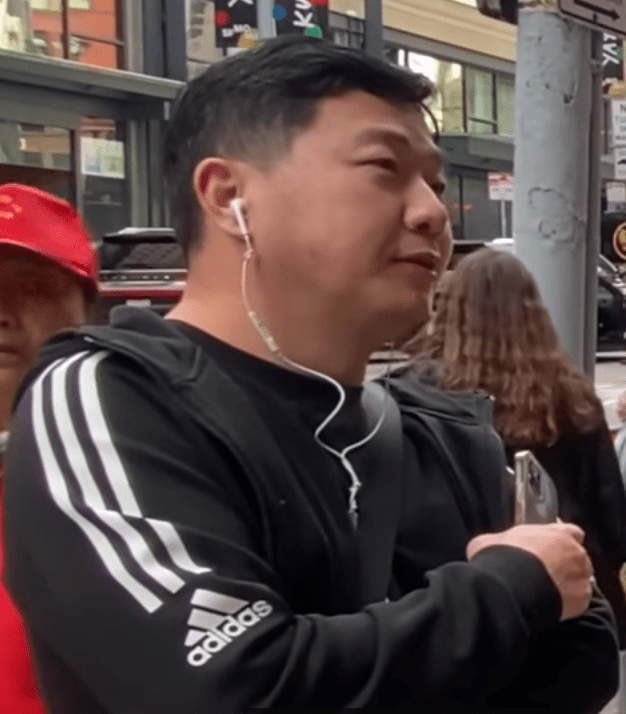
Several protesters suspected that these men had been assigned to look out for and report on “troublemakers.”
They did not always restrict themselves to scouting alone. Circling back to the video of the harassment and intimidation of Li Huanjun, a man in a black tracksuit top is holding the flag being used to cover Li.
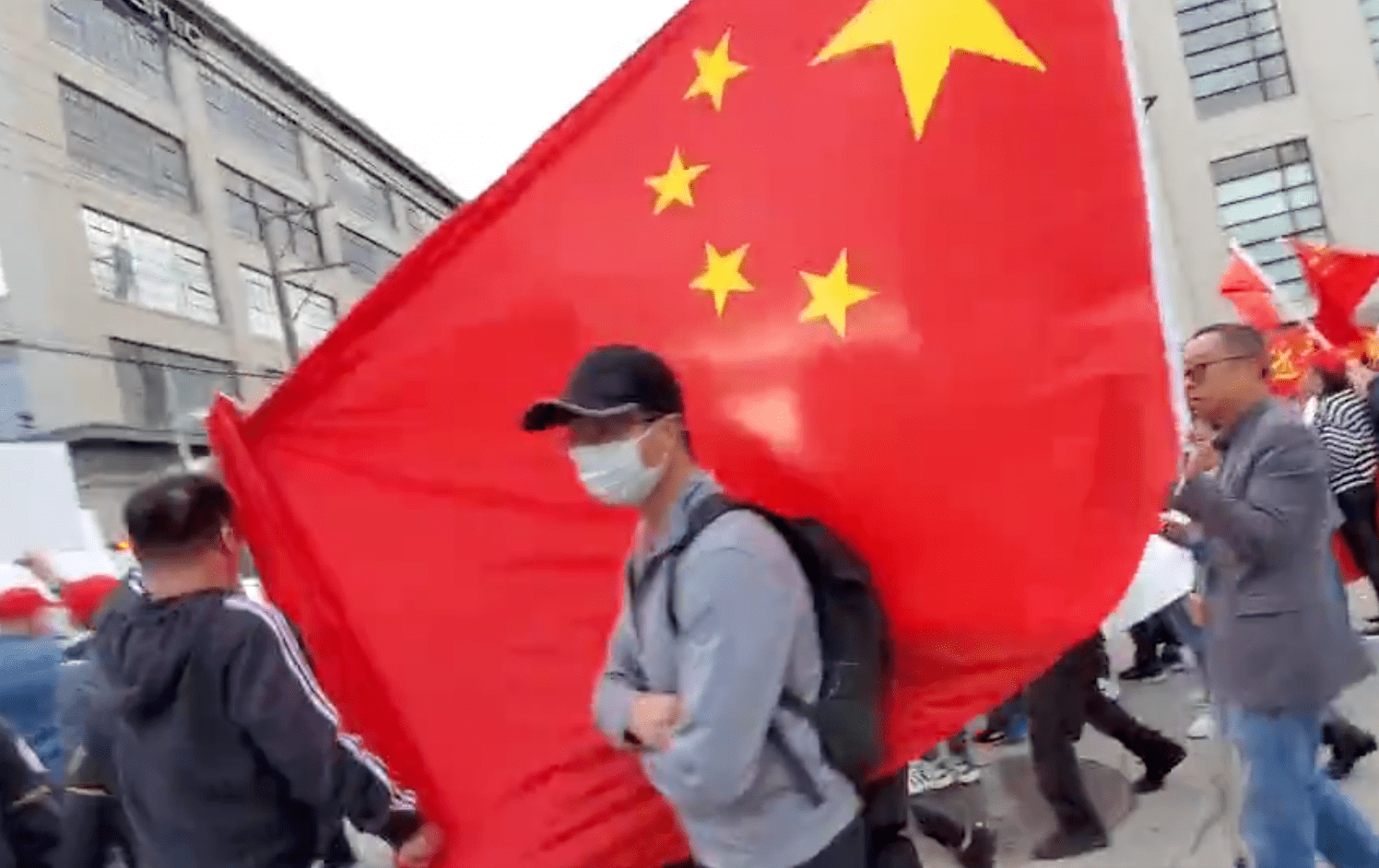
He turned and looked at Li (who was holding the camera):
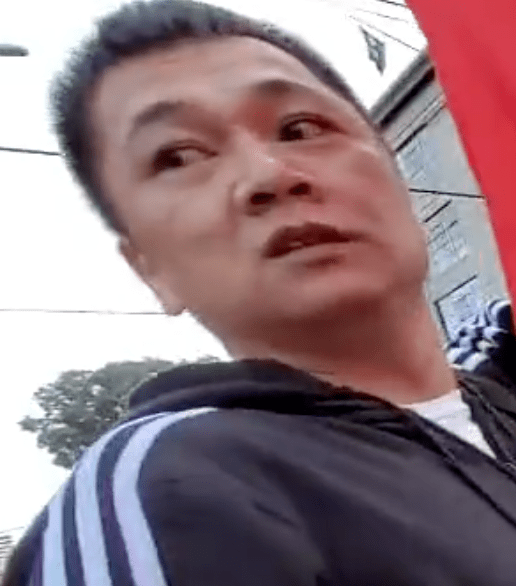
Also in that video, security guards can be seen cooperating with the CCP supporters. A group of security guards links hands with one another to prevent Li Huanjun from approaching the street.
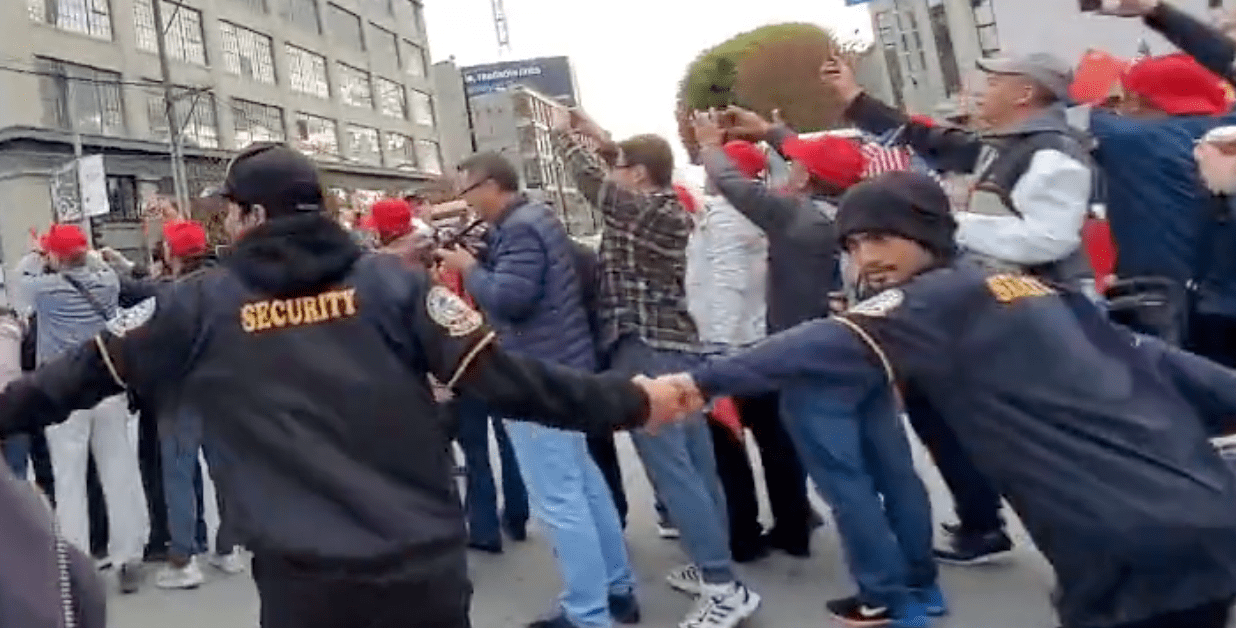
Judging by their uniforms and shoulder badges, these security guards work for a different company than those from Critical Synthesis, who dressed in black suits and could be seen at many incidents of harassment and intimidation of and assault on protesters on all days of Xi Jinping’s visit to San Francisco. These guards appear younger and wear the shoulder badge of the National Protective Service Private Security, a group that advertises itself as working in the San Francisco Bay Area.92
As in several other incidents of harassment and intimidation of and assault on protesters by CCP supporters, rather than intervene to protect the victim, the security guards assisted the perpetrators.
Near the St. Regis (125 3rd St, San Francisco)
The St. Regis San Francisco Hotel is where Xi Jinping and the PRC delegation were reported to be staying. For that reason, it attracted both CCP supporters and protesters.
Xi Jinping was reported to have touched down at San Francisco airport at 2:30 pm, and Xi was reported to have arrived at the St. Regis around 3:30 or 4 p.m. on November 14.93
Trouble outside the hotel began earlier that afternoon. Large numbers of one CCP united front group, the American Chinese Commerce Association (Hong Kong) (ACCA (HK), 美國(香港)旅美華人總商會), as well as members of another united front group, Chinese Anti-Cult World Alliance (全球華人反邪教聯盟), were present. The chair of ACCA (HK), John Chen Shanzhuang (the united front leader profiled earlier in this report who organized the transport of many from New York) was present.94 CCP supporters blared the PRC national anthem on a loop on loudspeakers and attempted to outshout and sometimes surround the protesters with PRC flags.95 Most of the protesters were effectively harassed out of the area by Xi’s supporters.
Assault on Jia Junwei
Around this time, a protester named Jia Junwei (賈俊偉) said she was attacked by a group of CCP supporters in the vicinity of the St. Regis Hotel. Jia said she was protesting because her home in the PRC had been demolished by corrupt elements (腐敗分子), and her father had been imprisoned and “persecuted to death” in custody. She held up a handmade banner that told this story.
Jia said that a CCP supporter named Li Huahong snatched her banner, dragged her into an area surrounded by other CCP supporters who held up their large PRC flags so that no one could see what was happening, pulled her hair, and hit her in the head. She lost consciousness but could still feel that she was being hit in the head by what felt like flagpoles. She believed this was done to her because Xi Jinping’s motorcade was expected to arrive at the hotel, and the attackers didn’t want Xi to see her. Jia also believed the CCP supporters were ordered by members of the PRC Embassy to attack her. People she believed to be members of the PRC Embassy first took photos of her, then pointed and gestured at her. It was only after they pointed and gestured at her that the people with PRC flags came over and surrounded her. The apparent leader of the attack, Li Huahong, wore an earpiece and headphones and carried a loudspeaker. After Jia was attacked, an ambulance came to the scene, and first responders attended to her.96
In these photos, the CCP supporters can be seen surrounding Jia and attempting to block view of her with PRC flags.
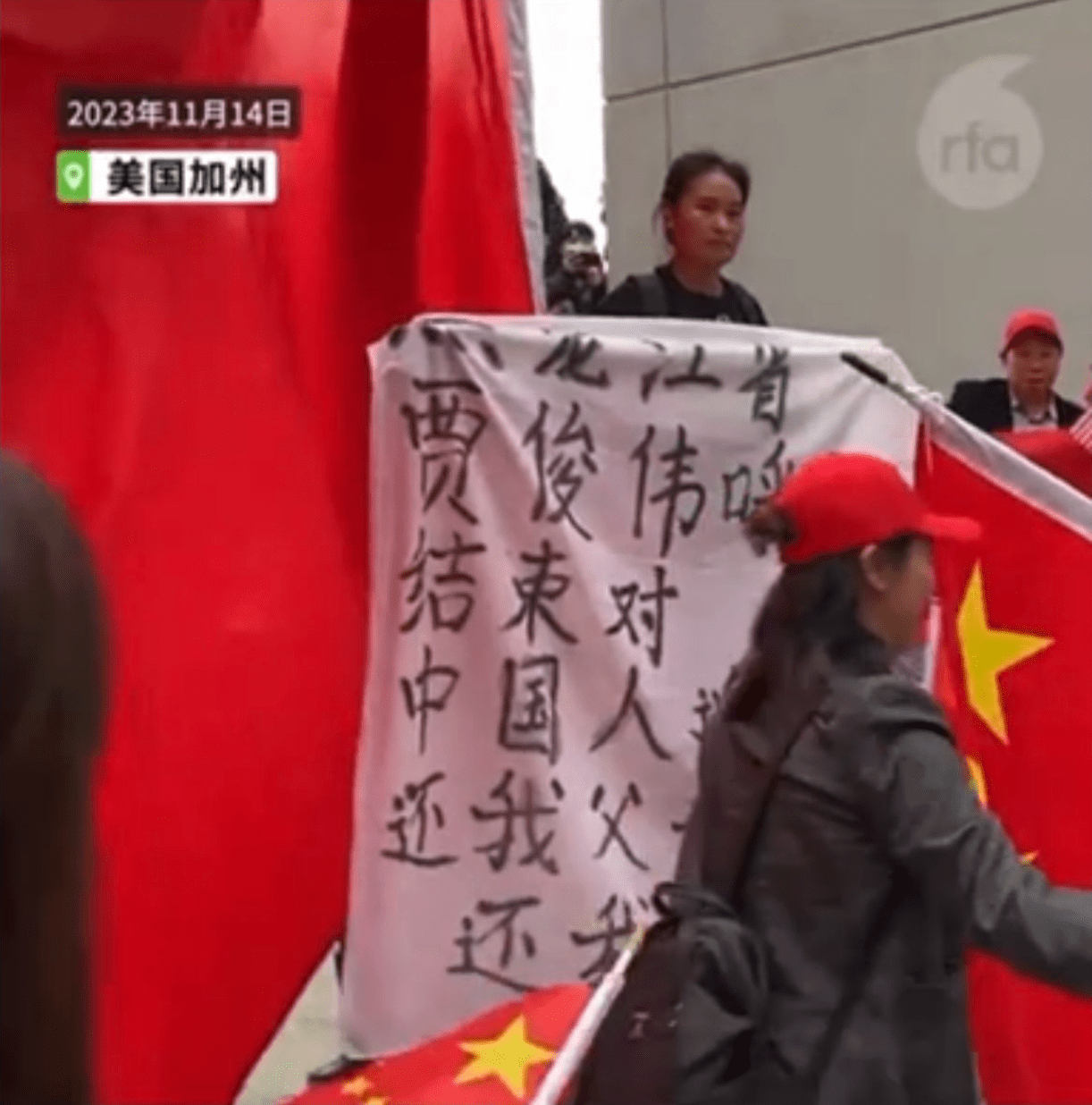
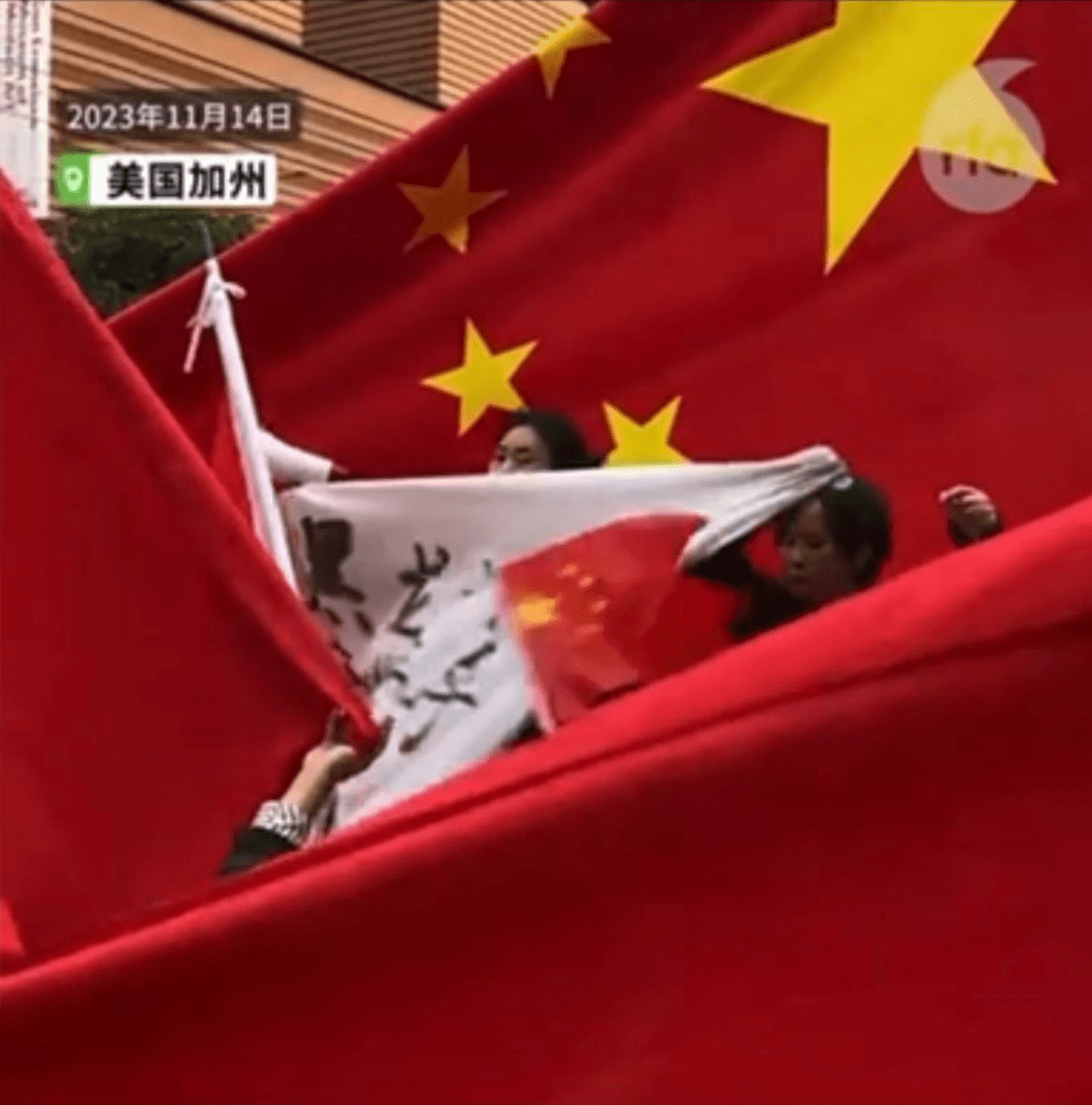
In the following photo, CCP supporters have taken Jia’s banner and are surrounding her. Jia is the one wearing the black backpack and gray pants. Strikingly, a police officer stands in a position from which he must have a view of what is occurring but does nothing to intervene.
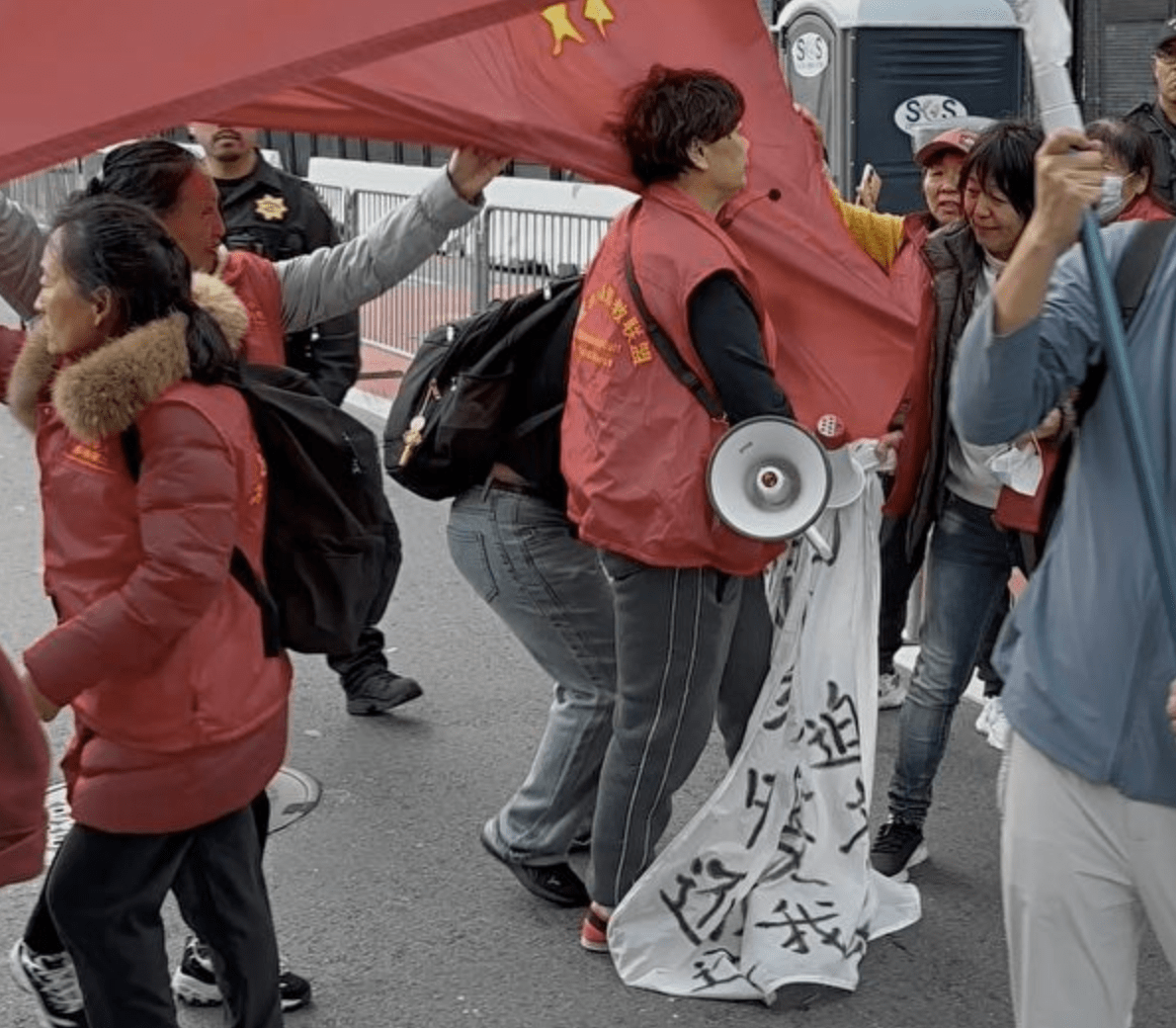
Only after Jia has been knocked to the ground unconscious does a police officer come to her aid.
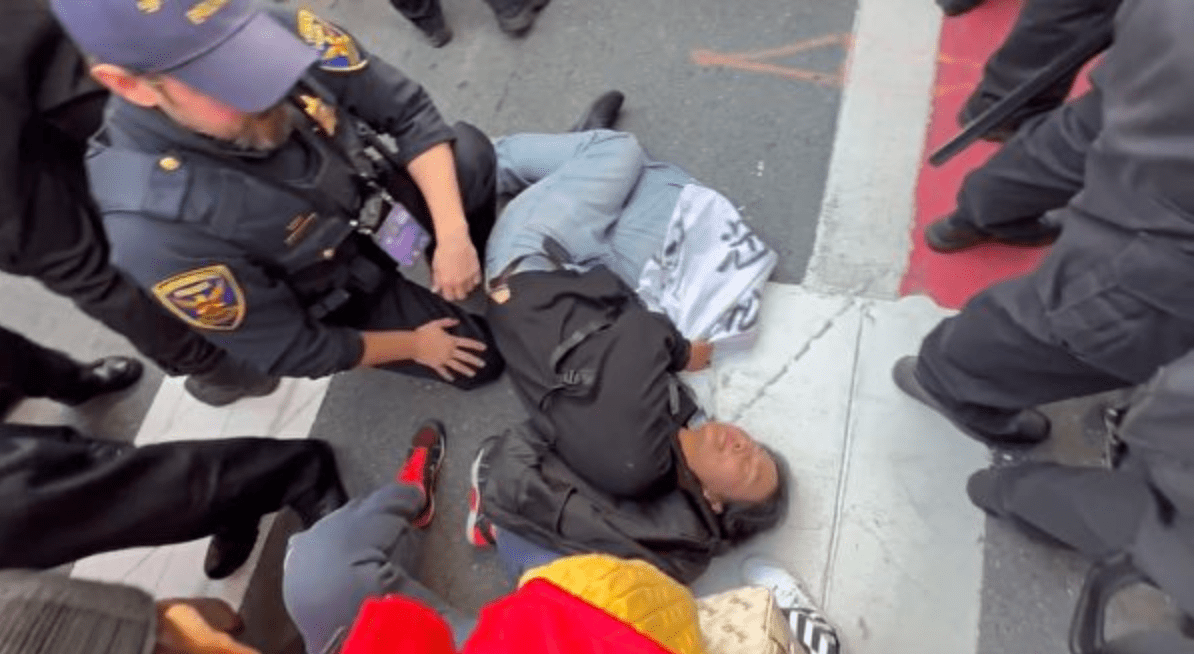
Six elements of this attack fit a pattern seen repeatedly over the days of Xi Jinping’s visit:
- an attack on solitary and isolated protesters by a group of CCP supporters;
- swarming of victim by multiple CCP supporters;
- the use of PRC flags to obscure the attacks;
- the use of flagpoles as weapons to hit and stab protesters;
- heightened aggression and violence when Xi Jinping is believed to be in the vicinity so as to ensure that he cannot see any signs of protest; and
- an apparent leader, often wearing an earpiece, who appears to be directing the CCP supporters.
After the attack, Jia said she was nauseated and had no appetite. She later went to Los Angeles where she visited a hospital and was diagnosed with symptoms “consistent with a concussion.” She was issued concussion discharge instructions and prescribed medication.97
Li Huahong, Prominent Leader of united front Group and an Alleged Assailant
The person whom Jia Junwei identified as her main attacker was Li Huahong (李華紅). Jia says Li snatched her banner, dragged her into the encirclement of PRC flags, pulled her hair, and hit her in the head. After Jia fell to the ground, Li kicked her in the waist. Jia claimed Li was the leader of the attack. She wore an earpiece and headphones and held a loudspeaker.98 She is the woman in the photo above with the white megaphone strapped to her shoulder.
Li was alleged to be involved in other attacks on subsequent days. On November 15, outside the Hyatt Regency Hotel where a banquet was held in Xi Jinping’s honor, she was among a group of CCP supporters, some of whom later attacked protesters.
On November 16, Ge Kaiying (葛開英) reports that she was attacked at noon by Li Huahong on Fourth Street in downtown San Francisco. She was alone and said Li recognized her from her presence at protests on previous days. According to Ge, Li stepped on her feet, then grabbed a box from her. When Ge tried to recover her belongings, Li hit her.99
On November 16, China Democracy Party leader and protester Chen Chuangchuang (陳闖創) was pepper-sprayed in the face by an assailant who suddenly rushed at him (see below). Right before the incident, Chen had noticed Li Huahong, whom he recognized because they both live in Chinese communities in New York City.
Chen reports that, on November 15, Li was chatting with someone from Chen’s group, though she did not know that person was a protester. She told this person that she was being paid about $200 a day to be in San Francisco and, after “welcoming Xi” on November 14, had been treated to a lobster dinner.100
Li Huahong is a prominent united front figure. Since the founding of the Chinese Anti-Cult World Alliance (全球華人反邪教聯盟, CACWA), Li has represented herself as its chairperson.101 According to its mission statement in its Certificate of Incorporation in New York State, as a not-for-profit corporation, CACWA is dedicated to “expos[ing] Falun Gong as an evil and dangerous threat to society.” CACWA is a branch office or affiliate organization of the China Anti-Cult Association (中國反邪教協會, CACA). CACA is officially a private organization in the PRC, but it “has close ties with the CCP and is generally perceived as part of its apparatus.”102 CACA has created branch offices or affiliate organizations such as CACWA around the world to conduct “comprehensive suppression overseas.”
According to the Human Rights Law Foundation, “CACWA’s chairpersons and affiliates have…been implicated in numerous instances of violence, death threats, and property destruction targeting Falun Gong practitioners…”103
Both Li and other members of CACWA were convicted in 2013 of assaulting Falun Gong practitioners and people they suspected of being associated with Falun Gong in 2011 in New York City.104
Li Huahong was wearing a CACWA vest when she assaulted Jia Junwei on November 14 (see photo above). A man wearing a CACWA jacket was part of a group that attacked Tibetan protesters inside a parking garage across from the Hyatt Regency Hotel on November 15.
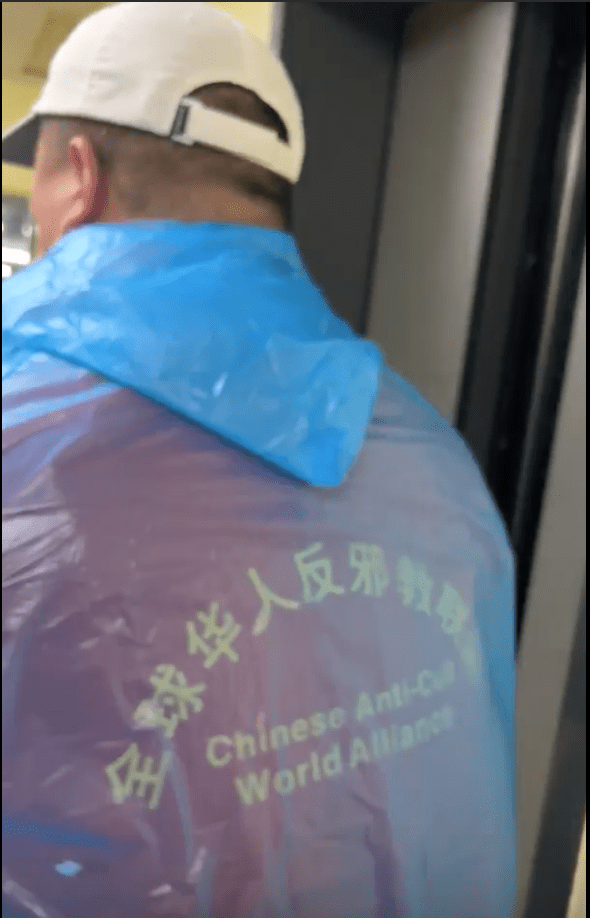
A CACWA banner was hung on a barricade near an attack on Tibetan and Hong Kong protesters on the street across from the Hyatt Regency on November 15.
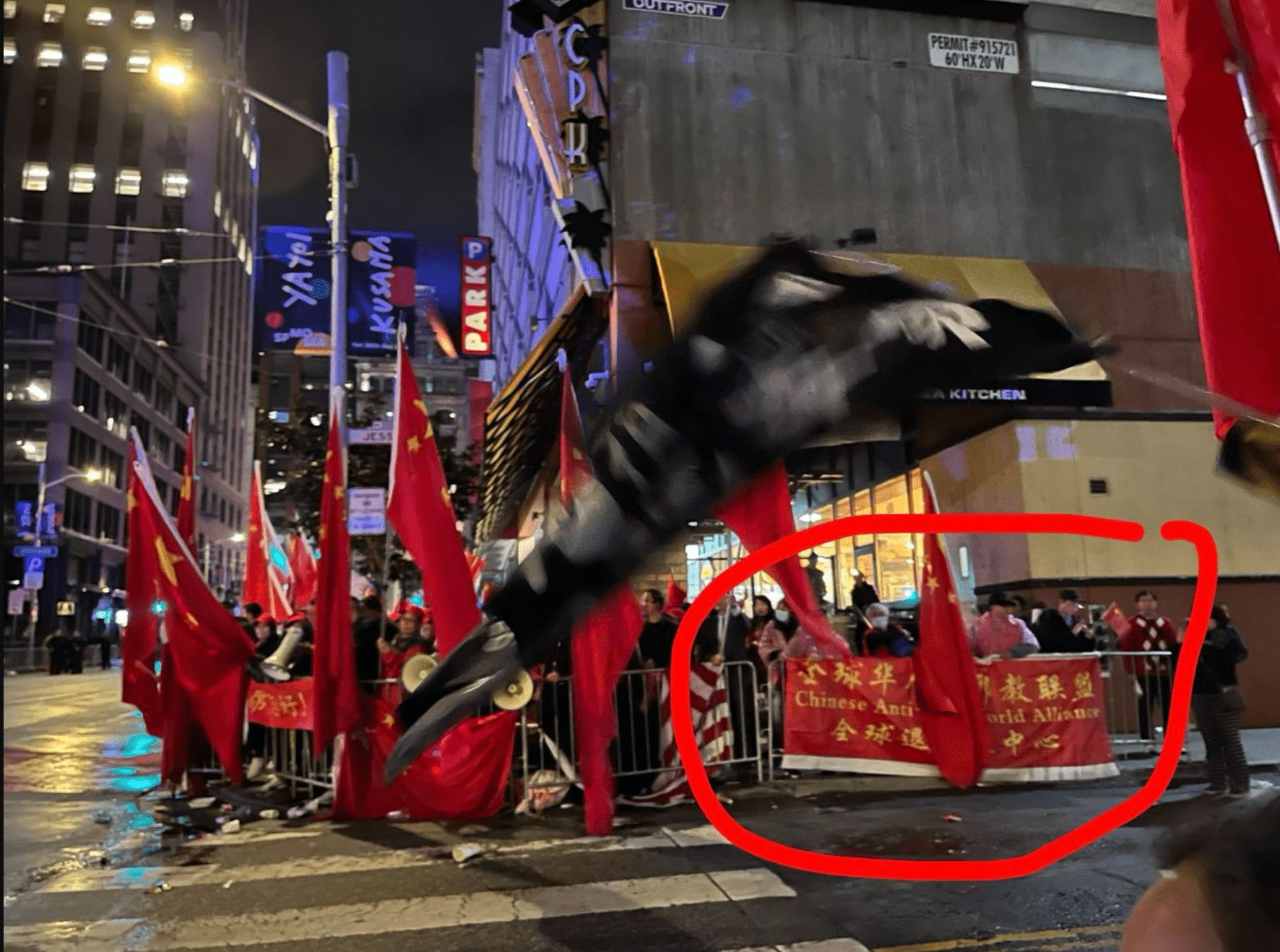
Wednesday, November 15
Second day of Xi Jinping’s visit to San Francisco
In the afternoon, US President Joe Biden and Xi Jinping met at the Filoli Estate, a distance of about 25 miles from downtown San Francisco. Beginning in the morning and stretching into the afternoon, a large rally and march were held by Chinese, Hong Kong, Tibetan, and Uyghur protesters. The march began at the Consulate General of the People’s Republic of China in San Francisco and proceeded through downtown San Francisco. In the evening, US business organizations hosted a banquet in honor of Xi Jinping at the Hyatt Regency Hotel in downtown San Francisco. Outside the hotel where the Xi banquet took place, there was a pervasive threatening atmosphere; protesters faced constant harassment and intimidation by CCP supporters. Over the course of the day, at least 10 protesters were assaulted by CCP supporters.
Among the serious incidents reported or recorded that day were these:
- an assault on Chinese activist Wang Wei outside the St. Regis;
- harassment of Tibetan activist Tsela Zoksang and the Tibetan protesters accompanying her as she climbed a flagpole outside the Hyatt Regency;
- an attack on four Tibetan activists in a parking garage across from the Hyatt Regency by a group of 10 to 15 men;
- an attack on Hong Kong and Tibetan protesters at the designated protest area that had been set up for them by police across from the Hyatt Regency;
- an assault on an elderly Hong Kong protester near the Hyatt Regency and
- the stalking of Tibetan protesters by the same group of men who attacked the designated protest area as the protesters left the area near the Hyatt Regency at the end of the protest.
On the Route from Downtown San Francisco to the Filoli Estate
The route from downtown San Francisco to Filoli, where the Biden-Xi meeting took place, was lined with CCP supporters who were bused there from their accommodations. Their positioning along Cañada Road suggests that they were alerted to the route that Xi’s motorcade would take to reach Filoli, as there are two possible routes, and the attendees were all lined up along the route the motorcade eventually took. Some Chinese protesters also gathered there. Scuffles broke out among some CCP supporters and Chinese protesters as the CCP supporters used their numbers to try to deny space to the protesters, crowding them out, and attempting to ensure that they could not be viewed from vehicles passing on the road.105
Rally and March Protesting against Xi Jinping
In the morning, Chinese, Hong Kong, Tibetan, and Uyghur protesters gathered at the Chinese consulate of San Francisco for a rally. Afterwards, more than one thousand protesters marched through downtown San Francisco.106 The march was accompanied by police officers.
The rally and march were one of the few occasions during the days of Xi Jinping’s visit in San Francisco when protesters were not attacked, harassed, or intimidated by CCP supporters. This is primarily due to three factors:
- It did not go anywhere near where Xi Jinping was expected or scheduled to be.
- It was accompanied by a significant deployment of police officers.
- It was large.
Conversely, most of the incidents of harassment, intimidation, and assault occurred near locations where Xi Jinping was present or expected to be and where CCP supporters outnumbered protesters. At those locations, there were large deployments of police officers, but more often than not, police did not appear to regard the protection of citizens as their primary duty, and their apparent indifference signaled to CCP supporters that they would not be held accountable for their actions.
Only when arriving in downtown San Francisco, at Market and Third Streets, did the marching protesters meet CCP supporters who had already started to gather in large numbers in the vicinity of the Hyatt Regency Hotel, about one block away. The hotel was the venue of the banquet for Xi to be held that evening. The large contingent of Tibetans, hundreds strong, as well as a group of Uyghurs, had originally planned to go to the Hyatt Regency to protest in the evening, but a significant portion of them were dissuaded from doing so by the sight of the large number of CCP supporters already gathering there. The CCP supporters had formed a physical wall of people that appeared to block passage to the Hyatt Regency. They feared there might be confrontations, and, for the sake of the safety of the protesters, they decided it was best to avoid that possibility. Students for a Free Tibet Executive Director Pema Doma said, “We’d originally wanted 500 Tibetans marching toward Tsela’s flag-raising action [see more on that below], but, when we saw how many CCP supporters there were and how aggressively they behaved, we decided it was too confrontational to lead the large protest. This was around 4 or 5 p.m. We said to the Tibetans, anyone who feels unsafe can go home; anyone who wants to stay, we will continue to protest. Nearly all the elders and children decided to return home, and a small contingency of mostly young adults remained to have our voices heard.”107 A smaller group of Uyghurs also decided to leave for the sake of safety.108 This is a clear instance of the large numbers of CCP supporters, who had already harassed, intimidated, and assaulted a number of protesters, having a deterrent effect on protest. Some Hong Kong and Tibetan activists would later go to the Hyatt Regency to protest, and their experience would substantiate the fears of the Tibetans and Uyghurs who did not go.
Assault on Wang Wei
While the march was taking place, Chinese activist Wang Wei (王維) was assaulted near the St. Regis Hotel at about 11 a.m.109 Like Jia Junwei the day before, Wang was not accompanied by other protesters, and his isolation appears to have emboldened his attackers.
Wang Wei testified that he noticed some CCP supporters and started taking videos of them because he feared attack and thought filming them might act as a deterrent or at least provide evidence in case of attack. He wore a “Free China” sticker on his arm and believed this excited their animosity. He and they exchanged sharp words. Then the CCP supporters began attacking him. There were some middle-aged men and a woman wearing a blue cheongsam. She shoved Wang three times. He warned the group that if he was pushed again, he would take action. After another shove, he stuck out a leg, and the men surrounded him and started beating him. They pushed him to the ground. The attackers then surrounded him with their large PRC flags and continued to strike him. One of them stabbed him with the tip of a metal flagpole. Still lying prostrate on the ground and realizing he was all alone, Wang grabbed the leg of a person who tried to kick him. After he grabbed the leg, others began kicking him as well, and continued to punch him. Wang became disoriented and felt as if he were going to faint. Only later did he learn that he was able to escape due to two white women who broke things up. They placed themselves between Wang and his assailants. They asked him if he was okay and helped him to call the police. Later, an ambulance came and took Wang to the hospital, where he received treatment. He and friends had originally planned to return to Los Angeles, where he lives, that evening, but then discovered that one of the tires of his car had been punctured by two large screws. He didn’t know whether or not this was done deliberately.
In the video above, a young security guard from the National Protective Service Private Security, a company allied with the CCP supporters, makes a feeble attempt to intervene but almost immediately desists. He then turns to a police officer standing on the other side of the black metal fence separating the sidewalk from the road, apparently to point out the assault to him. The police officer takes no action.
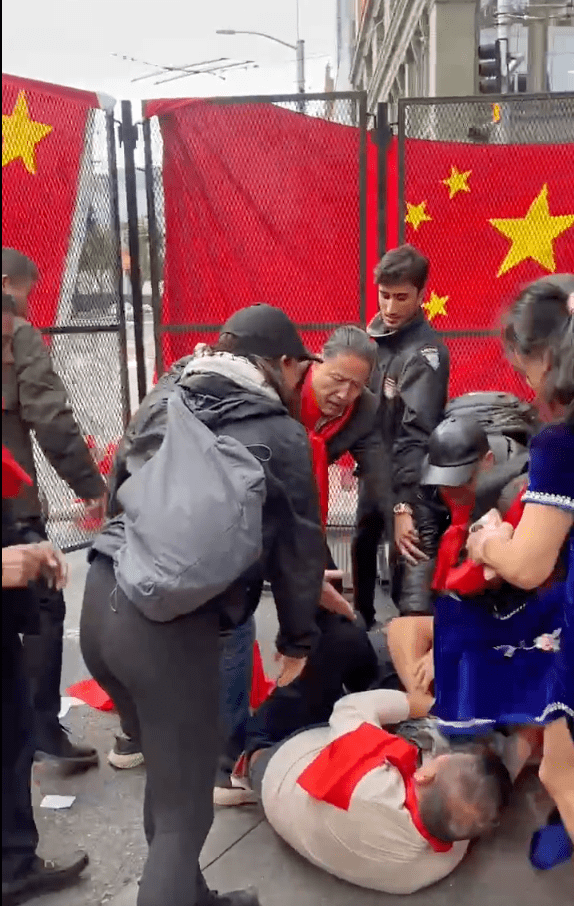
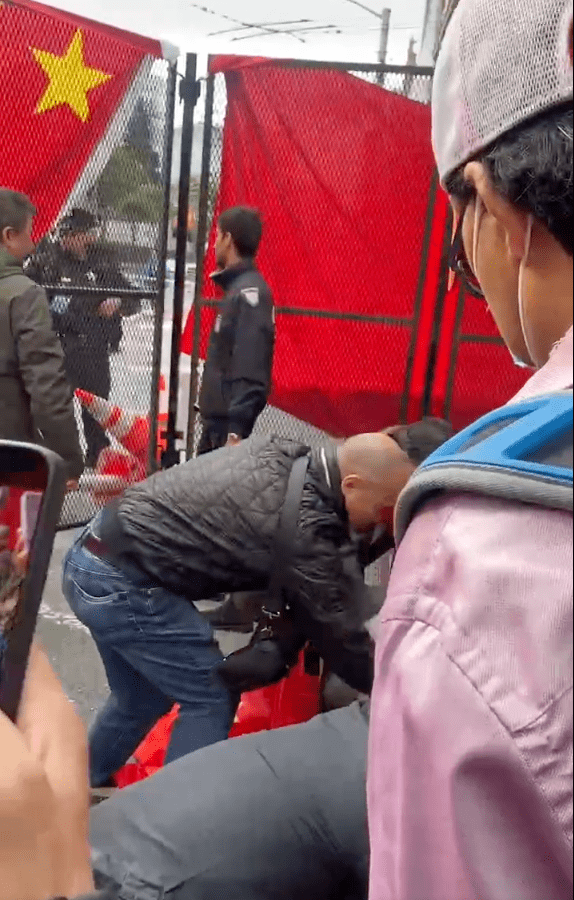
On November 21, Wang returned to San Francisco to file a report about the assault with the police . As of February 1, 2024, when he was interviewed for this report, he had not heard back from the police about whether or not they had taken any action.111
Wang Wei identified the people in the following photographs as his attackers.
The attack on Wang Wei involved four united front leaders from the Seattle area. One of them, the woman dressed in the blue cheongsam who precipitated the attack on Wang, is named Zhuo Ma (卓瑪), also known as Wengxi Zhuoma (翁西卓瑪), also known as Youyong (游泳).113
She is President of the Sichuan Association of Washington State (美國華盛頓州四川同鄉總會), a united front group in the Seattle area. According to her bio on a pro-CCP website, she was born into a “revolutionary family” in China and came to the US in 2010. She “welcomed” Xi Jinping on a previous visit of his to the US in 2015 as part of the “special team” of Liang Guoyao (梁國堯), a prominent united front leader who holds multiple positions related to his place of origin, Guangdong Province.114
China Democracy Party (中國民主黨) leader Chen Chuangchuang (陳闖創), who would himself become a victim of assault by CCP supporters the following day, the 16th, said that Zhuo Ma confronted a group of protesters around 9 a.m. on the morning of the 15th, about two hours before the assault on Wang Wei, and, at that time, admitted that she was a member of the Chinese Communist Party.115
A second assailant of Wang Wei from the united front network in the Seattle area is Guo Jianwei (郭建偉).
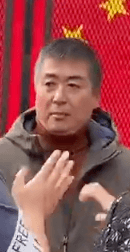
In the video above, Guo can be seen punching Wang Wei (see 1:00).
He is president of the Henan Association of Washington State (華州河南同鄉會), a united front group in Seattle. In a speech given at an event celebrating the fourth anniversary of the Henan Association in March 2019, Guo boasted of his organization’s ties to the Henan Province Overseas Chinese Association (河南省僑聯), a united front group based in Henan Province, as well as to the Henan Province Zhi Gong Party (河南省致公黨).116 The China Zhi Gong Party is one of the eight minor parties of the PRC under the control of the united front Work Department. According to united front expert Anne-Marie Brady, “The Zhi Gong Party is a united front link to liaise with overseas Chinese communities…”117 It is a member of the Chinese People’s Political Consultative Conference, the top-level united front body.118 Guo was also present in Los Angeles at an April 2023 protest against Taiwan’s then-president Tsai Ing-wen’s visit to the US and can be seen standing alongside He Konghua (何孔華), a prominent San Francisco united front leader who also appeared among CCP supporters at the San Francisco International Airport on November 17, the day of Xi’s departure (see above and below).119 Also attending that protest against Tsai with Guo Jianwei and He Konghua, were two other united front figures, Jing Dongsheng and Rong Junwu, both of whom were active on the streets of San Francisco during Xi Jinping’s visit as well (see above). Guo also appears briefly in a video of the April 2023 Los Angeles protest against Tsai made by the satirical comic LeLe Farley.120
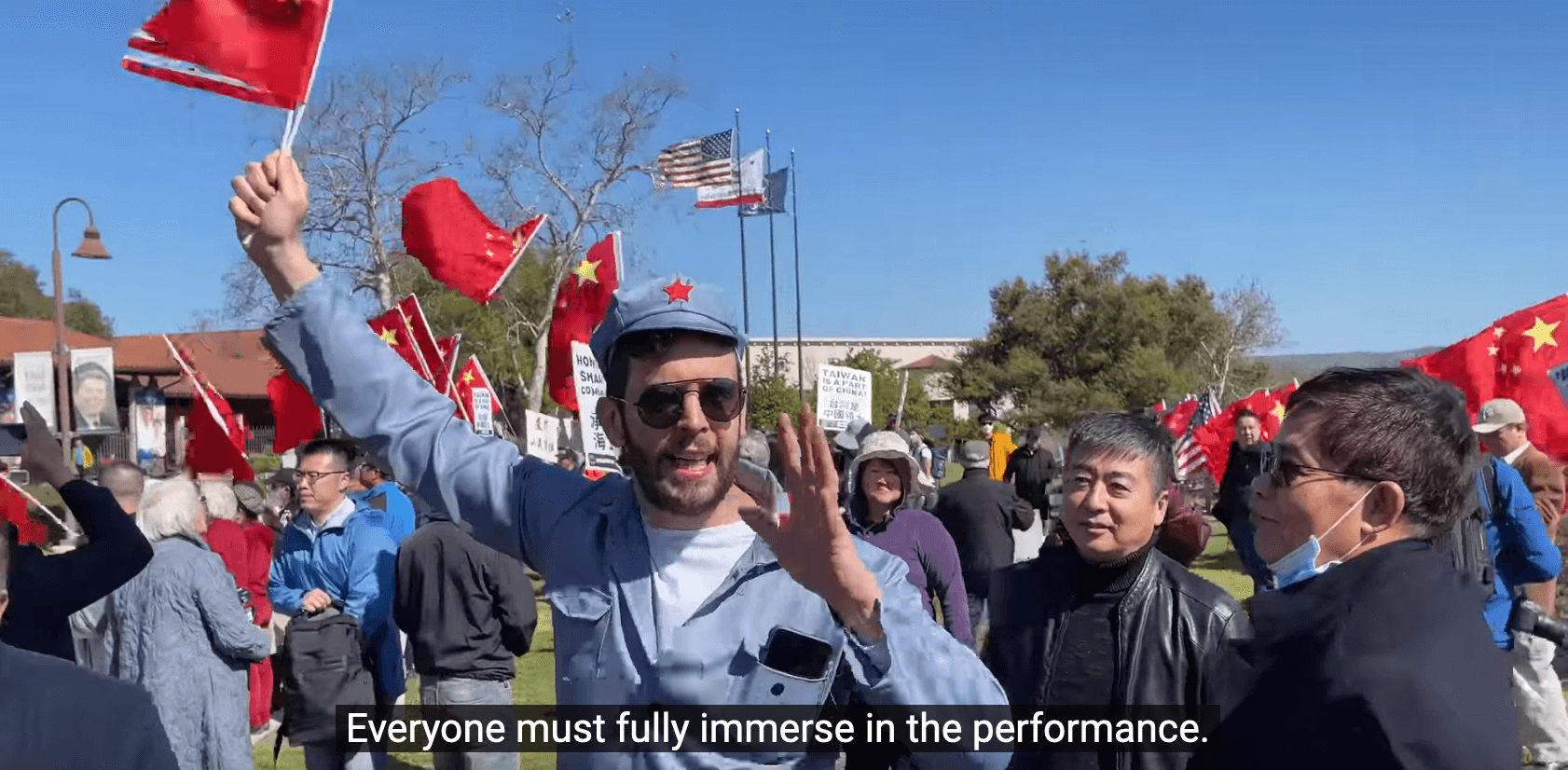
A third united front leader from the Seattle area involved in the assault on Wang Wei is Fang Weixia (方偉俠), chair of the Association for China’s Peaceful Reunification of Washington State (華盛頓州中國統一促進會會長). He can be seen punching (see 1:00) and kicking (see 1:13) Wang Wei in the video above.
In September 2019, Fang spoke at an event celebrating the 70th anniversary of the founding of the PRC. Zou Yonghong (鄒永紅), Deputy Consul General of the PRC consulate of San Francisco, also spoke at that event. Guo Jianwei (see above) was also present on that occasion.121 In June 2022, he met Consul General Zhang Jianmin at the PRC consulate in San Francisco. The latter recognized Fang’s work as head of the Association for China’s Peaceful Reunification of Washington State to promote US-China relations and China’s “peaceful reunification.”122
Lastly, a fourth united front leader involved in the assault on Wang Wei is Chen Wenshen (陳文深). He first appears at the 00:47 mark in the video above.
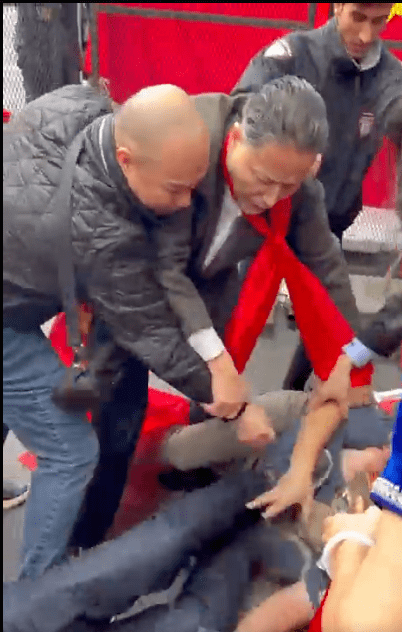
Chen is vice president of the Seattle-area Fujian Chamber of Commerce and Industry in Washington State (華州福建工商會). In March 2019, Zou Yonghong (鄒永紅), Deputy Consul General of the Chinese consulate of San Francisco, attended and spoke at the founding ceremony of the Chamber, as did other united front figures including Fang Weixia (方偉俠; see above), president of the Association for China’s Peaceful Reunification of Washington State (華州中國統一促進會會長), and Jing Dongsheng (靖東升; see above), president of the Oregon Association for China’s Peaceful Unification (俄勒岡州中國統一促進會).123
Bald-headed Chen was, according to protesters, probably the most ubiquitous and easily recognizable united front figure on the streets of San Francisco during Xi Jinping’s visit. He seemed to show up just about everywhere that protesters went. Chen was seen by protesters at the scenes of five incidents of harassment, intimidation, and assault in San Francisco during Xi Jinping’s visit.
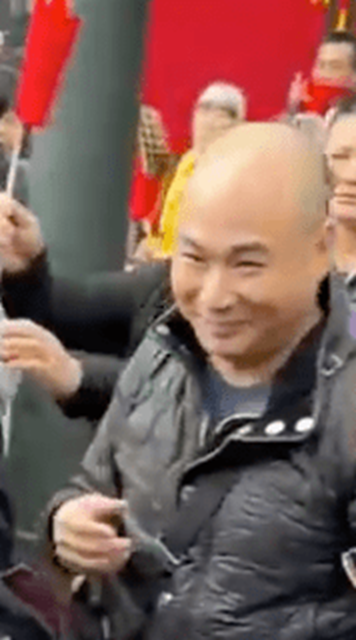
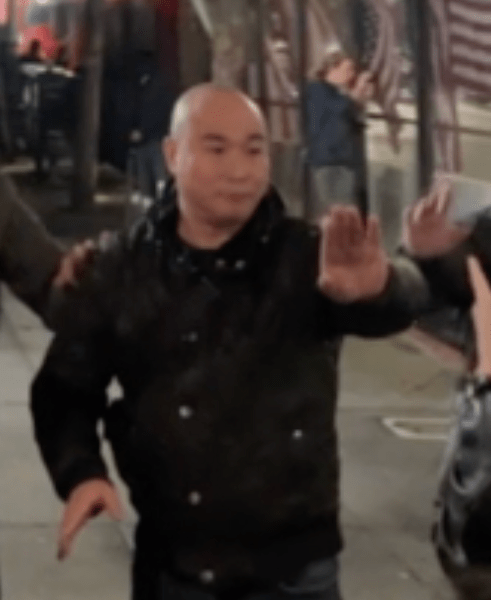
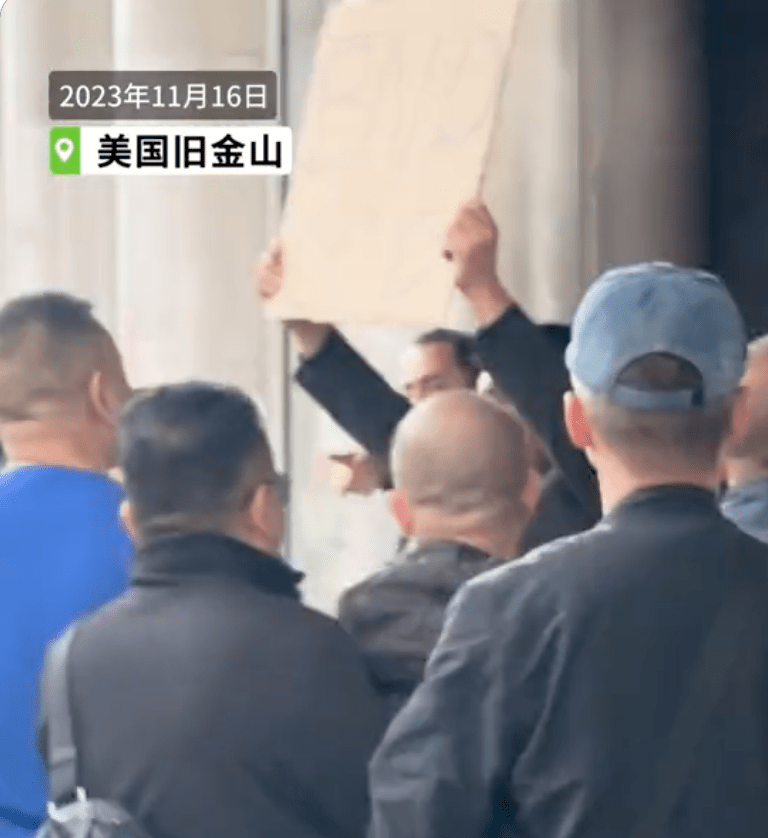
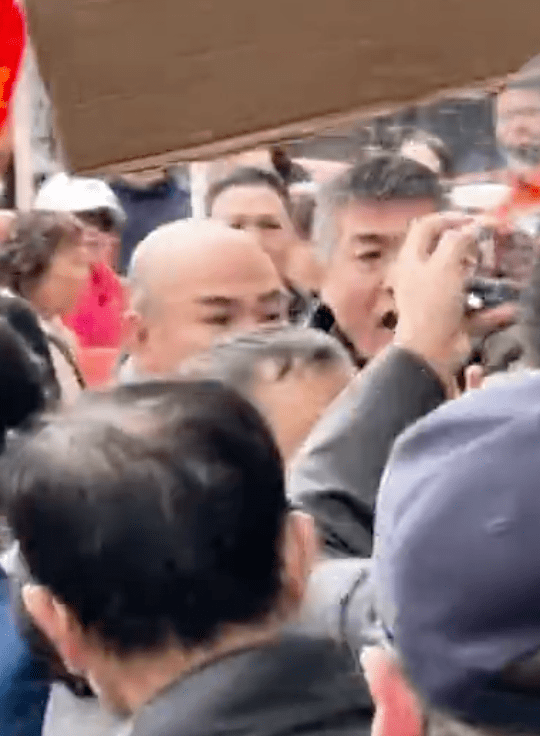
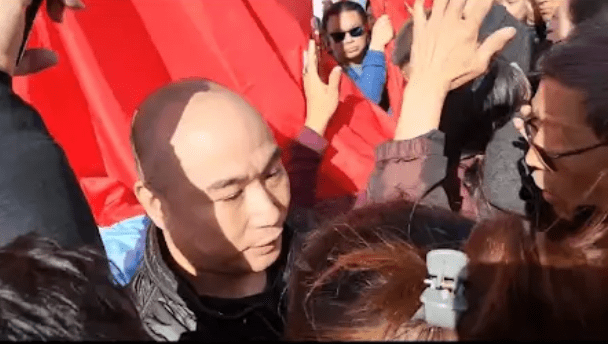
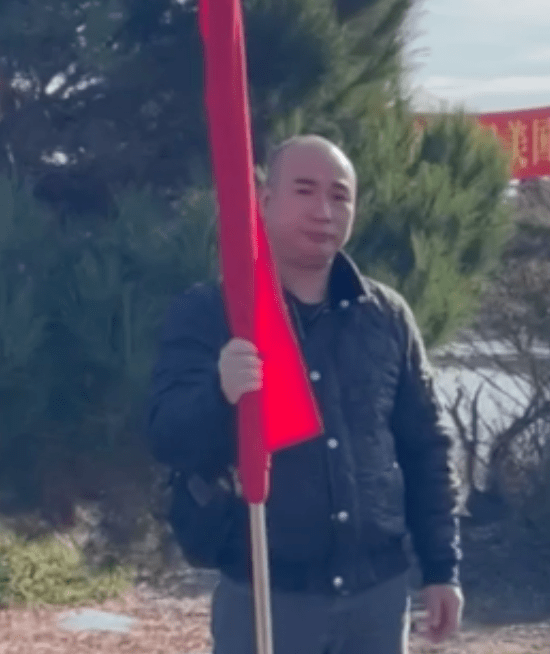
In November 2019, Chen was among a group of united front figures in Seattle that welcomed a visiting delegation from the China Council for the Promotion of Peaceful National Reunification (中國和平統一促進會; CCPPNR) from Beijing at an event with the Association for China’s Peaceful Reunification of Washington State (華州中國統一促進會), the united front group of which Fang Weixia is the president.124 125 The ACPR’s affiliation with the CCP and PRC was stated explicitly at the meeting by Sun Lingyan, the Deputy Secretary-General of the CCPPNR, who said that then-member of the Politburo Standing Committee of the Chinese Communist Party and then-Chair of the National Committee of the Chinese People’s Political Consultative Conference Wang Yang was its president and that the executive vice-president was the Minister of the united front Work Department.126 127
At least six other people appear to have participated in the assault on Wang Wei (see video above).
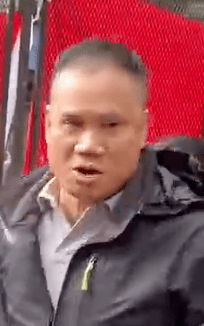
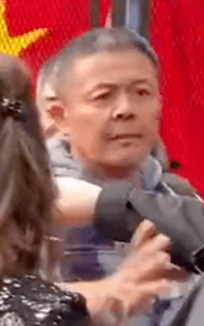
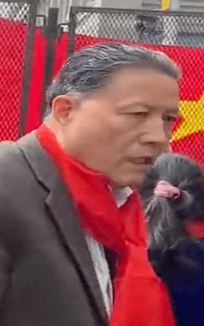
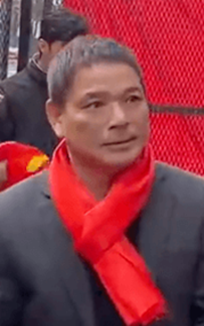
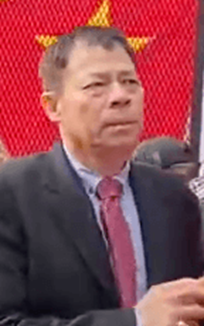
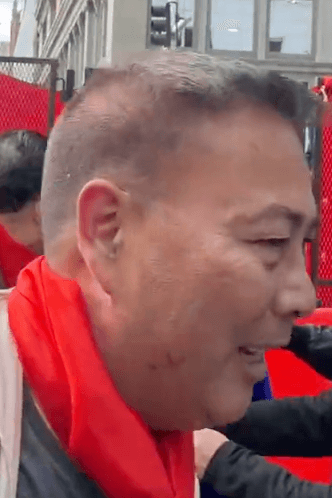
The Hyatt Regency Hotel
On the evening of November 15, the National Committee on United States-China Relations and the United States-China Business Council, in cooperation with the Asia Society, the Council on Foreign Relations, the United States Chamber of Commerce, and the China General Chamber of Commerce-USA,128 held a banquet for Xi Jinping at the Hyatt Regency Hotel in downtown San Francisco. Hundreds of CCP supporters gathered outside the hotel as well as dozens of Chinese, Hong Kong and Tibetan protesters. While US business and political elites feted Xi, at least eight protesters were assaulted by CCP supporters, several violent attacks occurred, and an atmosphere of intimidation was pervasive outside the hotel.
The banquet was attended by more than 300 US business executives129 as well as high-level political figures. Individual seats at the banquet went for $2,000 each, while companies could purchase eight seats at a table plus one seat at Xi Jinping’s table for $40,000.130 The host organizations are among those that have, for decades, been in the forefront of advocating a US policy of so-called “engagement” with China, which in practice has meant a prioritization of business, finance, and trade interests to the detriment of other important issues, such as national security and human rights. Unsurprisingly, no one spoke about the latter issues at the banquet, and no one advocating for human rights or a higher prioritization of national security was present.131
Xi Jinping received a standing ovation132 from the business executives and political leaders, a spectacle the PRC state propaganda organ CCTV covered with relish.133
The first speech of the evening was given by Marc Casper, who is both Chairman of the U.S.-China Business Council, and Chairman, President, and CEO of Thermo Fisher Scientific.134 Thermo Fisher has for years been criticized by human rights groups for selling DNA identification technology to repressive public security organs in China, Tibet, and Xinjiang.135 In fact, one of the institutional authors of this report, Students for a Free Tibet, has campaigned extensively against Thermo Fisher’s helping PRC authorities to steal Tibetan DNA.136 During the banquet, over which Caspar presided, SFT members were attacked by CCP supporters no more than several hundred yards away.
Among those attending the banquet were representatives of the host organizations as well as many prominent US business executives137 and California political elites.138 In accordance with the evening’s decorum, nothing controversial was mentioned.
Many of those interviewed for this report—especially, but not exclusively, those residing in California—believed the emphasis by high-profile and influential California politicians on “good relations” between California and the US on the one hand and China on the other has contributed to the complacent environment that led to authorities in San Francisco being unprepared for, and perhaps unconcerned about or indifferent to, the attacks perpetrated by CCP supporters on the city’s streets.
California Governor Gavin Newsom was among the first to greet Xi Jinping as the latter stepped off his jet at San Francisco International Airport on November 14.139
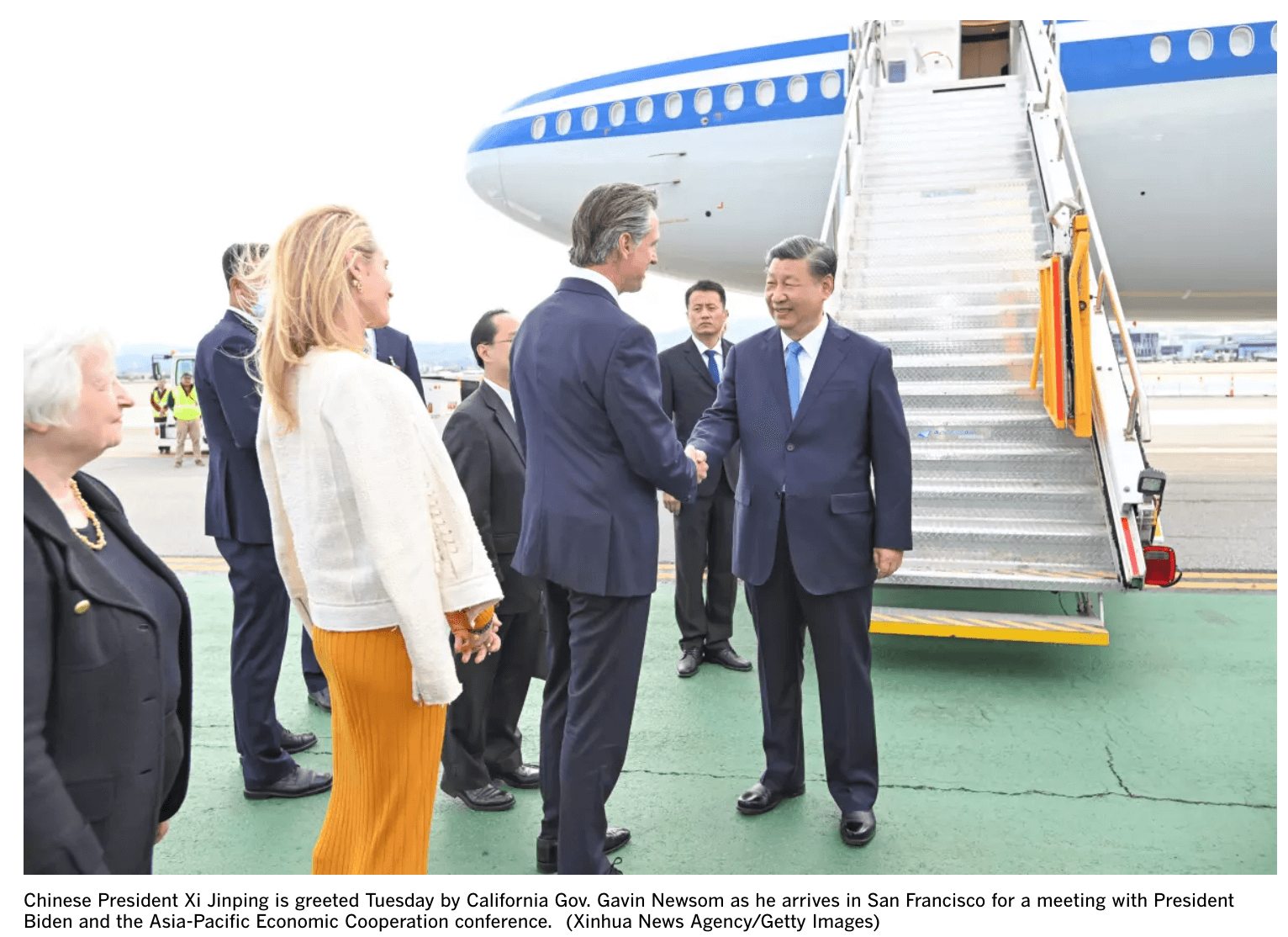
Before the banquet for Xi at the Hyatt Regency, Newsom presented Xi with a Golden State Warriors jersey. This occurred while residents of his state were being beaten by Xi Jinping’s supporters outside.
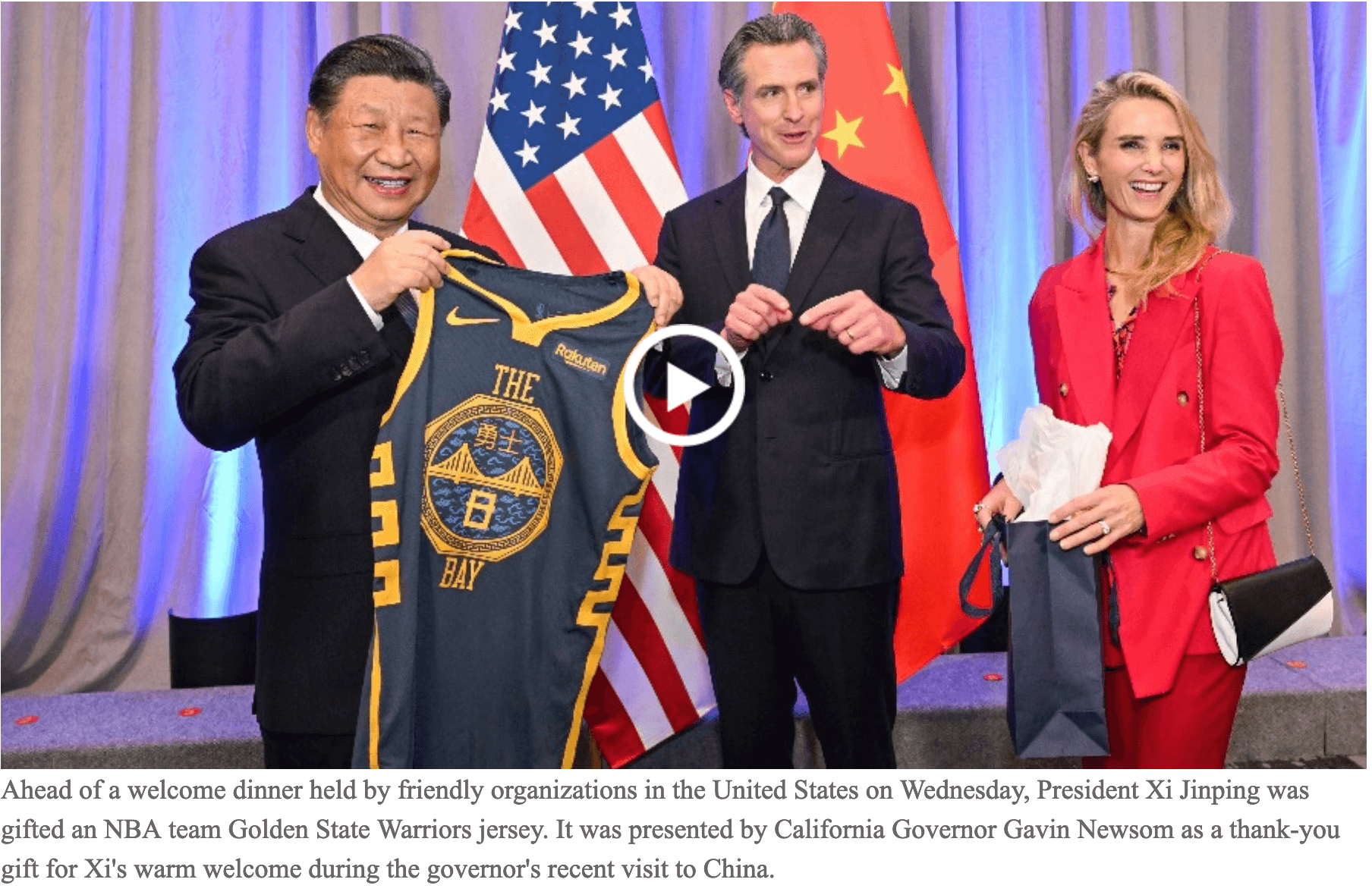
In October 2023, just weeks earlier, Newsom visited Hong Kong and China, where he met Xi. The visit was heavily criticized by 20 California-based groups representing Hong Kongers, Taiwanese, Tibetans and Uyghurs as well as 43 other Chinese, Hong Kong, Taiwanese, Tibetan, Uyghur, and human rights groups in a joint letter to Newsom.140 In the lead-up to Newsom’s trip, he ruled out discussing human rights with his counterparts in Hong Kong and China. Human Rights Watch called on him to do so.141 Eventually, after pressure from bipartisan political leaders and human rights groups, his office reported that he raised the issue, though it did not report specifically to whom he spoke or in what context.142 HKDC Executive Director Anna Kwok attempted to arrange a meeting with Newsom while both were in San Francisco during Xi Jinping’s visit. The meeting did not occur; instead, Newsom’s office sent her a link to its press statement about his trip to the PRC.143
To date, no California politicians–neither the mayor of San Francisco nor the governor of the state nor any other prominent political figures–have said anything about the harassment, intimidation, or assaults that were enacted by CCP supporters in San Francisco during Xi Jinping’s visit.144
Chair Mike Gallagher (R-WI) of the House Select Committee on the CCP wrote to the hosts of the banquet criticizing them and requesting information about the dinner, including a full guest list and breakdown of proceeds.145
Harassment, Intimidation, and Attempted Attack on a Flagpole Protester
Shortly after 3 p.m., before the start of the banquet, Students for a Free Tibet Grassroots Coordinator Tsela Zoksang and a group of young Tibetan protesters went to the front of the Hyatt Regency Hotel, where Tsela began to climb a flagpole. They had excited very little attention from the CCP supporters as they passed through the crowd, but once she began to climb the flagpole, the CCP supporters suddenly realized she and her companions were protesters and began attacking them.
According to Tsela, “When I first began to go up the flagpole, I spent about 30 to 45 minutes just hovering a bit above head level. I didn’t go further during that time because of technical difficulty with the webbing that took some time to troubleshoot. Most CCP supporters initially assumed I was one of them. But once I unfurled the banner reading, ‘Dictator Xi, Your Time Is Up,’ they began to get rowdy and the situation rapidly escalated. Like me, plenty of young Tibetans were ‘camouflaged,’ but once I began unfurling the banner, things descended into chaos. The CCP supporters began grabbing at the banner. It was held up by tent poles, which they got hold of and began wielding like weapons. They waved huge Chinese flags in my face and used their flagpoles like weapons. Because I was holding on to the banner, I was pulled every which way, and the CCP supporters grabbed at my legs. But CCP supporters were going after Tibetan protesters far more than they were going after me. Lots of young Tibetans were pushed and shoved to the ground. I saw one person shoved to the ground and two whacked in the face and poked in the eye with flagpoles. My banner was snatched away. But I had a flag. I resolved the technical issue with the webbing and began to climb up. I got to about 25 to 30 feet above the ground and took out the flag.”146
In this video, Tsela can be seen to have climbed to that height. The large PRC flags previously blocking her from view at a lower height can be seen below her.
Tsela would remain on the flagpole holding out the Tibetan flag from 3:15 p.m .to 8:45 p.m. while the banquet went on inside the hotel.
A 17-year-old Tibetan protester who went to the flagpole with Tsela and stood near its base as she scaled it said, “We were a group of about a dozen teenagers. CCP supporters pulled our shirts. I was pushed, shoved, and pulled.”147
Topjor Tsultrim, Communications Coordinator with Students for a Free Tibet, corroborated Tsela’s report that CCP supporters pulled at her legs and tried to cover her with huge PRC flags: “One grabbed my friend’s butt and groped her, then accused us of pushing him. A CCP supporter followed me with a loudspeaker blasting propaganda into my ear. His own security guard told him to back off. There were several men who seemed to be calling the shots. They had earpieces and tried to take [Tsela’s banner] and kept snatching at her.”
Topjor also singled out a woman in a purple jacket.148
After Tsela ascended the flagpole, this woman and her accompanying security guard tried to prevent Topjor from leaving the area near the base of the flagpole by repeatedly moving to stand in front of him and telling him he could not leave. Later in the evening, Topjor saw her at a checkpoint outside the Hyatt Regency. At this point, the police officers at the checkpoint were allowing only hotel workers and banquet guests to enter the hotel. The woman in the purple jacket told the police officers, “Let me through,” showed her badge, and was allowed to enter the hotel. This gave Topjor the impression that she may have been associated with, or even a part of, the Chinese delegation accompanying Xi Jinping at the banquet that evening. Topjor saw her also on the 14th of November near the airport when Xi was due to arrive in San Francisco and again on the 17th when he was to depart. Then, too, she was accompanied by security guards who appeared to be acting as her bodyguards. She was liaising with a police officer who appeared to be showing her his contact details, which she entered into her phone. Another man stepped in front of Topjor and instructed him that he was not allowed to videotape this interaction, despite it taking place on a public sidewalk and with an on-duty police officer.149 In both locations she was accompanied by what appeared to be her own personal security guard (for more on her at the San Francisco International Airport on November 17, see below).
Sonamtso, who is on the international board of directors for Students for a Free Tibet, was among those who accompanied Tsela. She said that, even after Tsela ascended the flagpole, Tibetans on the ground continued to be harassed and intimidated: “CCP supporters used giant flags and tried to tie them to the black metal fence the police had put up. One of us put up the Tibetan flag. They removed it. They tried to block us from public view. There was a woman in green constantly trying to obscure our view. She was really into this, like it was the only thing she was tasked with. She continued to shove the Chinese flag in front of us. That went on for some time. I tried to communicate with police about what was happening, and I pointed her out to them. I told the police, You have to do something. They’re all over, and we’re not allowed to move.” The police gave the Tibetans an ultimatum: Go to a designated protest zone on the other side of the street or leave. Sonamtso wanted the Tibetans to be safe but was afraid that moving away from Tsela would leave her more vulnerable. Eventually, the Tibetans agreed to move.150
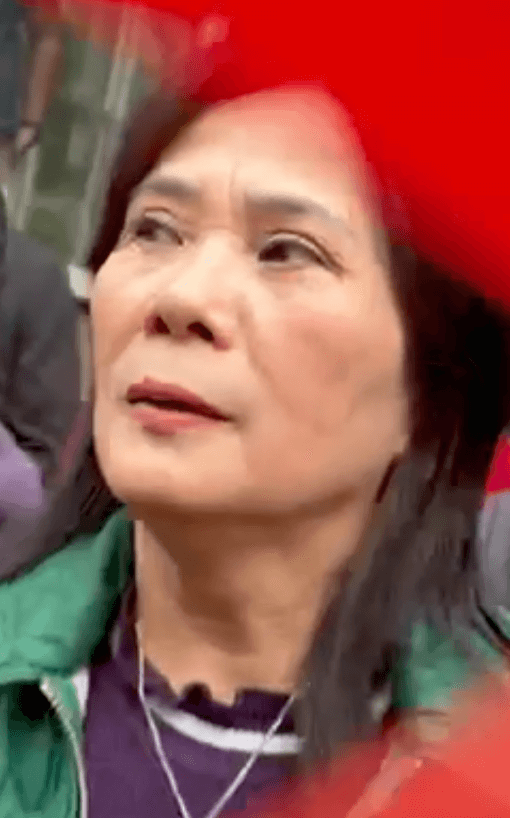
The woman in green can be seen incessantly hitting protesters with her small flags in the video below. Eventually, a police officer directs her to back away. The woman in purple, suspected of being affiliated with the Chinese consulate or delegation, meekly attempts to intercede on behalf of the woman in green.
The woman in green appears to be associated with the American Fujian Association (美國福建同鄉會; AFA, sometimes rendered into English—including by the group itself—as the Fukien American Association). She has appeared together with Chen Heng (陳恆), the chair of AFA, at AFA events. 151
In San Francisco, they also stood side by side, as can be seen in this screenshot:
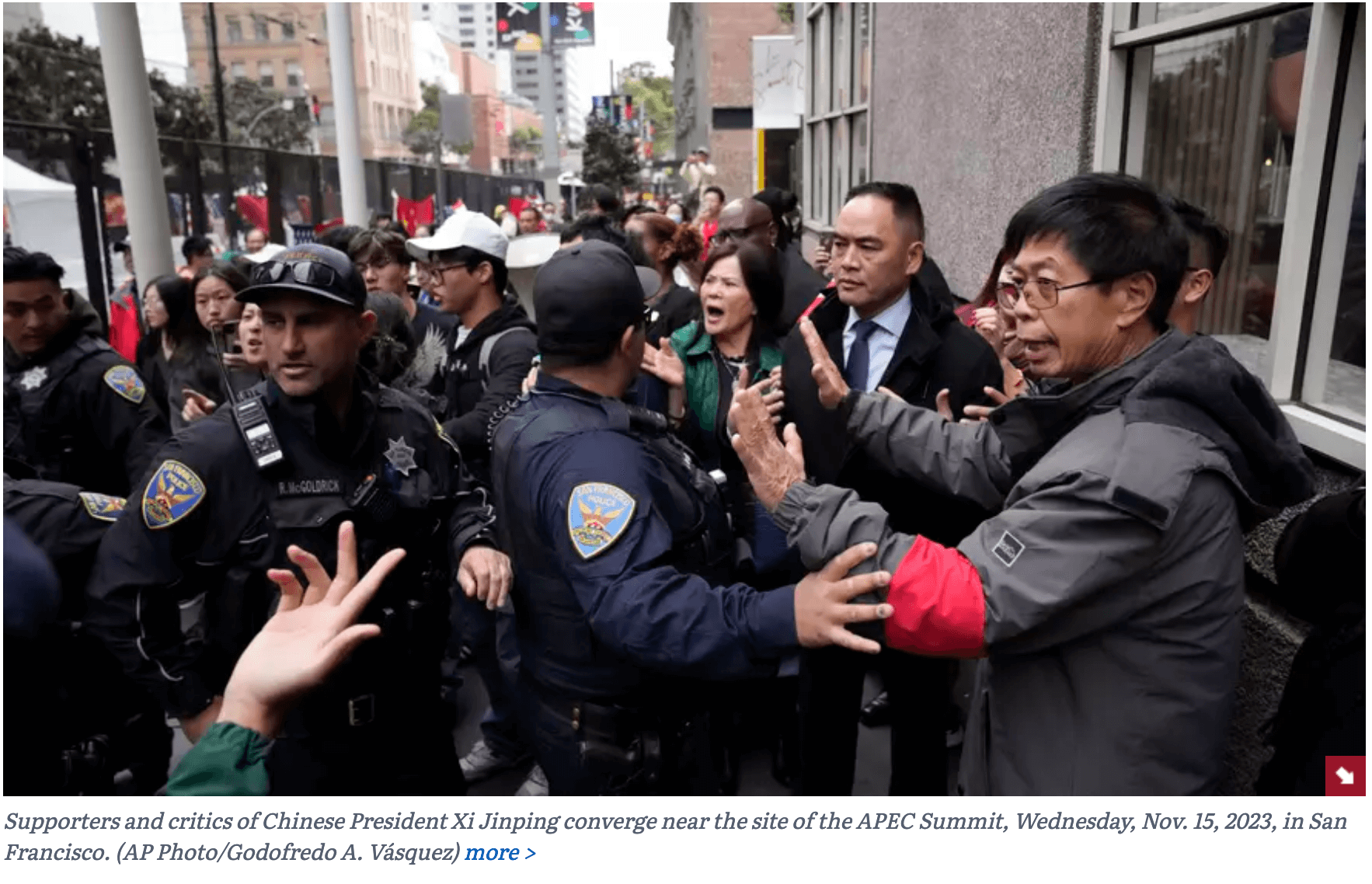
Chen himself was present at the flagpole, and, in fact, played a high-profile role, at one point attempting to snatch the “Dictator Xi, Your Time Is Up” banner from Tsela (at 00:15 in the video).
Chen Heng is an associate of John Chen Shanzhuang, the united front leader from New York who was reported to be responsible for mobilizing and transporting CCP supporters from there to San Francisco to “welcome” Xi. Chen Heng appears in the background of this photo of Chen Shanzhuang outside the St. Regis.
Chen Heng has appeared alongside Chen Shanzhuang on other occasions as well, such as at the CCP supporters’ protest against Taiwan’s then-president Tsai Ing-wen’s visit to New York in March 2023.
L—Chen Heng; R—John Chen Shanzhuang
Chen Heng is also an associate of Harry Lu Jianwang (盧建旺), who was arrested by the FBI in April 2023 for his role in operating an undeclared police station of the Chinese government in Chinatown in Manhattan.152 According to the complaint against Lu and a co-defendant, “the defendants worked together to establish the first known overseas police station in the United States on behalf of the Fuzhou branch of the MPS [Ministry of Public Security].” Lu is reported to be one of three co-chairs of the Fujian Association, along with Chen Heng and Chen Lundong. When asked by a reporter about Lu’s arrest, Chen Heng said he was surprised to learn of it.153 The complaint alleges that , since 2015, Lu “[has been] directed to assist the PRC government’s repressive activities on U.S. soil.” One of the examples given is this: “In 2015, during PRC President Xi Jinping’s visit to the United States, Lu participated in counterprotests in Washington, D.C. against members of a religion that is forbidden under PRC law.” That activity appears similar to what his Fujian Association Co-Chair Chen Heng was doing in San Francisco. In the following undated photo, Chen Heng is seen sitting to the right of the current Mayor of New York, Eric Adams. On Adams’ other side is Wu Xiaoming, Deputy Consul General of the Chinese consulate of New York City, and next to him, Harry Lu Jianwang.
Another figure from New York who can be seen in the video above (from 00:19 to 00:33) attempting to snatch the “Dictator Xi, Your Time Is Up” banner from Tsela is Shi Yong Wei (施雍偉). He does so right after Chen Heng makes the attempt, and, in fact, he gets a better grip on it than Chen Heng did, nearly managing to snatch it.
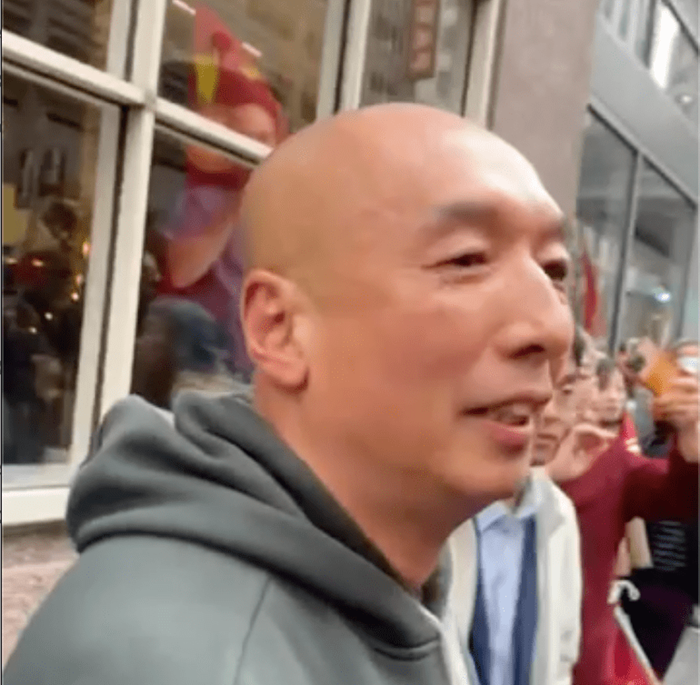
Shi is reportedly a convicted felon. He was arrested by the FBI in September 2003 for extortion.154 According to his own account, published in his book, The Son Of Qinghua: Shi Yong Wei’s 15-Year Prison Saga After Being Falsely Convicted In The U.S. Federal Legal System, Shi spent 15 years in federal prison.155
In October 2023, weeks before Xi Jinping’s visit to San Francisco, he appeared at an art exhibition standing behind Huang Ping (黄屏), the Consul General of the Chinese consulate in New York.156
Chen Heng also appears in a video (at 8:04) by the satirical vlogger LeLe Farley taken in front of the Hyatt Regency on the afternoon of November 15.157 That video shows another united front figure present at the scene, Wang Jianming (王建明). From 8:21 to 8:52, Wang comes into the frame holding a megaphone in his right hand and an American flag in his left. (Among CCP supporters in San Francisco, megaphones were typically held by organizers or leaders.) He is president of the Pennsylvania Association for China’s Peaceful Unification (賓州中國和平統一促進會).158 He may have led the delegation of CCP supporters from Philadelphia that was reported to be present in San Francisco during Xi Jinping’s visit.
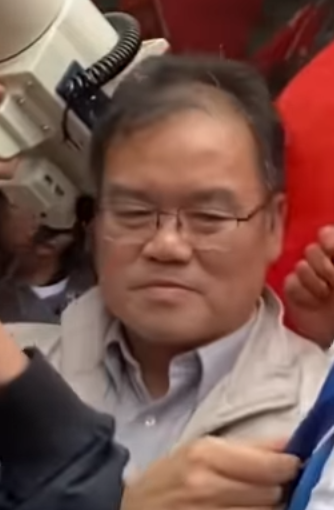
At the end of the evening, when Tibetan protester Tsela Zoksang came down after five hours of clinging to the flagpole, she was cited by the San Francisco police for “trespassing.” Police told her they did this at the behest of the Hyatt Regency. This is the only known law enforcement action taken in response to a suspected criminal offense outside of the Hyatt Regency on November 15.159
Parking Garage Attack
Tsela was still up the flagpole, about 25 to 30 feet in the air, when four Tibetan protesters were attacked in the Hearst Parking Center, a parking garage across from the Hyatt Regency. The protesters unfurled, from one of the higher floors, a large banner about 30’ x 15’ in size. It read, “Dictator Xi Jinping, Your Time Is Up! Free Tibet.”
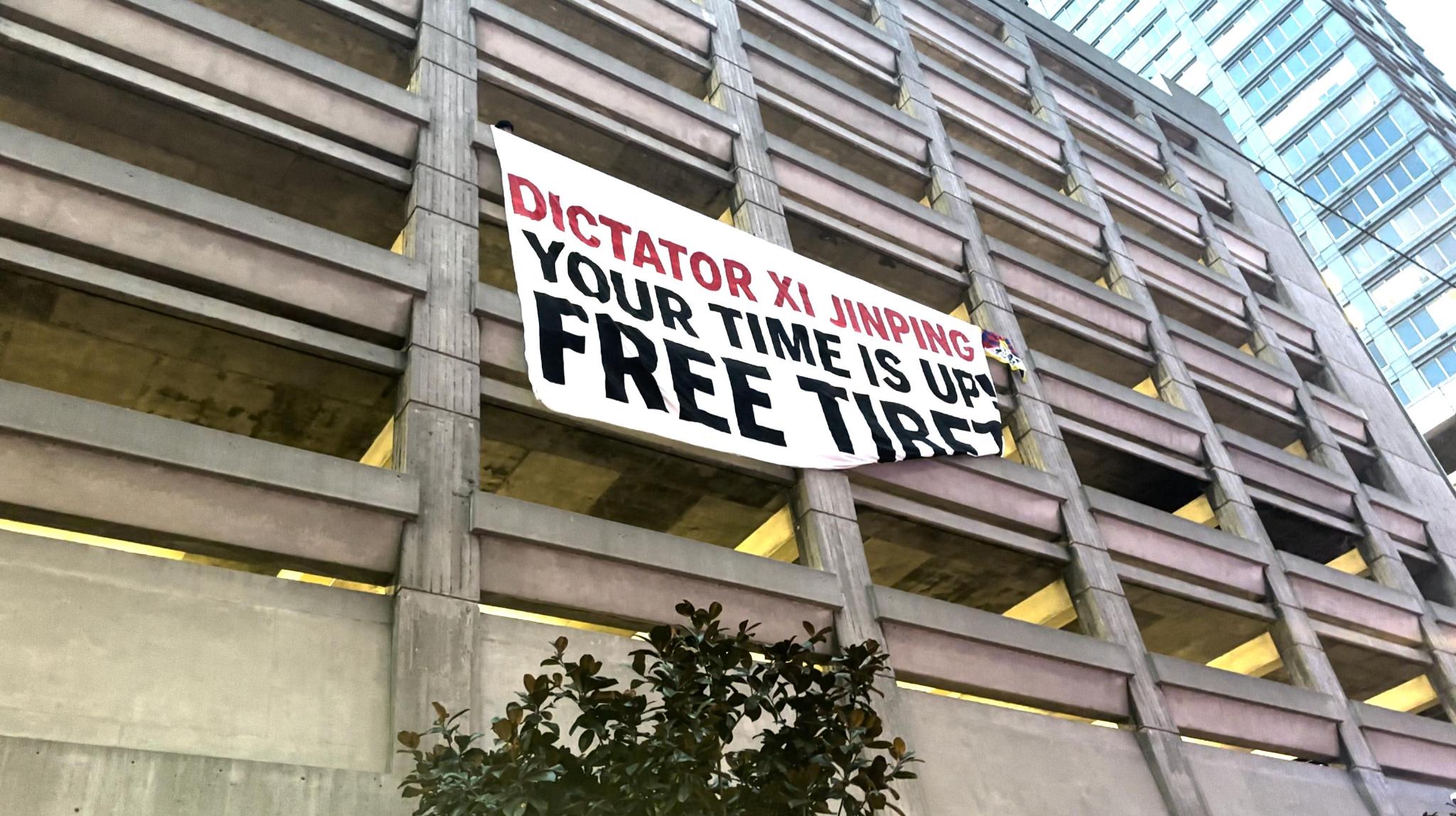
Only minutes after unfurling the banner, protesters suddenly felt a violent tug on it from below. Because of the size and weight of the banner, it had special straps through which to put one’s hands in order to hold it up. The sudden violence of the tug was such that it lifted three of the four protesters off the ground. Because they had their hands through the straps, they could not immediately let go of the banner, and one of them was lifted off of the ground and almost pulled over the side of the building, which most likely would have resulted in a fatal fall. His hands were lacerated in the incident.
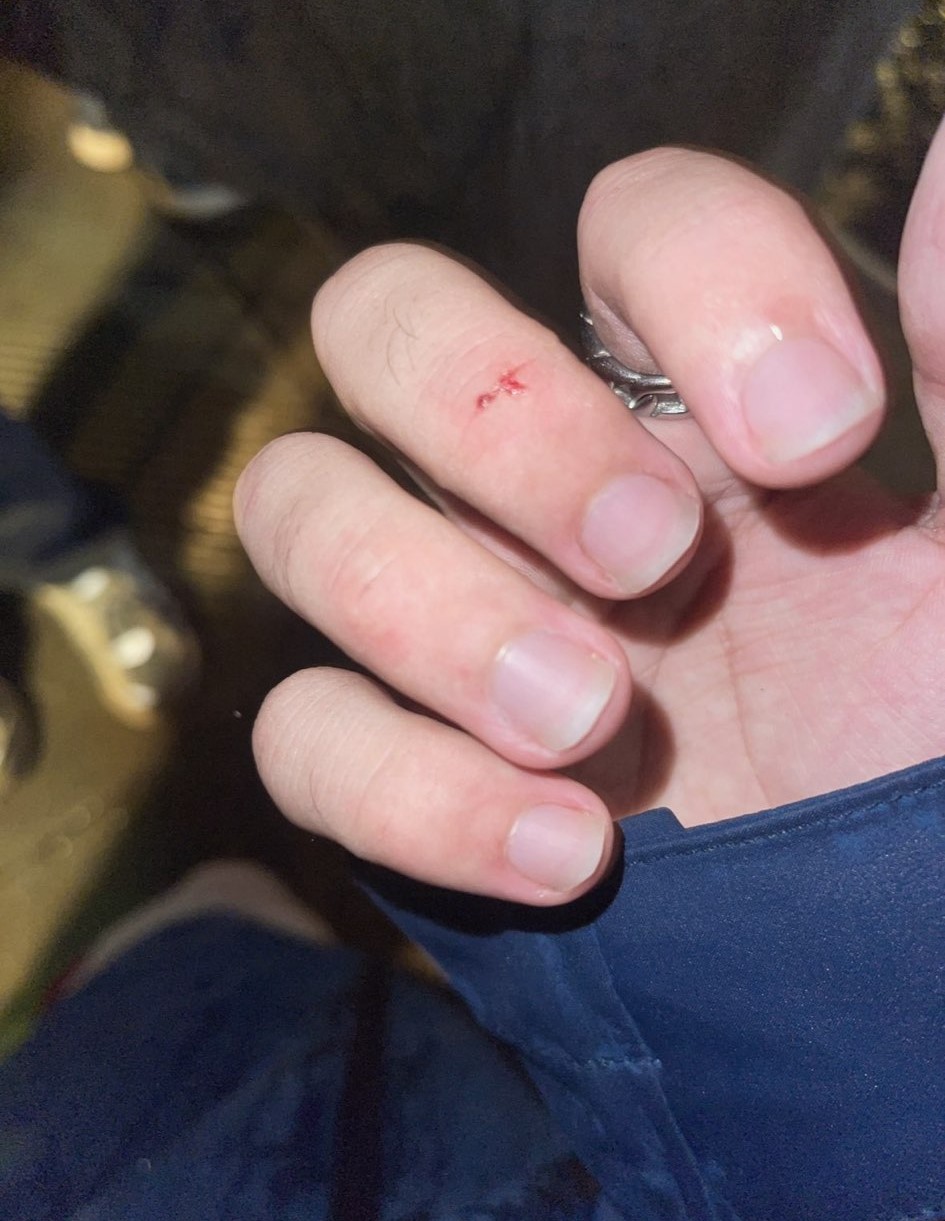
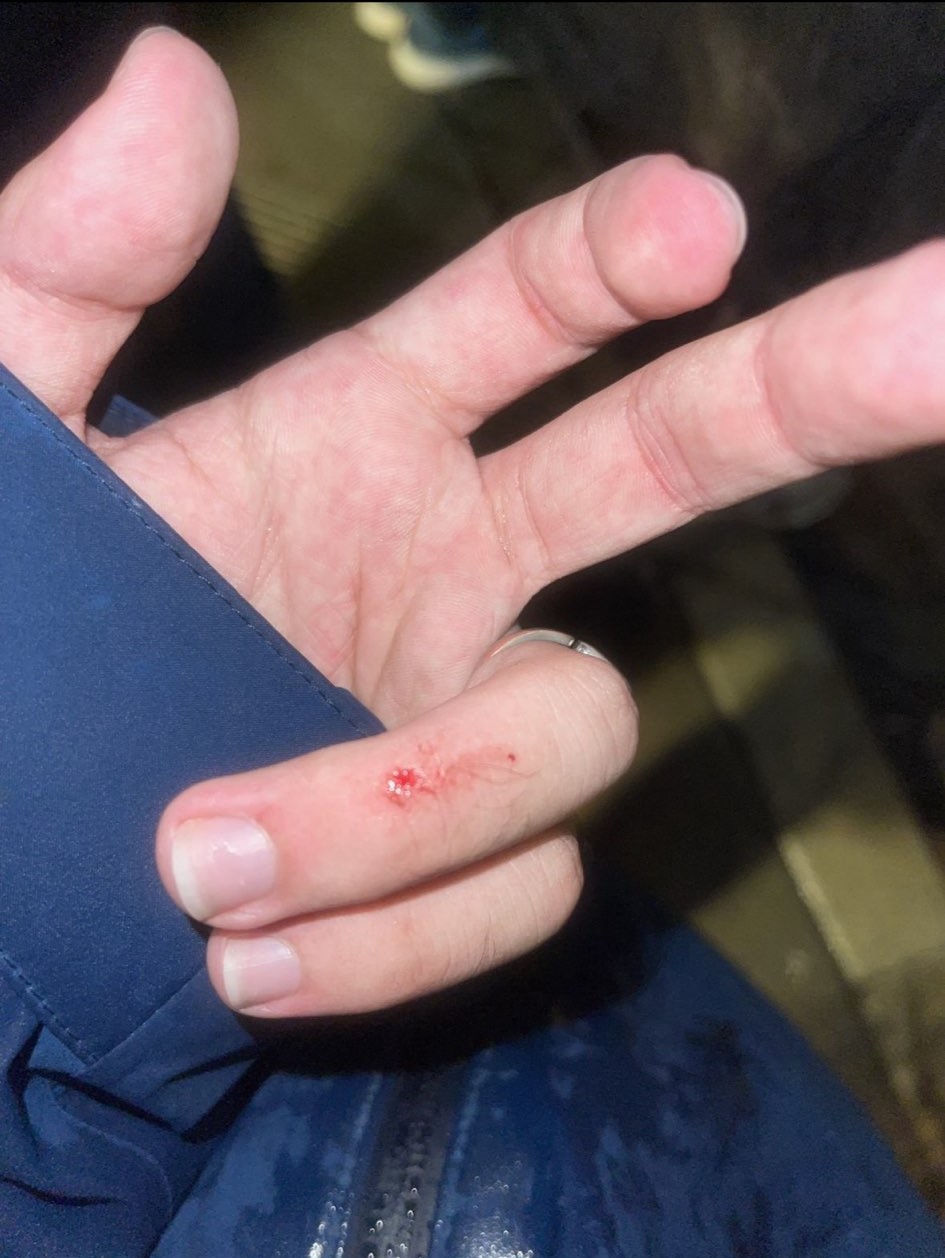
Later, when he had the opportunity to confront his attackers, he shouted at them, “I almost died because of you.” For the sake of safety, the protesters extracted their hands from the banner straps and let it fall. Then they went downstairs to look for it. They found it lying on a lower floor and tried to unfurl it again. As they did, they were attacked by about 15 masked men. The attackers ripped the banner out of the protesters’ hands and ran away. The protesters ran after them and took a video.160 The video begins the moment after the attackers ripped the banner from the protesters’ hands and shows them running to the elevator in the parking garage.
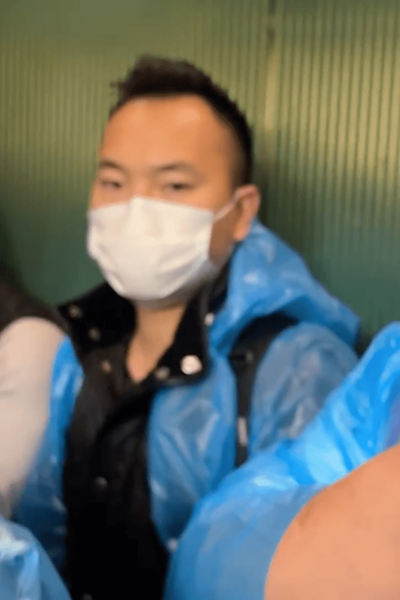
In the videos, approximately 10 attackers can be seen in the elevators, the doors of which the protesters were able to momentarily hold open with their feet in order to confront them and attempt to identify them.
In the lobby, the face of another attacker was caught on video.
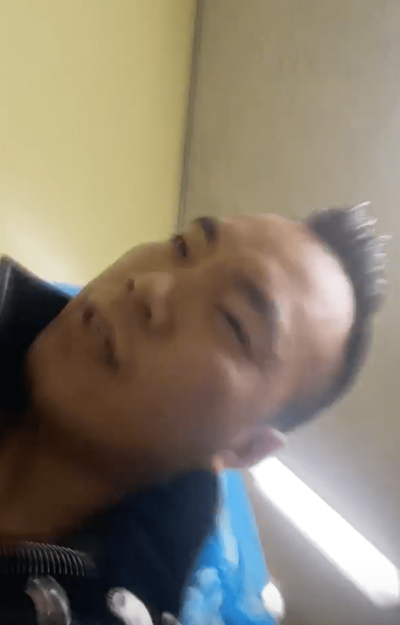
This is him in the elevator with his face masked, taken just before the above photo:

He was later seen outside among the CCP supporters standing right next to Li Huahong, the founder of the Chinese Anti-Cult World Alliance (CACWA) who led the attack on Jia Junwei outside the St. Regis on November 14.
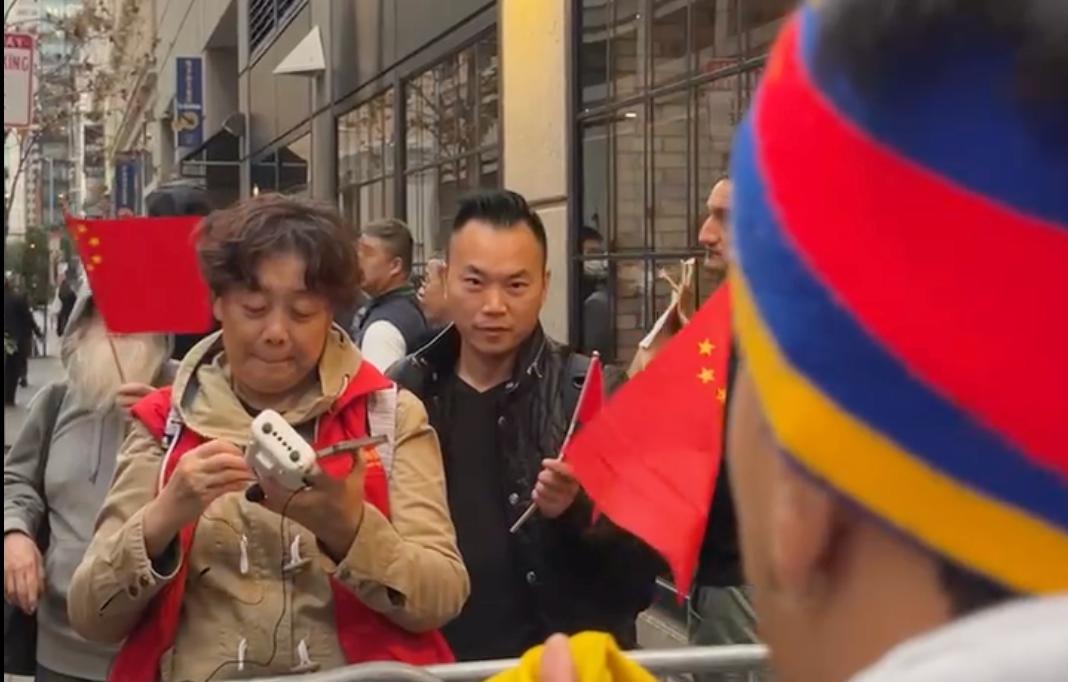
A third attacker in the parking garage wore a CACWA jacket.

The attackers eventually managed to close the elevator doors on the protesters who had been confronting them and disappear while a few other attackers descended a nearby spiral ramp intended for cars.
After that, one of the Tibetan protesters, Chemi Lhamo, Campaigns Director with Students for a Free Tibet, unfurled a Tibetan flag from the parking garage. As she did so, she was watched by a man in a green shirt who disappeared and then returned with two security guards employed by the parking garage. The security guards told her and the other Tibetan protesters to leave the parking garage. Chemi Lhamo said, “Why is he [the man in the green shirt] allowed to be here but not me? Didn’t you see we got attacked by 15 people?” One security guard took two of the Tibetan protesters and ushered them away. The other tried to take Chemi Lhamo. The man in the green shirt ripped the Tibetan flag out of Chemi Lhamo’s hands, though she warned him not to. The next day, November 16, Chemi Lhamo happened to encounter the man in the green shirt on the street near the Moscone Center, the main APEC venue, and took a video of him from which the following screenshot was taken:
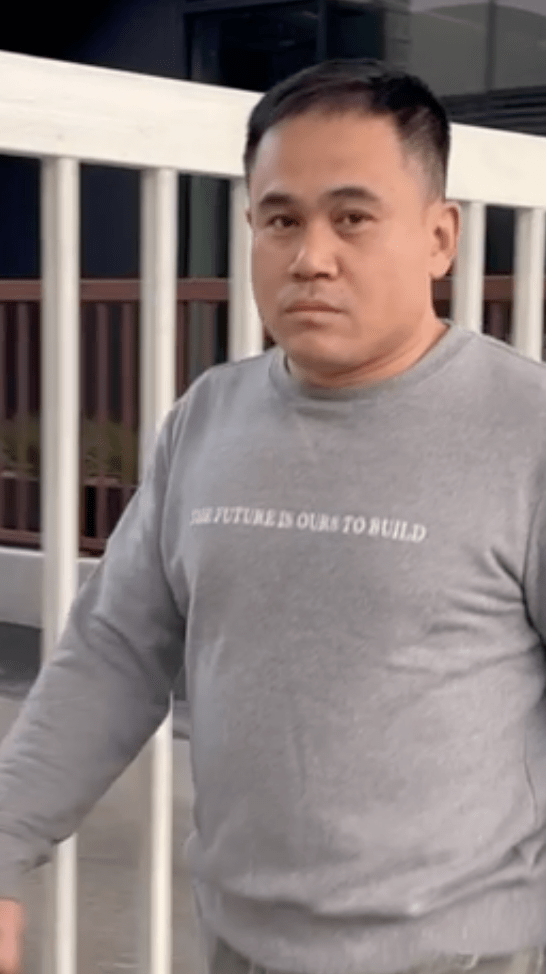
The security guard put Chemi Lhamo’s arms behind her back and pushed her to the elevator doors. She said, “Let go of me. You’re hurting me.” The security guard led her out of the parking garage through a California Pizza Kitchen restaurant on the ground floor and to the street, where Chemi Lhamo spotted some of the same men who had attacked her and the others in the parking garage. The men quickly fled, blending into the crowd of CCP supporters gathered there.
Chemi Lhamo says the group of men seemed trained and that they seemed to act with military discipline. Their faces were covered by masks. They clutched at their masks to make sure they stayed on and tried to avoid appearing on camera. They appeared to have gotten the parking garage security guards to carry out work on their behalf.
While the attack was occurring, Students for a Free Tibet Executive Director Pema Doma was outside on the street. One of the Tibetan protesters inside the garage called her on the phone and told her about the attack. She went to the police and told them that a group of men in the parking garage were assaulting her friends. She recalls the police officer replying that there had been fighting all day long there and the police didn’t care about breaking up fights. Pema Doma responded, “It’s not a fight. It’s a group of adults hurting four young people.” The police officer then said that the young people shouldn’t have gone into the parking garage in the first place. At that point, one of the Tibetan protesters who’d been attacked in the parking garage appeared and urgently asked the police for help, saying his friends were still inside but he had lost them and didn’t know where they were. The police replied that they couldn’t do anything. Several of those with SFT then managed on their own to find the other Tibetan protesters who had been inside the parking garage. The police took no action in response to the reports about the incident.161
At about 6:30 p.m., Hong Kong protesters were followed and photographed by a man in a suit whom they suspected of being affiliated with CCP authorities. This occurred near the intersection of Market and Third Streets in San Francisco and lasted for about five minutes.162
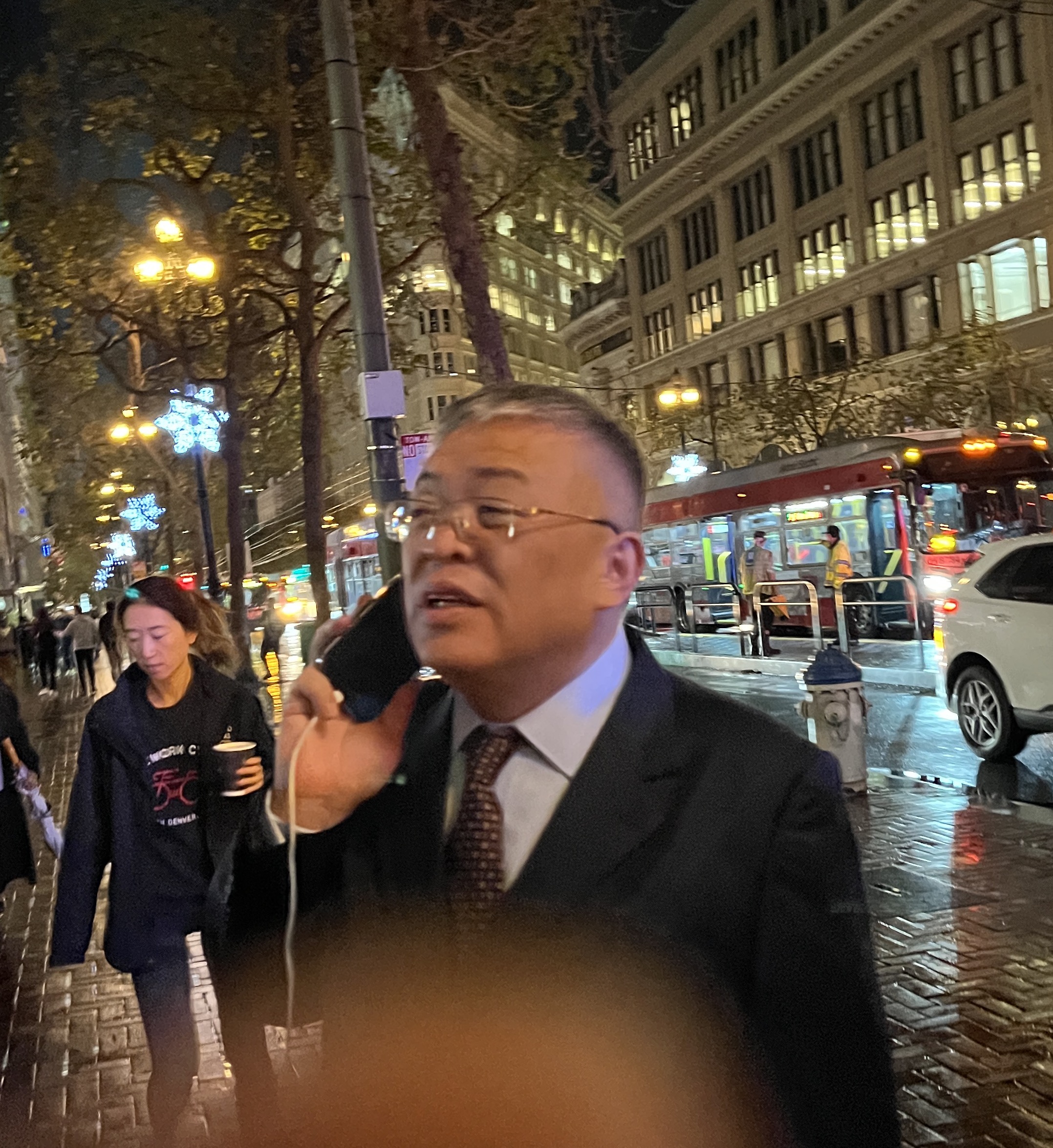
When one Hong Kong protester tried taking a photo of the man in response to his surveillance, the man moved his phone away from them, apparently to avoid being photographed, but then moments later again began filming them. This pattern repeated itself three times. Only when one Hong Kong protester stepped toward him did he turn away and walk off, though he turned back repeatedly to look at them. The man has been identified as He Yong (何勇), a Communist Party branch secretary, and the vice-chair and secretary general of China Zhongguancun Precision Medicine Science and Technology Foundation (中關村精準醫學基金).163 By definition, as a party secretary, he would be a member of the CCP. The foundation describes itself as a charitable organization but emphasizes that it “adheres to the overall leadership” of the CCP and “establishes grassroots organizations of the Party…strictly enforcing political discipline, political rules and organizational discipline, and gives full play to its political core role.”164 He also appears to be the president of the Beijing Huaxian Chamber of Commerce (北京滑縣企業商會會長).165 It is unclear what role He Yong was playing on the streets of San Francisco, but the Hong Kong protesters regarded him as acting suspiciously and perhaps surveilling them.
A united front figure who was seen in the crowd of CCP supporters near the Hyatt Regency on the 15th and whom protesters suspected of being an organizer or coordinator is Chen Zhaojin (陳兆進).
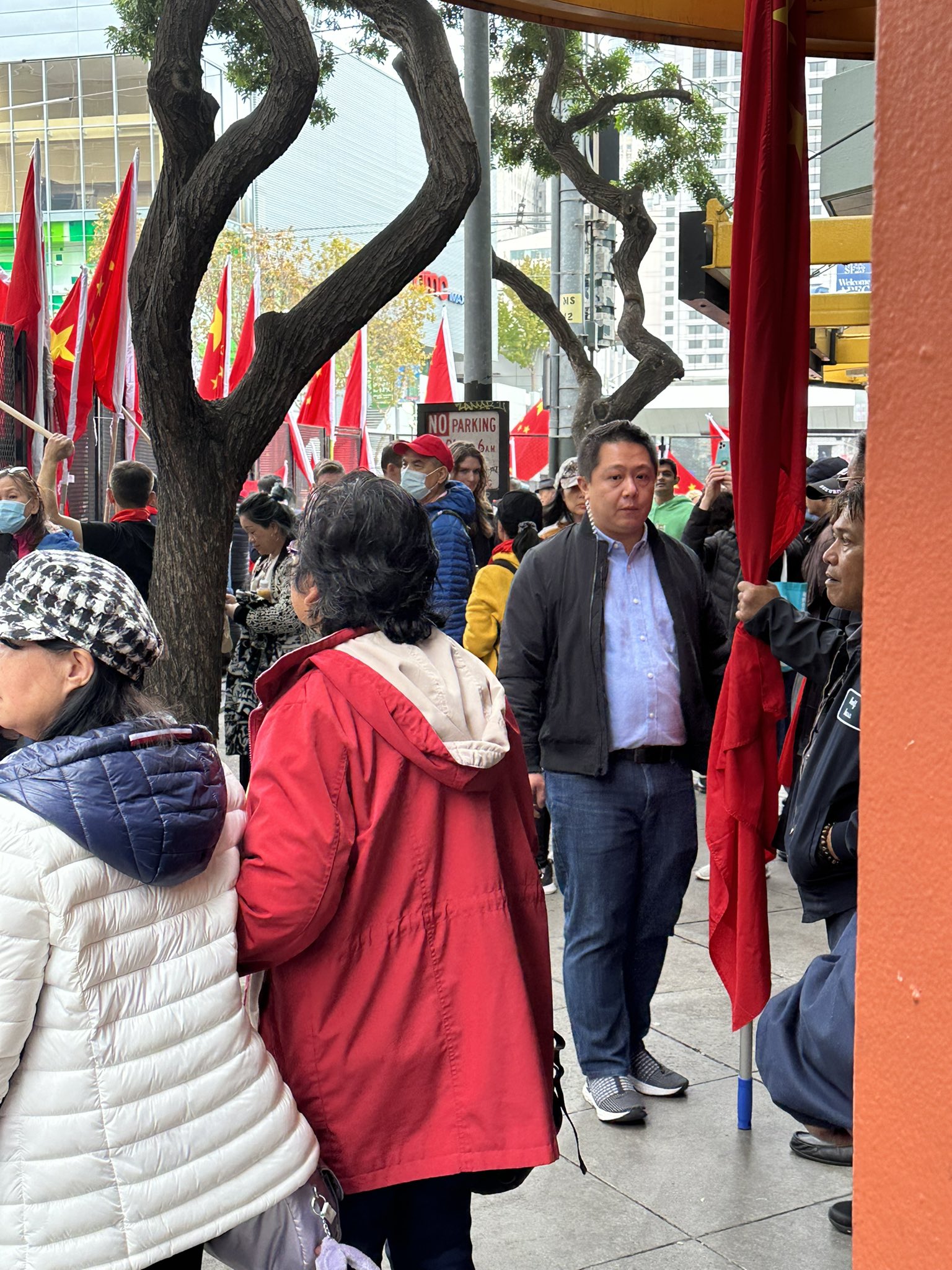
On the following day, the 16th, he was involved in a scuffle with Chinese protesters near the Moscone Center, where several assaults occurred. In a screenshot of a video of the scuffle, he can be seen wearing what appears to be a walkie-talkie on his belt.
This increased the suspicion of some protesters that he had an organizing or coordinating role among CCP supporters.
Chen Zhaojin is reportedly the vice-president of the San Francisco Bay Area Association for the Peaceful Reunification of China (旧金山湾区中国统一促进会第一副会长).167 He is also reportedly a member of the Youth Committee of the All-China Federation of Returned Overseas Chinese (中国侨联青年委员会委员).168
In these official capacities, he has toured various places in the PRC, including Guangdong, Tianjin, Xiamen and even Xinjiang. In Guangdong, he met CPPCC officials.169 In Xiamen, he met a local representative of ACFROC.170 As leader of a delegation from the San Francisco Bay Area Association for the Peaceful Reunification of China, he met the deputy director of the Liaison Department of ACFROC.171 In Xinjiang, he was part of a delegation of “overseas Chinese.” They were exhorted to return to their countries of residence and counter accusations of genocide and gross human rights abuses. About the visit, Chen Zhaojin said, “The local people have a high evaluation of the Chinese Communist Party. They know that a good life comes from the strong leadership of the Chinese Communist Party and the strong support of the country.” He hoped he could get more people to visit Xinjiang and see for themselves.172 These visits were reported on the official websites of the All-China Federation of Returned Overseas Chinese, its local branches, and the Xinjiang branch of the united front Work Department.
On August 31, 2023, just a little over two months before Xi’s visit to San Francisco, Chen Zhaojin attended the 2023 New Generation of Overseas Chinese Guangzhou Roundtable (2023年新生代海外僑胞廣州圓桌會) where he was among seven “representative individuals” from the new generation of overseas Chinese to give a speech.173 His speech is published on the website of the Guangdong Provincial Committee of the China Zhi Gong Party (中國致公黨廣東省委員會), the united front political party which is used to maintain relations with united front figures abroad.174 In it, he mentions that he is a native of Guangzhou and lives in the Bay Area and that he has participated in “a series of patriotic activities” of overseas Chinese since the age of 19. Chen also attended some of the same pro-CCP protests in 2023 against Taiwan political leaders as other united front figures from the west coast.175
Barricade Attack
The next attack occurred later that evening, between 7:30 and 8 p.m. Its target was the Hong Kong and Tibetan protesters gathered in the designated protest zone that had been set up by the police on the corner of Third and Jessie Streets to separate the CCP supporters and protesters gathered around the flagpole. The attack was carried out by a group of about a dozen CCP supporters and appears to have been premeditated. The group was photographed creeping up Jessie Street toward Third armed with metal poles that looked like flagpoles.
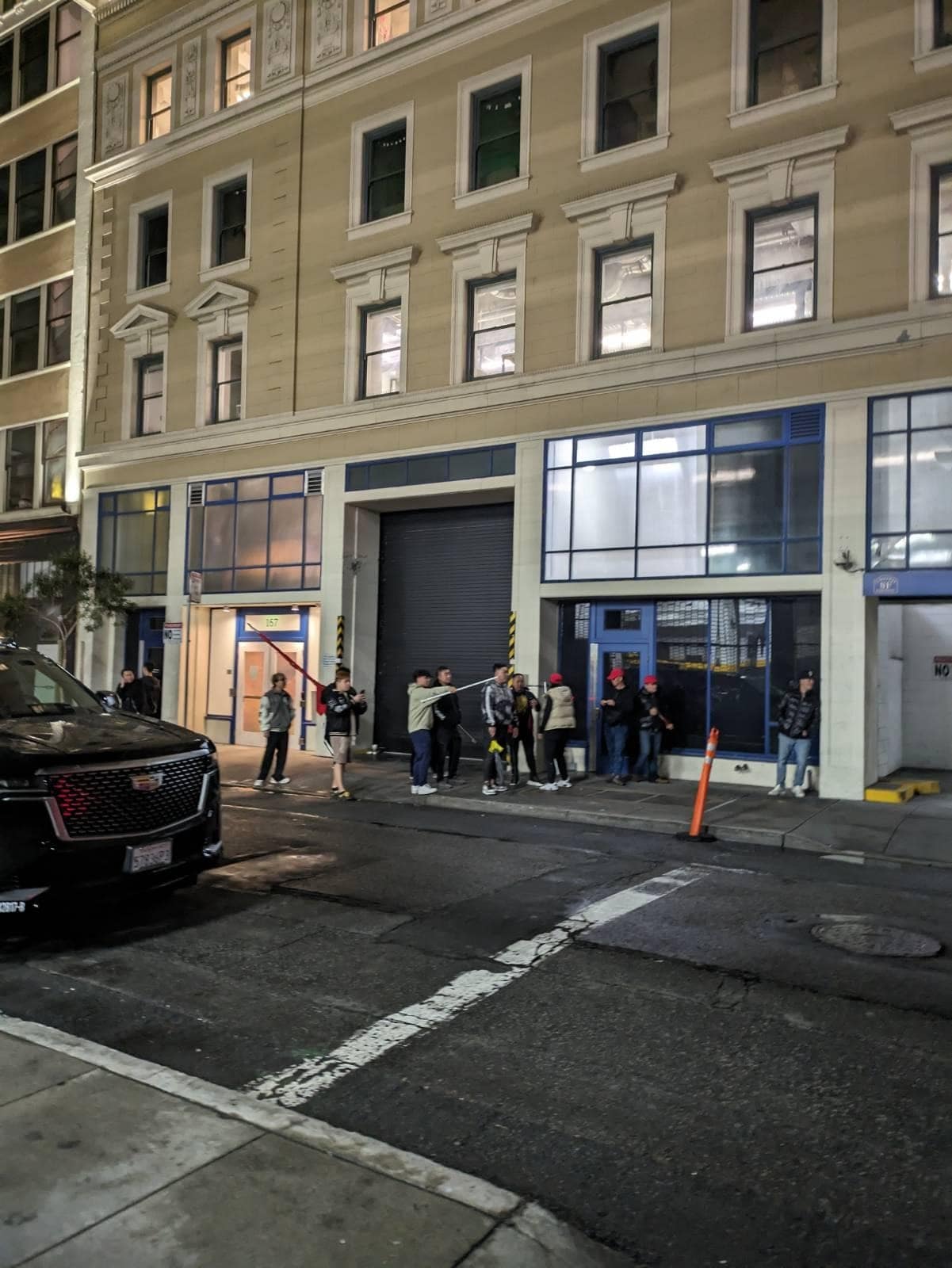
One of the attackers can be seen in this video holding at least five poles. This same man was seen later with only one pole. Later, some other CCP supporters around the area also had poles with them.
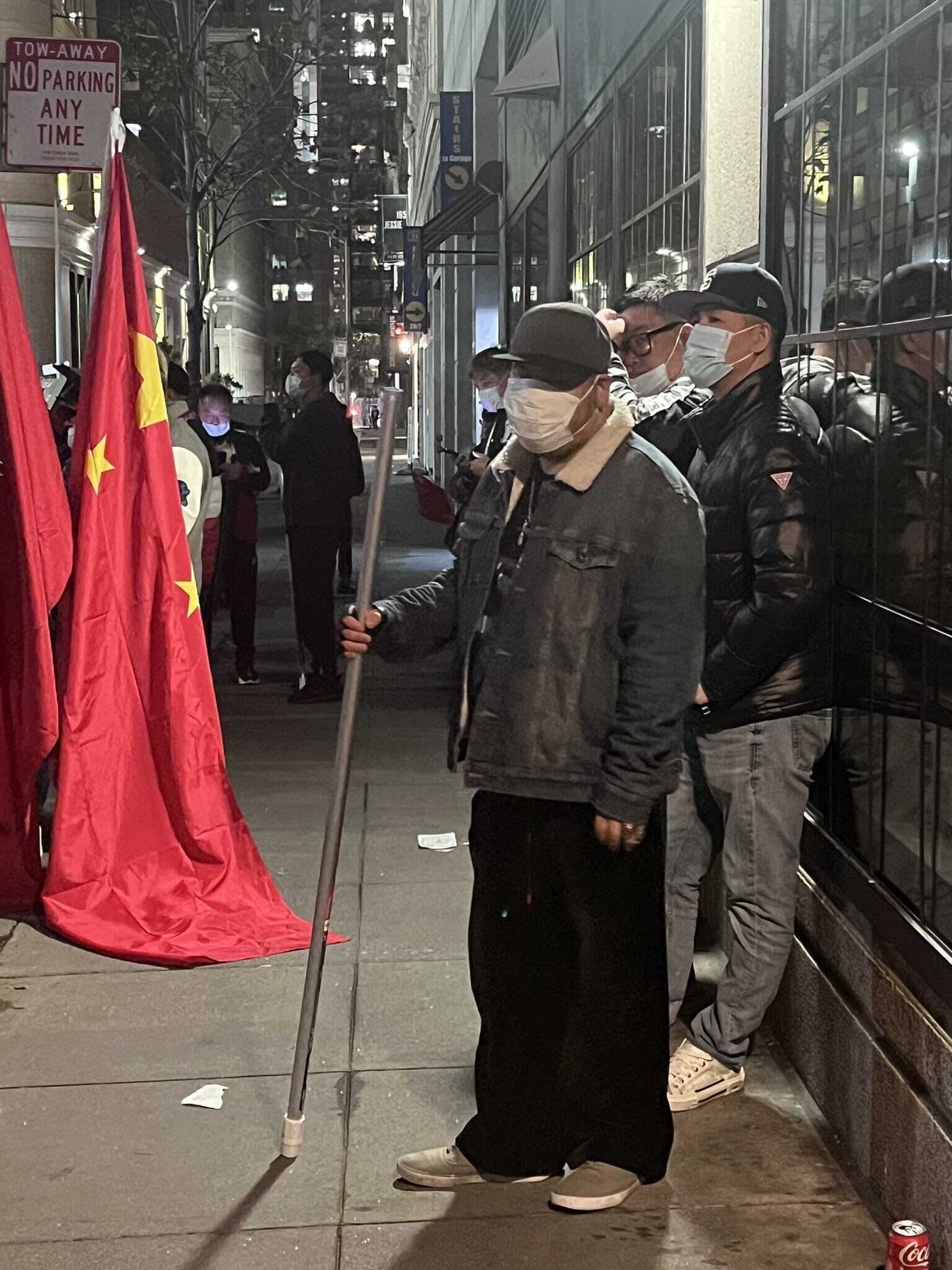
As the group of CCP supporters came to the corner of Third and Jessie Streets, where the designated protest zone was demarcated by metal barriers, they confronted the protesters.
HKDC Executive Director Anna Kwok, who was in the designated protest zone, said that police lined Third Street, separating both protesters and CCP supporters from the Hyatt Regency, and that, originally, there was a small group of police officers at the intersection of Third and Jessie Streets, between the Hong Kong and Tibetan protesters on one side of Jessie and the CCP supporters on the other side. But, after a while, those police officers disappeared, and “things went downhill after that. Thugs appeared between 7:30 to 7:50 p.m. and tried to provoke violence.”176
About ten minutes before they attacked, around 7:20 p.m., a single person, coming along Third Street from the other direction, entered the designated protest zone, where he was seen taking photos of protesters at close range. He was confronted by Hong Kong protesters, at which time, he fled.
As he was fleeing, other men prevented protesters from giving chase. One of those men was the bald-headed Chen Wenshen, vice-president of the Fujian Chamber of Commerce and Industry of Washington State (華州福建工商會) in the Seattle area (see above), who had been present at the attack on Wang Wei outside the St. Regis Hotel earlier that day, as well as near the flagpole at the Hyatt Regency, and would again be seen near the Moscone Center on the 16th and at the San Francisco airport on the 17th, all locations where incidents of harassment, intimidation, and assault occurred.

About 10 to 15 minutes after that, the attackers attempted to enter the designated protest area. Some videos of the incident appear to show what might be characterized as a “melee” or “scuffle” involving both CCP supporters and protesters, but as the sequence here shows, it was the CCP supporters who attempted to violently encroach upon the designated protest zone set up by the police, and, while the attackers were armed, the protesters were not. Once attacked, some young Tibetan protesters attempted to defend the protest zone, pushing back against the attackers. In interviews, they said their reason for doing so was that some of the people in the protest zone were women and others were older, including some parents, and they wanted to protect them. They were also aware of death threats having been made against HKDC Executive Director Anna Kwok and were intent on protecting her.177 Kwok, in turn, was aware of their solicitude: “Tibetans and others surrounded me to protect me; due to the threats, we prepared for the possibility of targeted kidnapping.”178
The attackers used umbrellas and metal poles to hit protesters and stab at them. One man can be seen in the video trying to separate his flagpole from its flag, presumably so as to better use it as a weapon. They also threw water bottles full of water as well as sand.
SFT Campaigns Director Chemi Lhamo, who had just been attacked in the parking garage, was bruised by a flying water bottle full of water that hit her on the chin.179 The following photo, taken on November 20, five days after the incident, shows the bruise on Chemi Lhamo’s chin.
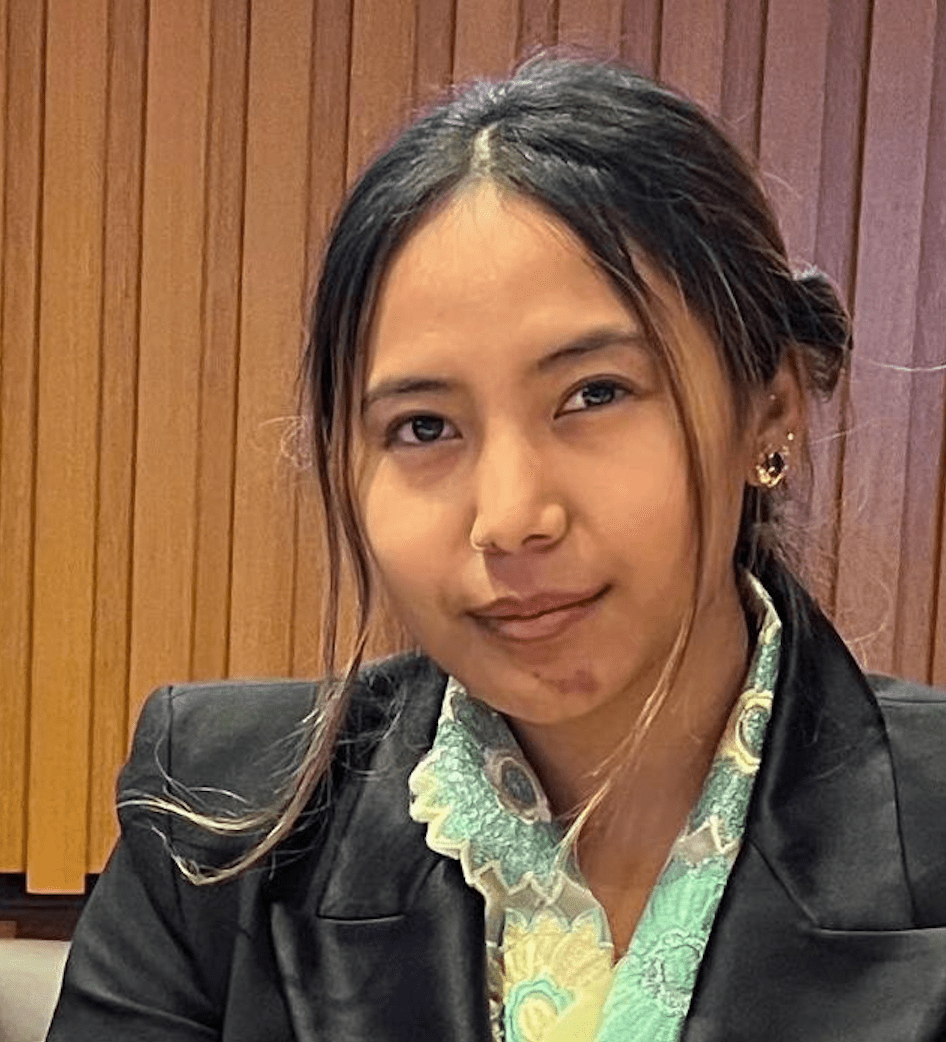
A 17-year-old Tibetan was cut in the arm with a sharp object.
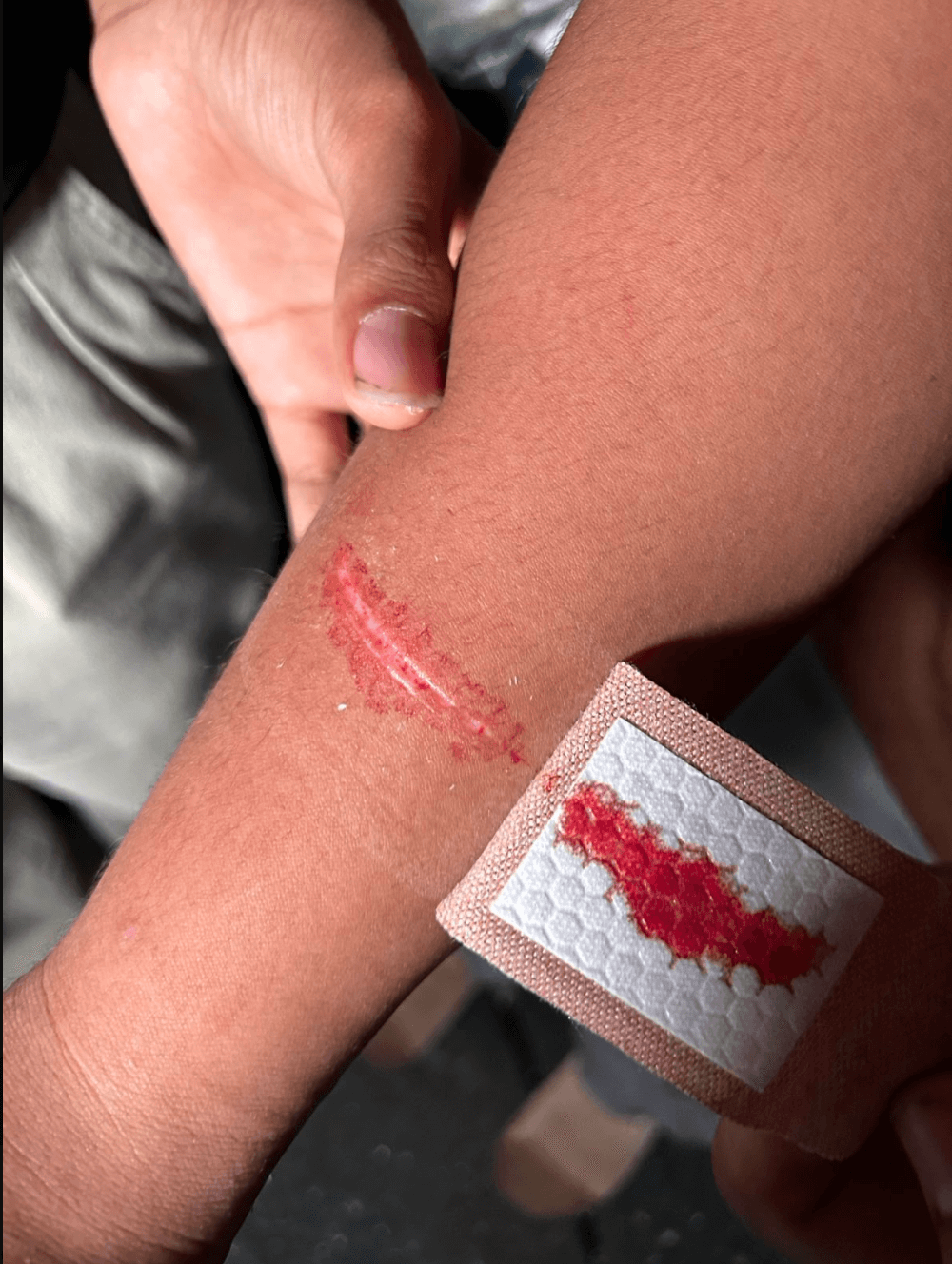
In an interview, another 17-year-old Tibetan said, “I got hit in the head three to four times by metal flagpoles. I got sand thrown in my eyes. I was blinded for about five minutes. They started hitting us. We backed up. They put a big flag in front of my face. Then I got hit again. A lot of people got hit, not just me. Another person was hit four times.”180
HKDC Executive Director Anna Kwok said, “The police… on Third Street were reluctant to move. They didn’t want to leave their positions. We screamed and shouted at them, but none paid us any attention…. I contacted the FBI and said there was danger.181 They asked if anyone called the police. I said the police officers on site were no help. They asked if I had means to leave the area. I said, ‘I cannot leave other people behind, we want to stay and peacefully protest without violence or fear.’ They said they wanted to see if a plan could be put in place if it became more dangerous. In the end, we relied on ourselves to continue through the night.”182
The attackers who came up Jessie Street appear to have been joined by some who came across Jessie Street from the other side, where a banner for the Chinese Anti-Cult World Alliance had been hung.

In fact, while none of those who crept up Jessie Street and then attacked the protesters were dressed in CACWA attire, at least two CACWA-attired CCP supporters can be seen involved in the attack on protesters in the designated protest zone.
CACWA founder and leader Li Huahong herself was present at the scene and a part of the group that carried out the attack.
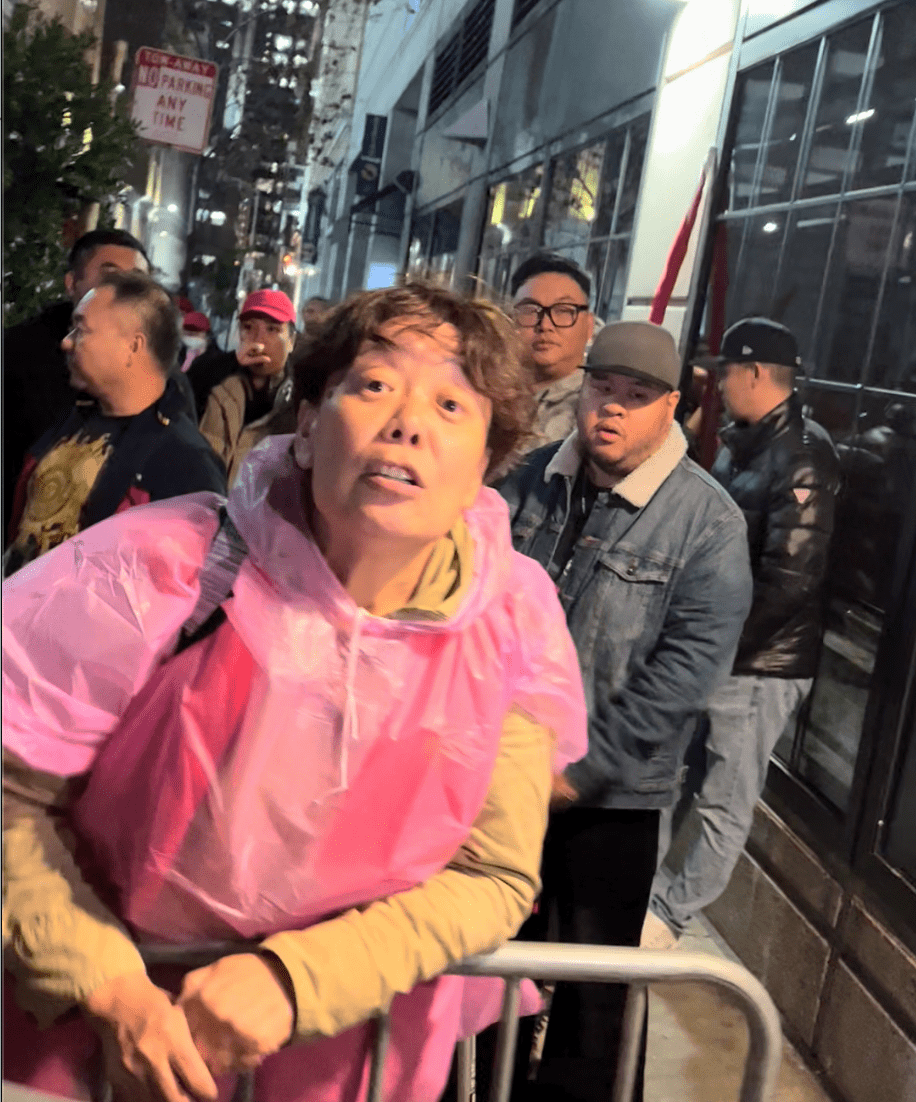
She had already participated in the attack on Jia Junwei on November 14 (see above) and had earlier on November 15 taunted protesters in the designated protest zone while standing next to a man who had been involved in the attack on Tibetan protesters in the parking garage (see above).
Unlike in the parking garage attack earlier, many of those who attacked protesters in the designated protest zone did not wear masks.
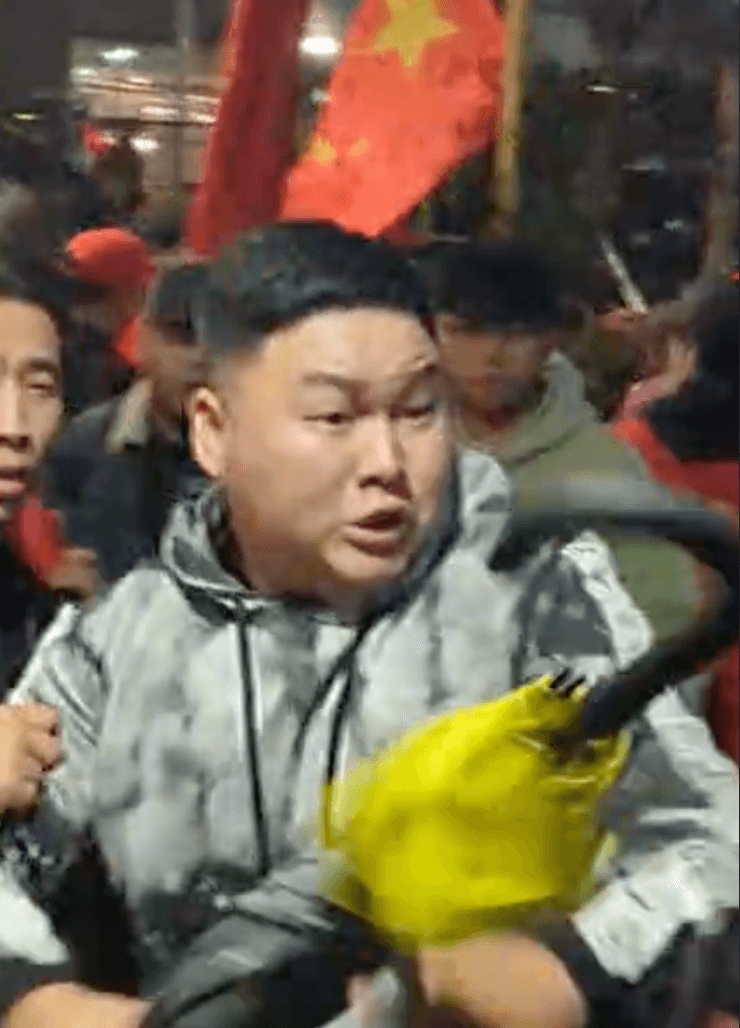
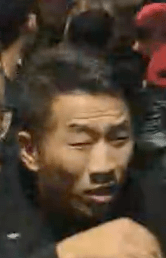
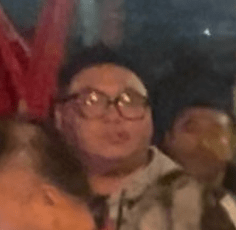
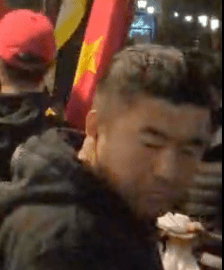
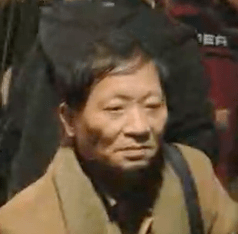
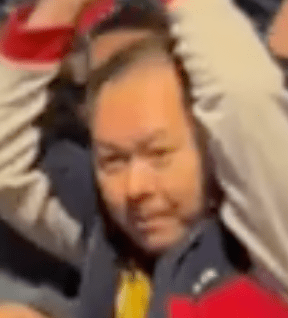
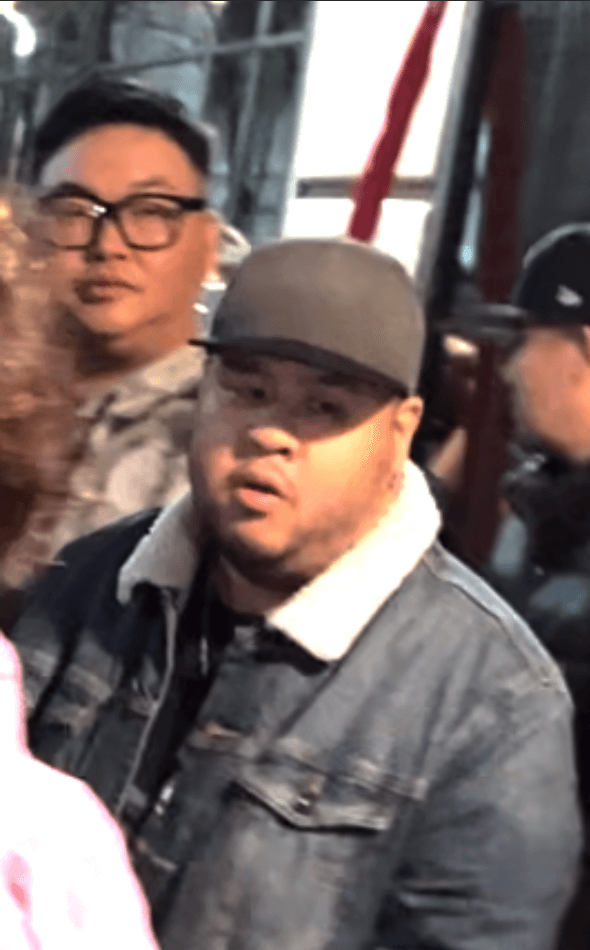
One of the attackers is Yang Baohai (楊寶海; he also goes by the name, Liu Baohai/劉寶海), who was seen elsewhere on the streets of San Francisco during Xi Jinping’s visit..
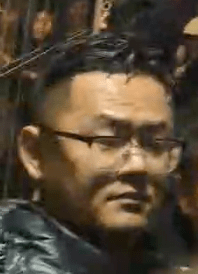
One of the victims of an attack by pro-CCP supporters submitted this photo, taken earlier in the day, and identified both figures in it as involved in the attacks. The one on the left is Yang Baohai.
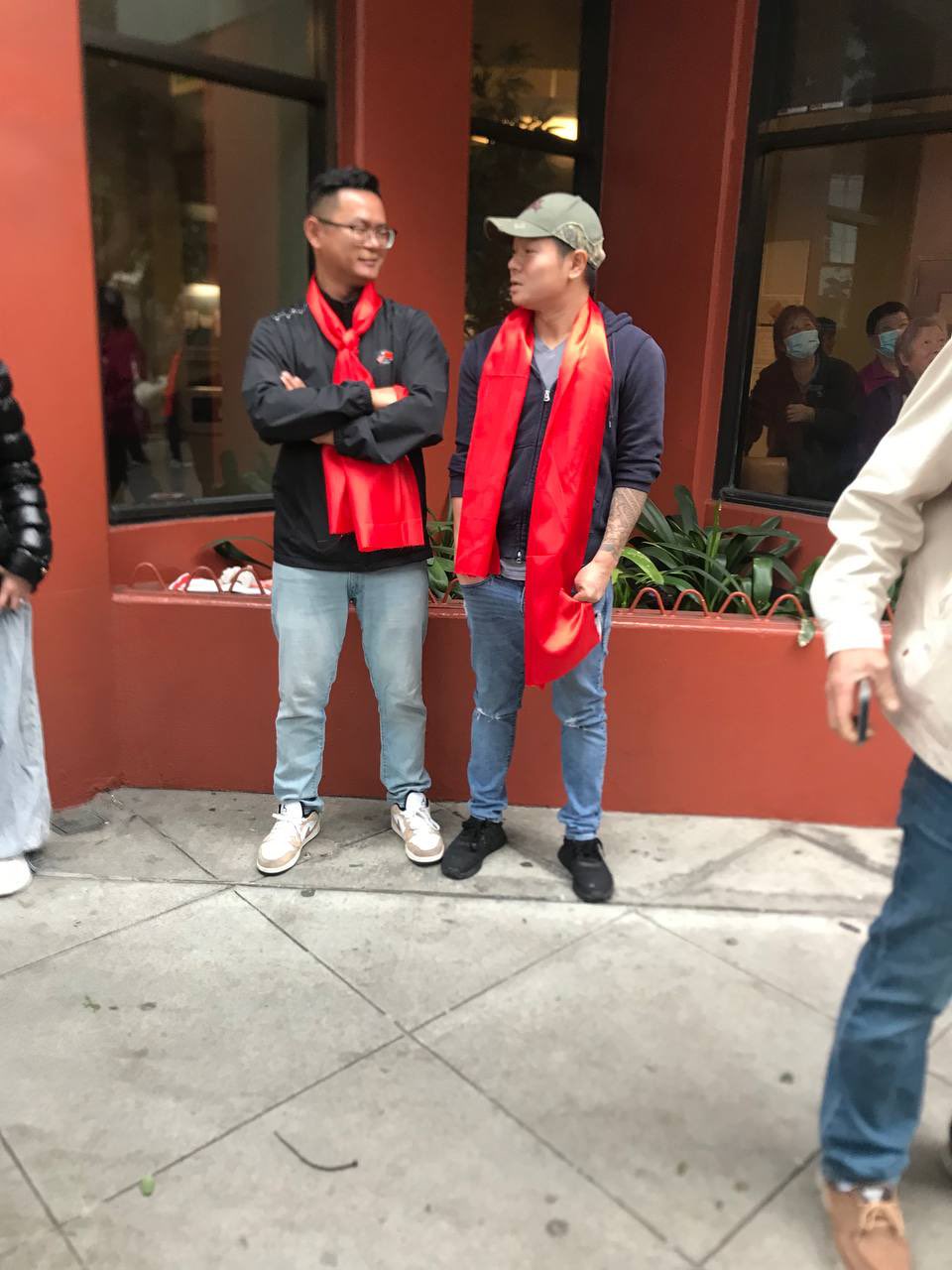
Yang Baohai is also pictured near the flagpole that Tsela climbed in front of the Hyatt Regency. In this photo, he is nearly swallowed up by the huge PRC flag being used to block the view of Tsela.
.png)
He was also seen near the San Francisco International Airport on November 17.
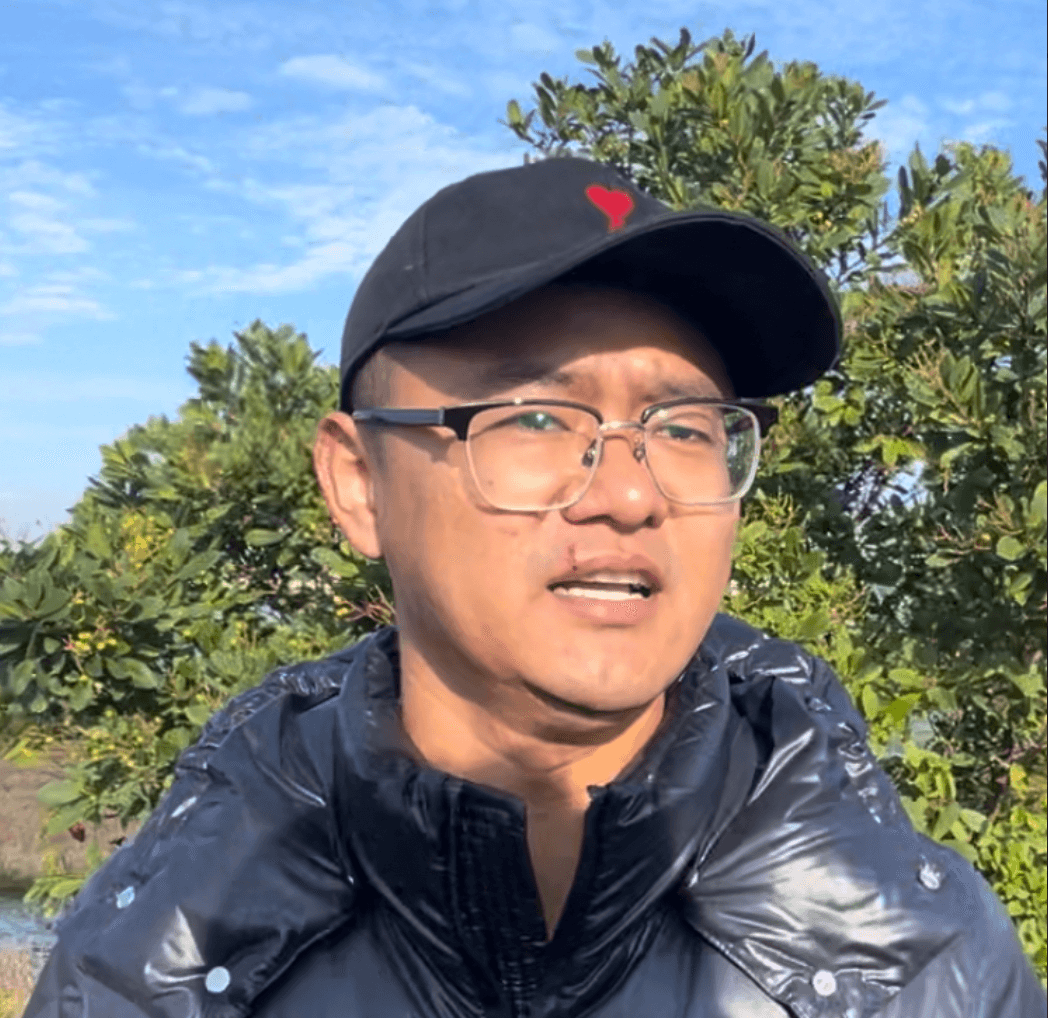
Yang Baohai is reportedly the president of the Bay Area Fujian Ren Association (福建人在灣區聯誼會), a united front group in the San Francisco Bay area.183 In April 2021, Yang Baohai met Chen Heng, vice-chair of the Fukien American Association, in New York City at an event that was videotaped and posted online.184 Chen Heng was also present on the streets of San Francisco, attempting to snatch the banner from the Tibetan protester on the flagpole outside the Hyatt Regency on the 15th.
Yang Baohai has appeared at various pro-CCP demonstrations together with other united front figures.
Yang was photographed by a Chinese-language media outlet at a protest against the visit of then-vice president of Taiwan William Lai Ching-te (賴清德) to San Francisco on August 16, 2023.185 The outlet reports that Yang held a megaphone and led CCP supporters in chanting slogans. He told the publication that he is Fujianese. The publication reported that “nearly 100” CCP supporters protested outside the Hyatt Regency.186 The united front leader from Oregon, Jing Dongsheng was also at that protest. During Xi Jinping’s stay in San Francisco, Jing participated in the harassment and intimidation of one protester and appeared to act as a scout on the lookout for protesters as well (see above).
Yang also participated in a united front protest against the visit of then-president of Taiwan Tsai Ing-wen to Los Angeles in April 2023. There, he’s pictured with a united front figure from San Francisco, He Konghua (何孔華), who was at the airport on November 17, the day of Xi’s departure (see below). Two other united front figures, Jing Dongsheng and Chen Zhaojin, were also on the streets of San Francisco and attended that anti-Tsai protest. CCP supporters were reportedly paid $400 each to demonstrate against Tsai.187
On August 20, 2019, Yang Baohai organized a demonstration against Hong Kong solidarity protests in San Francisco in support of the mass pro-democracy protests in Hong Kong going on at that time. On May 27, 2021, members of his group tried to bar Hong Kong protesters from participating in an “anti-Asian hate” rally in San Francisco that Yang was involved in organizing. The following sentences need to be separated by a period: “The Hong Kongers held signs reading, “Liberate Hong Kong,” “Free Uyghurs,” and “CCP is the real racist.” The attempt by members of Yang’s group to prevent Hong Kongers from joining the anti-Asian hate rally led to verbal and even physical altercations.188
Yang also participated in the planning of the premiere of the film, “My Motherland and Me,” to celebrate the 70th anniversary of the founding of the PRC in October 2019,189 and participated in a Lunar New Year celebration in San Francisco together with Deputy Consul General Zou Yonghong, Director Wang Yiming, and Consul Song Yutong of the PRC Consulate General in San Francisco.190
Stalking Incident
After the protest ended, some of the protesters who left the designated protest zone were stalked by the same group of people who had attacked them there. A little more than a dozen attackers followed them for blocks down Market Street. There were about a dozen Tibetan protesters altogether: some women in their twenties, including SFT Campaigns Director Chemi Lhamo, along with some older people and teenagers. While many protesters were leaving the area at about the same time, the stalkers chose to target the youngest Tibetan protesters. As the group of protesters passed an alleyway, they saw the CCP supporters who had attacked them. When the CCP supporters saw them, one of them threw down his cigarette and led the others in following the protesters, which gave the protesters the impression the CCP supporters had been waiting for them to pass. The CCP supporters dragged their metal poles on the ground, making a scraping noise that the protesters believed was intended to intimidate them. When they were certain the CCP supporters were following them, the protesters began videoing them.
A number of the stalkers are clearly recognizable from the photos and videos of the attack in the designated protest zone. Because of the harassment and attacks at the Hyatt Regency, the Tibetan protesters had heightened their vigilance, and this group of protesters had made arrangements to chaperone some in the group to the subway and others to a van waiting to pick them up. The CCP supporters smirked and laughed at the protesters as they followed them.
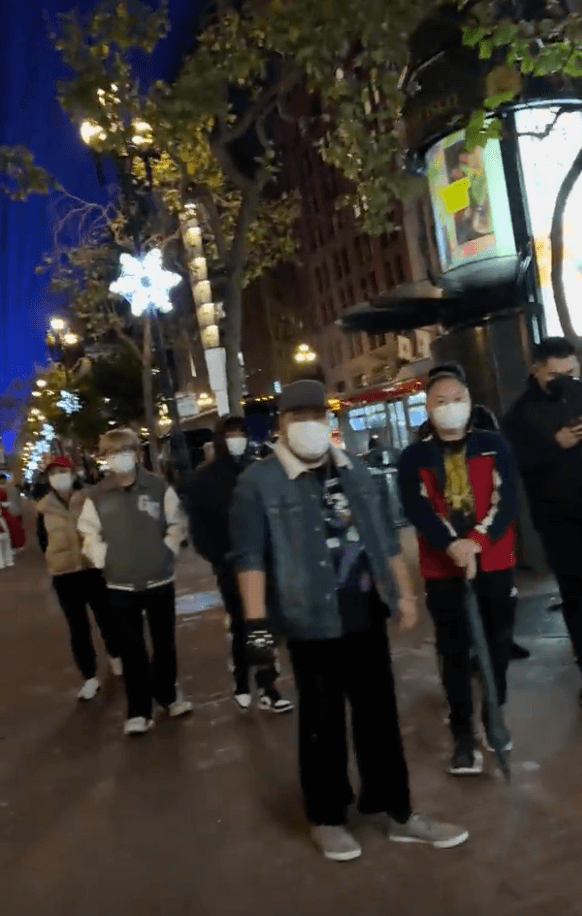
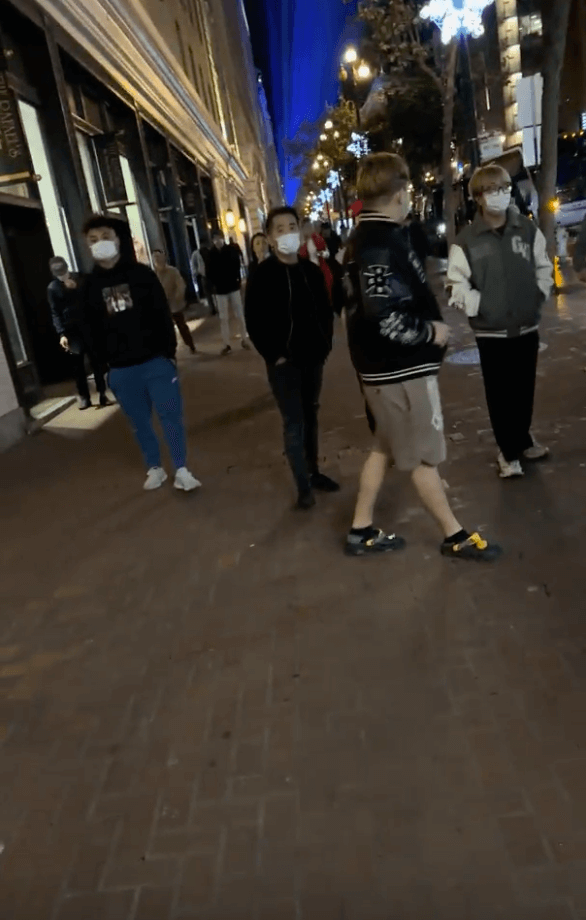
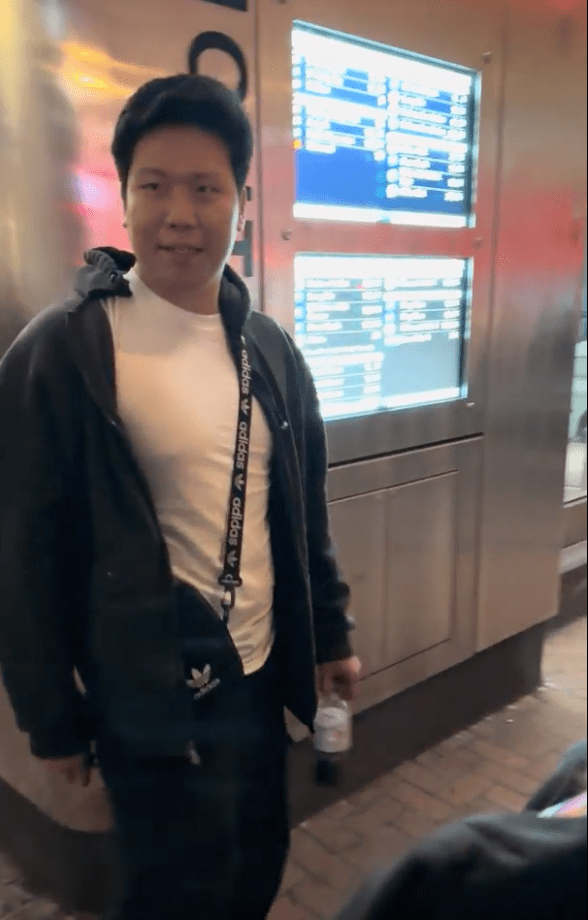
Stills from the above video
At one point, Chemi Lhamo told a bystander they were being followed, hoping that the bystander might assist them.

The bystander did not initially appear to be part of the group of stalkers nor did he appear to be East Asian, according to Chemi. The bystander said he was with “them,” referring to the stalkers. He then joined the group of stalkers. Chemi said it was a strange and inexplicable incident that gave her the impression that the stalkers were from the area and perhaps part of a gang or other local organization.
The protesters reported the stalking to two police officers who were standing on the street.
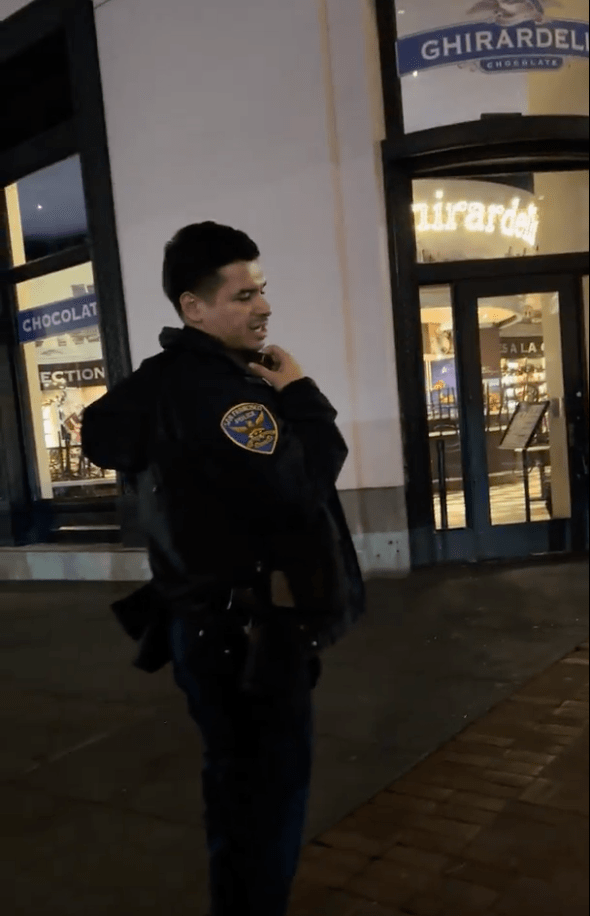
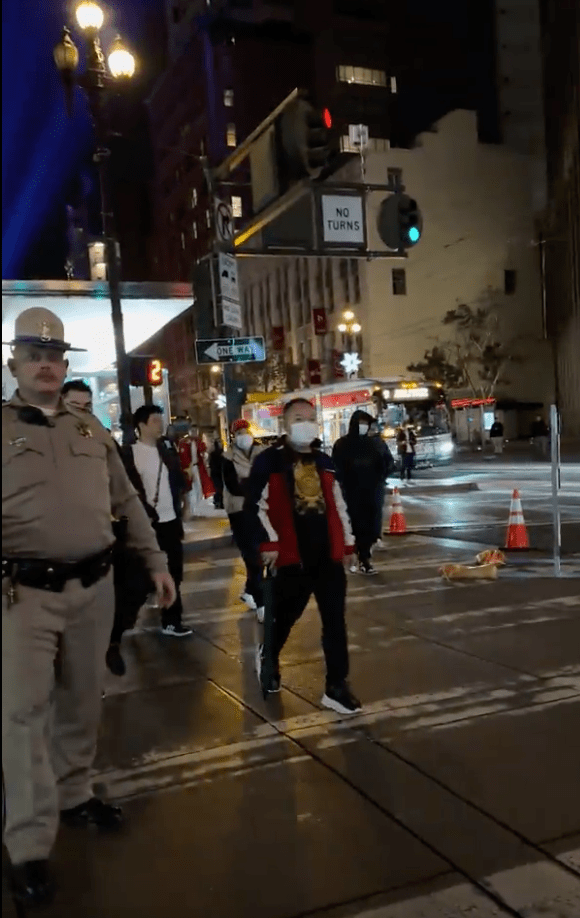
One officer replied that, since it was a free country, the police couldn’t just stop people on the street.191 Chemi also informed the officers that the people following them “have been assaulting people.” The officers failed to act. The stalkers passed the officers and walked in front of the protesters. Because of this and the officers’ inaction, the protesters decided to turn around and walk in the opposite direction of where they had intended to go. They communicated by phone with the other Tibetan protesters they had planned to rendezvous with and arranged to be picked up at a different location.192
SFT Executive Director Pema Doma was in communication with the group by phone and arranged to have them picked up. She said, “Those involved experienced this as a very scary incident. It was most traumatic for the young people. It causes long-lasting fear: Is somebody following me still?”193
Assault on Chow Kai-hong
Also near the Hyatt Regency on the evening of the 15th, a 74-year-old Hong Kong protester named Chow Kai-hong / Zhou Qihong (周啟鴻; also commonly referred to as Chow Baak 周伯, 伯 meaning “uncle”) was assaulted. The attack occurred outside The Hearst Building on Third Street near its intersection with Market Street and just down the block from the Hyatt Regency. At least five men were involved in the attack. One man shoved Chow to the ground.
Chow says that, throughout the incident, he tried his best to protect his head and chest He had a pacemaker and didn’t want the assailants to damage it. His right shoulder, right hand, left shoulder, and right leg were injured in the attack.195
The man who pushed Chow to the ground has been identified as Yu Yingqiang (余穎強; in English, he appears to go by Wing Yu).
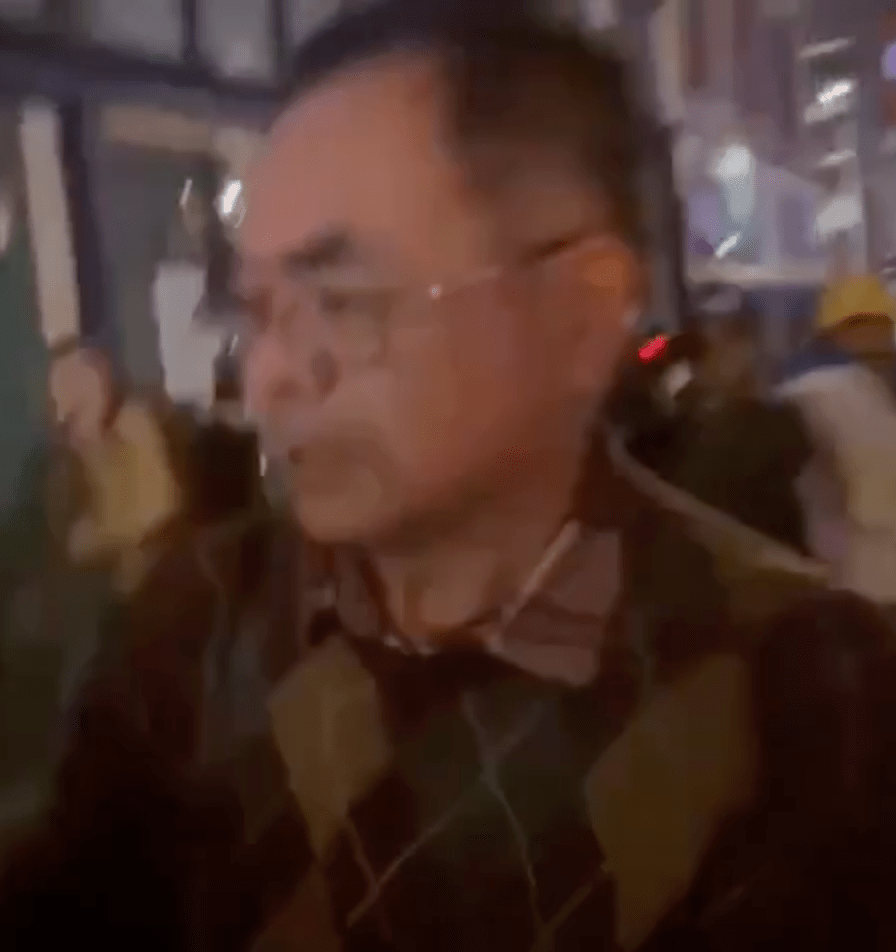
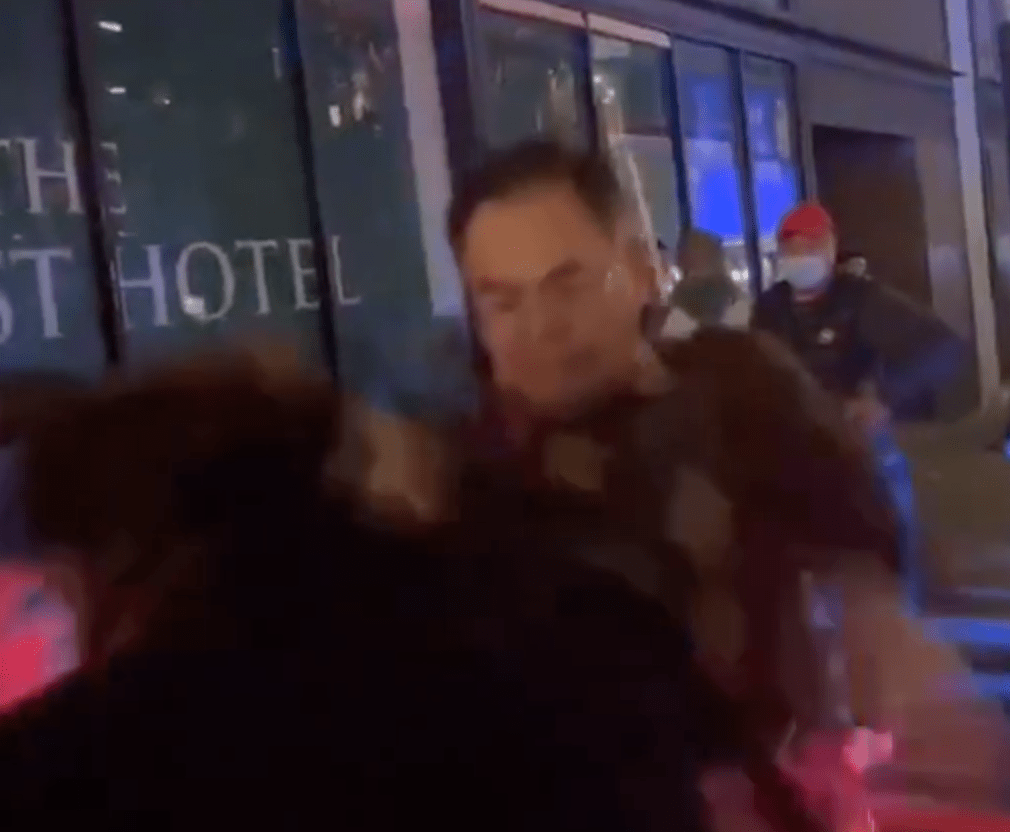
Yu appeared elsewhere on the streets of San Francisco, including at the encounter between united front leader Jing Dongsheng and protester Ma Yongtian (see above)…
…and earlier on the 15th near Market Street, about one block from the Hyatt Regency, among CCP supporters…
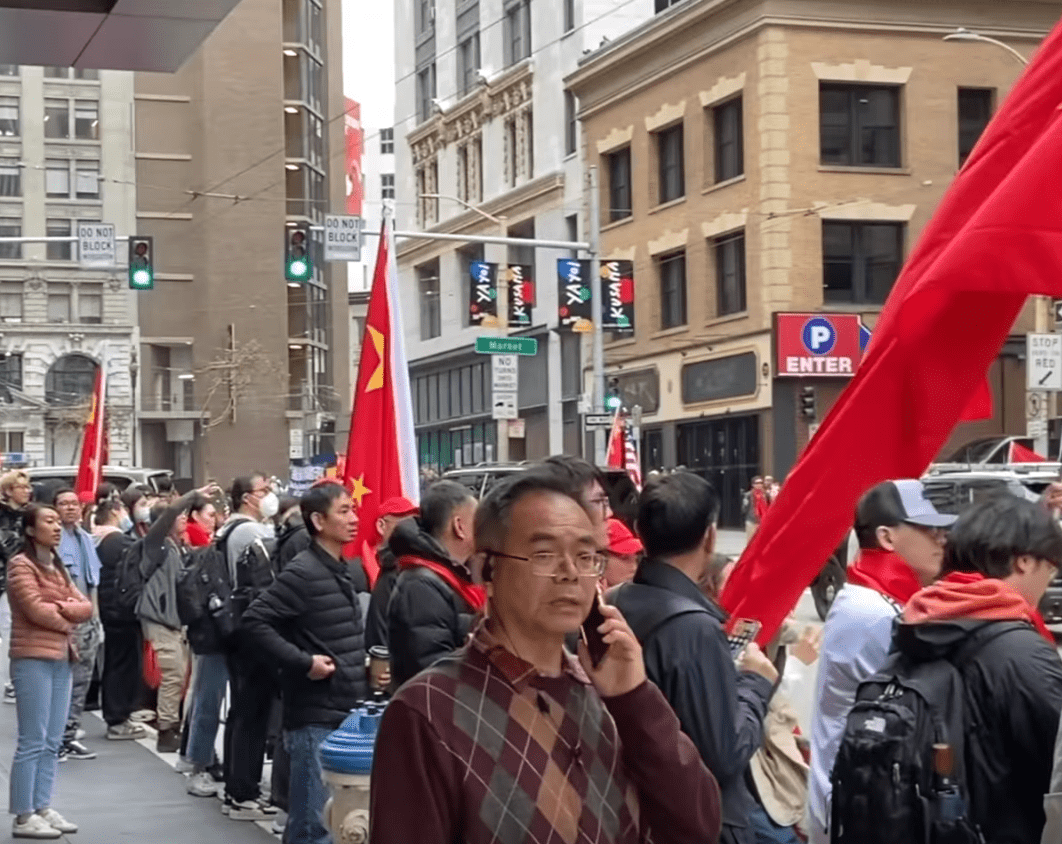
…as well as at the corner of Third and Jessie, across the street from the Hyatt Regency, where he appeared again in the company of Jing Dongsheng, perhaps with the group that had traveled from Oregon…
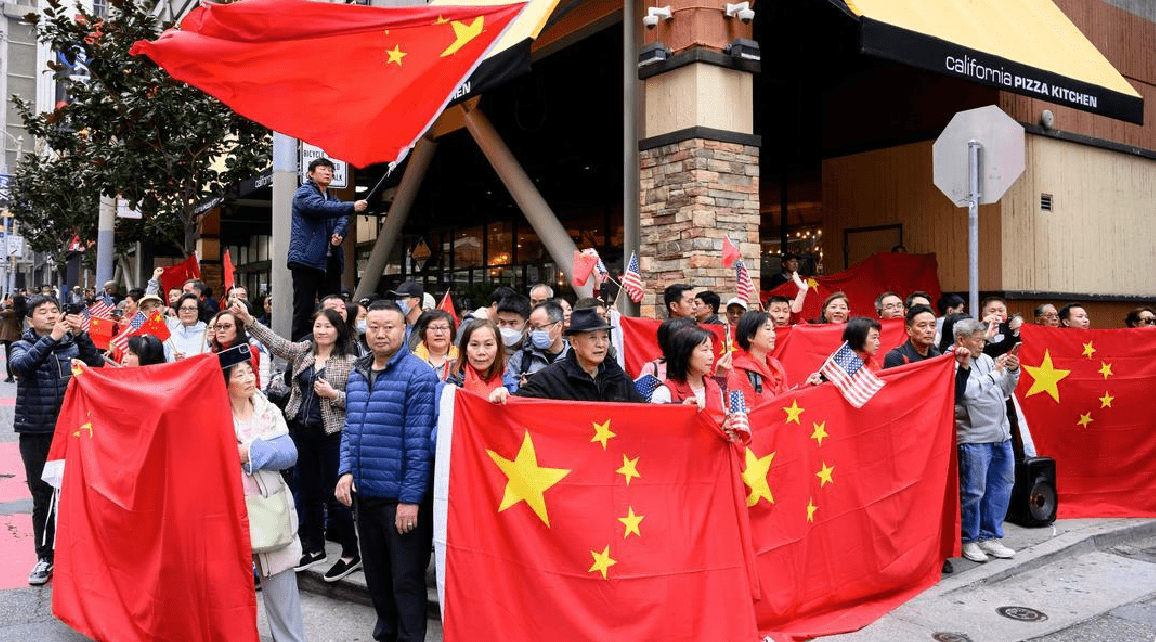
…and again at the airport on November 17 among the scrum of CCP supporters that assaulted Chemi Lhamo (see below)…
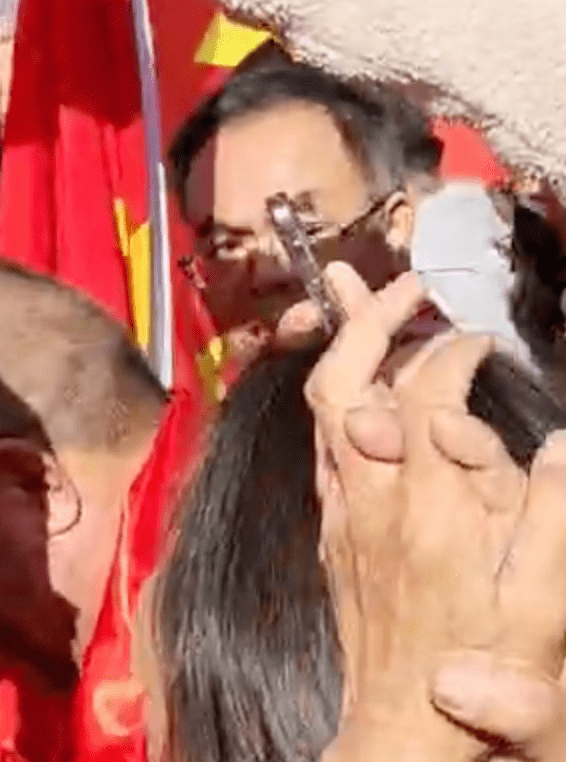
Protesters suspected Yu of playing either a coordinating or scouting role or both, as he was viewed on two occasions wearing earpieces, frequently communicating on his phone, and apparently being on the lookout.
Yu appears to be based in the Portland, Oregon, area. Unlike many of the other identified harassers, intimidators, and assailants, he does not appear to have a history of involvement with united front organizations.197 It is unclear how such a previously unassuming person with no apparent history of united front involvement found himself playing a fairly active role, including assaulting a protester, on the streets of San Francisco. It is possible he was recruited by Jing Dongsheng, also of Portland, with whom he appears in Ma Yongtian’s video and in the photo taken in front of the Hyatt Regency.
Chow would be assaulted again by CCP supporters on November 17 near the airport when he was in the company of Kaiyu Zhang, the victim of one of the most brutal incidents of assault during Xi Jinping’s visit (see below). On November 21, Chow filed a report with police in regard to both assaults: the one on the 15th and the one on the 17th.198
Thursday, November 16
Third day of Xi Jinping’s visit to San Francisco
Xi Jinping took part in APEC meetings held at the Moscone Center, only blocks away from two other locations mentioned frequently in this report, the Hyatt Regency Hotel and the St. Regis Hotel. Because there was no event in which Xi was featured, such as the Biden-Xi meeting or the banquet in honor of Xi, no large-scale protests against Xi were called in advance. There were a number of serious incidents of harassment, intimidation, and assault. Most occurred in the vicinity of the Moscone Center, and most were against Chinese protesters.
Among the serious incidents of the day were assaults on:
- Chinese protester Peng Xiaowei, whose phone was stolen and tracked to Hong Kong, then China; and
- Chinese protester Chen Chuangchuang, who was pepper-sprayed.
Several other reports of assaults appeared in the media and on social media, and some were made to us. These shall also be noted in this section.
Assault on Peng Xiaowei outside the Hyatt Regency Hotel
The circumstances of the assault on Peng Xiaowei (彭小偉) were similar to those in other situations in which assaults occurred: he was surrounded and outnumbered by CCP supporters, and his phone was stolen. This was the first reported theft of a protester’s phone in San Francisco during Xi Jinping’s visit. There would be several more phone thefts, especially the following day, the 17th, near the airport. This suggests that CCP supporters may have become more aware that photos and videos of them could potentially lead to their identification. Peng believes the assailants were deliberately targeting him for his phone and appeared to be cooperating to steal it.
Peng was together with two others who held protest signs. Peng was filming, aware of the possibility of attack and wanting evidence. His companions’ placards were snatched away. Then someone behind Peng snatched his phone. He turned around and saw the person who took his phone throw it to someone else who quickly ran away. Peng wanted to pursue him but someone grabbed Peng by his clothes and pulled him back. Four or five others surrounded him and beat him on the head and various parts of his body. Police quickly intervened and removed Peng from the group. His backpack had also disappeared, but police helped him to recover it.199
On November 17, the next day, Peng searched from a connected device for the photos and videos he’d taken on his phone, but he discovered that all photos and videos from the 16th had been deleted. The phone’s locator showed that it was in San Francisco.
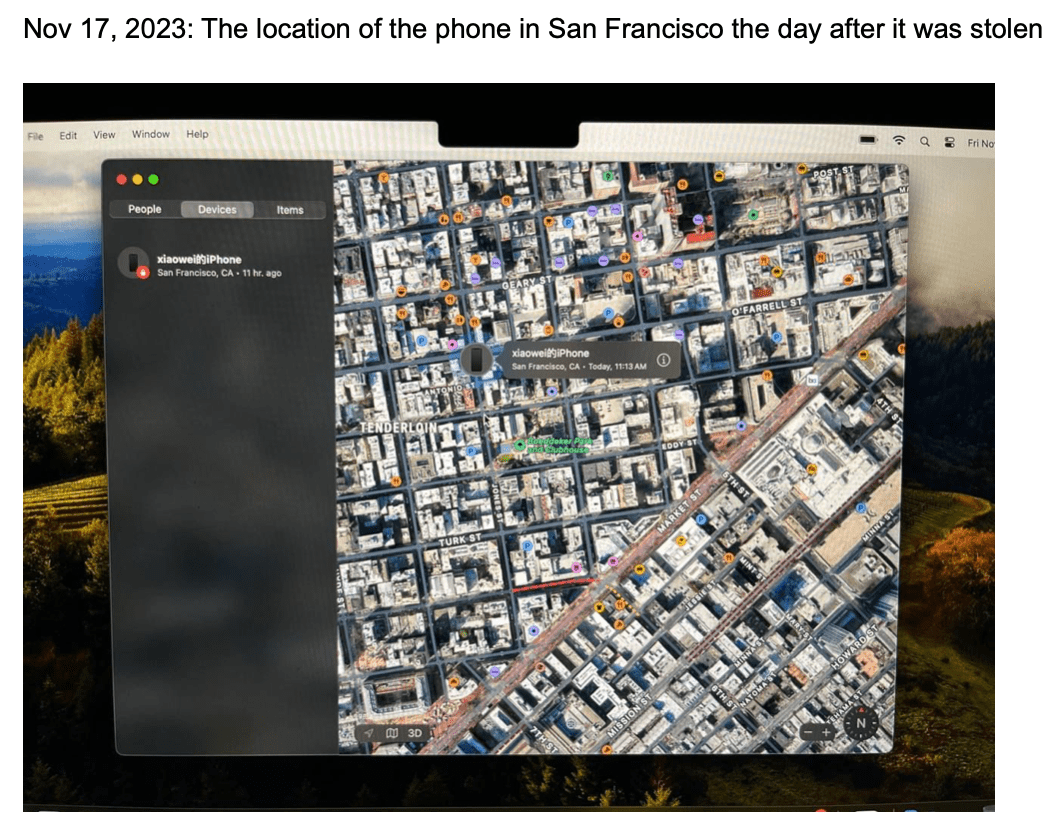
By November 22, the phone’s locator showed it was in Hong Kong.
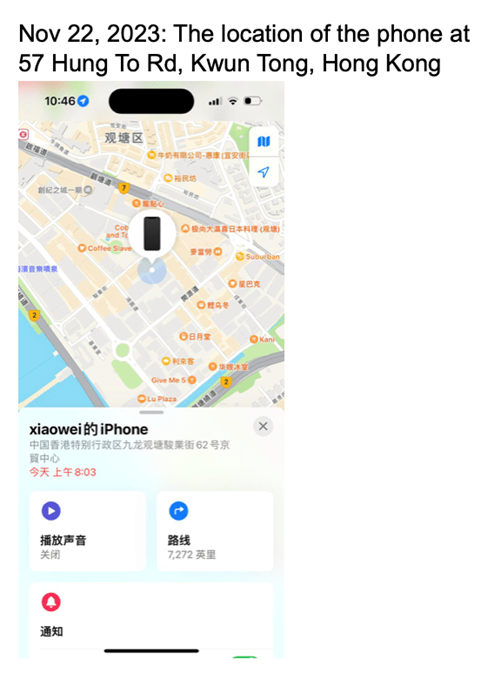
A week later, the phone was in Shenzhen, Guangdong province, PRC.
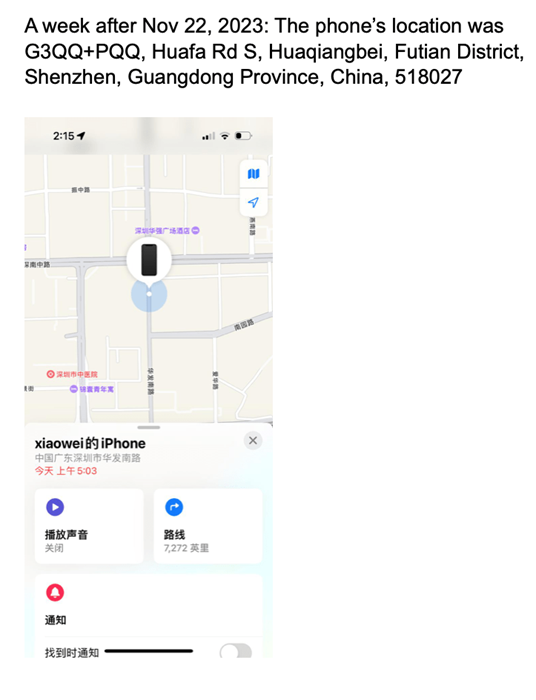
On November 22, Peng Xiaowei’s sister in the PRC told him that police in their hometown visited her on that date and interrogated her about Peng. Among other questions, they asked her when he had gone to the US, what he was doing there, and when he would return to China. It is possible that the police interrogation was related to the theft of the phone, but Peng Xiaowei is also active on social media and documented his presence in San Francisco on his X/Twitter account, including the attack on him.
Peng said he provided a video of the assault as well as the locations of his phone after its theft to the San Francisco Police Department. As of February 4, 2024, he had received no information from the SFPD regarding the status of the investigation into the incident.200 Peng also provided the locations of his phone to the FBI.
Assault on Chen Chuangchuang, near the Moscone Center
Chen Chuangchuang (陳闖創), a lawyer and one of the leaders of the China Democracy Party, was attacked between 12 noon and 1 p.m. He said he arrived near the Moscone Center, the APEC venue, along with several other protesters. At the corner of Fourth and Mission Streets, they found themselves outnumbered by CCP supporters.
The attack occurred during a confrontation between CCP supporters and protesters. CCP supporters were pushing protesters away from the temporary security fence put up in front of the Moscone Center, and thus, away from view from the center. They cornered some of the protesters in the entryway of a building. At that point, police intervened and attempted to separate the parties. As they were doing so, Chen was pepper-sprayed in the face by a CCP supporter. Chen’s glasses had been broken by CCP supporters the day before, the 15th, and when he was pepper-sprayed, he didn’t even realize at first what had happened until his eyes started burning.201
This is the person Chen identified as the perpetrator of the pepper-spray attack.
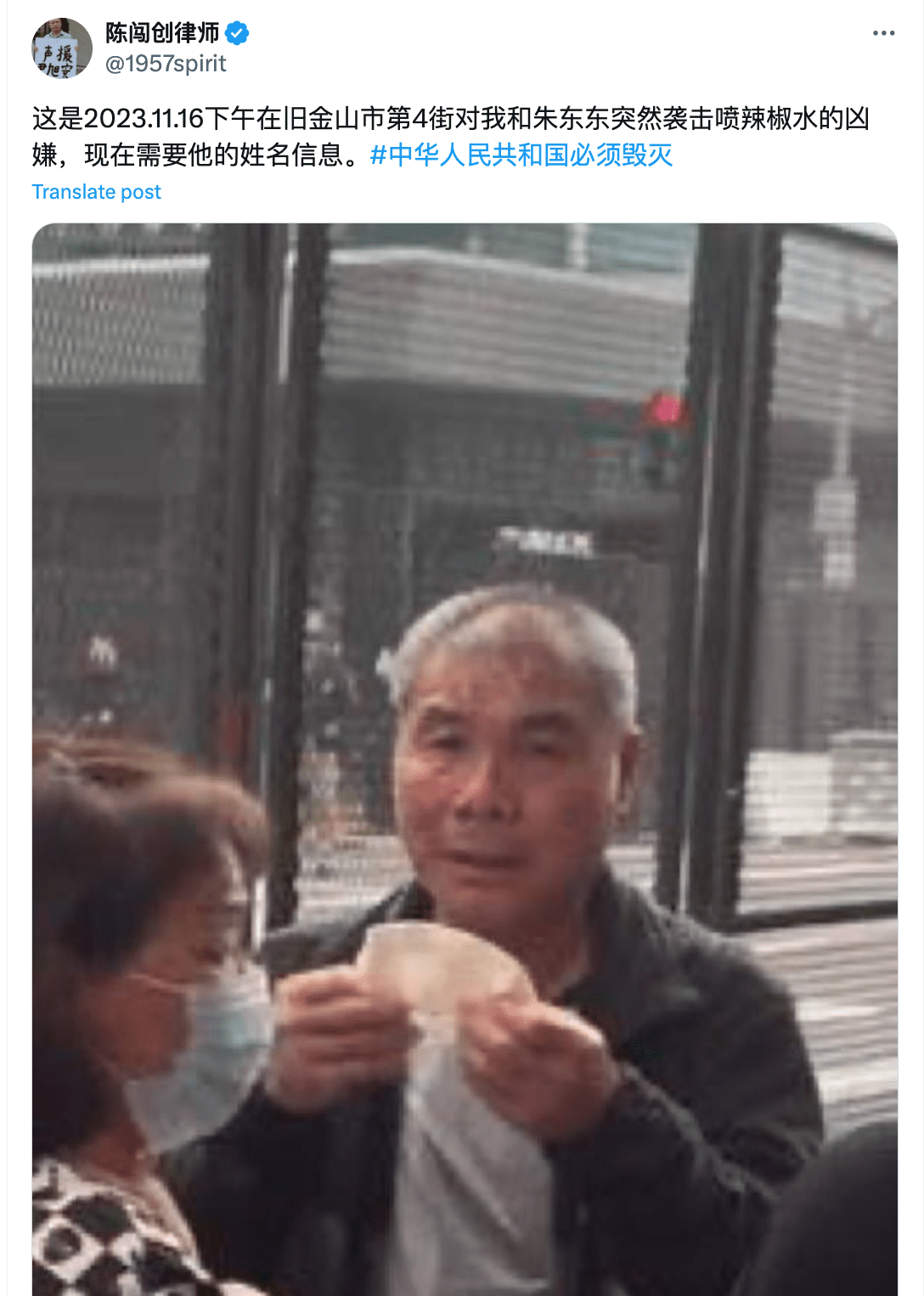
The actual moment when Chen was pepper-sprayed cannot itself be seen in the video above . But seconds before the attack occurs, the bluish green shirt of another man can be seen close to Chen. The man can also be seen at other points in the video:
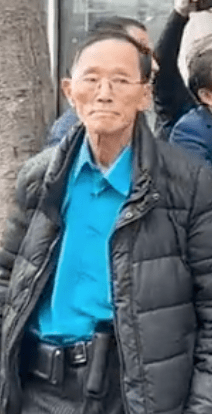
This man’s name is Joe Ma Zuolin (馬作林). In the still photo above, it can be seen that, on his belt, he wears an empty holster that could be used to hold a can of pepper spray.
He is the prominent chairman of the East Bay Toishan Association (東灣台山同鄉會; also sometimes referred to in English as the Toishan Benevolent Association) based in nearby Oakland. Ironically, one of his most publicized initiatives in recent years was a Chinatown Patrol Team that purportedly sought to reduce crime in Oakland’s Chinatown and was associated in the media with countering anti-Asian hate crimes; yet here he was, on the streets of San Francisco across the bay, involved with a group that was carrying out attacks against other Asians.204
The man whom Chen identified as the person who pepper-sprayed him is apparently an associate of Ma. He appeared with Ma at an event held in January 2024 with the purpose of improving relations betweens Oakland’s Black and Asian communities.205 The man appears to be regularly involved with the East Bay Toishan Association, as can be concluded from his attendance at its Lunar New Year events in 2019, 2020, and 2023.206
The East Bay Toishan Association has had a cordial relationship with the PRC consulate of San Francisco and appears to align itself with CCP priorities. Wang Kun (王昆), an official at the consulate (as of 2023, Deputy Director of Overseas Chinese Affairs207), spoke at the East Bay Toishan Association’s 22nd and 23rd anniversary celebrations in 2023 and 2024 and praised the association for its collaboration with “patriotic overseas groups.” He also noted that the association’s founding mission includes “supporting the motherland’s development” and “working toward China’s unification.”208 In 2022, members of the association, including Joe Ma, celebrated the 73rd anniversary of the PRC.209 The association displayed the PRC flag alongside the US flag, a visual pairing frequently used by CCP supporters in San Francisco and by united front groups in general.210
In the video of the assault above, as Chen pleads with the police to arrest the man he identified as the culprit and says he wants to file a police report, his companions suddenly see the alleged assailant in the crowd and rush toward him (1:42). At this point, CCP supporters intercede, stepping between the culprit and the onrushing protesters followed by the police. The assailant can barely be seen in the left-hand side of the video around 1:50:
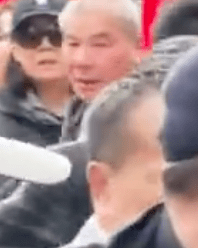
As fellow CCP supporters stand between him and Chen’s companions, the suspect recedes into the background. Among those blocking the approach to him are Chen Wenshen (陳文深), the bald-headed man who enters the video frame at 1:52.
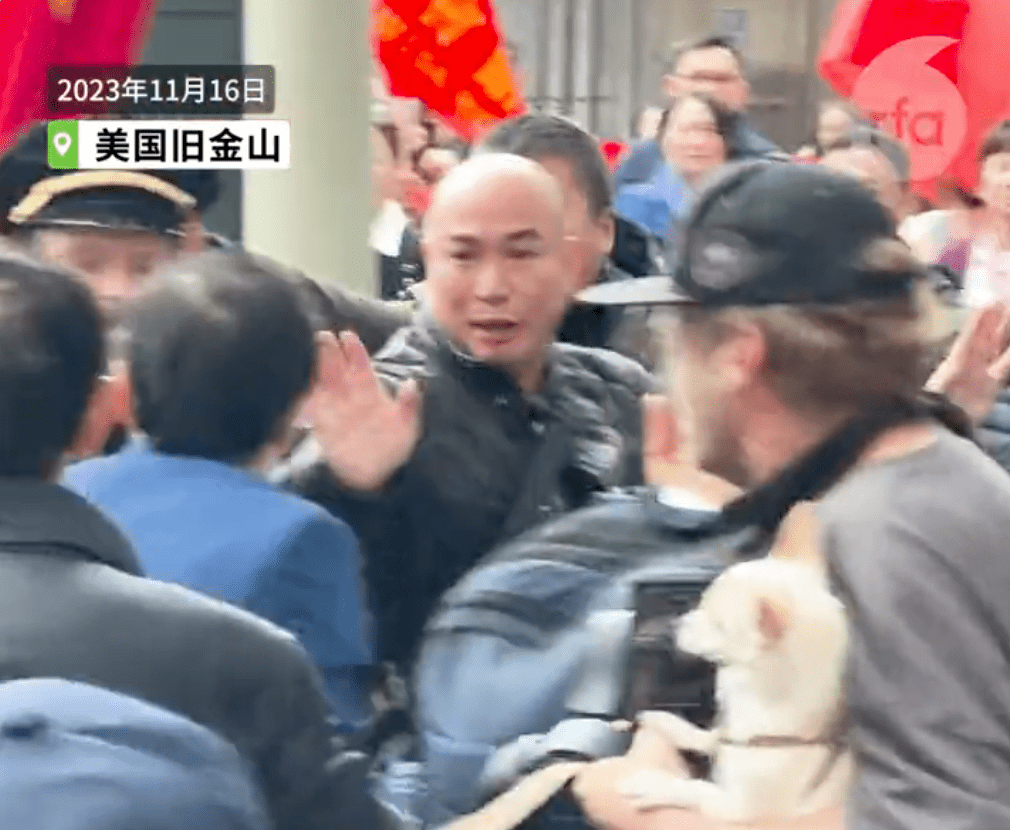
As noted previously, Chen Wenshen was at the scene of several attacks. Indeed, he was last seen on the evening of November 15 near the Hyatt Regency Hotel playing the same role he played on this occasion, namely, preventing protesters from following the person they believed to be the culprit (see above). Earlier in the video (00:17), he can be seen aggressively going after a man holding an “End CCP” placard and attempting to snatch it from him.

Another person blocking the approach to the man accused of pepper-spraying Chen is Guo Jianwei (郭建伟), seen standing to the left of Chen Wenshen at 1:57.

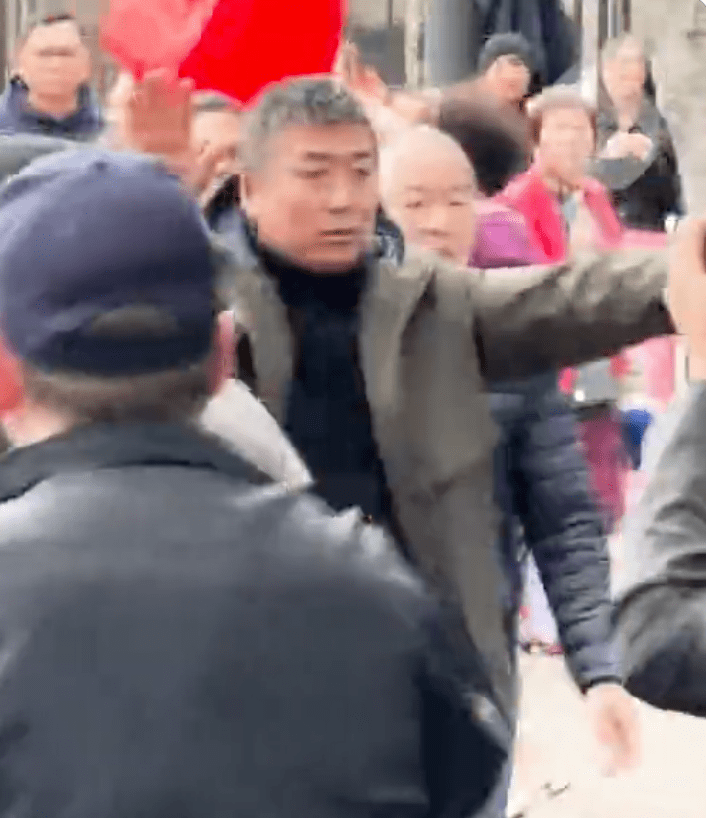
Like Chen, Guo was also involved in the attack on Wang Wei on the 15th, throwing a punch at him as he lay on the ground (see above).
The photo below shows Chen Chuangchuang making a report to the police after the attack. As of January 31, 2024, Chen had received no information from the San Francisco Police Department regarding the status of their investigation into the attack.211
Three Chinese protesters and one non-Asian passerby were assaulted outside the Moscone Center, not far from where Chen Chuangchaung was pepper-sprayed. The three Chinese protesters were Liu Yijiang, Jiao Ruilin and Hu Tingfeng. The passerby attempted to intervene to protect the protesters under attack. He was hit over the head with a glass bottle. There was significant bleeding, and the inch-and-a-half-long cut required stitches, which were done later at the hospital.213
One of the CCP supporters present at the scene, an older man, was identified by victims as having had a role in the attacks, perhaps directing the others.
.png)
The man on the right in the above photo is Zhu Jiemei (朱介眉), a united front leader from the Portland, Oregon, area, reported to be chair of the Oregon Overseas Chinese Association (俄勒岡華人聯合會), vice chair (or in some cases, vice president) of the US Association for China’s Peaceful Unification (美洲和平統一促進聯合會), and chair of the US Suey Sing Association (美洲萃勝工商會波特蘭, a traditional chamber of commerce dating back to the early days of Chinese immigrant presence in the US). All of the above is according to a report about Zhu’s April 2023 visit to the Shaanxi Federation of Returned Overseas Chinese (陝西省歸國華僑聯合會), a united front group in Shaanxi Province, PRC.214 The source of the report is a sign that the visit was official and made in coordination with Party authorities. On that visit, Zhu wore the same black fedora hat he wore in San Francisco. Other sources refer to him as chair of the Oregon Association for China’s Peaceful Reunification (俄勒岡州促進中國統一促進會)215 and a founding member ( 元老) of the Portland Suey Sing Chamber of Labor & Commerce (砵崙萃勝工商会).216
Zhu was also present at the August 2023 pro-CCP demonstration against the visit of then-vice president of Taiwan William Lai Ching-te to San Francisco.217 The RFA article in which he is quoted refers to Zhu as the chair of the Oregon Overseas Chinese Association. Several local Associations for the Peaceful Reunification of China were present at the demonstration, including the one from Oregon he has been reported to chair. Jing Dongsheng (靖東升), another united front leader from Portland, also appeared at that August 2023 protest, and he appeared on the streets of San Francisco participating in the harassment and intimidation of Li Huanjun and apparently acting as a scout (see above).
In September 2023, Zhu gave a speech at an event celebrating the 74th anniversary of the PRC that was attended by top officials of the PRC consulate in San Francisco.218 In March 2019, he also gave a speech at an event celebrating 40 years of “Reform and Opening.” This event was also attended by top officials of the PRC consulate in San Francisco as well as Jing Dongsheng.
Zhu was also pictured holding a PRC flag on the corner of Third and Jessie Streets, across from the Hyatt Regency, along with Jing Dongsheng and Yu Yingqiang, the man who attacked the 74-year-old Hong Kong protester on the 15th (see above).

Another united front figure from the Portland area, Rong Junwu (容鈞武), was also on the scene, dressed in a white jacket.

He was also present at the assault on Wang Wei on the 15th, and he was one of the scouts, along with Jing Dongsheng and Yu Yingqiang, in Ma Yongtian’s video (see above). Along with Jing Dongsheng, He Konghua, and Chen Zhaojin, he also attended the April 2023 protest against Taiwan’s then-president Tsai Ing-wen’s visit to Los Angeles.220 Rong Junwu is associated with the Portland Suey Sing Chamber of Commerce & Industry, acting as its vice-president and consultant in 2022, president in 2023, and consultant in 2024.221
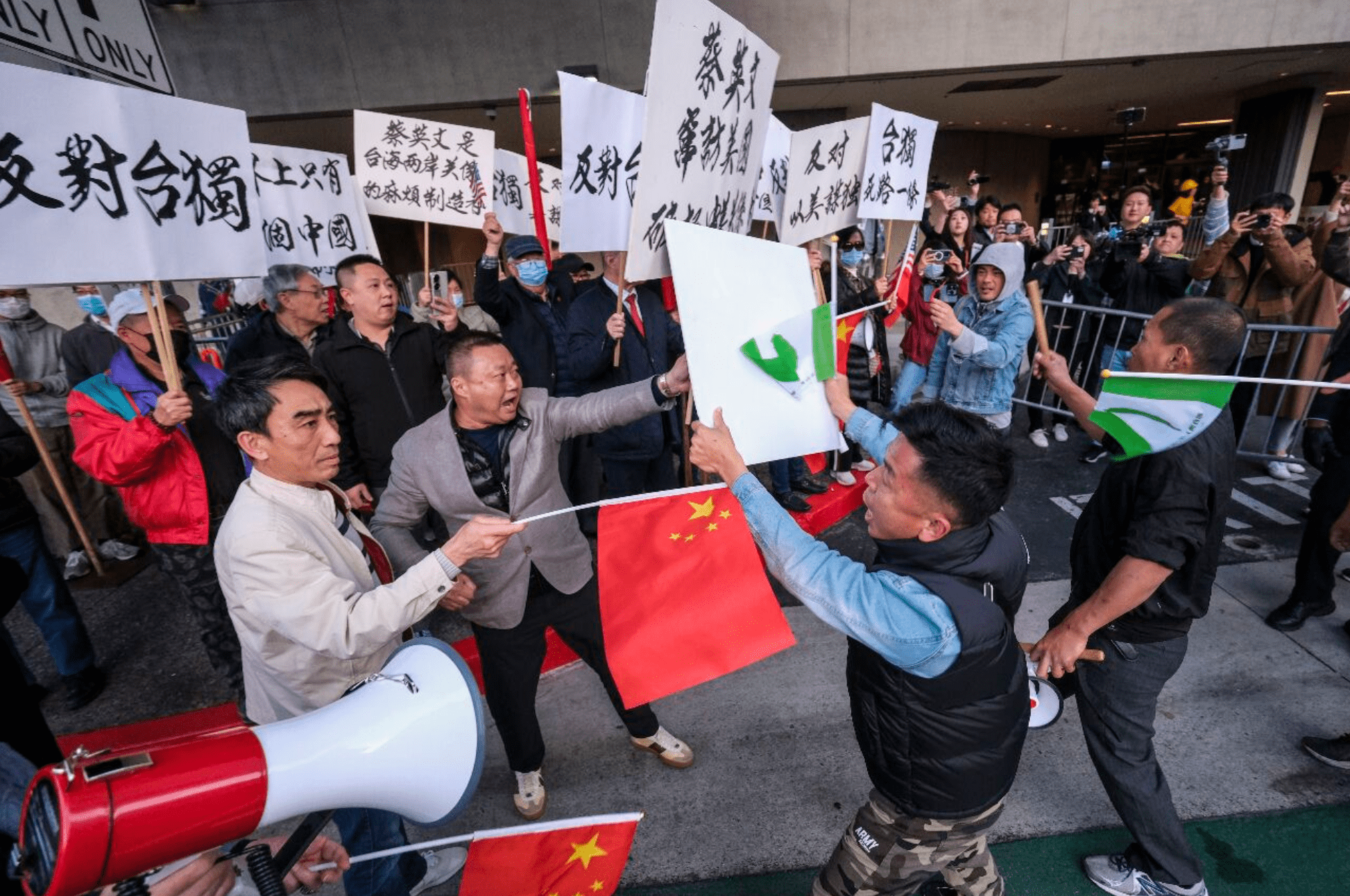

The bald-headed Chen Wenshen (陳文深) was also present during the attacks at the Moscone Center, as he had been just a short time before when Chen Chuangchuang was pepper-sprayed as well as on other occasions, including the assault on Wang Wei near the St. Regis Hotel on the 15th, near the barricade attack on Hong Kong and Tibetan protesters near the Hyatt Regency Hotel on the 15th (see above), and at the airport on the 17th (see below).
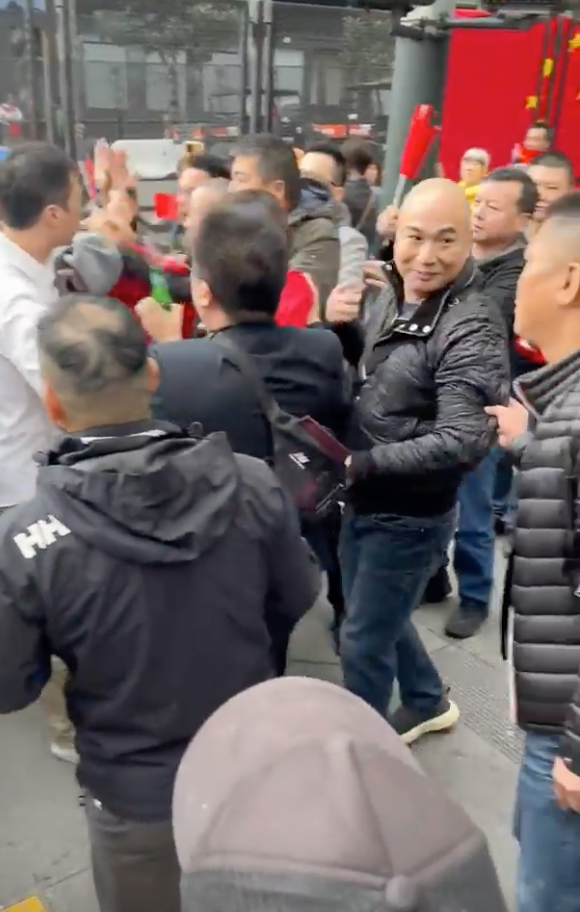
Liu Yijiang also identified Yang Baohai (楊寶海; he also goes by the name, Liu Baohai / 劉寶海) (left) and the man standing next to him as having been involved in the attacks.

Yang Baohai was also involved in the attack on Tibetan protesters at the designated protest zone across from the Hyatt Regency on the 15th, and he has been seen at other pro-CCP events in the past (see above).
Prior to the attacks on Chinese protesters near the Moscone Center, a group of Vietnamese protesters had been gathered at the same location. Some members of the China Democracy Party joined them. One of the Vietnamese protesters had a placard depicting Xi Jinping. This appeared to be the reason the CCP supporters began attacking the Vietnamese protesters. In fact, the Vietnamese protesters had been on the scene first, along with a handful of Chinese protesters. The CCP supporters appeared to attempt to supplant them, mixing in with them and covering their flags and posters with PRC flags. Yang Baohai was also involved in that incident.
A united front leader from San Francisco was also present during the harassment and intimidation of the Vietnamese and Chinese protesters. Her name is Jennifer Cheung/Chung (張藍真/張蘭真; also sometimes referred to in Pinyin as Zhang Lanzhen). She can also be seen in the video above. In the photo below, she holds a long flagpole with a PRC flag on it, pointing it toward the protesters in a threatening manner:
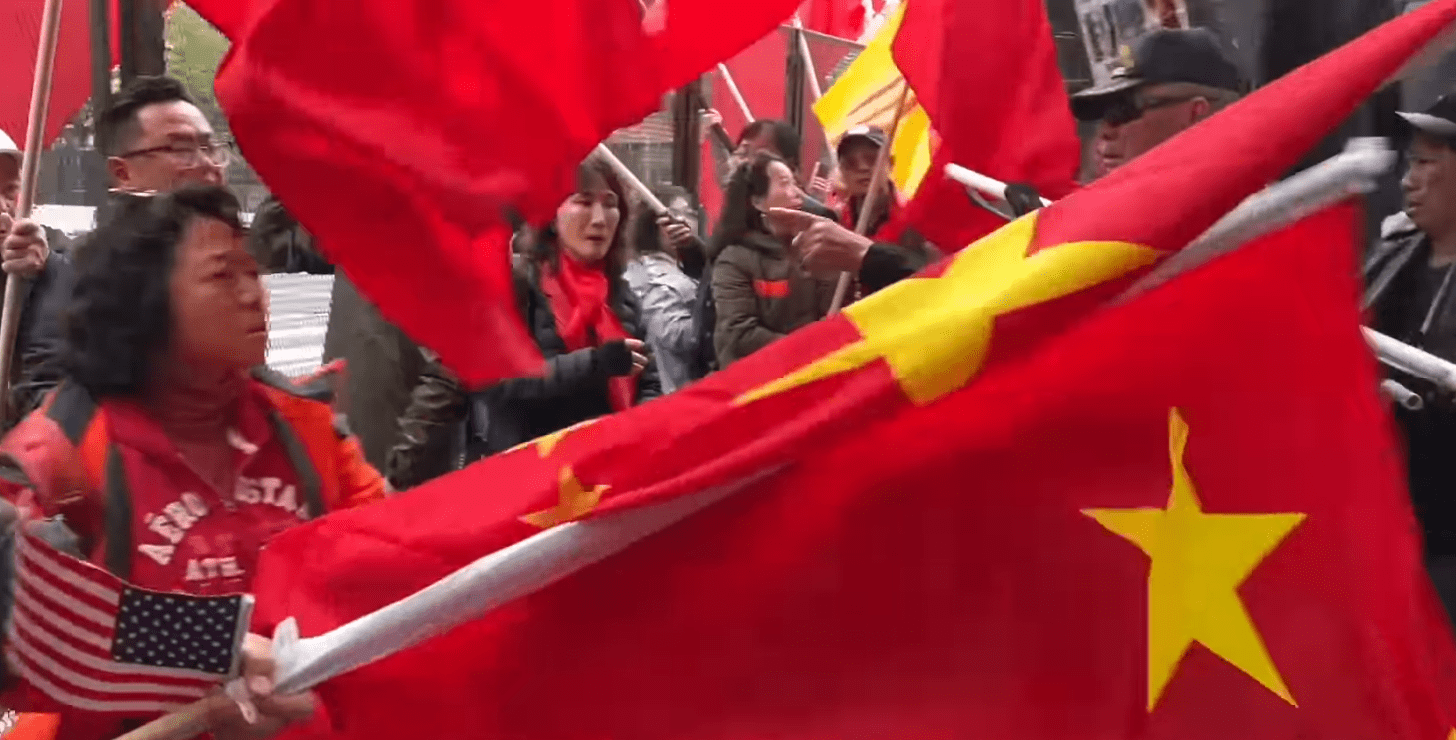
Cheung is chair of the Rape of Nanking Redress Coalition (南京大屠殺索賠聯盟)223 and President of the Global Alliance for Preserving the History of WWII in Asia (世界抗日戰爭史實維護聯合會; the literal translation is “Global Alliance for Safeguarding the Historical Truth of the Anti-Japan War”), the latter as reported on the Alliance for China’s Peaceful Reunification website.224
On the 17th, she was at the San Francisco International Airport, where she played a key role (see below for more on that and for other information about her united front activities and network).
Both Chen Wenshen and Jennifer Cheung can be seen briefly in a video of the assault on Hu Tingfeng (with the assaults on Liu Yijiang and Jiao Ruilin occurring nearby). The following are screenshots from the video.
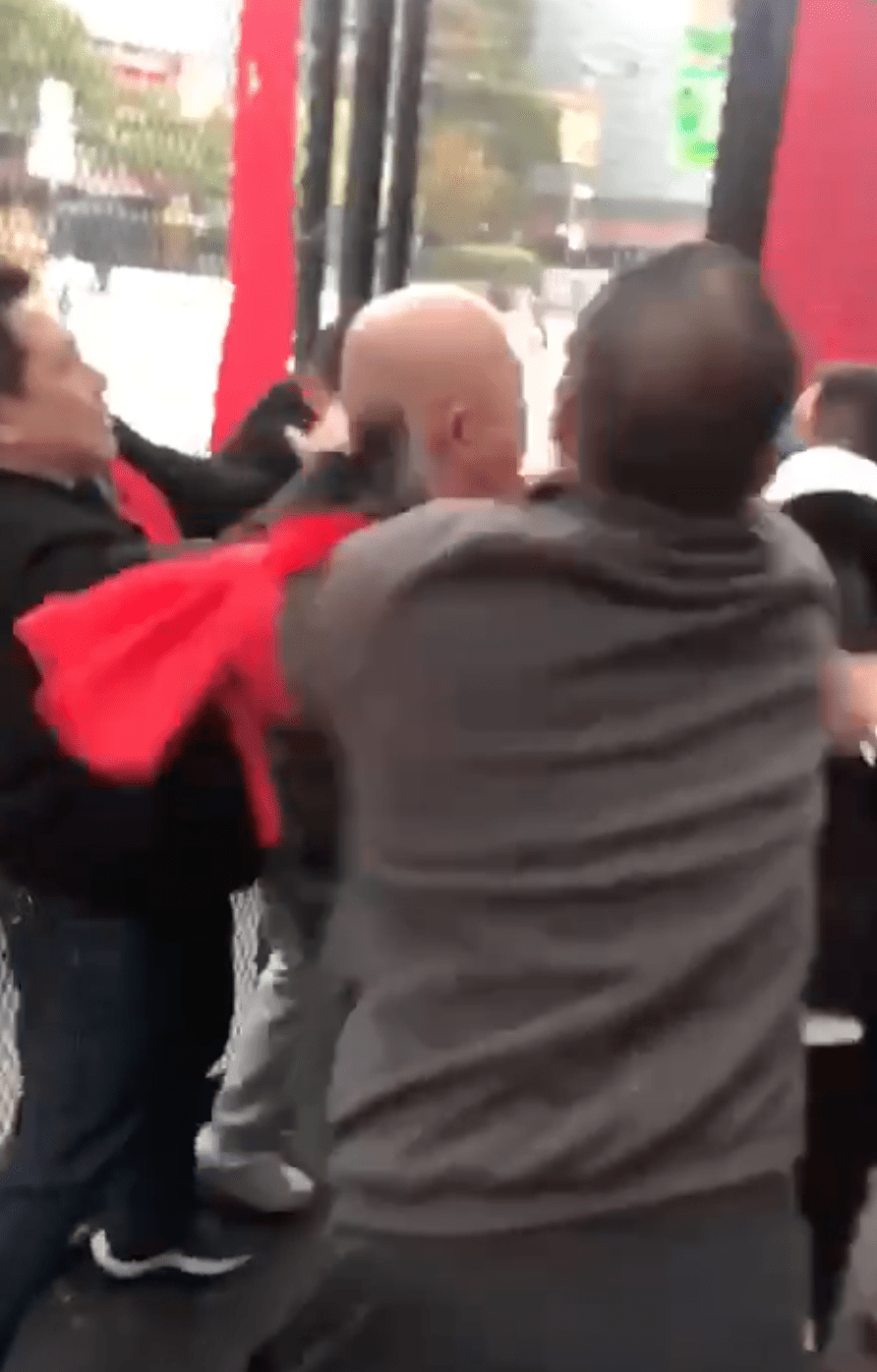
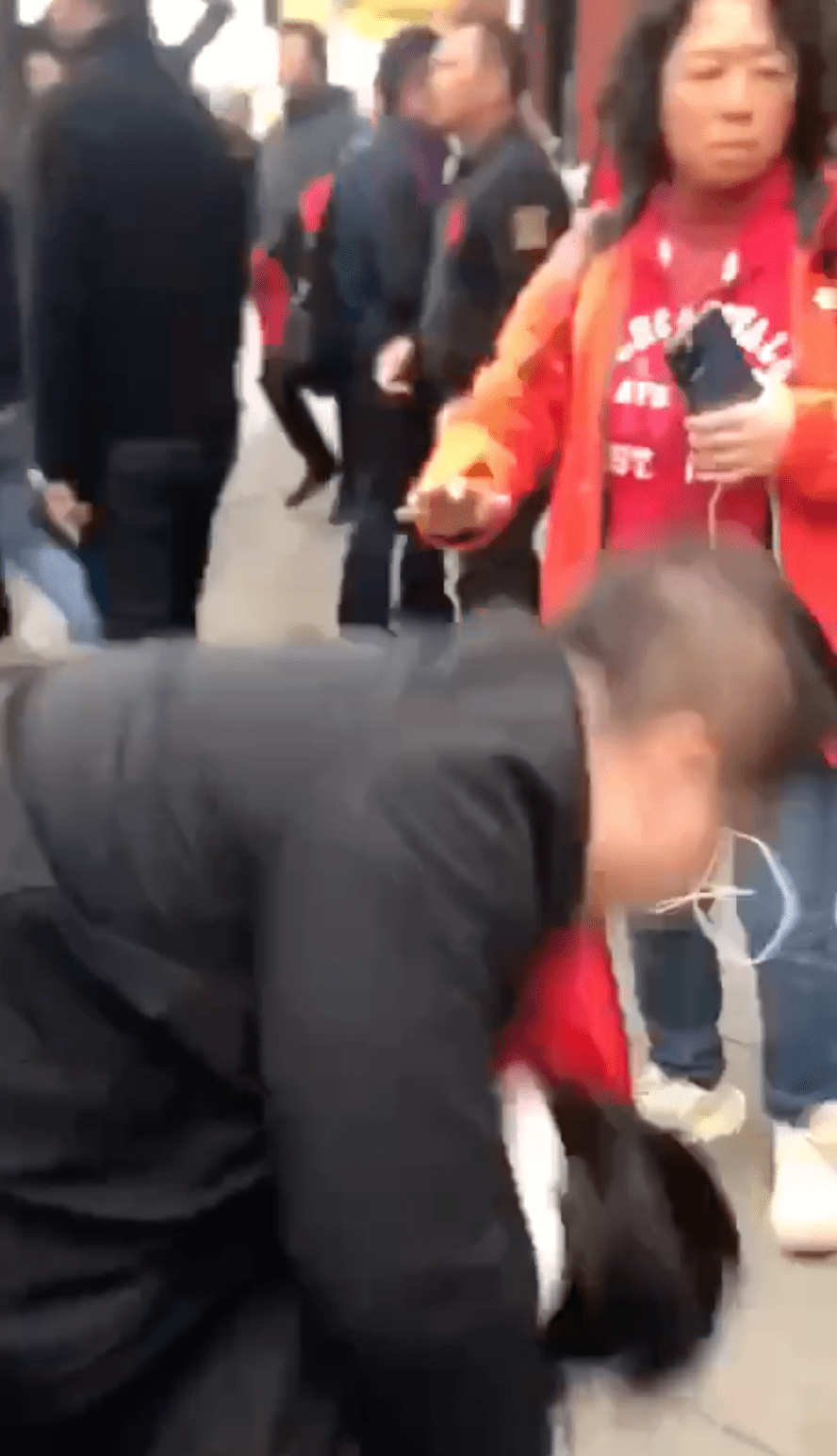
Chen in particular appears to have actively participated in the assault.
Chinese protester Li Delong (李德龍) was attacked near the Moscone Center. He said that he was knocked unconscious, that his head and mouth were bleeding, that he was sent to the hospital by ambulance for treatment, and that he filed a report with the San Francisco Police Department on November 21.226
Other assaults on November 16 were reported in the media or on social media, including the following: Chinese protester He Ruizhong (賀瑞忠) reported being beaten by several security guards working with CCP supporters on the sidewalk outside Oren’s Hummus restaurant across the street from the Hyatt Regency.227 Chinese protester Ge Kaiying (葛開英) reported being attacked around noon around Fourth Street near the Moscone Center. She said the attacker stepped on her feet, stole a box she was carrying, and then hit her. She identified the attacker as Li Huahong, the head of the Chinese Anti-Cult World Alliance who was also involved in the assault on Jia Junwei near the St. Regis on the 14th and the attack on the designated protest area across the street from the Hyatt Regency on the 15th (see above).228 A Chinese protester named Victor Yuen as well as Chinese protester Chen Weiming (陳維明) reported the beating of another China Democracy Party member who was taken away in an ambulance for treatment. This occurred near the Hyatt Regency.229
Friday, November 17
Fourth day of Xi Jinping’s visit to San Francisco
Xi Jinping was scheduled to depart San Francisco International Airport. Beginning in the morning, crowds of CCP supporters as well as protesters gathered along the airport’s North Access Road. Most protesters and CCP supporters parked their cars in the Costco Wholesale parking lot nearby. All of the incidents of harassment, intimidation, and assault on the 17th occurred in this general area.
Among the serious incidents of the day were the following:
- Tibetan protester Chemi Lhamo was surrounded, harassed, intimidated, and assaulted, and her phone was stolen.
- Tibetan protester Topjor Tsultrim was assaulted.
- Hong Kong protester Carmen Lau was assaulted.
- Hong Kong protester Kennedy Wong was assaulted.
- Two Tibetan 19-year-olds were assaulted, one phone was stolen and damaged, and one phone was lost
- San Francisco-based KTSF Channel 26 reporter S. was intimidated and his phone was stolen.
- Chinese protester Kaiyu Zhang and Hong Kong protester Chow Kai-hong were assaulted.
Compared to the 14th, the day of Xi Jinping’s arrival at the San Francisco International Airport, a larger number of CCP supporters gathered earlier on the 17th. By 9 a.m., when protesters began to arrive, approximately 1,000 CCP supporters were already there. As Topjor Tsultrim put it, “They had learned their lesson to come early and take up all the space.” Indeed, denying any space to protesters, and, in particular, preventing protesters from assembling anywhere they could be viewed from the road where Xi Jinping was expected to pass, appeared to be the primary mission. Red scarves and flags were handed out to CCP supporters. Many of the supporters wore red hats and held PRC flags. Topjor also noted that there were fewer Chinese students than there had been on the 14th and that the majority of CCP supporters appeared to be the groups who had been seen in downtown San Francisco on previous days. In spite of the large number of CCP supporters already gathered, there was no discernible police presence. Only when some Tibetan protesters walked down and reached the end of the footpath running along the North Access Road did they see one police car and a few police officers.230
Pema Doma said she spoke with the police at this point. She told them she wanted everyone to have the right to peacefully protest and asked for barricades to separate the opposing groups. One police officer told her that there were no barricades and that the entire city of San Francisco was out of barricades.
While Tibetan protest leaders had difficulty liaising with law enforcement officers on the scene and received a variety of different and sometimes contradictory responses ranging from hostile to indifferent to sympathetic, police officers seemed to have more respectful and direct relations with at least one person who appeared to represent CCP supporters. In the following video, a police officer can be seen apparently sharing information (perhaps his contact information) on his phone with the woman accompanied by security guards, three of whom appear to be from the private company Critical Synthesis.
Security guards from the same company were seen accompanying CCP supporters that same day at the scenes of incidents of harassment, intimidation, and assault. On some occasions, they attempted to intervene to prevent the CCP supporters from further harming the protesters; on others, they stood and watched.
The woman in the video was also seen on the 15th outside the Hyatt Regency Hotel playing a similar role (see the “woman in purple” above).231 And on the 14th, she was filmed near the San Francisco International Airport conferring with people who appeared to be CCP supporters who had turned out to “welcome” Xi.
Soon after his arrival at the airport together with a handful of other protesters, Topjor said that they became the subject of attention of the CCP supporters. One man dressed all in black got on his phone, and Topjor could hear him talking about “xizangren” (Mandarin for “Tibetans”).
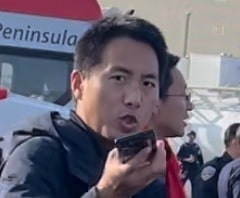
The Tibetan protesters were photographed, videoed, and followed, though they had yet to show Tibetan flags or banners or shout slogans.
On the 14th, the day of Xi’s arrival, a parking garage near the road was open, but on the 17th, attendants said the whole garage had been booked up for the day and no one could enter. Protesters suspected that the Chinese consulate or united front organizers had arranged this. It meant that those who came had to park in a more distant area and cross the bridge to reach the roadside. The parking garage was mostly vacant, but two men in black jackets were stationed on one of the floors, overlooking and surveilling the protesters, who believed the men to be associated with the PRC.233
A bridge near the access road became an early flashpoint. According to Topjor, when he arrived only a few Tibetans were standing there and in between nearby hedges bordering the road. They were getting yelled at by CCP supporters. He said it was an extremely hostile environment. He went with Tsela Zoksang to find police and warn them that things could turn violent. According to Topjor, the police officer they spoke with, surnamed Tam, seemed uncooperative and could be perceived as “deliberately unhelpful.”234
Harassment and Intimidation of and Assault on Chemi Lhamo
According to Topjor, by the time he returned to the bridge, Tibetan protester Chemi Lhamo was fully encircled by CCP supporters. A Tibetan woman was praying near Chemi. CCP supporters were shoving the Tibetan woman. Topjor put his arms around the Tibetan woman. An older CCP supporter who appeared to be in his fifties or sixties shoved Topjor and then kicked him in the chest. Topjor fell to the ground. When he got up, he went directly to the police and said, “I got assaulted. I want to file a police report.” The police responded by saying that dealing with the current situation was a higher priority. Topjor identified the man in the following photo as his assailant.
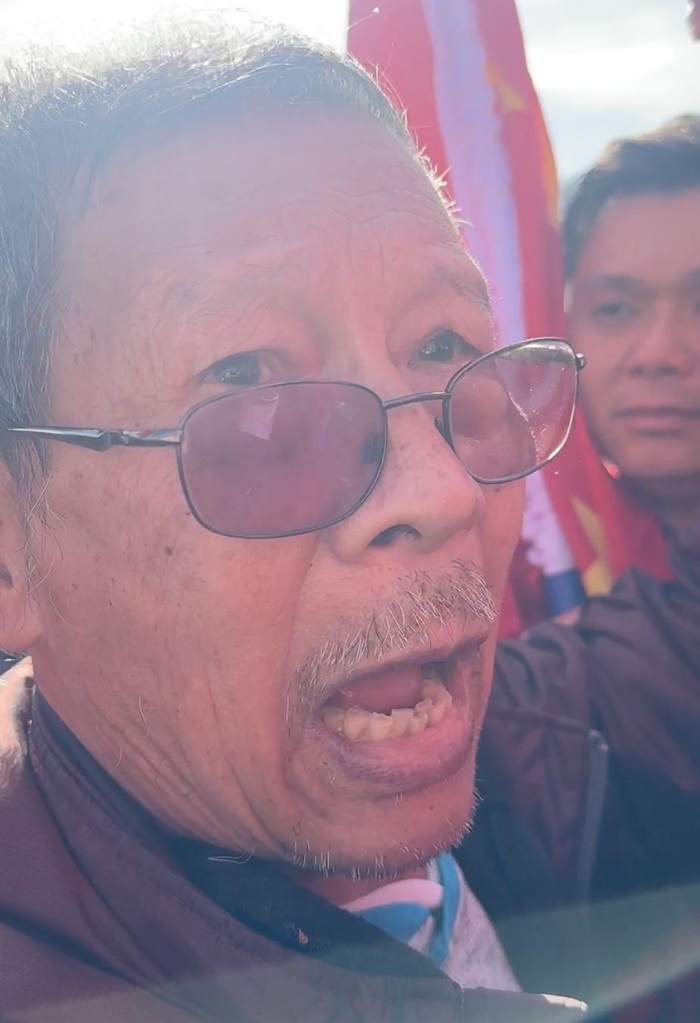
Sonamtso, a member of the Board of Directors of Students for a Free Tibet and SFT’s police liaison at the airport, was pushed so hard that she fell into a passing wagon.235
On the bridge, Chemi Lhamo was pushed by Chinese women from both sides. She grabbed the railing. They covered her with their PRC flags and yelled at her.236
A large security guard wearing a black suit and who was affiliated with the CCP supporters stationed himself on the bridge and told people who could cross and who could not. He would not let Pema Doma cross the bridge to get to Chemi Lhamo and yelled aggressively at her. There were three to four guards on the bridge protecting the CCP supporters and two to three others standing nearby.237 All of these security guards wore the same pin that denoted their affiliation with the Critical Synthesis security firm.
Chemi Lhamo called Pema Doma on the phone and asked if Pema Doma wanted her to leave the bridge. Pema Doma told her, “Only if you don’t feel safe.” Chemi said, “I want to stay here.”
Chemi Lhamo reported that at least three CCP supporters told her to leave. Another told her she wasn’t supposed to be there. The woman next to Chemi Lhamo had a flagpole and kept stabbing Chemi Lhamo’s left hand and arm with it while Chemi Lhamo continued to hold on to the bridge railing. One security guard told her to leave. Chemi Lhamo told him it was public property. The guard said it was better for her to leave. Chemi Lhamo said she wasn’t leaving.
More and more people arrived. There was no space. Chemi Lhamo was surrounded by people with PRC flags. She was elbowed in the breast and rib cage. She began to feel crushed. A woman behind her was screaming. The paint on the railing of the bridge was scratched off by a woman who was grinding a flagpole against it, and it was because of this scraped area that Chemi Lhamo was able to gauge just how much the woman had encroached on her space. Men came and told her to leave. Chemi Lhamo said, “You guys stole my country; I’m not going to leave.”
The CCP supporters put a big banner in front of Chemi Lhamo. By then, she could not be seen from any angle—she was covered by flags behind her as well. She was pushed and shoved. She stood her ground. She could see Tibetans “three layers away” trying to get to her. She told them she was okay and would stay until she was no longer safe. But they couldn’t see her, and she could no longer see anyone else. She kept shouting that she was okay. The woman next to Chemi Lhamo disappeared; her place was taken by male CCP supporters.
Chen Wenshen, the bald man who had been present at many other incidents in the previous days, was there (see video above from 00:20).

Yu Yingqiang, who had attacked Chow Kai-hong on the 15th near the Hyatt Regency and acted as a scout, was also present (see video above at 00:30).

The video gives a sense of just how crowded the bridge was, how much jostling was going on, and how little could be seen even at close range.
Another familiar united front figure who appeared in the scrum on the bridge was Jennifer Cheung (see above at Moscone Center on November 16 and below in relation to the case of attack on reporter S.).
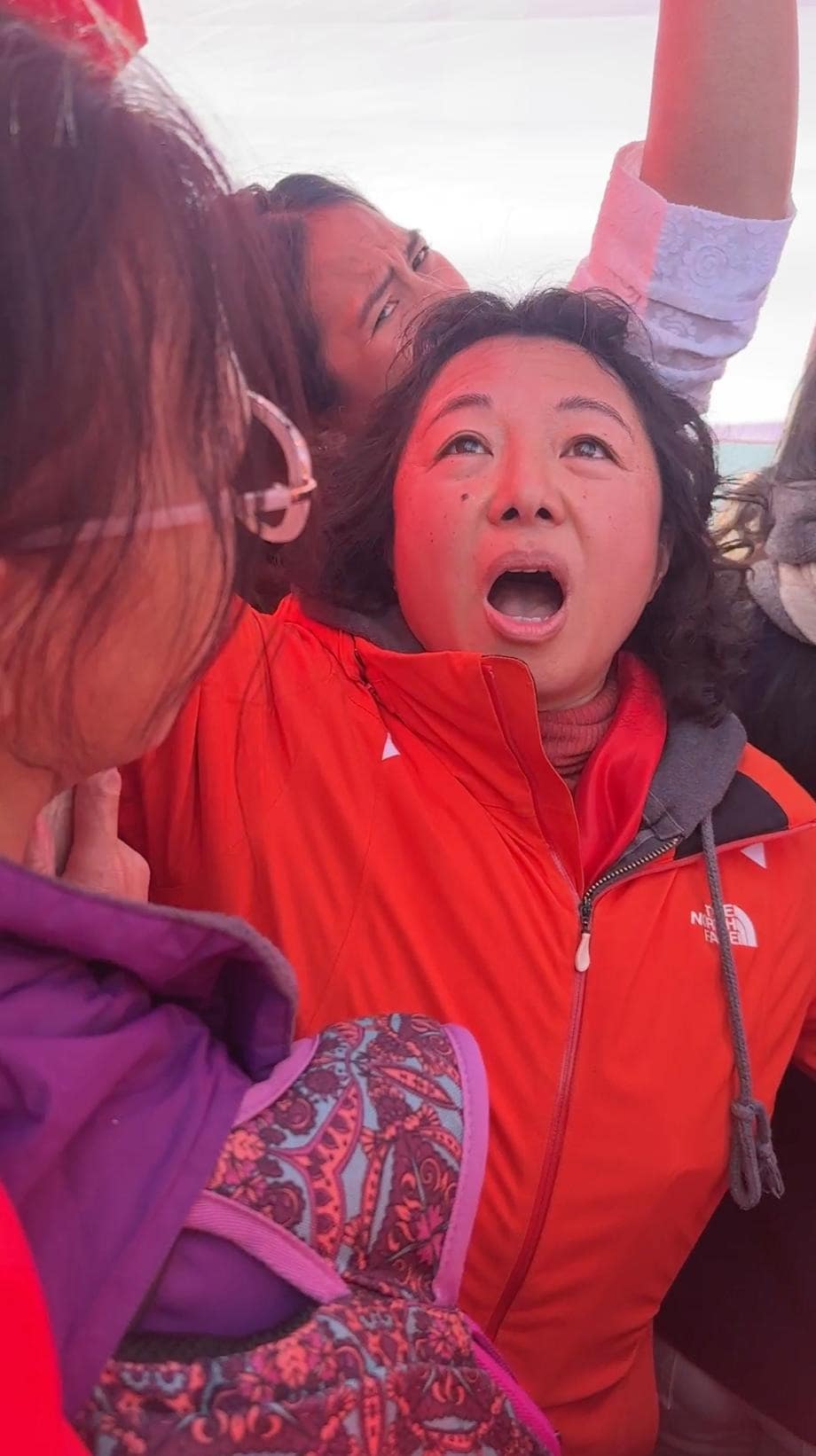
In the photo above, Chemi Lhamo can be seen directly behind Cheung.
At this point, Chemi Lhamo thought it was starting to get dangerous. She used her phone to keep the CCP supporters away from her since she knew they didn’t want to be filmed. Chen Wenshen smiled at Chemi Lhamo and gave her the peace sign. She felt chills down her spine.
Someone knocked her phone out of her hands. It fell over the bridge and landed in a muddy area. Chemi Lhamo could see it. Though she asked some other Tibetans to retrieve it, they couldn’t, and she was later told by a witness that a CCP supporter had gone down there and thrown the phone —a brand new iPhone 15 Pro—into the water.
To recap: Chemi Lhamo had had her phone stolen; she was being shoved; she was entirely surrounded and covered by PRC flags; she was repeatedly stabbed by a flagpole; she was being kneed in the legs; and male CCP supporters kept telling her to leave.
A security guard tried to hold a hand between Chemi Lhamo and the woman who kept stabbing her in the arm and hand. Chemi Lhamo held his arm for protection, but he couldn’t insert his body between them, only his arm. He started getting pushed. A second security guard came to help him. She reported, “I thanked the first [man] who said he’d make sure I was all right.”
Then the police came. An officer told Chemi Lhamo the situation was getting out of hand and ordered her to step away and come talk to him. Chemi replied that she could talk to him from where she stood. The officer asked Chemi Lhamo if she was willing to move. She said no. He said she needed to move. She insisted she had a right to be there and that it was public property, and then she reported that she was being attacked. The officer left.
At this point, around 10 a.m., Hong Kong protesters arrived. They tried to cross the bridge. They noticed Chemi Lhamo was in distress and wanted to help her. As they were crossing the bridge, Carmen Lau, one of the Hong Kong protesters, had her hair pulled. Another, Kennedy Wong, was pushed twice. He fell to the ground and injured his ankle.238
Carmen Lau came away from the encounter with bruises on her legs.
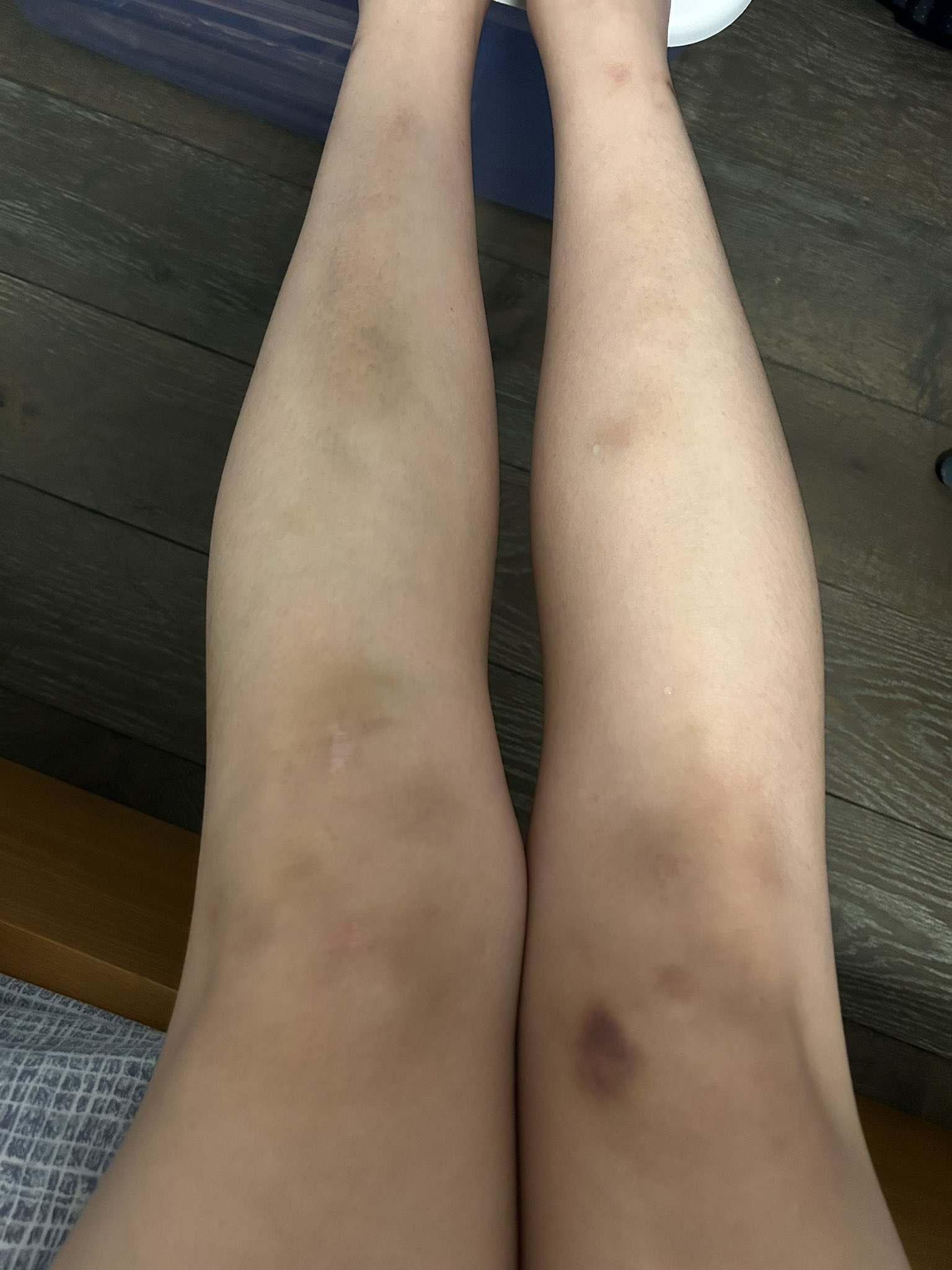
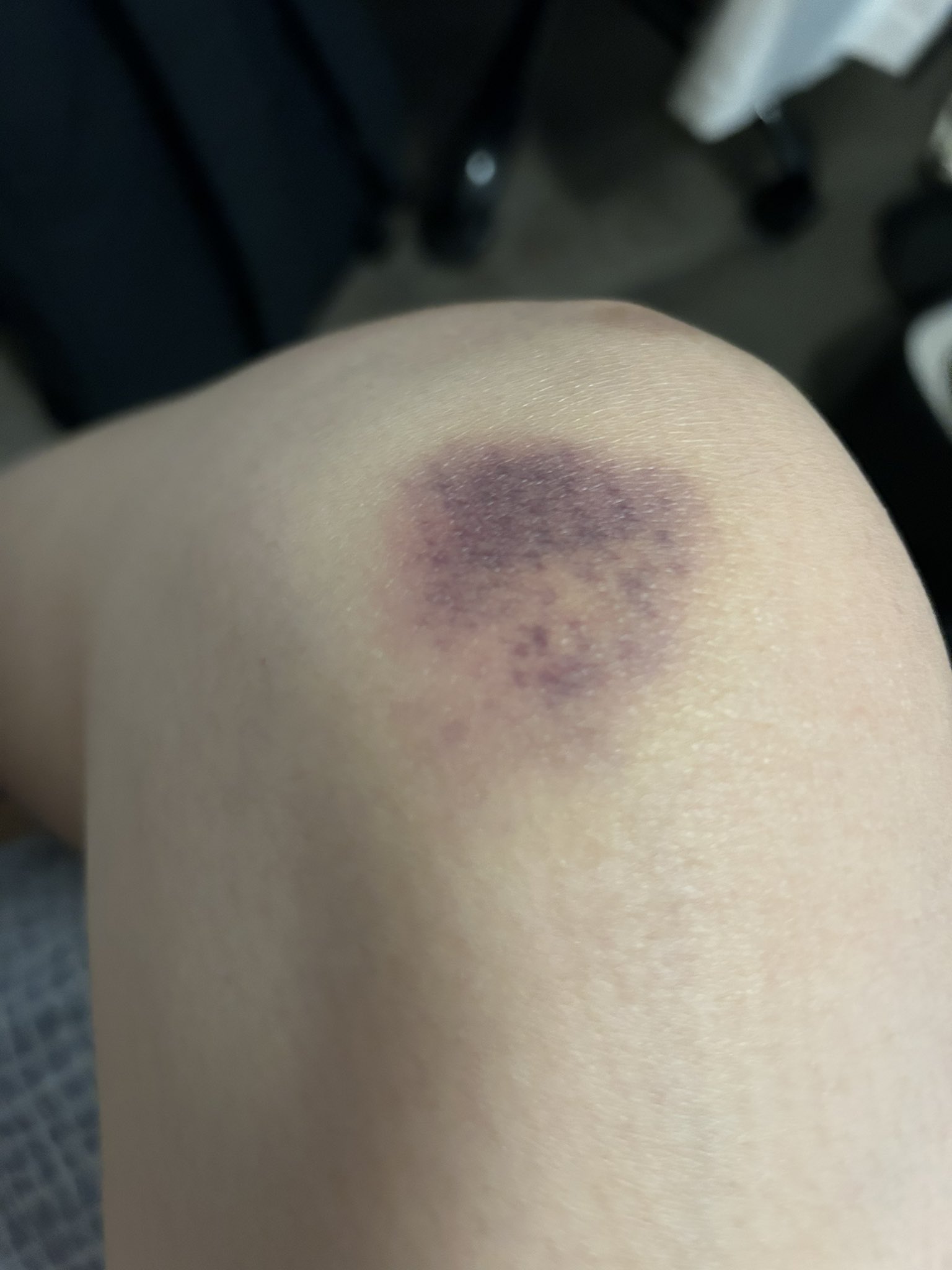
The photos of the injuries give an idea of how rough things were.
In the meantime, Tibetan protesters had managed to find more helpful police and were liaising with them. Eventually, the officers said that a separate protest zone could be created and that the protesters could go there. When one protester informed Chemi Lhamo of that, she thought it was a good time to leave. Due to the chaos and violence, protest organizers requested that police provide her with an escort, but the organizers were told that police had already offered that once, and, since it had been her choice to stay, they wouldn’t go back in there for her again.
Chemi Lhamo said she hadn’t realized how dangerous it would be to attempt to exit the bridge area. She told the CCP supporters to make space. They said they would, but the moment she let go of the railing, her hair was pulled very hard, and she felt hard punches on the back of her head. A nearby Tibetan held out his hand. She grabbed hold of it, and he pulled her away. As another woman in a purple jacket pulled Chemi Lhamo’s hair, she tried to push her away while continuing to feel punches. Looking up, Chemi Lhamo saw flagpoles hitting her. The punches kept coming from different directions. The Tibetan held his arm around Chemi Lhamo’s head to shield it from the blows. That was the first time, she said, that she felt safe, though she was still being punched in the body. The Tibetan man pulled Chemi Lhamo out of the crowd. She said that if it hadn’t been for him, she wouldn’t be alive. She said it was mostly men who hit her while the women pushed her and pulled her hair.
Afterwards, she had marks on her left elbow and wrist from being stabbed by the flagpole. Because she was mostly hit on the top and sides of her head, she didn’t notice any bruises.
By the end of the assault on Chemi Lhamo, many police had arrived. The Hong Kong and Tibetan protesters were able to move to the protest zone created by the police. Some Chinese protesters also joined them there. After that, the CCP supporters were not allowed to enter the designated protest area, though they continued to take photos of the protesters with telephoto lenses and others, who appeared more thuggish, taunted protesters from a distance.
Assault on Two Tibetan Youths
At one point, a sobbing Tibetan woman tried to leave the protest zone together with her teenage daughter. The police raised their batons and told her to back up. Pema Doma asked the police to put away their batons. The police lowered them but did not put them away. The woman’s teenage son had called her to say he and his teenage cousin were getting attacked nearby on his way to the protest . She was trying to reach them.
Pema Doma asked the police to go and help the young men. The police said they wouldn’t break their formation unless it was a life-threatening injury. Pema Doma told them that two teenagers were being attacked by adults. She asked if they could call for backup. The police said there was no backup available. Pema Doma told the mothers of the young men who were being beaten to call 911. The police told them not to. Pema Doma insisted they needed police. The police told her they were police. “But you’re not doing anything,” she said. Eventually, the police allowed an older Tibetan man to exit the protest zone to search for the young men.
The two Tibetan youths were both 19 years old. They had been in school that day and had not planned to go to the protest, but one of them received a call from one of the Tibetans at the airport who told him that someone was trying to hit his mother. That was when the two decided to go to the airport. They arrived around noon. As they approached, they were stopped at the infamous bridge where Chemi Lhamo and the others had been assaulted. A woman recognized by one of the young men from a previous day’s protest had recognized him as well and alerted other CCP supporters to the young men’s presence. All the young men wished to do was to go and meet the other Tibetans in the protest zone. About 20 people blocked the two Tibetan men at the mouth of the bridge. Ten to 15 others were standing off to the side. Both of the young men took out their cameras and began filming the situation “for our safety,” as one put it. One of the Tibetan youths was standing behind the other. One of the CCP supporters tried to punch the youth who was in back, but he ducked the punch. Another knocked the phone out of his hand.239 The video below shows what the youth had been filming when the CCP supporter knocked the phone out of his hand.
According to the interview with one of the Tibetan youths, moments before the phone was knocked out of the other’s hand, the CCP supporters had put up their flags to block views of the incident and had begun to play loud music. Then a CCP supporter tried to hit the Tibetan youth in the front and missed. Other CCP supporters grabbed his jacket, and he lost his balance and fell over, dropping his phone. From the ground, he could see it in the middle of the walkway. A woman was jumping up and down on it. He got up to retrieve it. The other Tibetan youth also tried to get the phone. CCP supporters hit him with sticks. The first Tibetan youth went to the aid of his companion. CCP supporters pulled his hoodie over his face. He felt them trying to pick him up. He swung wildly so as to keep them at bay and felt many punches. The other youth said that the attackers tried to throw him over the bridge and into the water below. He grabbed onto a tree to prevent that from happening. One of the youths estimates that, in all, there were about 50 people attacking them, more or less 25 on each of them. Three security guards on the bridge stood and watched the attack, but another security guard, dressed in a black suit, intervened. Then other security guards arrived and the CCP supporters scattered. The Tibetan youth whose phone was smashed managed to retrieve it; the other Tibetan youth noticed his phone was gone but didn’t know what had happened to it.
The security guards brought the two youths to the police not far from the designated protest zone. The youths told the police what had happened and said they wanted to file a police report. Protest organizers had called for an ambulance and also requested that a police report be filed.240 The police asked the youths to tell them what happened and gave them a case number. One of the youths saw the CCP supporters taunting them and making faces at them from a distance. The two pointed out to the police the CCP supporters who had attacked them. The police went over to the CCP supporters. The youths couldn’t see what then occurred but were later told by someone who did see that the police made the suspects take off their masks and took photos of them.
The youth who had lost his phone during the attack was able to locate it via the ‘Find My’ GPS tracker app from a linked device. He told the police where it was and asked for their help, but the police told him they couldn’t take him to its location due to safety concerns. Instead, they insisted that he fill out a form. The youth said he could show the police exactly where the phone was right then. The police repeated that he had to fill out a form. The police later allowed a protest organizer to cross over to the area with a police escort to search for the phone, but it was nowhere to be seen. It was likely in someone’s bag or pocket, not lying on the ground. Later, the phone disappeared from the tracker.
In the ambulance, the paramedics examined the youths, checking blood levels and eyes and asking questions to make sure they were thinking clearly. They recommended that the youths go to the hospital for further examination, but the youths declined. The police refused to escort the young men to the designated protest area, instead dropping them off a block away, where they were immediately confronted by about seven CCP supporters. They crossed the street and were followed by the CCP supporters. They crossed the street again and asked police for help, saying they had just been attacked. One of the officers told them it was because of their attitude and it was no wonder they had been attacked. It was then that Pema Doma and the mother of one of the youths arrived.
One of the youths said his ear was purple and he had scrapes from the concrete where he’d fallen down. The other had bruises on the right side of his head and the back of his head from being hit with poles and sticks. He was worried he might have a concussion, as he had minor headaches for some time after the attack. Both had facial injuries. The following photo was taken immediately after the assault.
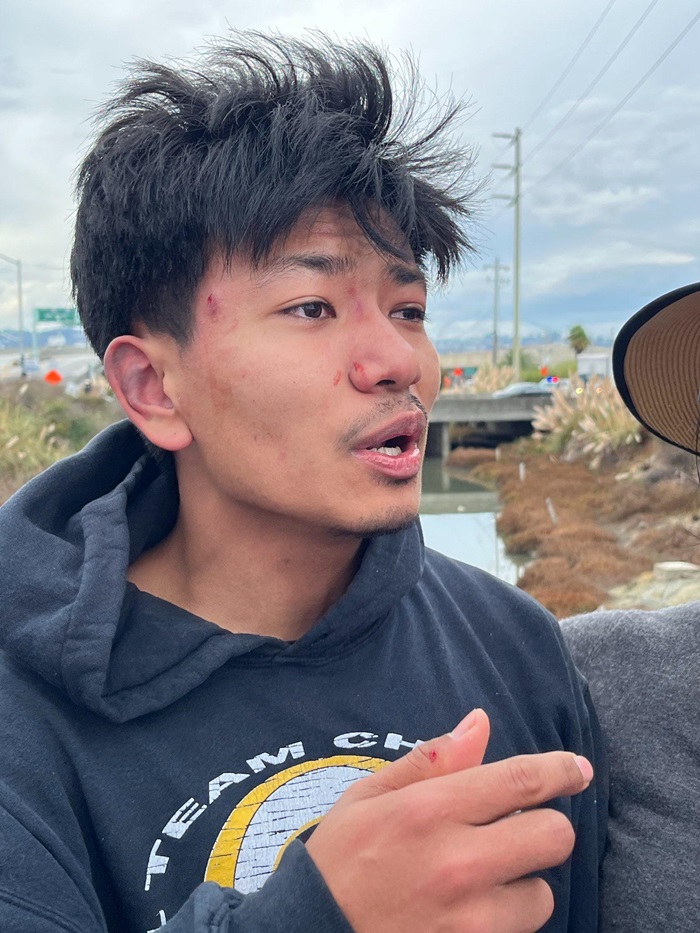
On their way home, the two Tibetan youths stopped at the hospital to be examined. The following photos were taken at Redwood City Medical Center at 3:45 p.m. on the same day.241
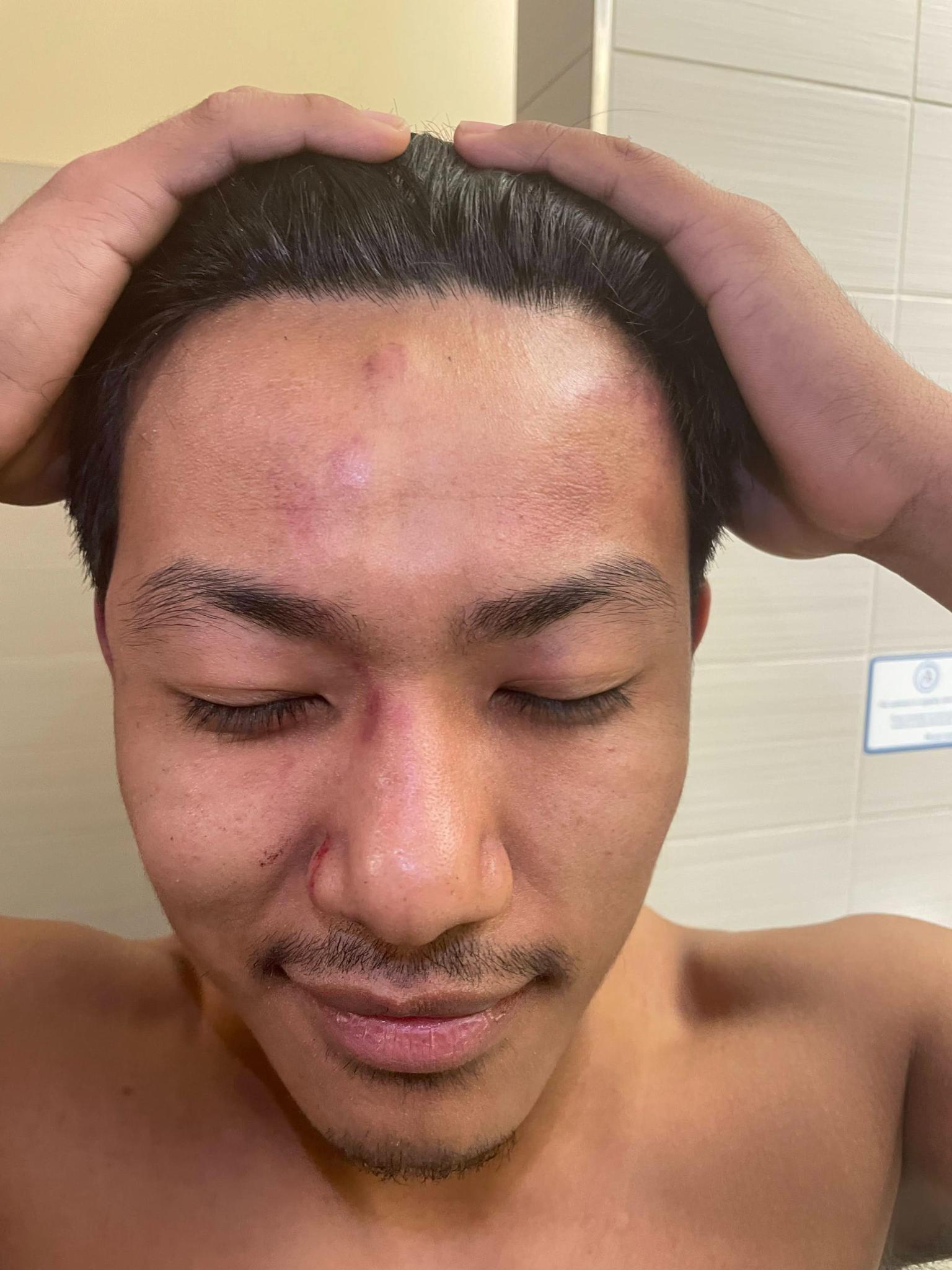
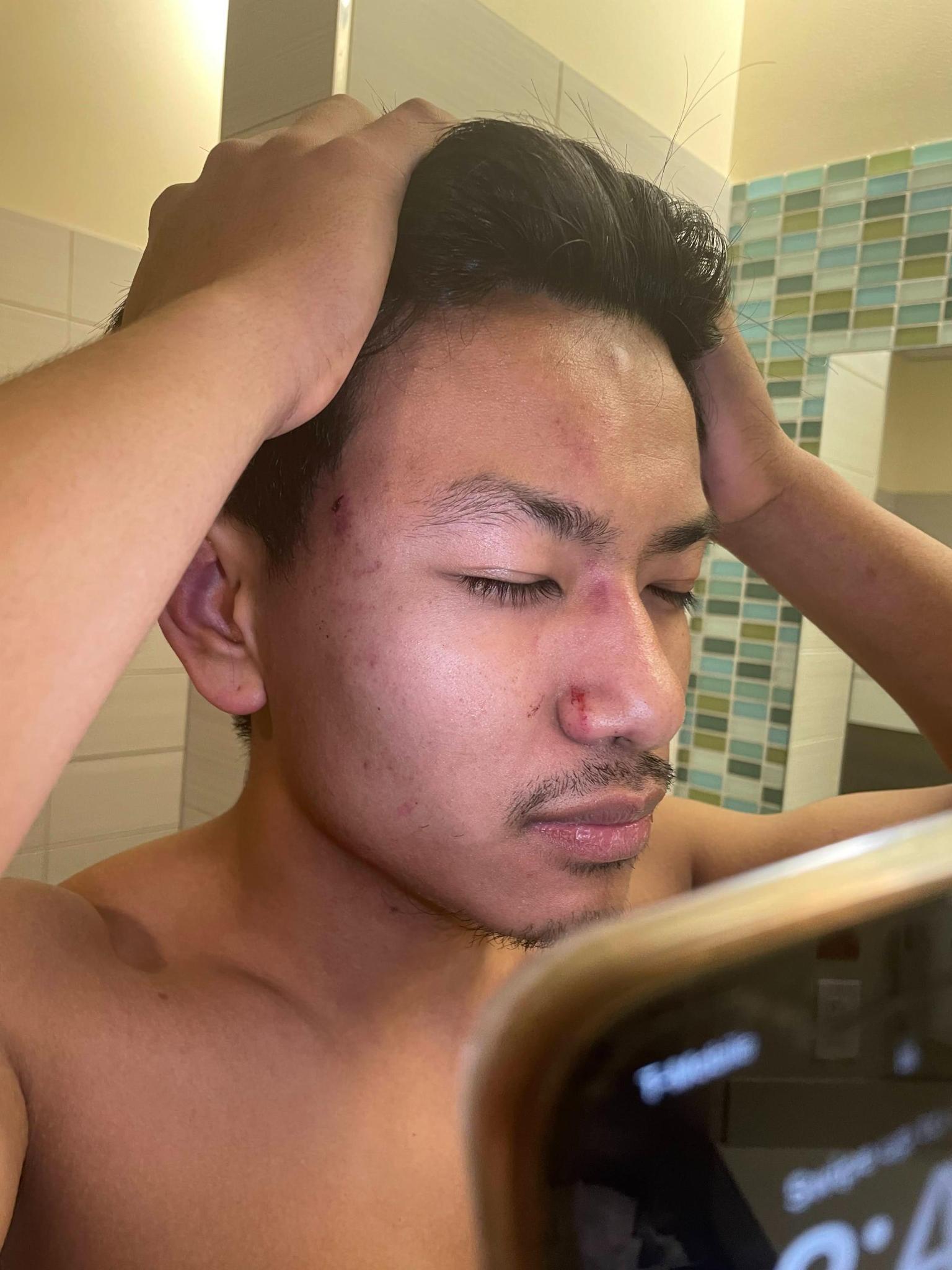
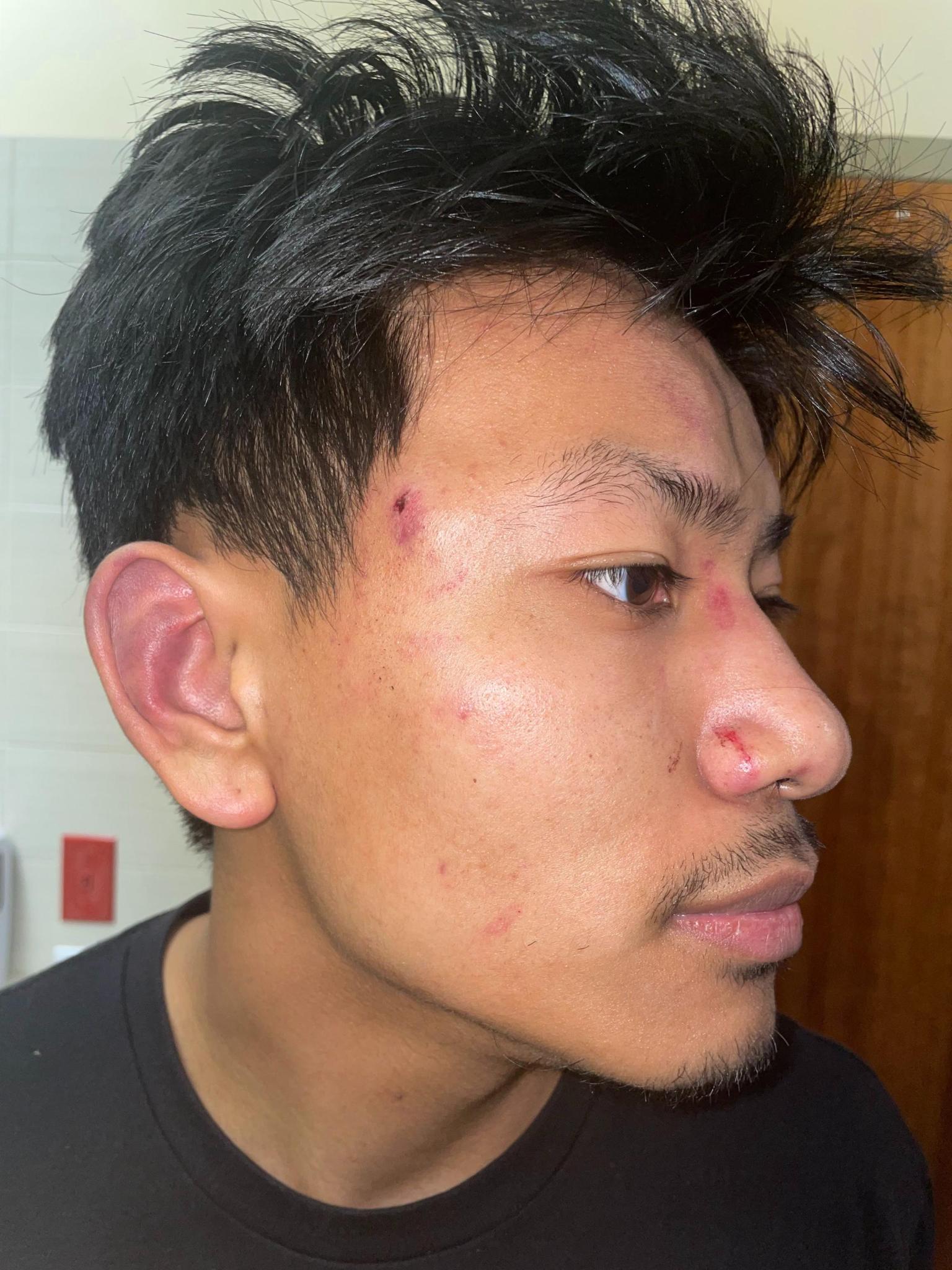
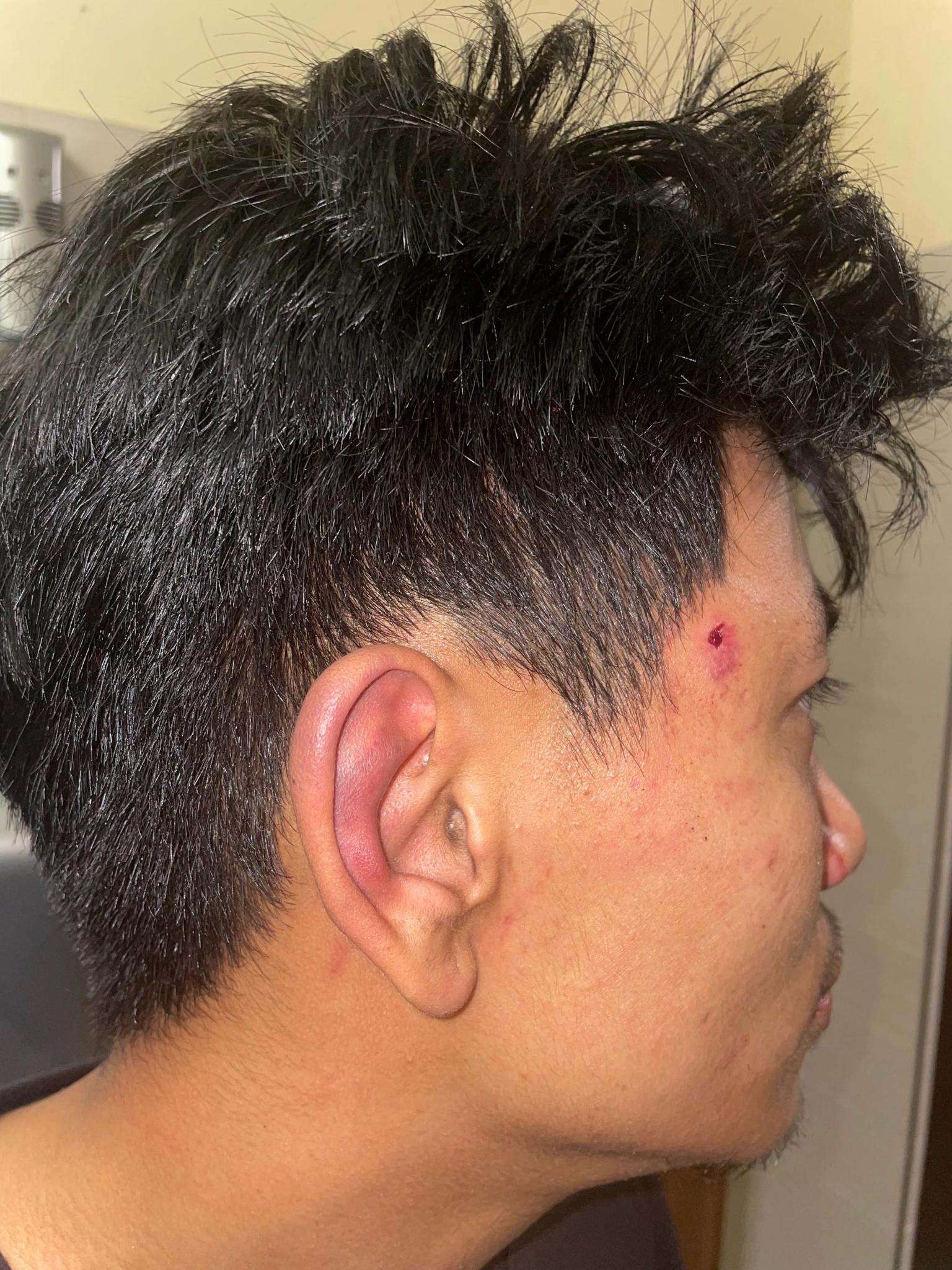
Sometime later, a detective contacted one of the youths and asked whether he wished to press charges. The detective said doing so would be really difficult. This made the youth feel disheartened and uncertain, so he didn’t follow up.242
After the assault, one of the Tibetan youths identified a man in this photo as among those who assaulted them.
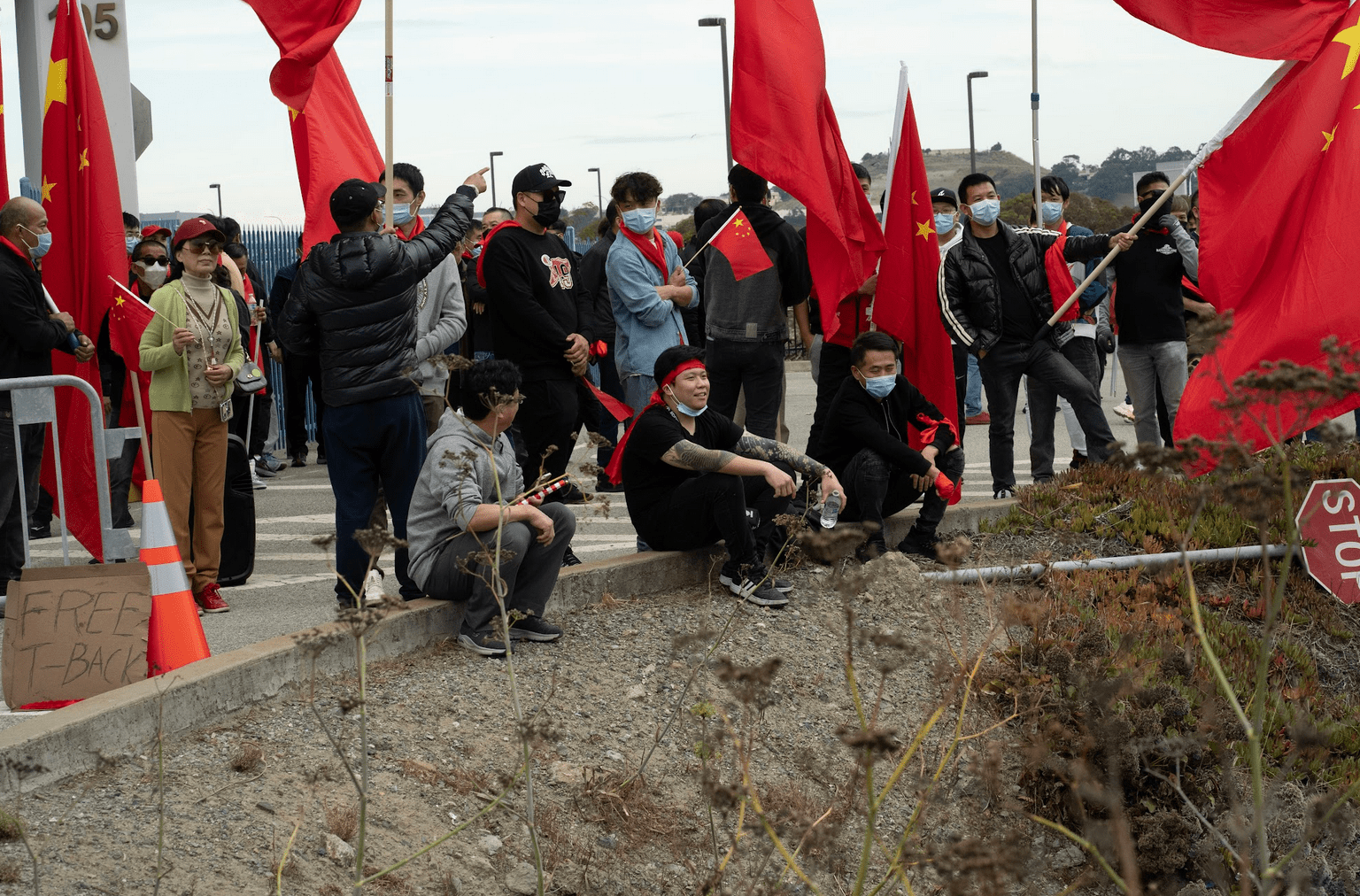
He identified the man in the middle sitting on the curb and wearing a red headband as one of his assailants. The man can be seen in the video above that was taken on the phone that had been whacked from one of the Tibetans’ hands, and also in this still from that video.
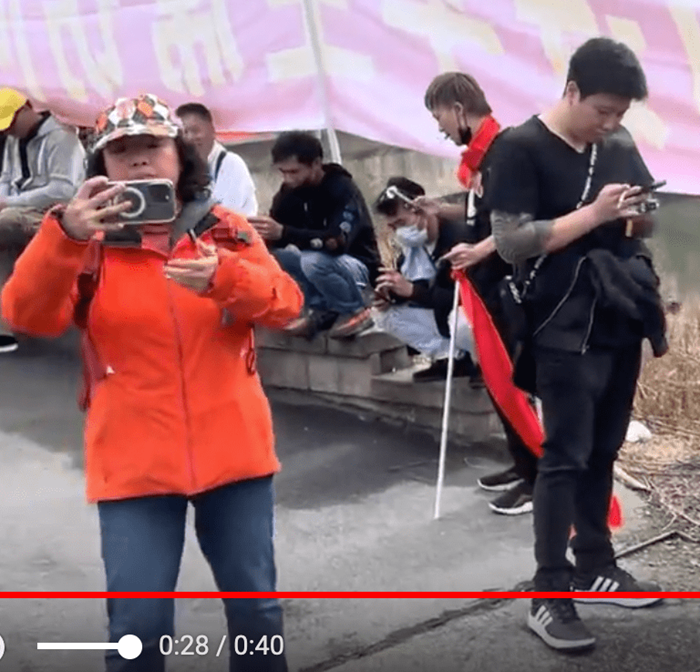
That man would later be identified as having been involved in the theft of a phone from a reporter and in one of the most violent assaults that occurred over the four days of Xi Jinping’s visit to San Francisco. He can be seen in the photo below standing next to others accused of participating in that assault…
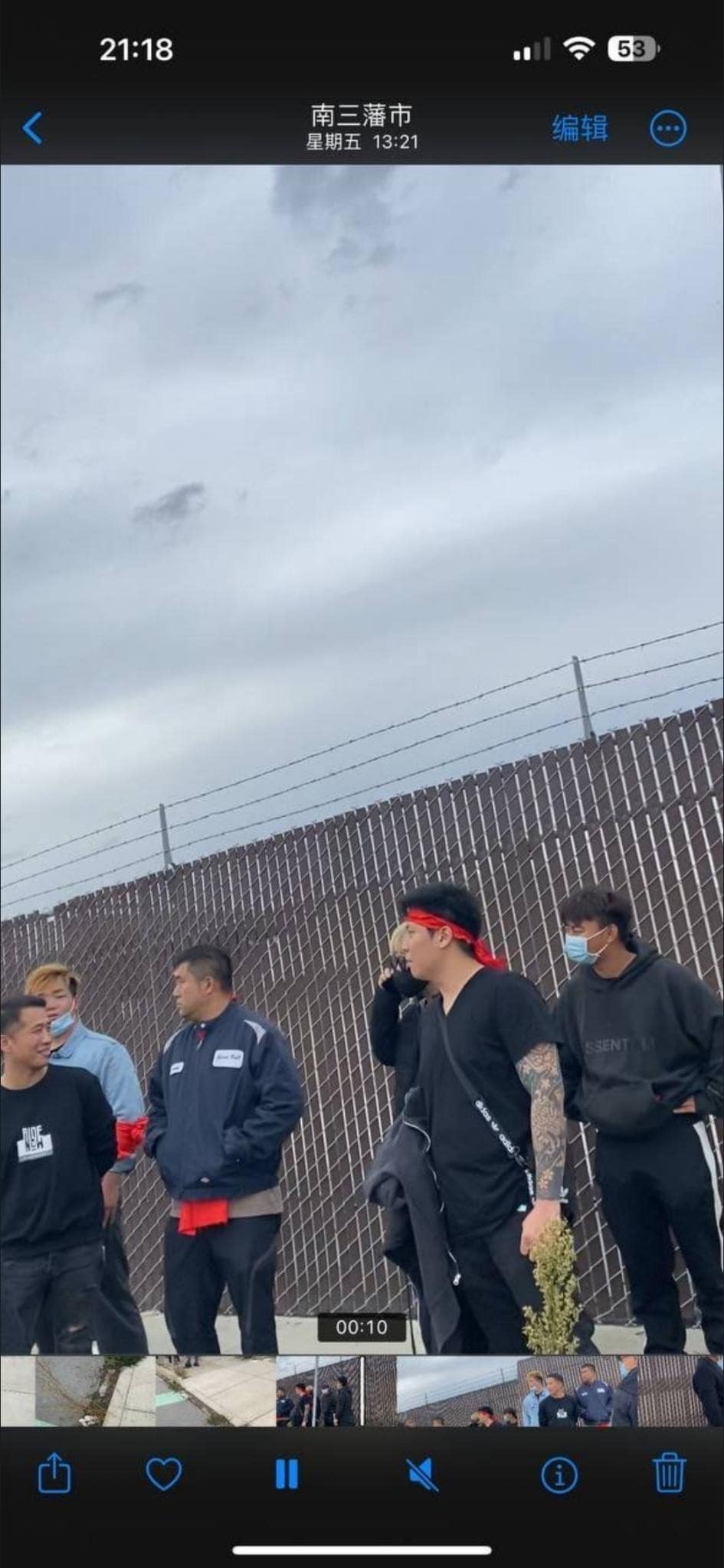
…and in this still in the act of beating up Kaiyu Zhang.
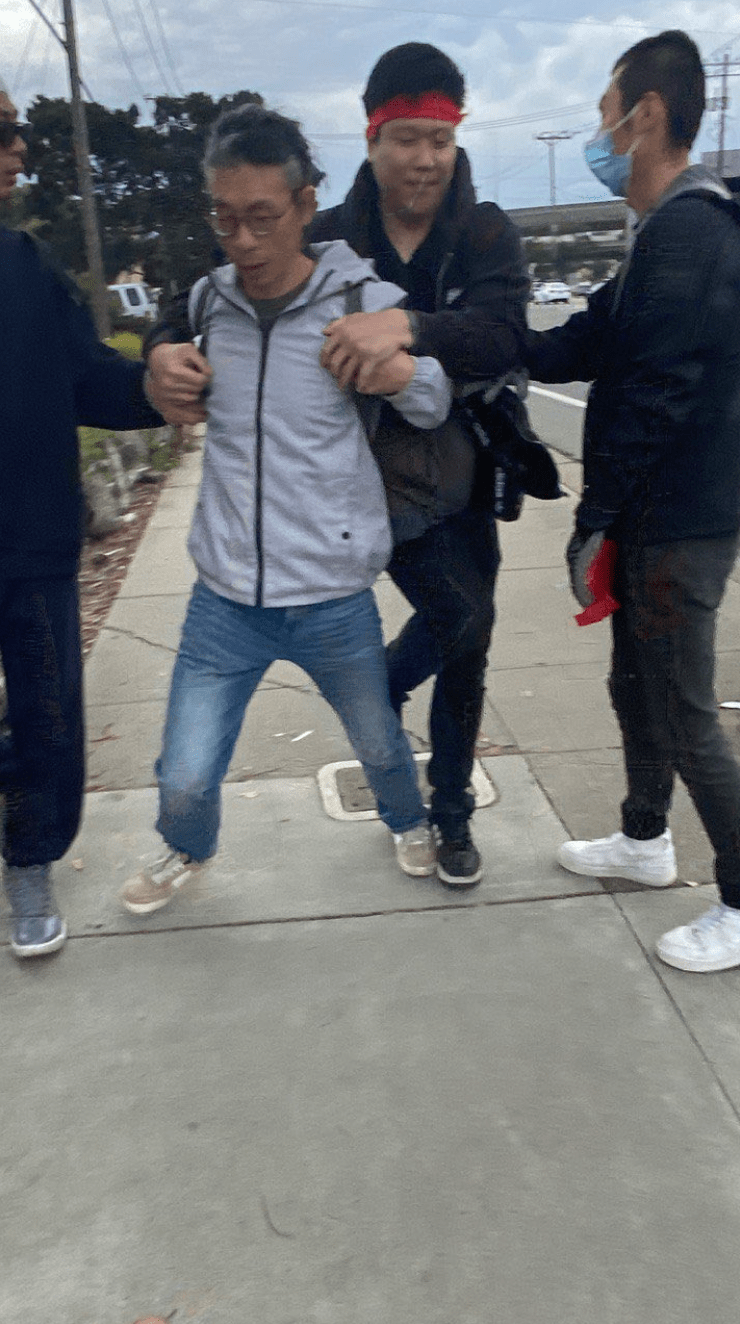
The man was also among the group that stalked Tibetan protesters after the end of the protest outside the Hyatt Regency on the 15th. The following photo is a still from the video that appears above in the description of that incident. He was wearing the same Adidas shoulder bag as he wore on the 17th in the photo above.
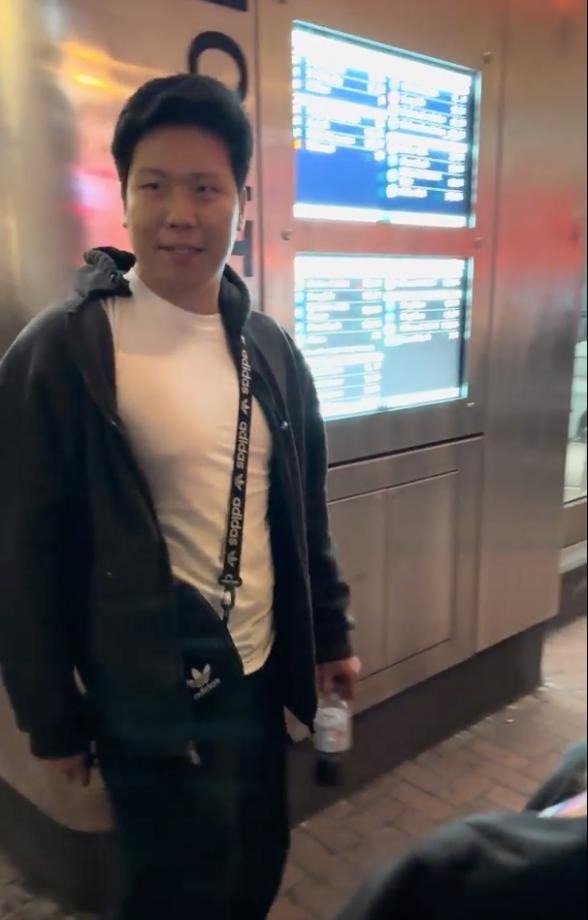
Theft of Reporter’s Phone
Only a short time after the attack on the two Tibetan youths, reporter S. from the television station KTSF Channel 26 was attempting to find CCP supporters to interview as part of a report he was working on for the station. He reported that an “auntie,” who was herself a CCP supporter, suggested that he film in a particular area where the CCP supporters were. He took her advice and went over there. He was almost immediately surrounded and held, and his phone was taken. This happened between 1:06 and 1:08 p.m. The CCP supporters demanded to know what he was filming. He tried to get his phone back, but it was thrown into the water. He was wearing a press pass and had clearly identified himself as a news reporter. He ran away from them and fell down. He believed his life was threatened. A police officer on the scene assisted him and instructed him to visit the police station when the protest was over.
He then went to the “auntie” who had suggested he film there and said, “You told me to interview your people. Now look what they’ve done.” She apologized and said it was an accident and that they were on high alert because “people on your side have infiltrated our side.” S. responded that such behavior was unacceptable and couldn’t be tolerated in the United States. She then gave him her telephone number, told him her name was Jennifer, and suggested that compensation could be discussed, perhaps later that afternoon.
He went to the San Francisco Police Department Airport Bureau to file a report, but waited for over an hour without receiving assistance. He eventually submitted a report online. He noted in his report to the police that he believed the incident constituted transnational repression and a violation of press freedom.243
The woman who identified herself as Jennifer was Jennifer Cheung or Chung (張藍真/張蘭真; sometimes referred to as Zhang Lanzhen in Pinyin).
She had appeared at the scene of the assault on several Chinese protesters the day before, the 16th, as well as on the bridge near the airport where Chemi Lhamo had been assaulted earlier on the 17th (see above).
As already noted, she is chair of the Rape of Nanking Redress Coalition (南京大屠殺索賠聯盟) and President of the Global Alliance for Preserving the History of WWII in Asia (世界抗日戰爭史實維護聯合會; the literal translation is the “Global Alliance for Safeguarding the Historical Truth of the Anti-Japan War”). She has also participated in the activities of the Alliance for China’s Peaceful Unification; in activities carried out by the united front group, the Hong Kong and Macau Fellowship Association of Shenzhen; and, together with Chen Longkui (陳隆魁) and Chen Zhaojin (陳兆進), two united front figures involved in attacks on protesters in San Francisco, in activities carried out by the Federation of Returned Overseas Chinese Limited (see above).244 In 2020, she participated in the Bay Area Association for Peaceful Unification of China’s online ceremony to celebrate the 71st anniversary of the PRC, singing a patriotic song as a member of the chorus.245 In 2022, she held a commemoration of the Nanjing Massacre attended by Zhang Jianmin, Consul General of the PRC consulate of San Francisco.246 And, in 2023, she held another commemoration of the Nanjing Massacre, this one attended by Zou Yonghong, the Deputy Consul General of the PRC consulate of San Francisco.247
Retired San Francisco judge Julie Tang (鄧孟詩) attended both of the ceremonies celebrating the 71st anniversary of the PRC and commemorating the Nanjing Massacre. She was also present among CCP supporters at the airport on November 17, where, in an interview given to pro-CCP media, she thanked Xi Jinping for improving US-China relations and encouraged Chinese in the US to unite and promote win-win situations.248 In 1997, along with Lillian Sing, another retired San Francisco judge, Julie Tang co-founded the Rape of Nanking Redress Coalition—the group now led by Jennifer Chung.249 Julie Tang also co-founded Pivot to Peace250 and allies with US anti-war activists such as No Cold War and Code Pink in campaigning for a softer stance from the US government on China. Jennifer Cheung and Julie Tang work together on campaigns for Korean Comfort Women. They are often seen together with Lillian Sing. Lillian Sing and Julie Tang are on the advisory board of Comfort Women Action for Redress and Education.251 At one of their events, the three figures, Jennifer Chung, Julie Tang, and Lilian Sing can be seen sitting next to one another.252
He Konghua (何孔華) is yet another united front leader from the Bay Area who was present at the airport on the 17th. She was identified by protesters as an apparent organizer or leader.
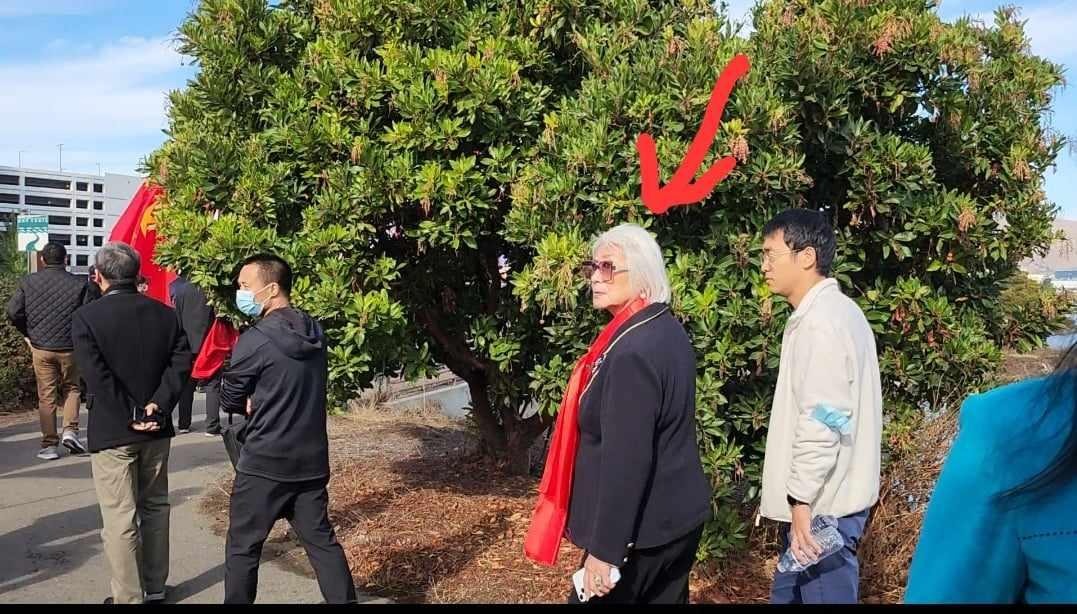
He Konghua has been reported to be president of the North California Beijing Association (北京同鄉會會長)253, executive chair of the San Francisco, South Bay, and Silicon Valley National Day Committee (舊金山南灣矽谷國慶委員會執行主席),254 and an overseas member of the All-China Federation of Returned Overseas Chinese (中國僑聯海外委員), the top-level united front group in the PRC.255 In September 2022, she hosted an event in Santa Clara, California, to celebrate the 73rd anniversary of the PRC. That same month, Zou Yonghong, Deputy Consul General of the PRC consulate in San Francisco, presented He with a congratulatory certificate.256 In February 2023, she participated in an event in San Francisco’s Chinatown with Zhang Jianmin, Consul General of the PRC consulate in San Francisco (中國駐舊金山總領事張建敏).257
On April 6, 2023, holding a loudspeaker and leading chants, she was prominent in a pro-CCP protest against the visit of then-president of Taiwan Tsai Ing-wen to southern California. In the following photo, she can be seen together at the protest with several united front figures identified in this report, including, on the left,Chen Zhaojin (holding a white phone), Rong Junwu ( wearing his white jacket), Guo Jingwei (in the background), and, on the right, Jing Dongsheng (in a gray suit). Covered by the PRC flag that Rong Junwu is holding is Yang Baohai, yet another united front figure who appeared in multiple locations in San Francisco.
At a certain point toward the end of the afternoon, a CCP supporter attempted to cross a police barricade and invade the protest zone.259 He was thrown to the ground by police, handcuffed, and led away. He was the only CCP supporter that protesters ever saw being taken into police custody.
When the protesters left the designated protest zone at the end of the protest in the late afternoon, they had to negotiate with police to provide an escort to take them past the CCP supporters. Tibetans who had gone out of the protest area reported to the other protesters that they’d seen CCP supporters holding poles lined up along the road. Some suspected they were planning to launch an attack on protesters as they left.260 The police initially said they wouldn’t help the protesters to leave, but then some of them agreed to do so.
The protesters lined up in rows of two to be escorted away. CCP supporters lined the road along which the protesters passed. Some acted in a threatening manner, and some followed the protesters. According to Sonamtso, the fear level was high.261 Seasoned protester Topjor Tsultrim said it was scary.262 Protesters could see men they recognized as attackers lining the route.
Once the group of protesters escorted by the police arrived at the Costco parking lot, they split up. Hong Kong protesters Anna Kwok, Alex Chow, and Carmen Lau, and Tibetan protester Pema Doma were followed by three masked men as they tried to get to the rendezvous point for their ride. Anna Kwok asked nearby police officers to stay with them until their ride arrived. She asked in English, but a police officer responded in Cantonese. He asked where the stalkers were and said he didn’t see them. The other police officers walked away. Then the Cantonese-speaking police officer saw the masked men, but he insisted that nothing like what Anna was implying could happen in America. He said he would go talk to them. When he came back, he said he could stop them for a while and told the protesters to keep walking, suggesting they go to the McDonald’s two blocks away. They started walking toward the McDonald’s. After they had gone one block, the police let the three men following them go. The Hong Kong protesters were able to meet their ride before reaching the McDonald’s. As their ride passed the McDonald’s to which the police officer had directed them, they saw that the franchise was thronged by CCP supporters. Fifteen seconds after their ride had left, another Tibetan protester, who was on the phone with Pema Doma, witnessed at least a dozen aggressive CCP supporters with poles show up at the McDonald’s.263
Assault on Kaiyu Zhang
The vigilance of the protesters in leaving the protest area proved sadly justified. One of the most brutal assaults of the day, indeed of the several days of Xi Jinping’s visit to San Francisco, occurred near the Costco parking lot where many of the protesters had parked their vehicles. The victims were Chinese protester Kaiyu Zhang and 74-year-old Hong Kong protester Chow Kai-hong, who was also assaulted on the 15th near the Hyatt Regency (see above). Of the two, it was Kaiyu Zhang who was beaten far worse. Li Delong, who was assaulted on the 16th, was accompanying Kaiyu Zhang and Chow Kai-hong. Ironically, when they were attacked, they were on their way to the police station to file reports about the assaults they had endured on previous days.
According to Kaiyu Zhang, “When we were halfway to the Costco parking lot, we saw a dozen young Chinese men who blocked the entire sidewalk in front of us. They were standing there gazing around, wearing red headbands or with red scarves in their jackets.
“We instantly knew we were in danger, as we had heard of many cases of assault during APEC, including Chow Baak’s and Li Delong’s.
“We tried to keep as far away as possible from them when we passed, but the entire group of young men started following us at an intimidatingly close distance and repeatedly insulted us: ‘Fuck Hong Kongers! Fuck you old shits.’ I realized we were being targeted because they heard Chow Baak and me speaking Cantonese with one another…. I thought our right to free speech was protected by the Constitution and we should not be intimidated by CCP supporters on American soil, so I responded, ‘Fuck the CCP, fuck Xi Jinping.’….
“Meanwhile, I saw another group of young men, also wearing red scarves, heading toward us. It all happened so fast after that. I was tackled from behind. I was pinned down. I only recall these men above me beating me violently. I lost consciousness in no time. When I regained consciousness, I found myself lying on the grass. A woman nearby was calling the police. It took a long time before a police officer arrived. Chow Baak and I were sent to the hospital soon after. I was in [the] ER until 2 a.m. the following day.”266
This is how Kaiyu Zhang looked after the attack:
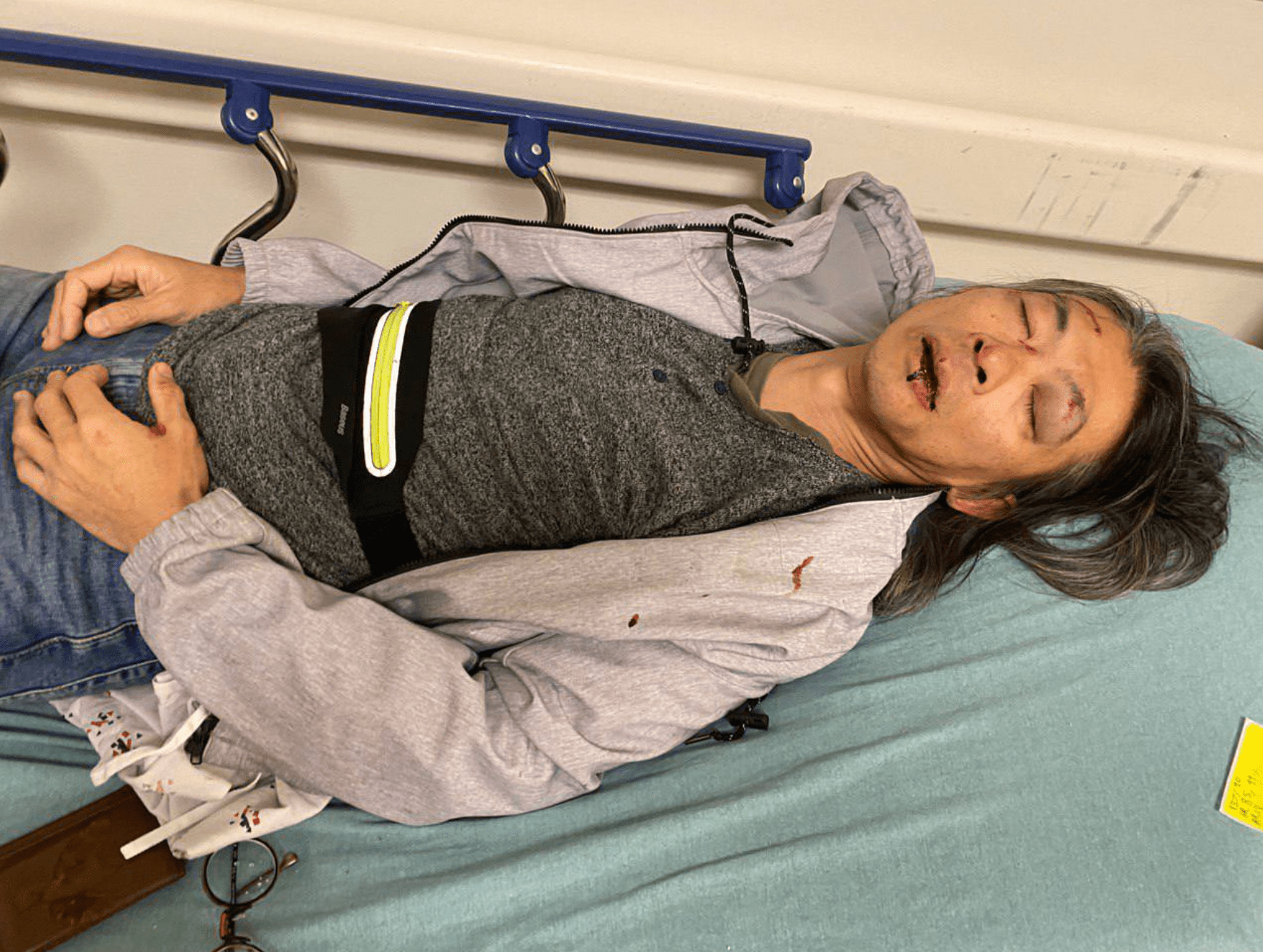
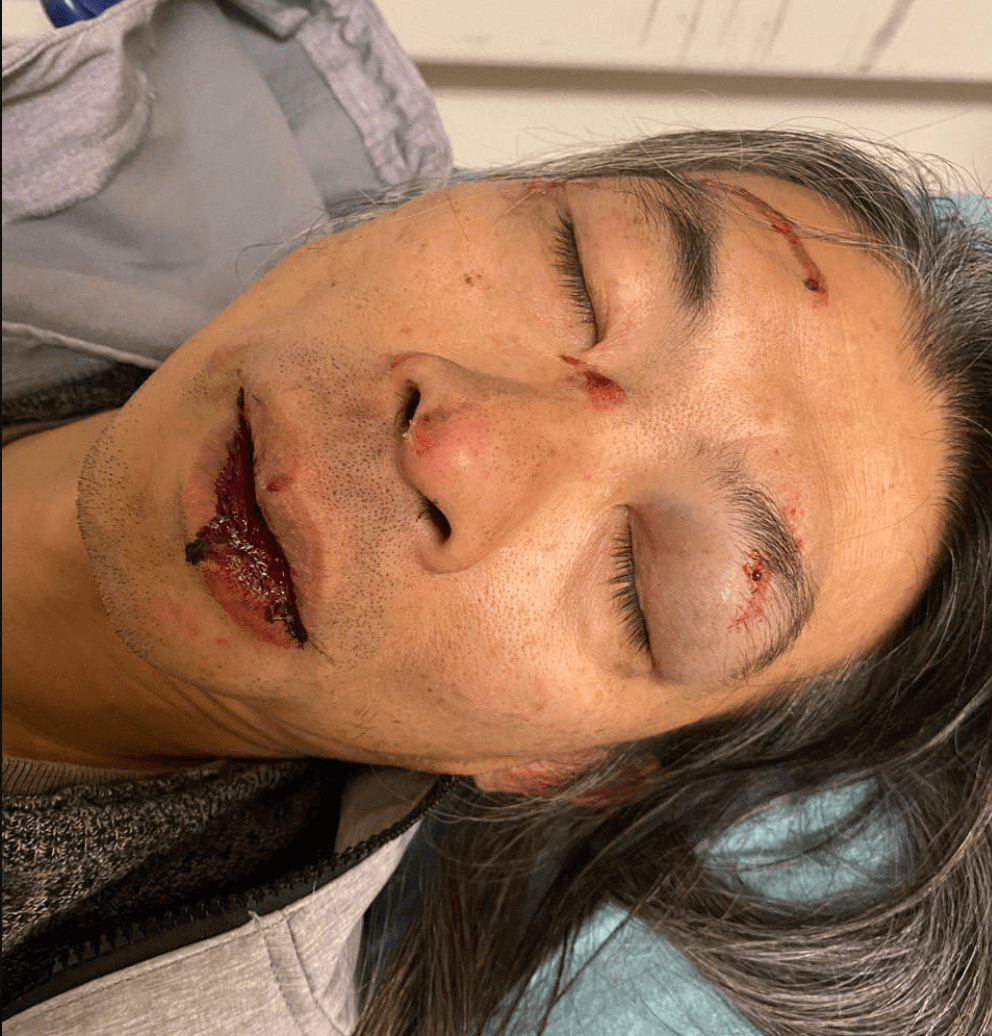
This is Kaiyu Zhang giving his name to the police directly after the assault:
This shows Kaiyu Zhang being brought to the ambulance after the attack. According to the time on the tweet, 2:47 p.m., this occurred 45 minutes to one hour after the assault.
These are photos of the people identified as his assailants:
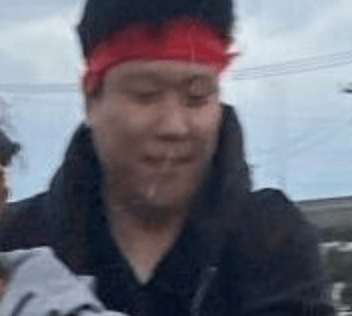
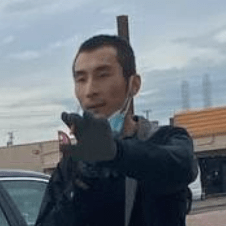
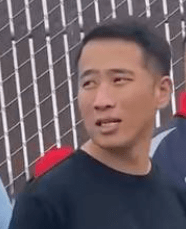
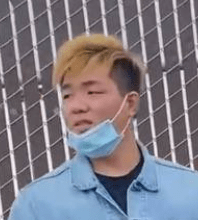
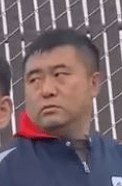
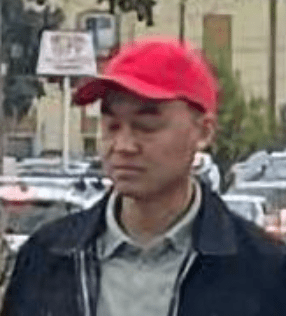
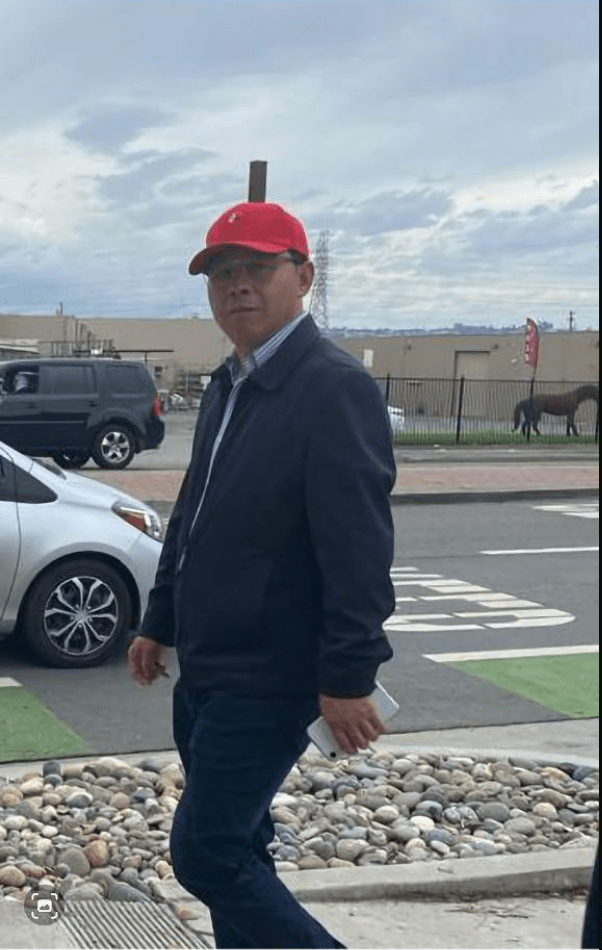
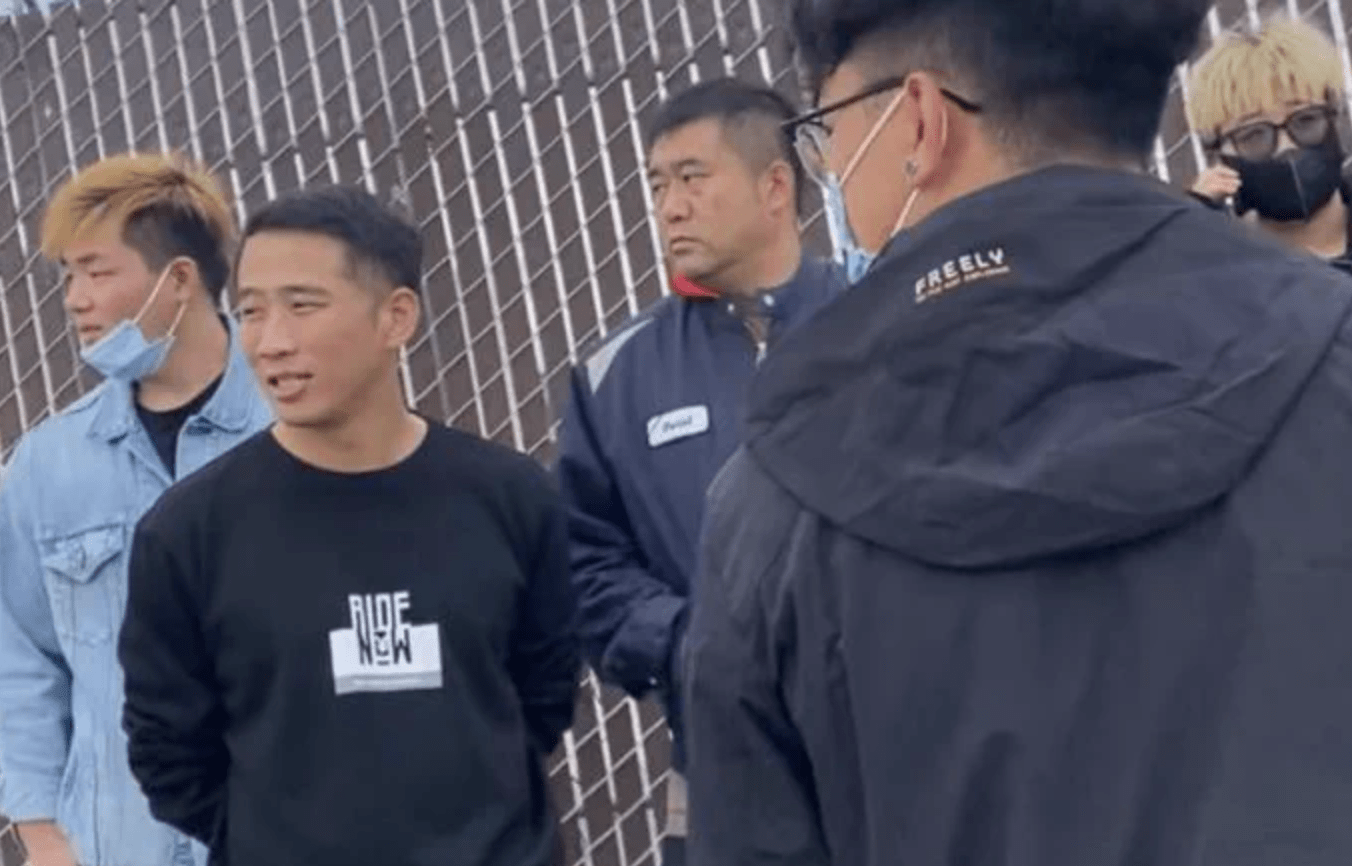
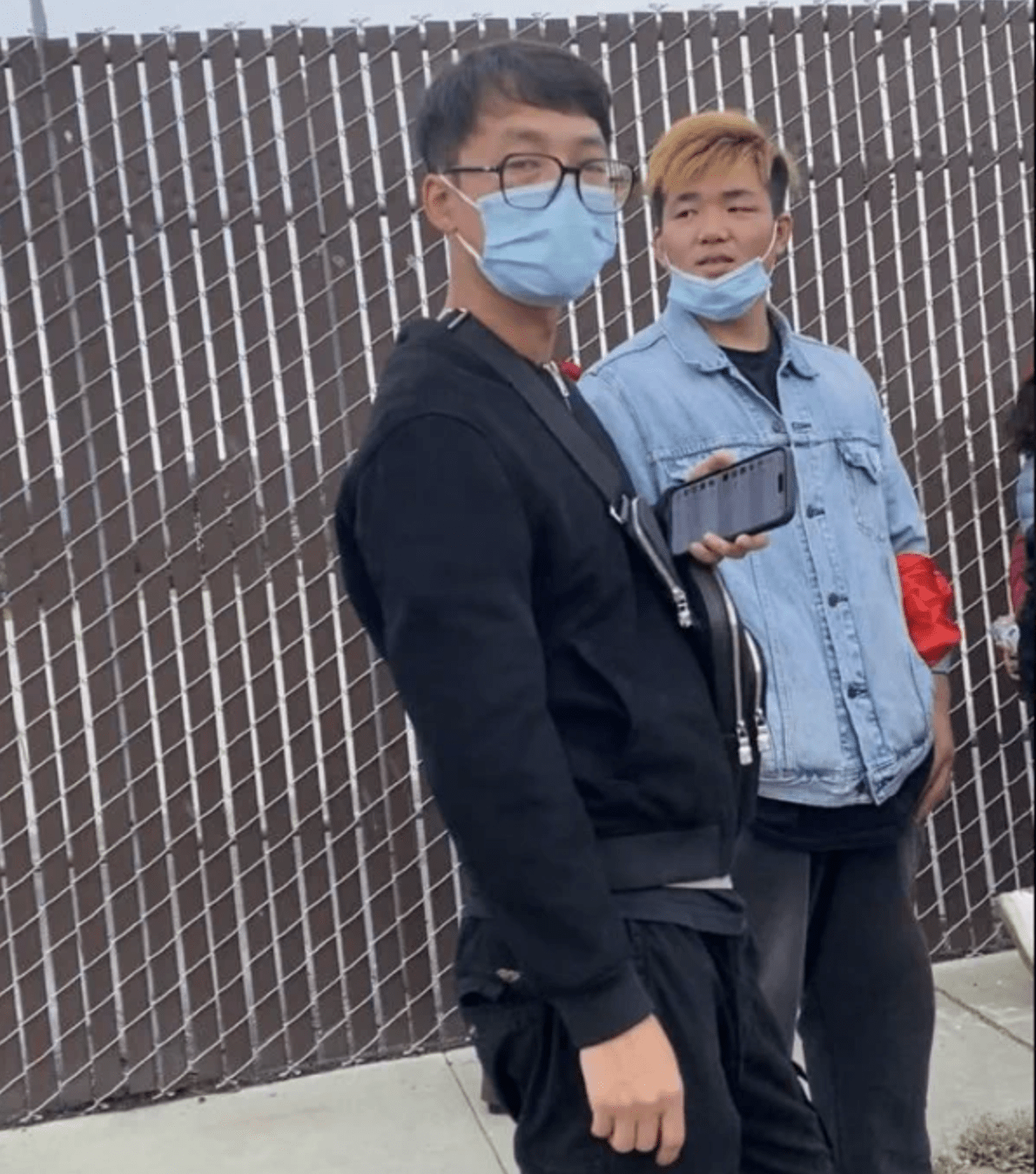
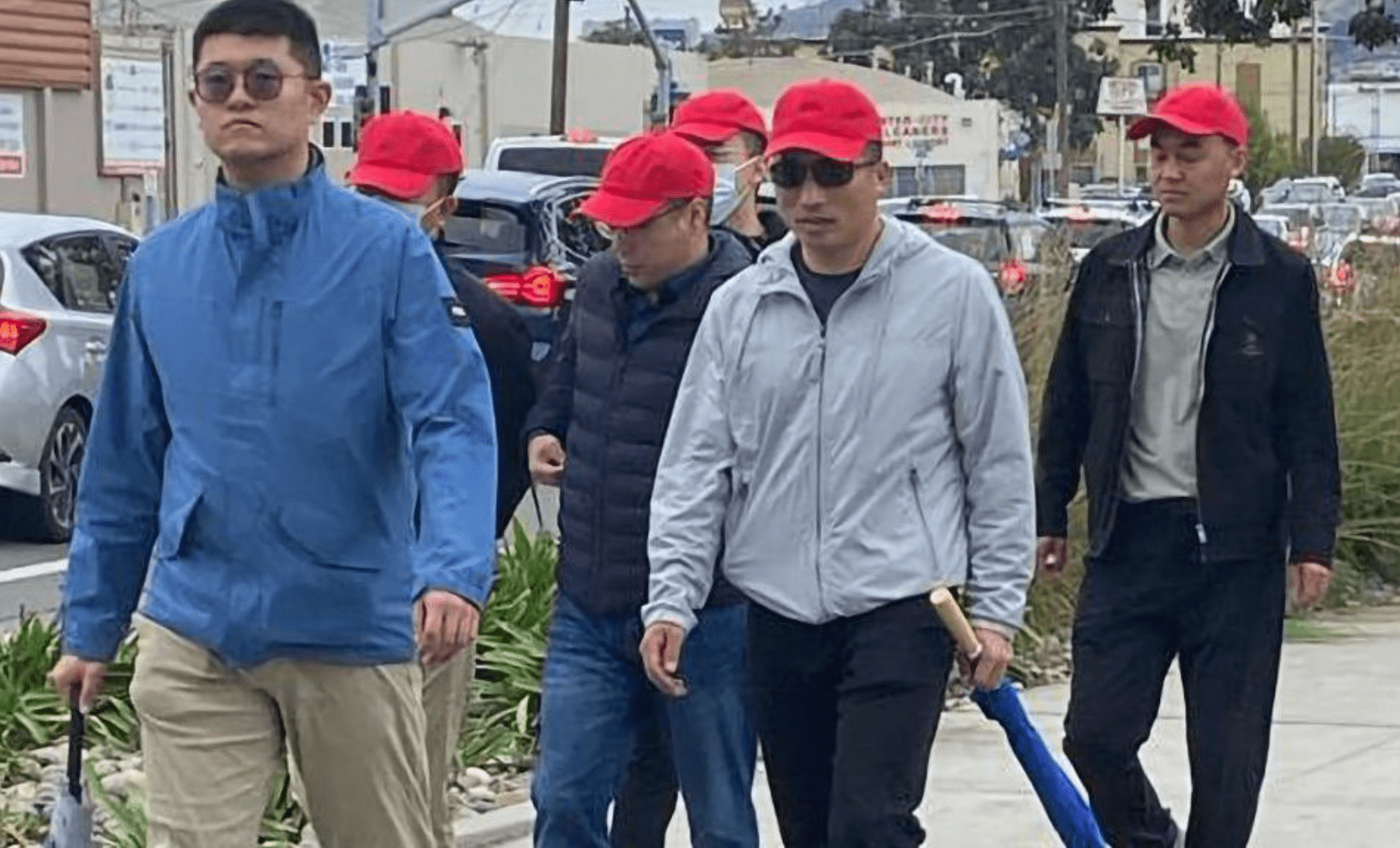
Kaiyu Zhang continues: “Almost every one of the assailants was caught on video. The police were given the footage on the same day as the assault. Two days later, on November 19, an officer told me that, in spite of all their efforts, the police had been unable to identify any of the assailants. I then shared the footage on social media, seeking help and support. Many people who sympathized with me helped to spread the footage. An anonymous tipster informed me of the identity of one of the assailants. I phoned my contact officer and provided this information then emailed him at 3:18 p.m. on November 24, but since then, I haven’t been able to reach him by email or phone. On November 29, I called a press conference in front of the South San Francisco police station to pressure the police to make progress on my case. AP, Fox News, NBC, VOA, Radio Free Asia, Epoch Times and KTSF reported on it.269 My contact officer was not on duty that day. Another officer was assigned to handle my case but he knew nothing about it. As of December 10, I have heard nothing from the police…. I escaped from Shanghai to the US in March 2023. I believed I was secure and had utter protection to voice my opinions in the US. I was a peaceful protester…. Since the assault, I have been suffering from serious headaches, nightmares, pain in my eye, and horrible ringing in my ears. I’ve become afraid of going outside because I fear CCP agents may track me down and attack me again… I don’t feel safe anymore, even in the US, which was unthinkable before the assault.”270
Kaiyu Zhang said he was interviewed for about an hour by the FBI. As of May 15, 2024, the South San Francisco Police Department has not responded to our query regarding the status of its investigation.
That was the last reported assault during Xi Jinping’s visit to San Francisco. He would depart from San Francisco International Airport later that day.
Reactions and Responses
The harassment and intimidation of and assaults on protesters against Xi Jinping and the Chinese Communist Party during Xi’s visit to San Francisco elicited a variety of reactions and responses from protesters, members of Congress, and the PRC embassy, though it elicited silence from other institutions and politicians. Below, a few of those reactions are highlighted.
Some protesters spoke of the physical and psychological effects the attacks had on them.
A Chinese protester who initially spoke out publicly about the assault on him said: I am suffering from deep depression. Things are not going well with me. My best friend, whom I knew for 20 years and who is a US citizen, began distancing himself from me after I spoke out publicly. I seem to be a plague that can endanger anyone close to me. Now I have to cut off all my friends and connections from my past, including my family. Suddenly all my past becomes irrelevant, which is devastating. This is what happens in the Chinese community, at least in my experience. The Chinese people are just so scared of the CCP, even when they are living in the US.271
Students for a Free Tibet Campaigns Director Chemi Lhamo said: I didn’t get a chance to go to a doctor. I felt mildly concussed. I was light-headed; I couldn’t eat much; it was hard to rest. This lasted for weeks. My health since APEC has deteriorated so much. Prior to that, I was very fit and rarely had a cold. Since APEC, I have been sick and had a long-lasting cough. The cough is so bad, it makes me purge and vomit. I got an x-ray of my chest. This is all new to me. I’m sure there’s been a psychological impact. Before APEC, I’d experienced long-arm tactics of the CCP. But the level of violence we experienced in San Francisco was the actualization of fear. The CCP’s been emboldened so much by the inaction and complacency of the US and the rest of the world. Now they no longer just intimidate but actually turn violent. In the past, I’ve been targeted for being Tibetan. Tibetan identity was the target. They couldn’t stand a Tibetan taking up public space and attention. I received death threats and threats of violence. In San Francisco, I actually experienced the violence. This has only confirmed what I warned the American and Canadian governments about in 2019. I feel ever more committed to the movement.272
Many protesters had observations regarding law enforcement. From their point of view, law enforcement authorities often appeared unprepared, did not take action, took insufficient or belated action, or appeared unaware and indifferent, and sometimes even hostile and callous.
Hong Kong Democracy Council Executive Director Anna Kwok said: My perception of the United States being relatively safe for advocacy work on the CCP has changed. I saw and experienced moments that reminded me of the 2019 protests in Hong Kong. I saw protesters being beaten up while police officers stood only feet away. On the streets of San Francisco, we had to cover up our protest t-shirts and hide our signs, in case some CCP supporters and thugs walked by and decided to come after us. When I returned to DC to continue my advocacy work with Congress and the administration, it almost felt like a parallel universe from the streets of San Francisco, where violence seeped into every part of our brief stay. The system failed to respond and protect us despite prior warning from the threats we received. It gave me new perspectives on my advocacy on TNR.273
Exiled activist and former elected District Councillor in Hong Kong, Carmen Lau said: It was emotionally intense. It reminded me of being harassed and shadowed in Hong Kong.274 I saw parallels between the inadequate police response I encountered in San Francisco and the infamous “Yuen Long July 21” incident in Hong Kong during the 2019 mass protests when police failed to respond to citizens’ urgent calls for protection from pro-CCP thugs. The lack of protection in San Francisco made me realize that, even in the US, law enforcement might not only fail to safeguard individuals but might also inadvertently become a facilitator of TNR. There is an urgent need for proactive measures to address TNR, including, but not limited to, communication strategies to enhance awareness in society in general, specialized training for law enforcement to identify signs of TNR, and strengthened communication and engagement with affected diasporic communities.
In fact, many protesters who had recently sought refuge from repression in China, East Turkestan, Hong Kong or Tibet in the “land of the free” were dismayed to encounter, in a major US city, persecution and violence that reminded them of what they had experienced at home.
Students for a Free Tibet Grassroots Coordinator Tsela Zoksang said: I don’t have high expectations of law enforcement and what they are willing to do [to protect citizens and uphold the law]. But I thought, just to save their own backs, they would be more proactive. In the case of Chemi Lhamo, for example, they were so slow to respond. They weren’t really enforcing anything. They weren’t prepared for that level of escalation. I was surprised they were so hands-off once things escalated. Their response time was so slow. One cop who was approached twice said, “We’ll do everything in our power to protect people and enforce the law, but our hands are tied until something happens….” [The attacks in San Francisco] signaled China’s growing encroachment in democratic societies. The repression was evidently orchestrated; it wasn’t random or arbitrary. I expected pushback and aggression—that’s inevitable given the sheer CCP network of support. But I didn’t expect that level of aggression or orchestration and coordination or the length to which they were willing to go. In San Francisco, the CCP sought to target our young people. It reminded me of what they’re doing in Tibet: putting one million children in boarding schools. Of course, it’s far more repressive there, but the pattern is the same: attack children because they are the future. What the CCP had hoped was that the attacks in San Francisco would have a chilling effect. Their strategy was to frighten the parents who would see their children beaten and bruised—they wouldn’t want to send them out to protest anymore because it is too dangerous. But I think it had the opposite effect: people are more committed to resistance.275
Students for a Free Tibet Communications Coordinator Topjor Tsultrim said: A lot of the attacks targeted Tibetans. They seemed to be targeting young people. When protesters left the Hyatt Regency on the 15th, the thugs could have followed any of the groups, but they chose to follow the Tibetan young people. Their intention was to target our community, and our youth in particular, so as to deter us from protesting in the future. A lot of us were born in the US. We were shocked that China [could] act with impunity to stop us from protesting. We worry about the chilling effect on the Tibetan movement in exile, especially in the US. If the government can’t protect us, they’re just conceding ground to the Chinese government.
Sonamtso, member of the Board of Directors of Students for a Free Tibet and, at times, SFT’s police liaison during the protests in San Francisco, said: My gut feeling is that many individual police officers wanted to help us but something was stopping them. Some were supportive. Some were definitely not. There was no systemic support, just individual officers who were on the side of decency. If they were really serious about upholding the law, they would have arrested people and stationed officers strategically in locations so they could monitor. Most were either completely apathetic or perhaps ordered not to get involved. The reactions of Tibetans have been various. For some, the attacks and fear at APEC made their convictions stronger. But for some, it increased their awareness of the level of intimidation. Some of the people who were there in 2008 [at the Beijing Olympics global torch relay when it came through San Francisco] said, “We’ve never seen it get this bad.” Now everyone’s on their toes, everyone knows we have to take extra precautions to stay safe.276
One Tibetan teenager who protested said: [The whole experience] was very overwhelming. I knew this kind of thing happened in Tibet, but didn’t know it could happen to us on the streets of a city in the US. I was surprised the police didn’t intervene more strongly. I suspect the close relations between the governor [of California] and Xi Jinping meant the police were disinclined to get involved. Before the protests, I didn’t really understand the effect China [had] on the US and that it can still control things here. It impacted me personally. The experience was like a roller coaster. At first it was very intimidating. But the audacity of the CCP supporters motivated me and showed me we were doing the right thing. The fact that our protest was a cross-movement action [Chinese, Hong Kongers, Tibetans, and Uyghurs] gave me a sense of how widespread the oppression is everywhere the CCP controls. It felt great to stand hand in hand. Tursunay [the Uyghur camp survivor who was harassed and intimidated on November 14 at the airport—see above] was very motivating. She gave me a chance to reflect upon myself.277
A Tibetan teenager who sustained a deep cut in his arm from an attack by CCP supporters said: Every time I look down at my arm, I can’t believe that happened. There is still a faint mark from the cut. A lot of innocent people got dragged into the violence. The experience has increased my motivation to do activism. I want to go to every protest.278
The San Francisco Police Department has not commented in response to numerous requests for comment and information. On February 2, 2024, the authors of this report sent the SFPD a list of questions relating to the harassment and intimidation of and assaults on protesters against Xi Jinping in San Francisco during APEC as well as to SFPD policy and training on transnational repression. On February 23, an SFPD spokesperson responded, “Based on the information you provided, we are unable to locate any incident related to your request.” In response to that, on February 27, 2024, this report provided a detailed list of 10 victims of assault and/or phone theft who filed reports with the police, a list of other incidents in which no reports were filed but to which police officers responded on the scene, and a list of general questions in regard to SFPD policies and training on transnational repression. We informed the SFPD that, especially because of complaints we had received, we believed it was important to get its perspective and information. As of March 24, 2024, there has been no further response.279
At least two other law enforcement agencies were involved. The Chinese protester Kaiyu Zhang reported his assault to the South San Francisco Police Department. One of the Tibetan youths who was assaulted near the airport was apparently contacted by the San Mateo Sheriff’s Office. As of May 15, 2024, neither agency has responded to our queries regarding the status of their investigations into these assaults.
The Federal Bureau of Investigation, as a matter of policy, does not comment on any matter related to investigations. Three people interviewed for this report said they had spoken with the FBI and that the FBI had questioned them about what had happened to them in San Francisco.
To our knowledge, no San Francisco or California political leader has spoken publicly about the harassment and intimidation of and assaults on protesters. A few offices of political leaders representing California at the federal level are receptive to requests for meetings and welcome more information.
No agencies within the executive branch of government have said anything publicly about the harassment and intimidation of and assaults on protesters. President Biden met Xi Jinping in San Francisco, but the White House has not said anything. The Department of Justice has a strategy for countering nation-state threats and has received queries from members of Congress (see below) regarding what happened in San Francisco but has not responded publicly.
While the Department of State has spoken out strongly against the transnational repression directed against Hong Kongers for whom the Hong Kong national security police have put out arrest warrants and bounties, it did not say anything about the TNR in San Francisco. In fact, when the Hong Kong government announced a second round of arrest warrants and bounties targeting exiled Hong Kong activists, the State Department issued a strong rebuke on December 15, 2023, clearly labeling the act as a case of TNR.280 This was much appreciated by the Hong Kong community in the United States, but the Department of State did not take that opportunity to make any mention of the TNR in San Francisco.
It is the impression of some protesters that most political authorities at federal, state, and local levels appear most concerned with portraying APEC and the Biden-Xi meeting as generally positive and successful, and do not wish to acknowledge occurrences that may complicate that portrayal. Some also suspect that protection of exiles, activists, and protesters takes relatively low priority in relations with the PRC.
While the executive branch has been silent, the legislative has been quite vocal.
The Congressional-Executive Commission on China put out a statement on November 28, 2023 titled “Chairs Condemn Violence Against China Human Rights Advocates in the United States.” 281 On December 12, 2023, the CECC held a Press Conference to Highlight Victims of Violence and Harassment at the APEC Summit. Chairman Chris Smith spoke out strongly against CCP transnational repression in San Francisco and mentioned that he and Senator Merkley, CECC co-chair, have introduced the Transnational Repression Policy Act in both the House and Senate.282 The CECC invited four protesters from San Francisco—Pema Doma, Elfidar Iltebir, Anna Kwok and Kaiyu Zhang— to speak at the press conference, as well as HRIC Executive Director Zhou Fengsuo. On December 17, 2023, the CECC chairs sent a letter to the Attorney General seeking an investigation of violence during the APEC summit.283 On January 30, 2024, the Office of the Assistant Attorney General responded, acknowledging receipt of the CECC letter and stating, “Longstanding Department policy and practice prevent us from commenting on or confirming the existence of any pending investigations.”
The House Select Committee on the Strategic Competition between the United States and the Chinese Communist Party sent a letter to the Department of Justice on November 29, 2023, requesting “a briefing regarding the recent attacks on peaceful pro-democracy protesters at the APEC Summit and steps the DOJ is taking to ensure their safety at future protests as soon as possible but no later than December 13, 2023.”284 During Xi Jinping’s visit to San Francisco, the Select Committee also called out the hypocrisy of US business leaders holding a banquet for Xi Jinping at the Hyatt Regency Hotel on November 15 and wrote to the banquet’s hosts, U.S.-China Business Council and the National Committee on U.S.-China Relations, requesting a list of guests who paid to attend.285 The Select Committee also held a hearing on December 13, 2023 titled “CCP Transnational Repression: The Party’s Effort to Silence and Coerce Critics Overseas.”286 While the hearing was not in direct response to the APEC attacks and was wider in focus, one of the witnesses who testified was HKDC Executive Director Anna Kwok. Of the effects of CCP TNR on her—the arrest warrants and bounties coupled with the online threats she received before APEC—she said, “I’ve been walking around the United States with a huge target on my back. Even though I’m in the land of the free, I am not free. I’m trapped in this constant fear of being hunted. And this is the CCP’s goal. They want to cripple me and cripple my ability to advocate for Hong Kong… with… online threats…. People who planned to join the APEC protests alongside me began to hesitate. Even though the comments were directed at me, the impact rippled through the Hong Kong community…. What if they got beaten at the protests? What if their families back home got harassed for their participation in protests here on American soil?”
It appears that, while members of Congress who are concerned about the Chinese Communist Party’s human rights record immediately recognized the significance of the events in San Francisco and addressed them, other political leaders and law enforcement officials either did not or chose to remain silent about it.
The PRC embassy put out a statement from the Ambassador in December 2023 about what happened in San Francisco: “Xi Jinping was invited to San Francisco for a summit meeting with President Joe Biden and the APEC meetings. Chinese communities across the United States voluntarily traveled to San Francisco to welcome President Xi, expressing their support for the stabilization and sound development of China-U.S. relations. I believe this is welcomed by anyone with good will for the bilateral relationship. However, during that period of time, multiple incidents of provocations and violent attacks against the Chinese welcoming communities took place, causing over 60 injuries to various degrees, including women and the elderly. Some of the victims were knocked out, others were beaten which resulted in headaches and nose bleeds still others got hurt in the sternum and ribs. Some of the violent rioters were arrested on site and indicted with criminal prosecutions by US law enforcement agencies. The Chinese Embassy strongly condemns these violent acts. We have asked the US side to investigate the incidents, bring to justice the perpetrators at an early date, and safeguard the legitimate rights and interests of the victims.”
The PRC Embassy statement was an attempt to counter the emerging narrative of attacks on protesters.287 We wrote to the embassy and asked for information in regard to its allegations as well as any other form of elaboration on the statement it would like to make. As of May 15, 2024, no response has been received.
Analysis
CCP supporters were mobilized and transported from across the US to San Francisco. It appears that their primary intentions were to provide the impression of a massive “welcome” to and support of Xi Jinping as well as to neutralize any show of opposition to Xi or the CCP. In regard to the first intention, they were, for the most part, within their rights; in regard to the second, it appears some of them may have transgressed the law and interfered with the free speech rights of protesters as well as infringing their universal human right to freedom of peaceful assembly.
There appeared to be a hierarchical order and coordination in their planning and carrying out of operations. There were many patterns in their harassment and intimidation of and assault on protesters including:
- the threats made to activists and their relatives before the protests;
- the use of large PRC flags to block protesters from public view and to cover up harassment, intimidation, and assault;
- the use of flagpoles as weapons to hit and stab protesters;
- the use of megaphones to drown out protesters’ chanting of slogans;
- heightened aggression and targeting of protesters in areas where Xi Jinping was present or expected to be, especially the San Francisco International Airport, the St. Regis Hotel, the Hyatt Regency Hotel, and the Moscone Center;
- the theft of protesters’ phones, particularly on the final two days, the 16th and 17th, presumably with the intention of preventing or destroying the collection of video and photographic evidence;
- the presence of recognized united front leaders at the scene of many of the incidents of harassment, intimidation, and assault;
- the apparent scouting and surveillance by CCP supporters for signs of protest;
- the employment of private security guards whose responsibilities and authority appeared unclear, even to themselves; and
- the stalking of protesters leaving protests, as on the 15th and the 17th.
Some CCP supporters may have engaged in a conspiracy to violate protesters’ constitutionally guaranteed civil rights. The actions of some CCP supporters apparently violated laws prohibiting assault and theft. Other laws may have been violated, including anti-stalking statutes and anti-hate crime statutes.
Because of the involvement of individuals and groups of CCP supporters closely associated with the CCP, these violations and possible crimes constitute transnational repression. CCP supporters were not just expressing their political opinion on the streets of San Francisco but acting on behalf of the CCP in attempting, often violently, to prevent others from doing so. In the words of the FBI, it is considered transnational repression “when foreign governments stalk, intimidate, or assault people in the United States.” This is exactly what happened on the streets of a major American city, not in secret or disguise but flagrantly and in full view, and not just once or twice but repeatedly over the course of four days.
The actions of the CCP supporters should have triggered a strong response from federal agencies that have identified transnational repression and nation-state threats as priorities, including the National Security Agency, the Department of Justice, the Federal Bureau of Investigation, and the Department of State. Yet it has not. It is possible that these agencies are taking actions behind the scenes, but they have remained publicly silent. To date, more than eight months after the incidents detailed in this report, no substantial investigations or actions have come to light. No one in the Biden administration has so much as publicly acknowledged that they even occurred.
Silence and lack of action will surely signal to the CCP that it has “gotten away with it” and simply encourage it to continue to pursue its objectives to silence, intimidate, and inflict violence on those it perceives as its enemies abroad. And given that the US is widely considered to be among the countries that take CCP TNR most seriously, its failure to acknowledge or respond to CCP TNR on the streets of one of its major cities will surely discourage those who want to see the US succeed and lead the way. At best, it leaves those who live in the United States and advocate for freedom and human rights in East Turkestan Hong Kong, the PRC, and Tibet uncertain and skeptical that US authorities will protect them when the CCP seeks to come after them, and, at worst, fearful and intimidated in the “land of the free.”
Apart from taking action in response to the CCP TNR after it occurred, federal agencies as well as local law enforcement agencies should have also adopted a proactive strategy before Xi Jinping’s visit, so as to be prepared to counter expected and predicted transnational repression. As this report lays out, the CCP has a track record of mobilizing the united front abroad to counter perceived enemies at public events seen as central to its interests. That alone should have been sufficient to motivate relevant law enforcement agencies to prepare for Xi Jinping’s visit to San Francisco long in advance. But if not that, then surely reports of threats against activists before Xi’s visit should have alerted federal and local authorities and provoked them to take action. Unfortunately, law enforcement agencies did not sufficiently protect and defend the rights of protesters or seek to prevent predictable acts of harassment, intimidation, and assault from occurring.
The FBI and local law enforcement authorities appeared unprepared or under-prepared as well as under-resourced. To the extent that they may have been aware of the potential for transnational repression on the streets of San Francisco, they seemed to adopt a highly reactive approach.
Local law enforcement authorities appeared generally unaware of what they were facing and unable or unwilling to recognize it as an instance of TNR. They did not seem to fully understand the different groups they were dealing with or the dynamics and conflicts between them. For this reason, they took little or no preventive or pre-emptive action, such as planning and providing designated protest zones or warning CCP supporters against aggression against protesters.
A question which the US government, local governments, and federal and local law enforcement authorities may need to confront is whether the CCP united front groups and individuals are essentially acting as unregistered foreign agents, in which case they may be in breach of the law. They are certainly within their rights to maintain contact with people and even the governments of their places of origin and to do so formally through organizations and associations, but united front groups in particular have strong ties to the Chinese state and CCP and often appear to be carrying out the CCP’s errands and agenda on US soil.
Freedom House, which monitors transnational repression worldwide, identifies these as best practices in addressing TNR: recognition of the threat, law enforcement awareness, and proactive protection. The US government clearly recognizes the threat, but it appears there is far less recognition at the local levels of government that have authority where TNR actually occurs. Likewise, the DOJ and FBI are aware of TNR, but the SFPD is probably similar to most local law enforcement authorities in having what appears to be little or no awareness of TNR. In the area of proactive protection, both federal and local government and law enforcement authorities failed in San Francisco.
Among the worst practices in dealing with TNR, Freedom House identifies “cooperating with perpetrators.” Understandably, the US government had to cooperate with many different governments, including the PRC government, to organize the APEC meetings and the Biden-Xi meeting in San Francisco. That also includes coordination in regard to providing security for visiting foreign dignitaries and delegations. But a large number of business and political elites went out of their way to curry favor with Xi Jinping, especially at the banquet held on November 15. And law enforcement authorities often appeared exclusively, or at least more, concerned with providing security to Xi Jinping and the Chinese delegation than with protecting ordinary citizens, including protesters on the street. In the eyes of protesters who were harassed, intimidated, assaulted, and often rebuffed when they reached out to police for cooperation and protection, this could appear to be dangerously close to a policy of “protect the dictator, not the people.”288
The attacks in San Francisco are difficult to cover in part because they may be seen by outside observers as taking place within what is typically termed the Asian American, Native Hawaiian, and Pacific Islander (AANHPI) community in America, or even as a dispute within San Francisco’s so-called “Chinese community.” This is further compounded by the fact that organizations engaged in transnational repression on behalf of the CCP will often claim to speak for AANHPI communities in America or Chinese-Americans writ large, though their activities and political stances cannot genuinely represent the diversity of views within these groups. In the future, government authorities, civil society actors, and journalists reporting or commenting on the incidents presented here should take care to note the diversity of peoples, national origins, and political views represented within AANHPI communities in the United States.
In general, more attention must be paid to the fact that, though many of the individuals involved–both those subject to transnational repression and those carrying it out–were Chinese Americans, there were also many groups present at the APEC protests representing a broader set of identities within the AANHPI label: Hong Kongers, Tibetans, Uyghurs, and others who may not identify as Chinese. HKDC and SFT strongly encourage greater efforts to acknowledge the diversity of different AANHPI communities, such as efforts by think tanks and Asian American organizations to urge state, local, and federal authorities to disaggregate various AANHPI groups when collecting data. In fact, the White House’s 2023 National Strategy to Advance Equity, Justice, and Opportunity for Asian American, Native Hawaiian, and Pacific Islander Communities notes that greater awareness of the differences between different groups within the AANHPI label should be “the norm across the federal government.”289 In our view, this awareness should be the norm not just across federal, state, and local government organizations, but also at the level of civil society and media discourse.
Recommendations
Recommendations to the White House and the Department of State:
- Raise transnational repression publicly in future diplomatic engagements with the PRC.
- Publicly acknowledge specific cases of CCP-related TNR committed on US soil.
- Impose targeted sanctions against foreign individuals who direct or engage in TNR.
- Offer protection to groups on US soil subject to TNR, including by expediting asylum cases and upgrading the existing Deferred Enforced Departure program for Hong Kongers to a Temporary Protected Status (TPS) designation.
- Implement additional vetting for diplomatic visas issued to PRC applicants, screening for applicants connected to TNR activities.
Recommendations to the Department of Justice:
- Investigate whether united front groups in the US are acting as unregistered foreign agents of the PRC in violation of the Foreign Agents Registration Act.
- Explore the potential criminal liabilities of individuals and groups engaged in TNR.
Recommendations to the Department of Homeland Security:
- Offer TNR-related training to state and local law enforcement through the Federal Law Enforcement Training Centers’ State, Local, and Tribal Division.
Recommendations to the Office of the Director of National Intelligence:
- Include TNR-related coverage in the Foreign Malign Influence Center’s analysis of data related to foreign threat networks and foreign influence campaigns.
Recommendations to Congress:
- Pass legislation creating resources to combat TNR, such as the Transnational Repression Policy Act (H.R. 3654/S.831), the Stop Transnational Repression Act (H.R. 5907), the Combating Transnational Repression Act of 2024 (H.R. 7443), the Law Enforcement Support and Transnational Repression Hotline Act (H.R. 7433), and the Strengthening State and Local Efforts to Combat Transnational Repression Act (H.R. 7439).
- Pass legislation offering protection to groups subject to TNR, including by granting these groups TPS, designating them as Priority 2 refugees of special humanitarian concern, or otherwise creating humanitarian pathways for qualifying groups and individuals.
- Pass legislation imposing sanctions on foreign individuals directing or engaging in TNR.
Recommendations to state and local authorities:
- Maintain relations with a diversity of AANHPI groups representing different political views and identities and conduct due diligence on these groups’ backgrounds.
- Promote awareness of TNR by publicly acknowledging and condemning TNR incidents.
- Adopt preventive plans to address potential TNR ahead of public events where anti-CCP protests are likely to occur (e.g., visits by PRC or Taiwan officials and anti-CCP protests).
- Task local law enforcement with proactively investigating reported instances of TNR.
Recommendations to the United Nations:
- Acknowledge TNR as a distinct human rights threat, and formulate norms for multilateral responses to transnational repression.
- Appoint a UN Special Rapporteur on Transnational Repression.
Acknowledgments
We thank the protesters against Xi Jinping and the CCP in San Francisco for going out to protest, for persevering in the face of harassment, intimidation, and assault, and for entrusting us with their accounts. This report would not have been possible without their cooperation.
We thank the Uyghur American Association and Human Rights in China. UAA was a co-organizer of the Rise Up Against Xi protest on November 15 along with HKDC and SFT, and it contributed to this report. HRIC was one of the first to come out with an account of the attacks in San Francisco and brought the message to the world. Both are partners in the struggle.
We thank the many volunteers and others who have contributed to this report in various ways. Again, it would not have been possible without their assistance.
We thank the external reviewers and others who helped to ensure the quality and accuracy of the report.
Appendices
Appendix 1:
Timeline of key events related to Xi Jinping’s visit to San Francisco
Below are the events covered in detail in the report. This is intended to provide an overview.
The key locations mentioned are these: the San Francisco International Airport, the St. Regis San Francisco Hotel, the Hyatt Regency Hotel, and the Moscone Center. These are the main places Xi Jinping frequented during the course of his stay in San Francisco from November 14 to 17. Almost all of the cases of harassment, intimidation, and assault occurred near these locations while Xi Jinping was present there.
| DATE | MAIN EVENTS |
|---|---|
| Before Xi Jinping’s arrival | In the days leading up to his arrival, a Chinese activist reports that his daughter was visited by the police in China and told to tell her father not to protest in San Francisco. The same happens to Uyghur families in China. One Hong Kong activist receives a multitude of online threats of kidnapping and physical harm. |
| Tuesday, November 14 | Xi Jinping arrives at SFO airport. Large numbers of CCP supporters as well as smaller numbers of protesters gather nearby. One case of harassment and intimidation occurs. CCP supporters line the expected route of Xi’s motorcade to the city; they harass and intimidate one protester. Another protester is assaulted near the St. Regis Hotel, where the Chinese delegation is reported to be staying. |
| Wednesday, November 15 | In the afternoon, Xi and Biden meet at Filoli, outside of the city. CCP supporters line the route to the estate. Hong Kongers, Tibetans, and Uyghurs hold a march from the Chinese consulate to downtown San Francisco that passes without attack. Large numbers of CCP supporters gather near the Hyatt Regency Hotel where US business groups hold an evening banquet in honor of Xi Jinping. A Tibetan who climbs the flagpole outside the hotel in protest is harassed and intimidated as are the Tibetans accompanying her. Four Tibetans who unfurl a protest banner from a parking garage across the street are attacked and their banner stolen. After police set up a separate designated protest area for protesters, it is attacked by CCP supporters. Protesters are stalked while leaving the protest that evening. In all, six cases of assault are reported, and dozens are harassed and intimidated. |
| Thursday, November 16 | Xi attends APEC events at the Moscone Center. Most of the assaults reported on this day occur near there. Most of the protesters on this day are Chinese, and all but one of the victims of harassment, intimidation, and assault are Chinese. Two phones are reported stolen. |
| Friday, November 17 | Xi Jinping departs San Francisco from the airport. Large numbers of CCP supporters line the airport access road from morning to afternoon. Ten assaults are reported as well as the thefts of two phones, the damage of another, and the loss of another. |
Appendix 2:
Map of locations in central San Francisco where incidents of harassment, intimidation, and assault occurred
(Other incidents of harassment, intimidation, and assault occurred near the San Francisco International Airport, which lies outside of the city and is not included in the map below.)

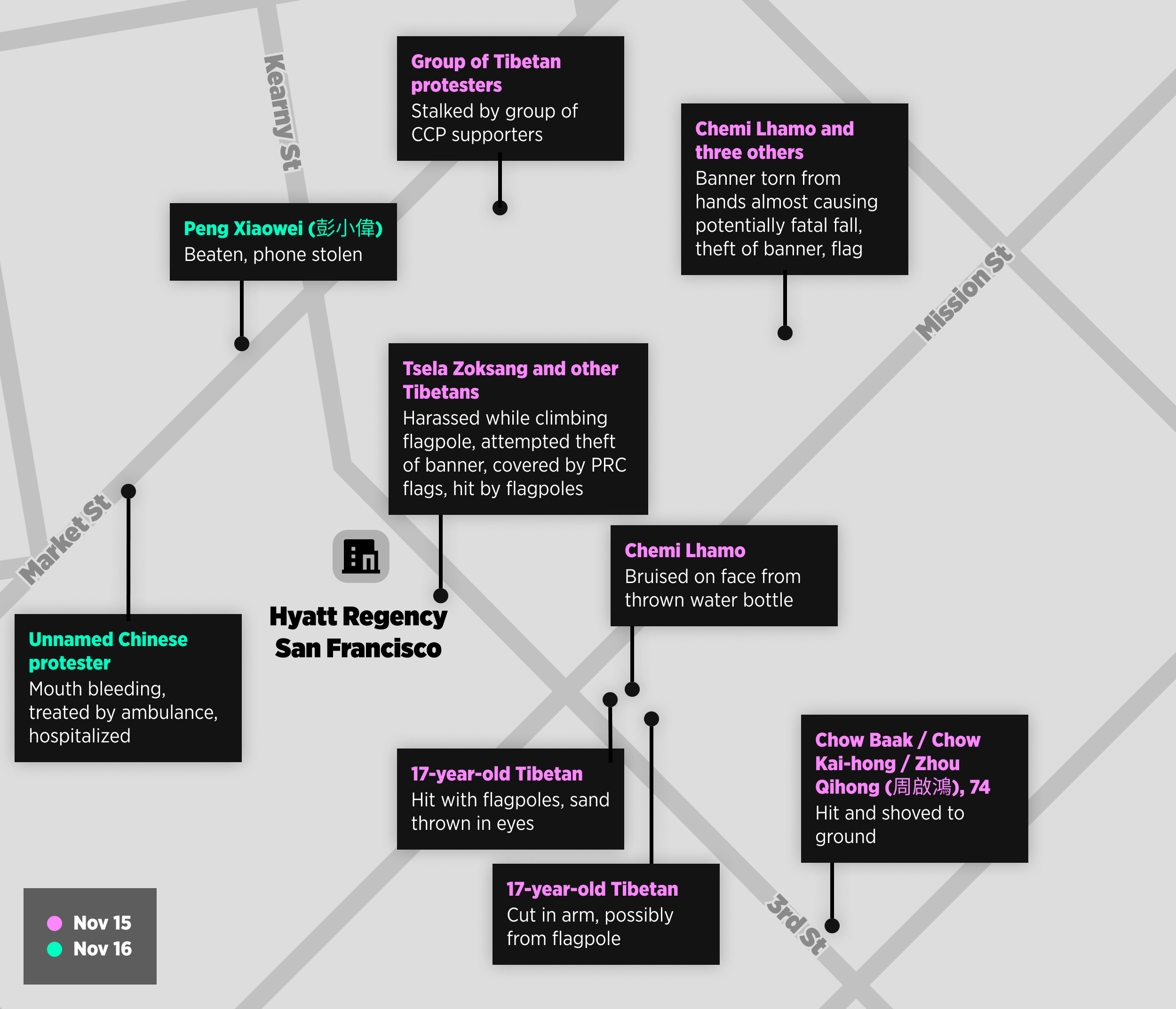
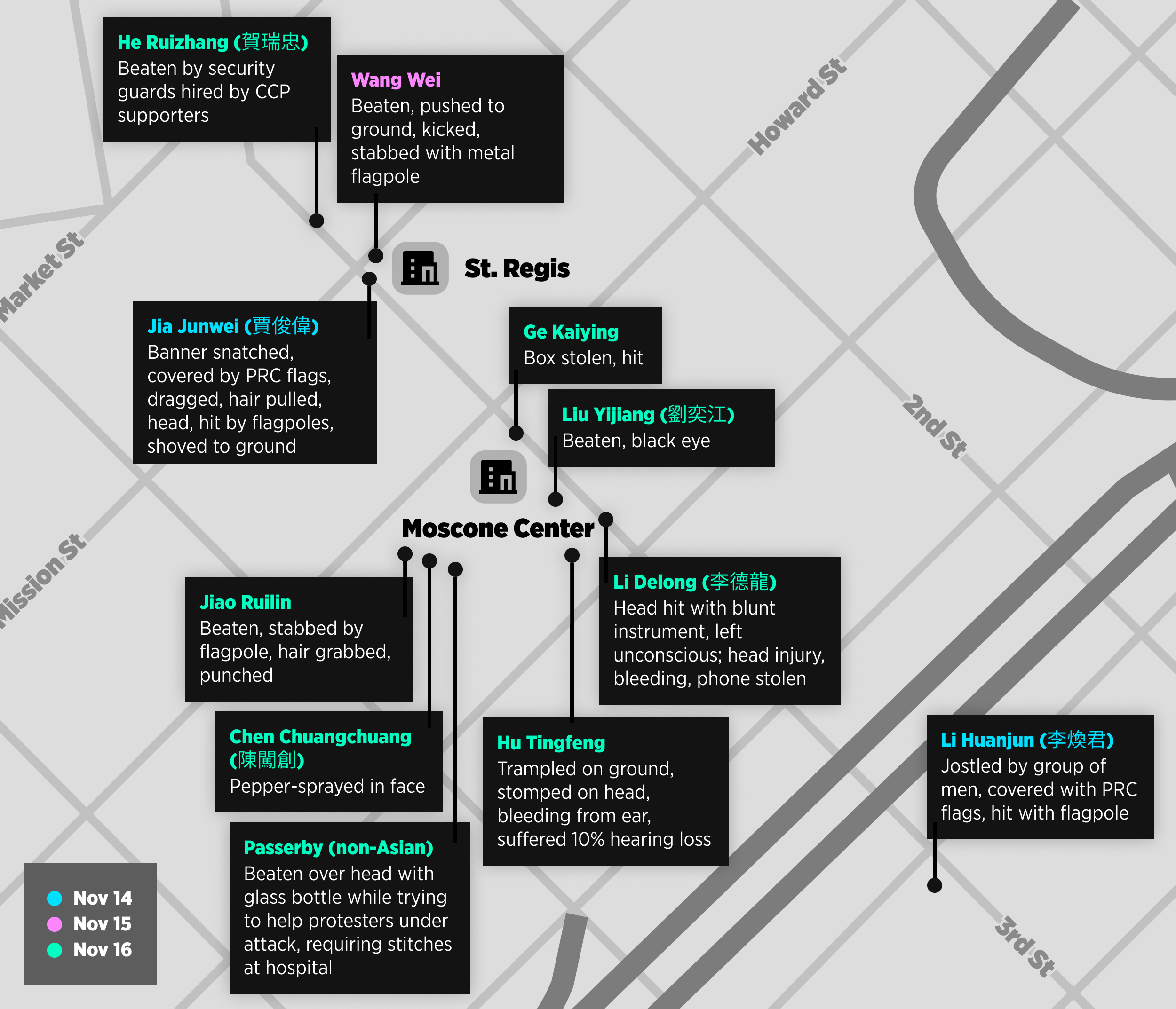
Appendix 3:
List of cases of harassment, intimidation, and assault documented in this report
In addition to the cases of harassment, intimidation, and assault documented in this report, eight other cases were reported, are noted in the report, and appear in the list below, marked by an asterisk.
| Date | Location | Victim | Notes |
|---|---|---|---|
| Days leading up to Xi Jinping’s visit to San Francisco | China | Uyghurs in the US | Relatives visited, told to tell Uyghurs in US not to go to San Francisco |
| November 10 | China | Yao Cheng (姚誠) | Daughter visited by Public Security Bureau in the PRCre: Yao’s plans for San Francisco |
| November 11 | online | Anna Kwok | Threatened with kidnapping, bodily harm |
| November 14 | near airport | Tursunay Ziyawudun and other Uyghurs | Covered with PRC flags |
| November 14 | near St. Regis | Jia Junwei (賈俊偉) | Banner snatched, covered by PRC flags, dragged, hair pulled, head hit, hit by flagpoles, shoved to ground |
| November 14 | on expected route of Xi Jinping’s motorcade from airport to St. Regis | Li Huanjun (李煥君) | Jostled by group of men, covered with PRC flags, hit with flagpole |
| November 15 | near St. Regis | Wang Wei | Beaten, pushed to ground, kicked, stabbed with metal flagpole |
| November 15 | outside Hyatt Regency | Tsela Zoksang and other Tibetans | Harassed while climbing flagpole, attempted theft of banner, covered by PRC flags, hit by flagpoles |
| November 15 | in parking garage near Hyatt Regency | Chemi Lhamo and three others | Banner torn from hands almost causing potentially fatal fall, theft of banner, flag |
| November 15 | near Hyatt Regency | Chemi Lhamo | Bruised on face from thrown water bottle |
| November 15 | near Hyatt Regency | 17-year-old Tibetan | Hit with flagpoles, sand thrown in eyes |
| November 15 | near Hyatt Regency | 17-year-old Tibetan | Cut in arm, possibly from flagpole |
| November 15 | near Hyatt Regency | Chow Baak / Chow Kai-hong / Zhou Qihong (周啟鴻), 74 | Hit and shoved to ground |
| November 15 | Market Street, near Hyatt Regency | Group of Tibetan protesters | Stalked by group of CCP supporters |
| November 16 | near Hyatt Regency | Peng Xiaowei (彭小偉) | Beaten, phone stolen |
| November 16 | outside Moscone Center | Chen Chuangchuang (陳闖創) | Pepper-sprayed in face |
| November 16 | outside Moscone Center | Liu Yijiang (劉奕江)* | Beaten, black eye |
| November 16 | outside Moscone Center | Passerby (non-Asian)* | Beaten over head with glass bottle while trying to help protesters under attack requiring stitches at hospital |
| November 16 | outside Moscone Center | Jiao Ruilin* | Beaten, stabbed by flagpole, hair grabbed, punched |
| November 16 | outside Moscone Center | Hu Tingfeng* | Trampled on ground, stomped on head, bleeding from ear, suffered 10% hearing loss |
November 16 | sidewalk outside Oren’s Hummus, Third Street between St. Regis and Hyatt Regency | He Ruizhang * (賀瑞忠) | Beaten by security guards hired by CCP supporters |
| November 16 | near Moscone Center | Li Delong* (李德龍) | Head hit with blunt instrument, left unconscious, head injury, bleeding, phone stolen |
| November 16 | near Moscone Center | Ge Kaiying * | Box stolen, hit |
November 16 | near Hyatt Regency | Unnamed Chinese protester * | Mouth bleeding, treated by ambulance, hospitalized |
| November 17 | near airport | Chemi Lhamo | Multiple wounds and bruises from jostling, punches, stabbed with flagpoles, phone stolen |
| November 17 | near airport | Sonamtso | Pushed hard, fell into passing wagon |
| November 17 | near airport | Kennedy Wong | Pushed, injured ankle, followed by pro-CCP supporters |
| November 17 | near airport | Topjor Tsultrim | Kicked in chest, fell down |
| November 17 | near airport | Carmen Lau | Hair pulled, jostled, bruised |
| November 17 | near airport | S., reporter | Phone stolen, forcibly grabbed by pro-CCP supporters, fell down, bruised eyes, |
| November 17 | near airport | 19-year-old Tibetan | Beaten, phone stolen and damaged |
| November 17 | near airport | 19-year-old Tibetan | Beaten by metal rods and wooden sticks, phone lost, pro-CCP supporters attempted to push him into the creek |
| November 17 | near airport | Kaiyu Zhang | Badly beaten |
| November 17 | near airport | Chow Baak / Chow Kai-hong / Zhou Qihong (周啟鴻) | Hit with fists, suffered external injuries |
ENDNOTES
Footnotes
-
A note on terminology: In this report, when we refer to the region, we use “East Turkestan,” and when we refer to the people, we use “Uyghurs.” ↩
-
A note on terminology: In this report, people who came out in San Francisco to “welcome” Xi Jinping are referred to as “CCP supporters,” and people who came out to protest against Xi Jinping and the Chinese Communist Party are referred to as “protesters.” The People’s Republic of China is referred to as the PRC. The ruling power of the PRC is referred to as the Chinese Communist Party or CCP for short. united front entities that are formally a part of the CCP structure within the PRC are referred to with initial capitals (united front), while overseas groups that are associated with such entities but are not formally part of any CCP structures are referred to with lowercase initial letters (united front groups). ↩
-
Much of this section is based on the work of James Jiann Hua To in his book Qiaowu: Extra-Territorial Policies for the Overseas Chinese (Leiden; Boston: Brill, 2014), as well as that of Anne-Marie Brady and Alex Joske (specific citations below). ↩
-
Alex Joske, “Reorganizing the united front Work Department: New Structures for a New Era of Diaspora and Religious Affairs Work,” The Jamestown Foundation, 9 May 2019, https://jamestown.org/program/reorganizing-the-united-front-work-department-new-structures-for-a-new-era-of-diaspora-and-religious-affairs-work/. ↩
-
Anne-Marie Brady, “Magic Weapons: China’s political influence activities under Xi Jinping,” Wilson Center, 18 Sept. 2017: 22, https://www.wilsoncenter.org/sites/default/files/media/documents/article/magic\_weapons.pdf. ↩
-
Ibid. ↩
-
For example, in 2021, the US Department of State designated 14 Chinese state-run media outlets as “foreign missions” and the US Department of Justice compelled privately-owned-but-CCP-loyalist Singtao operations in the US to register as “foreign agents.” See “Designation of Additional Chinese Media Entities as Foreign Missions,” United States Department of State, 22 June 2020, https://2017-2021.state.gov/designation-of-additional-chinese-media-entities-as-foreign-missions/, and Lachlan Markay, “DOJ brands Chinese-owned U.S. newspaper a foreign agent,” Axios, 25 Aug 2021, https://www.axios.com/2021/08/25/doj-chinese-owned-sing-tao-newspaper-foreign-agent. ↩
-
That is not to say that the 2008 Olympic torch relay was the first time that elements of the template were employed. Rather, 2008 represents the moment when those elements were consolidated. The CCP afterward used its response to the Olympic torch relay as a model for dealing with overseas public events that included any element of opposition to its rule. ↩
-
James Jiann Hua To, Qiaowu: Extra-Territorial Policies for the Overseas Chinese (Leiden; Boston: Brill, 2014) 33. ↩
-
Alliance Canada Hong Kong, “National Security and Chinese State Influence: Pro-Hong Kong Democracy Events During August 16-19, 2019,” 17 Aug 2020, https://alliancecanadahk.com/report-national-security-chinese-state-influence-august-16-august-19-pro-hong-kong-democracy-events/. ↩
-
Lok Lee, Elsa Maishman, “Hong Kong protester dragged into Manchester Chinese consulate grounds and beaten up,” BBC, 17 Oct 2022, https://www.bbc.com/news/uk-63280519. ↩
-
Tibetan Centre for Human Rights and Democracy, “Chinese Transnational Repression of Diaspora Communities”, 6 Feb 2024, https://tchrd.org/report-reveals-chinese-transnational-repression-spreading-fear-and-disempowering-exiled-tibetans/; Uyghur Human Rights Project and Oxus Society for Central Asian Affairs, “No Space Left to Run: China’s Transnational Repression of Uyghurs,” 24 June 2021, https://uhrp.org/report/no-space-left-to-run-chinas-transnational-repression-of-uyghurs/; Uyghur Human Rights Project and Oxus Society for Central Asian Affairs, “‘Your Family Will Suffer’: How China is Hacking, Surveilling, and Intimidating Uyghurs in Liberal Democracies,” 10 Nov 2021, https://uhrp.org/report/your-family-will-suffer-how-china-is-hacking-surveilling-and-intimidating-uyghurs-in-liberal-democracies/. ↩
-
Freedom House, “China: Transnational Repression Origin Country Case Study,” 2021, https://freedomhouse.org/report/transnational-repression/china. ↩
-
The White House, National Security Strategy, Oct 2022, https://www.whitehouse.gov/wp-content/uploads/2022/10/Biden-Harris-Administrations-National-Security-Strategy-10.2022.pdf. ↩
-
“Declaration of Principles to Combat Transnational Repression,” Summit for Democracy, Freedom House, https://freedomhouse.org/2023/summit-for-democracy-transnational-repression. ↩
-
For example, see “2022 Country Reports on Human Rights Practices: China (Includes Hong Kong, Macau, and Tibet) – Tibet,” Department of State, https://www.state.gov/reports/2022-country-reports-on-human-rights-practices/china/tibet/#:~:text=Transnational%20Repression,-The%20PRC%20engaged&text=Threats%2C%20Harassment%2C%20Surveillance%2C%20and,out%20by%20the%20PRC%20government. ↩
-
See “Questions submitted in advance,” Universal Periodic Review-China, Fourth cycle, 23 Jan 2024, https://www.ohchr.org/en/hr-bodies/upr/cn-index. ↩
-
Antony J. Blinken, Secretary of State, “Promoting Accountability for Transnational Repression Committed by People’s Republic of China (PRC) Officials,” United States Department of State, 21 Mar 2022, https://www.state.gov/promoting-accountability-for-transnational-repression-committed-by-peoples-republic-of-china-prc-officials/. ↩
-
Matthew Miller, Department Spokesperson, “Hong Kong’s Extra-Territorial Application of the National Security Law,” United States Department of State, 3 July 2023, https://www.state.gov/hong-kongs-extra-territorial-application-of-the-national-security-law/; Matthew Miller, Department Spokesperson, “Hong Kong Authorities’ Ongoing Harassment Campaign,” United States Department of State, 25 Aug 2023; https://www.state.gov/hong-kong-authorities-ongoing-harassment-campaign/; Antony J. Blinken, Secretary of State, “On Hong Kong Authorities’ Transnational Repression,” 15 Dec 2023, https://www.state.gov/on-hong-kong-authorities-transnational-repression/. ↩
-
United States Department of Justice, “Assistant Attorney General Matthew Olsen Delivers Remarks on Countering Nation-State Threats,” 23 Feb 2022, https://www.justice.gov/opa/speech/assistant-attorney-general-matthew-olsen-delivers-remarks-countering-nation-state-threats. ↩
-
United States Federal Bureau of Investigation, Transnational Repression, https://www.fbi.gov/investigate/counterintelligence/transnational-repression. ↩
-
For a full overview of the cases as well as details, see United States Federal Bureau of Investigation, Transnational Repression, https://www.fbi.gov/investigate/counterintelligence/transnational-repression. ↩
-
United States Government Accountability Office, “Agency Actions Needed to Address Harassment of Dissidents and Other Tactics of Transnational Repression in the U.S.,” Oct 2023,https://www.gao.gov/assets/gao-24-106183.pdf. See also Joe Davidson, “U.S. fails to combat nations that attack dissidents abroad, report warns,” Washington Post, 13 Oct 2023, https://www.washingtonpost.com/politics/2023/10/13/transnational-repression-china-turkey-america-gao/ ↩
-
For the FBI’s definition of TNR, see the above section, or United States Federal Bureau of Investigation, Transnational Repression, https://www.fbi.gov/investigate/counterintelligence/transnational-repression. ↩
-
Post by 姚诚, 12 Nov 2023, https://x.com/Yaochen64034657/status/1723741233565286804?s=20. Full text: 前天我女儿被国保叫去喝茶,并托她给我捎话,不要去旧金山参加活动,在这里我想告诉安徽国保,习近平给中国、世界带来了深重的灾难,不反习天理难容,中国人民包括体制内的大多数人也是受害者,这一点你们心里很清楚,我去抗议习近平也是为你们在发声,你们的前总理说杀就杀,在一党专制和习近平的独载下你们也没有安全感。中国不能再这样下去,我女儿与此事无关,你们请她喝茶实际上是对我的威胁,别来这一套,这只能激怒我,如果再有此类事情发生,我会采取更激烈的行动。See also Ching Fung, Gigi Lee, Chen Zifei, “Hong Kong activist to go ahead with APEC protest despite threats,” Radio Free Asia, 14 Nov 2023, https://www.rfa.org/english/news/china/apec-protest-kwok-11142023113816.html. ↩
-
See in particular: Uyghur Human Rights Project and Oxus Society for Central Asian Affairs, “No Space Left to Run: China’s Transnational Repression of Uyghurs,” 24 June 2021, https://uhrp.org/report/no-space-left-to-run-chinas-transnational-repression-of-uyghurs/; Uyghur Human Rights Project and Oxus Society for Central Asian Affairs, “‘Your Family Will Suffer’: How China is Hacking, Surveilling, and Intimidating Uyghurs in Liberal Democracies,” 10 Nov 2021, https://uhrp.org/report/your-family-will-suffer-how-china-is-hacking-surveilling-and-intimidating-uyghurs-in-liberal-democracies/. ↩
-
Post by Anna Kwok, 11 Nov 2023, https://x.com/AnnaKwokFY/status/1723423634684047661?s=20 ↩
-
Post by Anna Kwok, 12 Nov 2023, https://x.com/AnnaKwokFY/status/1723772927751950490 ↩
-
Anna Kwok 郭鳳儀 (@AnnaKwokFY), 12 Nov 2023, https://x.com/AnnaKwokFY/status/1723772927751950490. ↩
-
Interview with Anna Kwok, conducted 11 Jan 2024. Information in the following paragraphs also comes from the interview. ↩
-
It is unclear whether this meant the US Department of State’s Bureau of Diplomatic Security’s Field Office in San Francisco, the US Secret Service, which was in charge of security planning for APEC,or some other entity. ↩
-
星島日報, “南加州華人華僑近千人 赴三藩市迎接習近平到訪,” 15 Nov 2023, https://www.singtaousa.com/2023-11-15/%E5%8D%97%E5%8A%A0%E5%B7%9E%E8%8F%AF%E4%BA%BA%E8%8F%AF%E5%83%91%E8%BF%91%E5%8D%83%E4%BA%BA%E2%80%82%E8%B5%B4%E4%B8%89%E8%97%A9%E5%B8%82%E8%BF%8E%E6%8E%A5%E7%BF%92%E8%BF%91%E5%B9%B3%E5%88%B0%E8%A8%AA/4667950; and 世界日報, “僑界赴金山挺習近平 組千人巴士團 保安荷槍實彈護航,” 15 Nov 2023, https://www.worldjournal.com/wj/story/121359/7575395. For an English-language article partly based on the above articles in Chinese, see Philip Lenczycki, “Organizer with Deep CCP Ties Helped Bus Hundreds into San Francisco to Welcome Chinese Dictator,” The Daily Caller, 15 Nov 2023, https://dailycaller.com/2023/11/15/ccp-ties-china-xi-san-francisco/. ↩
-
United States Department of State, “The Chinese Communist Party on Campus: Opportunities and Risks,” https://www.state.gov/wp-content/uploads/2020/09/CCP-on-campus-FINAL.pdf. ↩
-
Alexander Bowe, “China’s Overseas united front Work: Background and Implications for the United States,” United States-China Economic and Security Review Commission, 24 Aug 2018, 10. https://www.uscc.gov/sites/default/files/Research/China%27s%20Overseas%20United%20Front%20Work%20-%20Background%20and%20Implications%20for%20US_final_0.pdf. ↩
-
At 1:39 in the following video: 王志安, “独家镜头:我在旧金山欢迎习近平,吃到了 20 美刀的盒饭,” 19 Nov 2023, https://www.youtube.com/watch?v=m6UczVMadJg. ↩
-
Human Rights in China, “PRESS RELEASE: HRIC Statement on CCP-Organized Attacks and SFPD Inaction During APEC Meeting in San Francisco,” 20 Nov 2023, https://hrichina.substack.com/p/press-release-hric-statement-on-ccp?utm_source=post-email-title&publication_id=1775744&post_id=139019153&utm_campaign=email-post-title&isFreemail=true&r=mngv&utm_medium=email. ↩
-
-
Ibid. ↩
-
See below for more information on the two security firms. ↩
-
Correspondence with a representative of National Protective Service Private Security. ↩
-
While this group is often rendered in English as the All American Chinese Association, a more literal translation would be the All American Chinese Association of Southern California. It appears in Chinese both as 南加華人華僑聯合總會 and 美國南加州華人華僑聯合總會. ↩
-
星島日報, “南加州華人華僑近千人 赴三藩市迎接習近平到訪,” 15 Nov 2023, https://www.singtaousa.com/2023-11-15/%E5%8D%97%E5%8A%A0%E5%B7%9E%E8%8F%AF%E4%BA%BA%E8%8F%AF%E5%83%91%E8%BF%91%E5%8D%83%E4%BA%BA%E2%80%82%E8%B5%B4%E4%B8%89%E8%97%A9%E5%B8%82%E8%BF%8E%E6%8E%A5%E7%BF%92%E8%BF%91%E5%B9%B3%E5%88%B0%E8%A8%AA/4667950; and 世界日報, “僑界赴金山挺習近平 組千人巴士團 保安荷槍實彈護航,” 15 Nov 2023, https://www.worldjournal.com/wj/story/121359/7575395. ↩
-
世界日報, “習近平抵金山 全美上千僑胞趕赴歡迎,” 15 November 2023;
https://www.worldjournal.com/wj/story/121519/7575468; 星島日報, “亞太峰會成為關注焦點 金山華埠生意略顯冷清,” 16 Nov 2023, https://www.singtaousa.com/2023-11-16/%e4%ba%9e%e5%a4%aa%e5%b3%b0%e6%9c%83%e6%88%90%e7%82%ba%e9%97%9c%e6%b3%a8%e7%84%a6%e9%bb%9e-%e9%87%91%e5%b1%b1%e8%8f%af%e5%9f%a0%e7%94%9f%e6%84%8f%e7%95%a5%e9%a1%af%e5%86%b7%e6%b8%85/4669536#page2. Beijing Association USA’s website is https://beijingassociationusa.org/index.html. ↩
-
The letters could be viewed on the front page of Beijing Association USA’s website as of 20 Mar 2024, https://www.beijingassociationusa.org/index.html. The website appeared to be inoperative as of 2 May 2024. Screenshots of the letters have been saved, and the front page of the website is archived at https://web.archive.org/web/20230111211524/https://www.beijingassociationusa.org/index.html where the letters can also be seen. ↩
-
The screenshot is from the 30:00 mark in ABC7 News Bay Area’s report “Dueling protests clash during Biden-Xi summit in CA,” 15 Nov 23, https://youtu.be/TbOWC4fRYcM?si=aAeoa65v6UDzKviD. ↩
-
The screenshot is from the 45:00 mark in ABC7 News Bay Area’s report “Dueling protests clash during Biden-Xi summit in CA,” 15 Nov 23, https://youtu.be/TbOWC4fRYcM?si=aAeoa65v6UDzKviD. ↩
-
Propublica Nonprofit Explorer, America Cultural Center Of Chinese Minorities, https://projects.propublica.org/nonprofits/organizations/270167038. There is a small discrepancy between the English name on its banner in San Francisco, America Cultural Center of the Chinese Minority, and the name under which it is registered as a 501(c)3 nonprofit, America Cultural Center of Chinese Minorities. It appears that the same organization may have been previously registered as America Cultural Center of the Chinese Minorities (see opencorporates, https://opencorporates.com/companies/us_ca/2771780). Because the registrations do not provide the Chinese name of the organization, it is difficult to know for certain whether or not all three are the same organization. Both registrations were at southern California addresses in Arcadia and San Gabriel. ↩
-
世界日報, “僑界赴金山挺習近平 組千人巴士團 保安荷槍實彈護航,” 15 Nov 2023, https://www.worldjournal.com/wj/story/121359/7575395; 星島日報, “南加州華人華僑近千人 赴三藩市迎接習近平到訪,” 15 Nov 2023, https://www.singtaousa.com/2023-11-15/%E5%8D%97%E5%8A%A0%E5%B7%9E%E8%8F%AF%E4%BA%BA%E8%8F%AF%E5%83%91%E8%BF%91%E5%8D%83%E4%BA%BA%E2%80%82%E8%B5%B4%E4%B8%89%E8%97%A9%E5%B8%82%E8%BF%8E%E6%8E%A5%E7%BF%92%E8%BF%91%E5%B9%B3%E5%88%B0%E8%A8%AA/4667950. ↩
-
华联社(华人联合通讯社), ”第十一次全国归侨侨眷代表大会圆满落幕 南加州华人代表备受鼓舞,” 5 Sep 2023, https://huarenone.com/2023/09/05/%E7%AC%AC%E5%8D%81%E4%B8%80%E6%AC%A1%E5%85%A8%E5%9B%BD%E5%BD%92%E4%BE%A8%E4%BE%A8%E7%9C%B7%E4%BB%A3%E8%A1%A8%E5%A4%A7%E4%BC%9A%E5%9C%86%E6%BB%A1%E8%90%BD%E5%B9%95-%E5%8D%97%E5%8A%A0%E5%B7%9E%E5%8D%8E/. ↩
-
“上海市侨联第十届委员会有关名单,” 6 Jan 2015, https://www.shanghaiql.org/detailpage/qlwy-131897d9-c146-11ec-b566-7c8ae163e649.html; “上海市侨联第十一届委员会有关名单”,” 4 July 2018,https://www.shanghaiql.org/detailpage/qlwy-12efa4f3-c146-11ec-bb14-7c8ae163e649.html.. ↩
-
Alex Joske, “Reorganizing the united front Work Department: New Structures for a New Era of Diaspora and Religious Affairs Work,” The Jamestown Foundation, 9 May 2019, https://jamestown.org/program/reorganizing-the-united-front-work-department-new-structures-for-a-new-era-of-diaspora-and-religious-affairs-work/. ↩
-
中国侨网版, “‘海外列席侨胞“两会印象’:收获一生难忘,” 13 Mar 2015, http://www.chinaqw.com/hqhr/2015/03-13/41377.shtml. ↩
-
Chinese News USA, “美國南加州華人社團聯合會舉行第十屆領導機構就職典禮,” 30 Apr 2022, http://www.chinesenewsusa.com/news/show-35367.html. ↩
-
US-China Restaurant Alliance entry on 鹿强/Charles Lu, https://u-cra.com/profile/%E9%B9%BF%E5%BC%BAcharles-lu/ ↩
-
世界日報, “拜習會外傳武鬥 「皇帝」毆打示威者,” 16 Nov 2023, https://www.worldjournal.com/wj/story/121519/7578092. ↩
-
See New Tang Dynasty Television, “APEC峰會中共僱凶打人 幕後黑手身分曝光,” 18 Nov 2023, https://www.ntdtv.com/b5/2023/11/18/a103827274.html ↩
-
In this short video clip, Chen Shanzhuang can be seen leading a crowd of CCP supporters in San Francisco. He is also interviewed herein, and the badge of the American Chinese Commerce Association (Hong Kong) can be clearly seen on his chest: 不那么快讯 post, 27 Nov 2023, https://x.com/Soh_Shorts/status/1729298341354438661?s=20. The Facebook page of the American Chinese Commerce Assocation (Hong Kong) appears to have fallen into disuse: https://www.facebook.com/p/%E7%BE%8E%E5%9C%8B%E9%A6%99%E6%B8%AF%E6%97%85%E7%BE%8E%E8%8F%AF%E4%BA%BA%E7%B8%BD%E5%95%86%E6%9C%83-American-Chinese-Commerce-AssociationHK-100069852020888/. ↩
-
星島日報, “亞總會8大道新辦公室剪綵,” 9 Nov 2023, https://www.singtaousa.com/2023-11-09/%E4%BA%9E%E7%B8%BD%E6%9C%838%E5%A4%A7%E9%81%93%E6%96%B0%E8%BE%A6%E5%85%AC%E5%AE%A4%E5%89%AA%E7%B6%B5/4661708#page3. ↩
-
See American Chinese Commerce Association (Hong Kong)/美國(香港)旅美華人總商會, “會長 陳善莊 John Chan,” http://www.accahk97.org/%E4%BC%9A%E5%B1%95/%E7%8F%BE%E4%BB%BB%E6%9C%83%E9%95%B7-%E9%99%B3%E5%96%84%E8%8E%8A-john-chan/, and Embassy of the People’s Republic of China in the Republic of Singapore, “美国纽约侨界揭批“法轮功,” 5 Feb, 2001, http://sg.china-embassy.gov.cn/zt_0/jpflg_132920/202302/t20230201_11017597.htm. ↩
-
鏡新聞, “亞總會主席陳善莊爆氣槓上台灣媒體 稱人民擁護習近平連任 被問到「投票權」一度語塞|鏡速報,” 31 Mar 2023, https://youtu.be/vTlz63TW3d8?feature=shared ↩
-
陳善莊, https://zh.wikipedia.org/zh-hant/%E9%99%B3%E5%96%84%E8%8E%8A. See also “會長 陳善莊 John Chan,” http://www.accahk97.org/%E4%BC%9A%E5%B1%95/%e7%8f%be%e4%bb%bb%e6%9c%83%e9%95%b7-%e9%99%b3%e5%96%84%e8%8e%8a-john-chan/ for the website shared by both the American Chinese Commerce Association and the American Chinese Commerce Association (Hong Kong), and 星島日報, “現場激情澎湃人人一臉幸福,” 15 Nov 2023, https://www.singtaousa.com/2023-11-15/%e7%8f%be%e5%a0%b4%e6%bf%80%e6%83%85%e6%be%8e%e6%b9%83%e4%ba%ba%e4%ba%ba%e4%b8%80%e8%87%89%e5%b9%b8%e7%a6%8f/4668161#page3 for mention of Chen as convener of the Coalition of Asian-Americans for Civil Rights (亞裔維權大聯盟). ↩
-
From 不那么快讯 (@Soh_shorts), 27 Nov 2023, https://x.com/Soh_Shorts/status/1729298341354438661. ↩
-
Testimony of Kennedy Wong. ↩
-
Interviews with Pema Doma and Elfidar Iltebir. ↩
-
For scenes from the area near the airport earlier on the 14th, see the following video from 30” onward: 追新聞 The Chaser, “APEC峯會|習近平專機抵三藩市 示威者租飛機展示「End CCP Free China Free HK Free Tibet Free Uighur」,” 14 Nov 23, https://youtu.be/zSUjIkJ\_fiA?feature=shared. ↩
-
Interview with Topjor Tsultrim. ↩
-
Ibid. ↩
-
Chloe Shrager, “Bloody clashes erupt between pro-, anti-China demonstrators at APEC,” San Francisco Chronicle, 17 Nov 2023, https://www.sfchronicle.com/bayarea/article/fights-erupt-pro-china-anti-china-demonstrators-18497480.php. ↩
-
世界電子報, “僑界赴金山挺習近平 組千人巴士團 保安荷槍實彈護航,” 15 Nov 2023, https://www.worldjournal.com/wj/story/121359/7575395. ↩
-
The security guards wore pins on their lapels with the name of their company, Critical Synthesis. One of the protesters was told by a security guard wearing such a pin on his lapel that it was a private company hired for the event. ↩
-
See this video for a typical example of a CCP supporter declining to answer a reporter’s questions (30”), as well as for a scene of scuffling that occurred due to incursions of CCP supporters into protesters’ area: 自由亚洲电台 post, 14 Nov 2023, https://x.com/RFA\_Chinese/status/1724634964891976030?s=20. ↩
-
An exception is Zack Lee, a student at UC Davis, one of the few CCP supporters quoted in English-language mainstream media by name. Katherine Li, “S.F.’s APEC is causing a reckoning for AAPI communities,” San Francisco Chronicle, 16 Nov 2023, https://www.sfchronicle.com/bayarea/article/apec-aapi-protests-18491983.php. ↩
-
For Tursunay Ziyawudun’s story, see Noor Greene, “Concentration Camp Survivor Tursunay Ziyawudun on Her Imprisonment in Xinjiang,” Reason, Feb 2022, https://reason.com/2022/01/08/the-only-crime-of-most-of-us-was-that-we-were-uyghur-muslims/, and Xinjiang Victims Database, Entry 2322, https://shahit.biz/eng/2322/. ↩
-
Besides Li Huanjun’s post, the harassment of her was also reported by VOA: 周星晨, “习近平访美期间众多抗议人士被围殴,人权组织推动国会举行听证,” 22 Nov 2023, https://www.voachinese.com/a/congress-urged-to-probe-attacks-on-chinese-dissidents-in-xi-jinping-protest-20231121/7364581.html?utm\_source=twitter&utm\_medium=social&utm\_campaign=dlvr.it. ↩
-
李焕君2021转世3号 (@Goodday79333767), 14 Nov 2023, https://x.com/Goodday79333767/status/1724612135723106556. ↩
-
自由亚洲电台, “李焕君母亲欲赴美照顾女儿 在北京机场被阻, 8 Apr 2016, https://www.rfa.org/mandarin/yataibaodao/renquanfazhi/ql1-04082016100901.html. ↩
-
Goh Fung, Qiao Long, “Activists Plan Protests Ahead of Chinese President’s Mar-a-Lago Summit With Trump,” Radio Free Asia, 3 April 2017, https://www.rfa.org/english/news/china/activists-04032017125832.html. ↩
-
李焕君 post, 14 Nov 2023, https://x.com/Goodday79333767/status/1724612135723106556?s=20 : “年11月14日旧金山下午,李焕君被中国大使馆的不紧张性骚扰(李焕君多次被掐胳膊掐腰部等部位),被一个带帽子的拿旗杆打了头部.” ↩
-
侨网, “广西侨界国庆观礼代表感言:祖国强大华侨自豪骄傲,” 8 Oct 2019, https://www.chinaqw.com/hqhr/2019/10-08/233339.shtml and 搜狐, “美籍华人陈隆魁捐建的“隆魁楼”交付使用,” 31 May 2023, https://www.sohu.com/a/680758834_120998630. ↩
-
华联社(华人联合通讯社), “第十一次全国归侨侨眷代表大会圆满落幕 南加州华人代表备受鼓舞,” 5 Sep 2023, https://huarenone.com/2023/09/05/%E7%AC%AC%E5%8D%81%E4%B8%80%E6%AC%A1%E5%85%A8%E5%9B%BD%E5%BD%92%E4%BE%A8%E4%BE%A8%E7%9C%B7%E4%BB%A3%E8%A1%A8%E5%A4%A7%E4%BC%9A%E5%9C%86%E6%BB%A1%E8%90%BD%E5%B9%95-%E5%8D%97%E5%8A%A0%E5%B7%9E%E5%8D%8E/ Additional information on Chen Longkui: In October 2019, he was present in Tiananmen Square to attend the military parade marking the 70th anniversary of the founding of the PRC. A profile of Chen based on information provided by the Guilin UFWD states that, as president of the Guilin Federation of Overseas Chinese Enterprises, “[h]e is committed to the cause of the peaceful reunification of the motherland and has a firm stand. He spares no effort to oppose and resist acts of splitting the motherland and actively safeguards the reunification of the motherland.” See 侨网, “广西侨界国庆观礼代表感言:祖国强大华侨自豪骄傲,” 8 Oct 2019, https://www.chinaqw.com/hqhr/2019/10-08/233339.shtml. ↩
-
世界日報, “賴清德過境金山 中國百位僑民抗議:賴破壞兩岸關係,” 16 Aug 2023, https://www.worldjournal.com/wj/story/121472/7375409; Alliance for China’s Peaceful Reunification, USA, “俄勒冈州统促会接待中国统促会代表团,” 8 Nov 2019, https://acprusa.com/news/11032019CA.html. ↩
-
波特蘭新聞, “俄勒岡州國慶籌委會執行主席靖東升主持本次活動,” https://portlandchinesetimes.com/en/%E4%BF%84%E5%8B%92%E5%B2%A1%E5%B7%9E%E5%9C%8B%E6%85%B6%E7%B1%8C%E5%A7%94%E6%9C%83%E5%9F%B7%E8%A1%8C%E4%B8%BB%E5%B8%AD%E9%9D%96%E6%9D%B1%E5%8D%87%E4%B8%BB%E6%8C%81%E6%9C%AC%E6%AC%A1%E6%B4%BB%E5%8B%95-2/. ↩
-
He is also a leader of Portland Suey Sing Chamber of Labor & Commerce, along with two other figures identified in this report, Rong Junwu and Zhu Jiemei. See Portland Suey Sing Chamber of Labor & Commerce list of ranking officers, http://www.sueysingportland.com/32887217292151737636.html. ↩
-
Alliance for China’s Peaceful Reunification, USA, “俄勒冈州统促会接待中国统促会代表团,” 8 Nov 2019, https://acprusa.com/news/11032019CA.html. ↩
-
波特蘭新聞, “俄勒岡州僑界隆重舉行欢迎宴會 中國駐舊金山總領事張建敏出席並作致辭,” https://portlandchinesetimes.com/%E4%BF%84%E5%8B%92%E5%B2%A1%E5%B7%9E%E5%83%91%E7%95%8C%E9%9A%86%E9%87%8D%E8%88%89%E8%A1%8C%E6%AC%A2%E8%BF%8E%E5%AE%B4%E6%9C%83-%E4%B8%AD%E5%9C%8B%E9%A7%90%E8%88%8A%E9%87%91%E5%B1%B1%E7%B8%BD%E9%A0%98/ and 波特蘭新聞, 26 Aug 2022, A4, https://www.pctprintanddesign.com/uploads/5/0/4/6/50460347/109024-a.pdf. Additional information on Jing Dingsheng: Jing also appeared at a united front event held in the Seattle area on March 16, 2019, to celebrate the founding of the Washington Fujian Chamber of Commerce and Industry (WFCCI) (华州福建工商会). Deputy Consul General Zou Yonghong and Consul Chen Di of the Chinese Consulate General in San Francisco attended the meeting to congratulate the organization on its founding. A message was read out from the Overseas Chinese Affairs Office (OCAO) of Fujian Province. OCAO is an external name for the CCP’s united front Work Department. The vice president of WFCCI, Chen Wenshen (陈文深), was also present at that event. To many protesters in San Francisco, Chen was recognizable as the bald-headed man who was seen at many incidents of intimidation, harassment, and assault during Xi Jinping’s visit (see below for more on Chen Wenshen).See 华盛顿艺术, “华州福建工商会成立庆典,” 18 Mar 2019, http://arthundred.com/index.php?a=shows&catid=21&id=917 and 西雅图中文电台 Chinese Radio Seattle, “华州福建工商会举行成立庆典,” 18 Mar 2019, https://chineseradioseattle.com/2019/03/18/wa_fujian_business_association/. ↩
-
马永田 post, 10 Dec 2023, https://x.com/mayongtian/status/1733862846272839898?s=20. ↩
-
Eliot Kleinberg, “Details of 6 Chinese protesters charged during President Xi visit,” The Palm Beach Post, 15 Apr 2017, https://www.palmbeachpoStcom/story/news/politics/2017/04/15/exclusive-details-6-chinese-protesters/6961953007/. For specific information about Ma Yongtian’s blocking of Xi Jinping’s motorcade, see Daphne Duret, “Chinese protester tells tale behind desperate act near Trump summit,” The Palm Beach Post, 20 June 2017, https://www.palmbeachpoStcom/story/news/politics/2017/06/20/video-chinese-protester-tells-tale/7362869007/. ↩
-
The following video shows the assault. Rock & Roar News telegram channel, 18 Nov 2023, https://t.me/rocknroarnews. Details are also given below under the heading, “Assault on Chow Kai-hong.” ↩
-
See below for information about Yu Yingqiang. The other man, the “man in a white jacket,” appeared at a Chingming event in Salem, Oregon, less than an hour from Portland, on April 1, 2023: Les Zaitz, “Salem pauses to honor Chinese ancestors during Qingming ceremony,” Salem Reporter, 3 Apr 2023, https://www.salemreporter.com/2023/04/03/salem-pauses-to-honor-chinese-ancestors-during-qingming-ceremony/ His name is Rong Junwu. He is affiliated with the Portland Suey Sing Chamber of Commerce & Industry, acting as its vice-president and consultant in 2022, president in 2023, and consultant in 2024. See Portland Suey Sing Chamber of Commerce & Industry list of ranking officers, http://www.sueysingportland.com/32887217292151737636.html and, for evidence of his role as president in 2023, see Malldone, “波特兰萃胜工商会举行春宴,旧金山总领馆领导出席!,” 14 Feb 2023, https://malldone.com/sueysingportland-2023-2-11/. Jing Dongsheng is also listed as chair of the Portland Suey Sing Chamber of Commerce & Industry in 2024. ↩
-
New Tang Dynasty Television, “中共雇人抗议蔡英文 被曝克扣佣金,” 7 Apr 2023, https://cn.ntdtv.com/b5/2023/04/06/a103684674.html; am730, “京嚴詞抗議 蔡英文洛杉磯見美眾院議長,” 6 Apr 2023, https://www.am730.com.hk/%E4%B8%AD%E5%9C%8B/%E5%8C%97%E4%BA%AC%E5%9A%B4%E8%A9%9E%E6%8A%97%E8%AD%B0-%E8%94%A1%E8%8B%B1%E6%96%87%E6%B4%9B%E6%9D%89%E7%A3%AF%E8%A6%8B%E7%BE%8E%E7%9C%BE%E9%99%A2%E8%AD%B0%E9%95%B7/370153; Newsweek, “China Offers Protesters $400 Each to Disrupt McCarthy-Tsai Meet—Report,” 5 Apr 2023, https://www.newsweek.com/taiwan-tsai-ing-wen-kevin-mccarthy-california-china-protest-1792615; New Tang Dynasty Television, “蔡英文加州会麦卡锡 传中共加价400美金雇人搅局,” 4 Apr 2023, https://www.ntdtv.com/gb/2023/04/05/a103683836.html. ↩
-
世界日報, “賴清德過境金山 中國百位僑民抗議:賴破壞兩岸關係,” 16 Aug 2023, https://www.worldjournal.com/wj/story/121472/7375409. ↩
-
National Protective Service website, https://www.nationalprotectiveservice.com/. ↩
-
聯合新聞網, “習近平下榻瑞吉酒店 金山市中心安保再升級,” 15 Nov 2023, https://udn.com/news/story/123822/7575664. ↩
-
David Sjostedt, “San Francisco APEC Sees Dueling Protests Before Xi’s Arrival,” The San Francisco Standard, 14 Nov 2023, https://sfstandard.com/2023/11/14/apec-dueling-protests/. ↩
-
Alex Willemyns, “Xi and Biden reinstate direct military talks,” Radio Free Asia, 15 Nov 2023, https://www.rfa.org/english/news/china/san-francisco-xi-11152023115850.html. ↩
-
大紀元時報, “訪民指證:親共分子李華紅在舊金山打人,” 17 Nov 2023, https://www.epochtimes.com/b5/23/11/17/n14118222.htm. ↩
-
Ibid. Detailed accounts of the assault on Jia Junwei can be found in these two articles: 大紀元時報, “訪民指證:親共分子李華紅在舊金山打人,” 17 Nov 2023, https://www.epochtimes.com/b5/23/11/17/n14118222.htm; 大紀元時報, “親共分子李華紅滿口髒話 在APEC毆打中國訪民,” 25 Nov 2023, https://www.epochtimes.com/b5/23/11/25/n14123796.htm. See also the following video interview with Jia: 自由亚洲电台, “【黑龙江访民受迫害】【举横幅表达诉求遭袭击】,” 15 Nov 2023, https://www.youtube.com/watch?v=He8QFPzVR4k. ↩
-
Ibid. ↩
-
大紀元時報, “訪民指證:親共分子李華紅在舊金山打人,” 17 Nov 2023, https://www.epochtimes.com/b5/23/11/17/n14118222.htm. ↩
-
Interview with Chen Chuangchuang. ↩
-
HRLF Staff, “Overseas Influence Operations of the Chinese Communist Party: Furthering the Crackdown on Falun Gong in the United States,” Human Rights Law Foundation, 12 Sep 2022, 6, https://hrlf.net/wp-content/uploads/2022/09/2022-Overseas-Influence-Operations-of-the-Chinese-Communist-Party-Furthering-the-Crackdown-on-Falun-Gong-in-the-United-States.pdf. ↩
-
Bitter Winter, “China Anti-Xie Jiao Association,” https://bitterwinter.org/Vocabulary/china-anti-xie-jiao-association/. ↩
-
HRLF Staff, “Overseas Influence Operations of the Chinese Communist Party: Furthering the Crackdown on Falun Gong in the United States,” Human Rights Law Foundation, 12 Sep 2022, https://hrlf.net/wp-content/uploads/2022/09/2022-Overseas-Influence-Operations-of-the-Chinese-Communist-Party-Furthering-the-Crackdown-on-Falun-Gong-in-the-United-States.pdf. ↩
-
Corey Kilgannon, “A Battle for Chinese Hearts and Minds in Flushing,” New York Times, 7 Mar 2011, https://archive.nytimes.com/cityroom.blogs.nytimes.com/2011/03/07/a-battle-for-chinese-hearts-and-minds-in-flushing/. See also 大紀元時報, “周永康嫡系特工李華紅打人案 紐約法院定罪,” 12 Jan 2013, https://www.epochtimes.com/b5/13/1/11/n3773946.htm. ↩
-
自由亚洲电台 post, 15 Nov 2023, https://x.com/RFA\_Chinese/status/1724916230698807630?s=20; ABC7 News Bay Area, “Dueling protests clash during Biden-Xi summit in CA,” 15 Nov 2023, https://youtu.be/TbOWC4fRYcM?si=2lRRpWfZa4NMW1J-. ↩
-
Katherine Li, “S.F.’s APEC is causing a reckoning for AAPI communities,” San Francisco Chronicle, 16 Nov 2023, https://www.sfchronicle.com/bayarea/article/apec-aapi-protests-18491983.php#photo-24456559. ↩
-
Interview with Pema Doma. ↩
-
Interview with Uyghur American Association President Elfidar Iltebir. ↩
-
Interview with Wang Wei. ↩
-
Bin Xie (@bxieus), 15 Nov 2023 https://x.com/bxieus/status/1724977747938742313?s=20. ↩
-
Separately, this report lodged an inquiry with the San Francisco Police Department about the case of Wang Wei and others who reported having filed reports with the SFPD. As of March 21, 2024, the SFPD has neither provided information about the status of the reports nor whether any investigations have taken place. ↩
-
权利运动-王维 (@chinahrc), 18 Nov 2023, https://x.com/chinahrc/status/1725991133690687597?s=20. Full text: 征集图片里人的信息,我们要起诉这些殴打我的人, @1957spirit 陈闯创律师一直在收集证据起诉,欢迎社会各界人士私信,这里是美国,不能让他们就这样拿着共产党的钱打人后还逍遥法外! ↩
-
华盛顿艺术, “华州四川同乡总会在西雅图成立庆典,” 10 June 2019, http://www.arthundred.com/index.php?a=shows&catid=21&id=1004. ↩
-
This bio lists him as founding president of the Cantonese People’s Association of Washington State (美国华盛顿州广府会; translated by China Daily, the English-language newspaper owned by the Central Propaganda Department of the CCP, as the Guangzhou Association of Washington State: https://www.chinadaily.com.cn/newsrepublic/2016-10/07/content_26984159.htm) as well as Secretary-General of the First North American Cantonese People’s Conference (首届北美广府人联谊大会秘书长)—see 广州市侨联, “海外侨团动态丨首届北美广府人联谊大会召开,” 26 Aug 2022, https://mp.weixin.qq.com/s?__biz=MzIwNzU3NDM3Mw==&mid=2247520821&idx=2&sn=f72da3cd8e8fc7fd5ac87f10da291171&chksm=9712963fa0651f29f3c97ba9e5629d5aee50284767c56c4a8ed9e12171525f04aa8b8e80fe81&scene=27; Founding President of the American Zhaoqing Association (美国肇庆同乡会创会会长), and Honorary Chairman of the Ninth Committee of the Zhaoqing Overseas Chinese Federation (肇庆市侨联第九届委员会荣誉主席)—see Guangdong Province Federation of Returned Overseas Chinese, 5 June 2023, https://baike.baidu.com/reference/60140026/533aYdO6cr3_z3kATP2JmP_2ZHzCM9-lt-KGUuZzzqIP0XOpX5nyFI828dtx8eVgWgjF_5Z7L8cNmPHlWRQbqqJONfJ1HfZm8nf_VTvEy7f4p51sxg. Liang Guoyao led a delegation to visit Zhaoqing, Guangzhou, on May 29, 2023, where he took part in a meeting of “returned overseas Chinese” leaders from around the world convened to study and praise the outcomes of the Sixth Plenary Session of the 19th Central Committee of the Chinese Communist Party. Liang was quoted as being “particularly touched by a sentence” that “the party led the people to successfully embark on the path of Chinese-style modernization. He believes that this path taken by the Chinese Communist Party conforms to the common aspiration of the people of all ethnic groups in the country to pursue peace and stability as well as national security and prosperity, creates a new form of human civilization, expands the path for developing countries to modernize, and provides a solution to major human problems, contributing Chinese wisdom and Chinese solutions.” See 深圳市前海深港现代服务业合作区管理局, “广东侨界热议中共十九届六中全会精神,” 15 Dec 2021, http://qh.sz.gov.cn/sygnan/qhzx/dtzx/content/post_9448368.html and 梁国尧, https://baike.baidu.com/item/%E6%A2%81%E5%9B%BD%E5%B0%A7/60140026. ↩
-
Interview with Chen Chuangchuang. ↩
-
西雅图中文电台 Chinese Radio Seattle, “2019华州河南同乡会、河南商会春季联谊活动圆满结束,” 25 Mar 2019, https://chineseradioseattle.com/2019/03/25/henan_tongxianghui_2019/. ↩
-
Anne-Marie Brady, “Magic Weapons: China’s political influence activities under Xi Jinping,” Wilson Center, 18 Sept. 2017: 22, https://www.wilsoncenter.org/sites/default/files/media/documents/article/magic_weapons.pdf. ↩
-
The National Committee of the Chinese People’s Political Consultative Conference, “China Zhi Gong Party convenes 16th national congress,” Xinhua, 13 Dec 2022, http://en.cppcc.gov.cn/2022-12/13/c_839382.htm. ↩
-
今日新闻, “国防部宣布备战?如果台海战争打响,中国将面临四大压力,” 24 May 2023, https://www.newstoday.cc/E0pAGpL.html#gsc.tab=0. ↩
-
LeLe Farley, “我去了蔡英文與麥卡錫LA會面現場,混入了小粉紅抗議者內部,偷偷問他們…,” 6 Apr 2023, https://youtu.be/YyA-Sl3BesA?si=k1Wmc42wv5x9fvCg. ↩
-
西雅图中文电台 Chinese Radio Seattle, “华州全侨举行庆祝中国国庆70周年升旗仪式以及游行等活动,” 9 Sep 2019, https://chineseradioseattle.com/2019/09/09/prc_70th_guoqing_wa/. ↩
-
Consulate-General of the People’s Republic of China in San Francisco, “张建敏总领事会见华盛顿州中国统一促进会理事长方伟侠,” 26 Jun 2022, http://sanfrancisco.china-consulate.gov.cn/tpxw/202206/t20220627_10710283.htm. Chen Wenshen also appeared at that meeting. ↩
-
西雅图中文电台 Chinese Radio Seattle, “华州福建工商会举行成立庆典,” 18 Mar 2019, https://chineseradioseattle.com/2019/03/18/wa_fujian_business_association/. See also 华盛顿艺术, “华州福建工商会成立庆典,” 18 Mar 2019, http://arthundred.com/index.php?a=shows&catid=21&id=917. ↩
-
西雅图中文电台 Chinese Radio Seattle, “中国和平统一促进会代表团访问西雅图 ,” 6 Nov 2019, https://chineseradioseattle.com/2019/11/06/zhongguotongyicujinhui_seattle_2019/. Chen can be seen attending the meeting at the 14:33 mark in the following video: Chinese Radio Seattle 西雅图中文电台, “中国和平统一促进会访问西雅图,” 6 Nov 2019, https://youtu.be/s9Ap9uIzGFg?si=vqEeqYFRaxxpuBSb. ↩
-
As noted above, in 2020, the US Department of State designated the umbrella organization for state and local APCR/US, the Association for China’s Peaceful Unification as a Foreign Mission of the PRC, stating, “The united front Work Department (UFWD) is the Chinese Communist Party (CCP) organ tasked with co-opting and neutralizing threats to the party’s rule and spreading its influence and propaganda overseas. The CCP regards this party apparatus as a “magic weapon” to advance Beijing’s policies. Today, the Department of State designated a UFWD-controlled organization – the National Association for China’s Peaceful Unification (NACPU) – as a foreign mission of the PRC under the U.S. Foreign Missions Act. The goal of this action is to shine a light on this organization and make clear that their messages come from Beijing.” The State Department says, “Authentic people-to-people exchanges are crucial for establishing understanding between cultures, but the UFWD is not a vehicle for people-to-people exchange. Instead, it uses front organizations like the NACPU to advance the PRC’s propaganda and malign influence. Our actions today move us a step closer toward a relationship with the PRC based on transparency and reciprocity.” See Michael R. Pompeo, Secretary of State, “Designation of the National Association for China’s Peaceful Unification (NACPU) as a Foreign Mission of the PRC,” US Department of State, 28 Oct 2020, https://2017-2021.state.gov/designation-of-the-national-association-for-chinas-peaceful-unification-nacpu-as-a-foreign-mission-of-the-prc/. ↩
-
“孙凌雁副秘书长在欢迎晚宴上指出,中国和平统一促进会是由全国政协主席汪洋担任会长、国家统战部部长担任执行副会长的社会组织.” From 西雅图中文电台 Chinese Radio Seattle, “中国和平统一促进会代表团访问西雅图,” 6 Nov 2019, https://chineseradioseattle.com/2019/11/06/zhongguotongyicujinhui_seattle_2019/. ↩
-
The man suspected of carrying out a shooting in a California church attended primarily by people of Taiwanese background on May 15, 2022, was associated with the Las Vegas Association for China’s Peaceful Unification and reportedly attended its founding meeting on April 2, 2019, where he introduced a banner that called for the “eradication of pro-independence demons.” (See Hwang Chun-mei, “California church shooter in Taiwan ‘peaceful reunification’ group linked to Beijing,” Radio Free Asia, https://www.rfa.org/english/news/china/shooter-05172022104957.html) He was charged with 98 counts of federal hate crimes and weapons and explosives offenses, including the murder of one person and attempted murder of 44 others. (See US Department of Justice, “Nevada Man Charged with Federal Hate Crimes for Irvine Taiwanese Presbyterian Church Shooting,” 11 May 2023, https://www.justice.gov/opa/pr/nevada-man-charged-federal-hate-crimes-irvine-taiwanese-presbyterian-church-shooting.) It is unclear the extent to which the federal criminal investigation has looked into the suspect’s ties with the Las Vegas ACPU and any role those may have played in the crimes committed or the ties between all ACPUs in the US and the CCP’s China Council for the Promotion of Peaceful National Reunification. If this has not been done, doing so may be key to the prevention of further violence in general and political violence specifically. ↩
-
National Committee on U.S.-China Relations, “NCUSCR-USCBC host event to welcome Chinese President Xi Jinping,”https://www.ncuscr.org/ncuscr-uscbc-joint-statement-following-event-to-welcome-president-xi-jinping/. ↩
-
Ana Swanson, “Pandas, Ping-Pong and Profits: Chinese Leader Woos U.S. C.E.O.s,” New York Times, 16 Nov 2023, https://www.nytimes.com/2023/11/16/business/economy/china-us-business-xi-jinping-ceos.html. ↩
-
Ana Swanson, “Xi Jinping to Address U.S. Business Leaders Amid Rising Skepticism of China Ties,” New York Times, 8 Nov 2023, https://www.nytimes.com/2023/11/08/business/economy/xi-jinping-american-business-leaders-dinner.html. Official invitation to the banquet: https://www.politico.com/f/?id=0000018b-aa47-deac-a19b-eacf0f160000. ↩
-
Full video of those who spoke at the banquet as well as a transcript of their speeches: National Committee on U.S.-China Relations, “A Reception and Dinner Honoring His Excellency President Xi Jinping,” https://www.ncuscr.org/video/xi-jinping-dinner/. ↩
-
Miranda Nazzaro, “Chinese leader Xi gets standing ovation at banquet with US executives,” The Hill, 16 Nov 2023, https://thehill.com/policy/international/4313668-xi-gets-standing-ovation-at-banquet-with-us-executives/. ↩
-
CCTV Video News Agency, “Xi Addresses Welcome Dinner by Friendly Organizations in U.S.,” 16 Nov 2023, https://youtu.be/sBBbIHCb1Rk?si=GgCSqNGnCBivRzfV. ↩
-
See Caspar’s speech at the National Committee on U.S.-China Relations, “A Reception and Dinner Honoring His Excellency President Xi Jinping,” https://www.ncuscr.org/video/xi-jinping-dinner/. ↩
-
Maya Wang, “US Company Must Stop Supplying China’s Regime with DNA Surveillance Tech,” Human Rights Watch, 30 Jan 2024. https://www.hrw.org/news/2024/01/30/us-company-must-stop-supplying-chinas-regime-dna-surveillance-tech. ↩
-
Students for a Free Tibet, “ThermoFisher: Don’t Help China Steal Tibetan DNA,” https://studentsforafreetibet.org/our-work/thermofisher-dont-help-china-steal-tibetan-dna/. ↩
-
Representatives of the host organizations in attendance included Evan Greenberg, Chair, National Committee on U.S.-China Relations as well as Chairman and Chief Executive Officer of Chubb; Craig Allen, President, US-China Business Council; Stephen A. Orlins, President, National Committee on U.S.-China Relations; John L. Thornton, Co-Chair, Asia Society; Michael Froman, President, Council on Foreign Relations; and Suzanne P. Clark, President and CEO, U.S. Chamber of Commerce. Business executives in attendance included Tim Cook, the chief executive of Apple; LaurenceFink, CEO of BlackRock; Marc Benioff, Salesforce CEO; Milind Pant, CEO, Amway; Stephen Schwarzman, CEO and Chairman, Blackstone; Stanley A. Deal, Executive Vice President, The Boeing Company and President and CEO, Boeing Commercial Airplanes; Hock Tan, President and CEO, Broadcom Inc; Ming Hsieh, Chairman and CEO, Fulgent Genetics; Daniel O’Day, Chairman and CEO, Gilead Sciences; Darius Adamczyk, Executive Chairman, Honeywell; Robert G. Goldstein, Chairman and Chief Executive Officer, Las Vegas Sands; Joseph Y. Bae, Co-Chief Executive Officer, KKR; Merit Janow, Chair, Mastercard; Elon Musk, Head of Tesla; and executives from Pfizer, Nike, FedEx, and Qualcomm. This incomplete guest list was compiled from the Select Committee on the Chinese Communist Party post, 16 Nov 2023, https://x.com/committeeonccp/status/1725125452447068249?s=20; Ana Swanson, “Pandas, Ping-Pong and Profits: Chinese Leader Woos U.S. C.E.O.s,” New York Times, 16 Nov 2023, https://www.nytimes.com/2023/11/16/business/economy/china-us-business-xi-jinping-ceos.html; and Lingling Wei, Charles Hutzler, “U.S. Executives Get No Reassurance From Xi on Tougher China Business Environment,” Wall Street Journal, 16 Nov 2023, https://www.wsj.com/world/china/chinas-xi-draws-standing-ovation-from-u-s-business-leadersand-some-doubts-13fc3ad2. ↩
-
California political elites in attendance included Jerry Brown, the former governor of California; Wille Brown, former mayor of San Francisco and former governor of California; Gavin Newsom, former mayor of San Francisco and current governor of California; and Fiona Ma, current California State Treasurer, all of whom have embraced the policy of so-called “engagement” with China. Near the entrance to the venue, just yards from where protesters were being assaulted, Fiona Ma, who had just posed with Xi Jinping, said, “Our relationships with China are very important here in California. We really do need to cooperate, have mutual cooperation, especially when it comes to climate because we only have one earth.” Willie Brown asserted: “Having a good relationship with China serves the world really in a wonderful way. After all, we are the two largest producers of anything and everything.” For a clip of Fiona Ma and Wllie Brown speaking about the event and US-China relations, see KTVU Fox 2 San Francisco, “Chinese President Xi Jinping’s APEC welcome reception met with protests,” 16 Nov 2023, https://youtu.be/O1HdvPVDh7E?si=LySfpjRu\_ZAty9LZ. For a sense of Jerry Brown’s views on US-PRC relations, see Jerry Brown, “Washington’s Crackpot Realism,” New York Review of Books, 24 Mar 2022, https://www.nybooks.com/articles/2022/03/24/washingtons-crackpot-realism-jerry-brown/. ↩
-
CGTN, “Xi arrives in San Francisco, received by senior U.S. officials at the airport,” 15 Nov 2023, https://news.cgtn.com/news/2023-11-15/Xi-arrives-in-San-Francisco-for-talks-with-Biden-APEC-meeting-1oKk0e1vgXu/index.html. CGTN is a PRC state-owned media outlet. ↩
-
“Californian Human-Rights Advocates Criticize Gov. Gavin Newsom’s Trip to Hong Kong and mainland China,” A joint statement by Hong Kongers, Chinese, Taiwanese, Tibetans, Uyghurs, and allies, 20 Oct 2023, https://docs.google.com/document/d/e/2PACX-1vRsswuKtYTfeVPkTL1RMKZBijeWhR5fQ7O7ob2zG9J_MSUZtxm1AyfObFWDEEsBVqswYl711tC5xu-A/pub. ↩
-
Maya Wang, “California’s Governor Should Raise Rights Along with Climate in China,” Human Rights Watch, 19 Oct 2023, https://www.hrw.org/news/2023/10/19/californias-governor-should-raise-rights-along-climate-china. ↩
-
Office of Governor Gavin Newsom, ”Governor Newsom Meets with Chinese President Xi Jinping,” 25 Oct 2023, https://www.gov.ca.gov/2023/10/25/governor-newsom-meets-with-chinese-president-xi-jinping/. ↩
-
Interview with Anna Kwok. ↩
-
While Xi Jinping was in San Francisco, he invited San Francisco Mayor London Breed to visit the PRC. She was to make that visit in April 2024. See “Mayor Breed to Travel to China with API Delegation to Strengthen Economic Connections and Bolster Cultural Ties,” Office of the Mayor, 10 Apr 2024, https://www.sf.gov/news/mayor-breed-travel-china-api-delegation-strengthen-economic-connections-and-bolster-cultural. ↩
-
The Select Committee on the CCP, “Gallagher: ‘Unconscionable that American Companies Pay Thousands for Dinner with Xi’,” 14 Nov 2023, https://selectcommitteeontheccp.house.gov/media/press-releases/gallagher-unconscionable-american-companies-pay-thousands-dinner-xi. ↩
-
Interview with Tsela Zoksang. ↩
-
Interview with a 17-year-old Tibetan. ↩
-
-
Interview with Topjor Tsultrim. ↩
-
Interview with Sonamtso. ↩
-
At one event in 2022 in New York “celebrating” the 25th anniversary of the handover of Hong Kong by the United Kingdom to the PRC, the two appeared together with a host of other united front organizations, including the United Fujianese American Women’s Friendship Association, Houfu Association of America, American Shang Gan Lin’s Association, American Fu Qi Association, Changle Gaoan Association of USA, American Fujian ChangXian Association, and Yang Yu Townsmen Association. See MGM Media Wei Wei Talk, “福建同乡会庆祝香港活动25周年暨美国国庆活动盛大举行(视频图文),” 2 July 2022, http://weiwei-tv.com/index.php/%E5%8D%8E%E4%BA%BA%E7%83%AD%E7%82%B9/1062-%E7%A6%8F%E5%BB%BA%E5%90%8C%E4%B9%A1%E4%BC%9A%E5%BA%86%E7%A5%9D%E9%A6%99%E6%B8%AF%E6%B4%BB%E5%8A%A825%E5%91%A8%E5%B9%B4%E6%9A%A8%E7%BE%8E%E5%9B%BD%E5%9B%BD%E5%BA%86%E6%B4%BB%E5%8A%A8%E7%9B%9B%E5%A4%A7%E4%B8%BE%E8%A1%8C%EF%BC%88%E8%A7%86%E9%A2%91%E5%9B%BE%E6%96%87%EF%BC%89. ↩
-
United States Attorney’s Office, Eastern District of New York, “Two Individuals Arrested for Operating Undeclared Police Station of the Chinese Government in Chinatown in Manhattan,” 17 Apr 2023, https://www.justice.gov/usao-edny/pr/two-individuals-arrested-operating-undeclared-police-station-chinese-government. ↩
-
April Xu, “After FBI Arrests, Chinatown Leaders Deny ‘Secret Police Station’ Allegations,” documented, 19 Apr 2023, https://documentedny.com/2023/04/19/chinatown-association-president-and-community-leaders-deny-secret-police-station-allegations/; 大紀元, ”涉中共纽约警站 卢建旺与陈金平遭逮 福建侨领称不知情,” 18 Apr 2023, https://cn.epochtimes.com/gb/23/4/18/n13975436.htm. ↩
-
Michael Wilson, “F.B.I. Says Souvenir Seller Used a Hard Sell, With Fists,” New York Times, 25 Sep 2003, https://www.nytimes.com/2003/09/25/nyregion/fbi-says-souvenir-seller-used-a-hard-sell-with-fists.html. ↩
-
Shi Yong Wei, The Son Of Qinghua: Shi Yong Wei’s 15-Year Prison Saga After Being Falsely Convicted In The U.S. Federal Legal System, 23 Jan 2019, https://www.amazon.com/Son-Qinghua-15-Year-Falsely-Convicted/dp/1794676872/ref=sr_1_2?dib=eyJ2IjoiMSJ9._xJPjM8-L5iuZUaj6j802qsMbzpq1SJD8QhQqOSnnYFyxPNOv2wo0zpNC0M1f8Xcm8vw3RP7jjHJCG0_HANQE7OQoxI8iDlzO6xAzd3mXQLjSLBjinCaJomhqB5MRieSnFaF9uX0nt-J3izxxkZJppdvpPQphnrIt1Z-7MZieBDGOSbmCHasQVcw6X5uRsvJrlO-w1R96frkp8XWz8CBJhtd87Ol3MZMRGCYbS6PNaUNo1WbPn3pavhOAqOgf5xbBUTzKAav4gOpPvlt_X6fBP99bOWFlxQITsgVSZkyZVI.qpIVwRZ17kXyvKBc2k9IWBtoICsb5FtLJyboO-6gtsc&dib_tag=se&keywords=shi+yong+wei&qid=1709234263&sr=8-2. ↩
-
世界日報, “古銑賢畫展開幕 黃屏到場支持,” 28 Oct 2023, https://www.worldjournal.com/wj/story/121382/7535909?from=wj_catelistnews. ↩
-
LeLe Farley, “Deep Penetration into Communist Party Propaganda! Protester Apathy for Xi’s Biggest Day,” 18 Nov 2023, https://youtu.be/U9lttMNO758?feature=shared . ↩
-
世界日報, “費城福建同鄉聯合會、賓州中國和平統一促進會中秋聯歡 喜相聚 慶團圓,” 30 Nov 2023, https://www.worldjournal.com/wj/story/121388/7474546?from=wj_referralnews . ↩
-
Interview with Tsela Zoksang. ↩
-
Interviews with Chemi Lhamo and two of the other Tibetans attacked in the parking garage. ↩
-
Interview with Pema Doma. ↩
-
Testimony of Kennedy Wong. ↩
-
中关村精准医学基金, “中基会党支部组织党史学习教育活动,” 2 Apr 2021, https://cpm010.org.cn/index.php?m=content&c=index&a=show&catid=57&id=980. ↩
-
中关村精准医学基金, “机构简介,” https://www.cpm010.org.cn/list-37-1.html. 基金会坚持中国共产党的全面领导,根据中国共产党章程的规定,设立党的基层组织,同时成立健全了共青团、工会、妇女联合会等群众组织。党组织履行党的政治责任,严肃组织生活,严明政治纪律、政治规矩和组织纪律,充分发挥政治核心作用。 ↩
-
中国互联网视听节目服务自律公约, “2024年北京滑县企业商会新春团拜会在京举行,” 22 Jan 2024, https://hs.china.com.cn/zixun/125727.html. ↩
-
The still photo is from 刘奕江 (@uconnyijiangliu), 16 Nov 2023, https://x.com/uconnyijiangliu/status/1725363879008727127 . ↩
-
He is also sometimes referred to as the “first vice-president” of the San Francisco Bay Area Association for the Peaceful Reunification of China. It appears that prior to assuming this position, he was leader of the organization’s youth group. See 天津市归国华侨联合会 / Tianjin Federation of Returned Overseas Chinese, “中国侨联青年委员会委员访津团一行盛赞天津发展,” 22 Nov 2019, http://www.tjql.org.cn/system/2019/11/22/020021393.shtml; 委中商报, “广东侨界热议中国共产党十九届六中全会精神(一),” 13 Nov 2021, http://accv.vc/index.php/Home/infor/detail/id/5621.html; and 阿根廷洪门协会, “尤震:同贺历史盛事 共担复兴使命—海外侨胞、港澳台同胞热议中共二十大胜利召开,” 22 Oct 2022, https://www.argchina.com/league/show-1396.html. ↩
-
中华全国归国华侨联合会 / All-China Federation of Returned Overseas Chinese, “侨领企业家访问团考察怀集县产业投资环境,” 25 Feb 2023, http://www.chinaql.org/n1/2023/0225/c419650-32631085.html ↩
-
中华全国归国华侨联合会 / All-China Federation of Returned Overseas Chinese, “侨领企业家访问团考察怀集县产业投资环境,” 25 Feb 2023, http://www.chinaql.org/n1/2023/0225/c419650-32631085.html. ↩
-
厦门市归国华侨联合会 / Xiamen Federation of Returned Overseas Chinese, “旧金山湾区中国统一促进会到访厦门市侨联,” 7 Nov 2018, http://112.48.134.142:8085/wwwroot/xmsgghqlhh/qlyw/3430212.htm. ↩
-
中华全国归国华侨联合会 / All-China Federation of Returned Overseas Chinese, “联谊联络部副部长朱柳会见旧金山湾区中国统一促进会中青年访问团,” 1 Nov 2018, http://www.chinaql.org/n1/2018/1101/c419654-30376848.html. ↩
-
172.中共新疆维吾尔自治区委员会统一战线工作部 / united front Work Department of the Xinjiang Autonomous Region CCP Committee, ““新疆的明天会更美好”——海外侨胞在疆参观访问侧记,” 2 Aug 2021. ↩
-
173.中国致公党广东省委员会, “【侨海新声】陈兆进:汇聚侨胞融通力量,发挥侨胞三跨优势,” 20 Sep 2023, https://www.gdzgd.cn/dwll/qjdt/content/post_47632.html. ↩
-
Anne-Marie Brady, “Magic Weapons: China’s political influence activities under Xi Jinping,” Wilson Center, 18 Sept. 2017: 22, https://www.wilsoncenter.org/sites/default/files/media/documents/article/magic_weapons.pdf. ↩
-
In August 2023, Chen Zhaojin attended the same pro-CCP protest against the visit of then-Taiwan Vice-President William Lai Ching-te as did Yang Baohai (who also goes by the name, Liu Baohai).There he held a megaphone and led the CCP supporters in chants. See photos of Chen at the protest in 文匯報, “北京消息人士:郭台銘若「獨立參選」 等同保送賴清德上台,” 28 Aug 2023, https://www.wenweipo.com/a/202308/28/AP64ebed01e4b0fb87b54408ed.html; and Han Li, “Taiwan’s vice president makes controversial visit to Bay Area amid protests,” San Francisco Standard, 16 Aug 2023, https://sfstandard.com/2023/08/16/taiwan-vp-lai-sf/. He also attended the same pro-CCP protest against the visit of Taiwan’s then-president Tsai Ing-wen to Los Angeles in April 2023 as did several united front figures including He Konghua, Yang Baohai (who also goes by the name, Liu Baohai), Rong Junwu (the man in the white jacket), and Jing Dongsheng. For photo, see 新唐人電視台, “中共雇人抗议蔡英文 被曝克扣佣金, 7 Apr 2023, https://www.ntdtv.com/b5/2023/04/06/a103684674.html. ↩
-
Interview with Anna Kwok. ↩
-
Interviews with two Tibetan 17-year-olds. ↩
-
Interview with Anna Kwok. ↩
-
Interview with Chemi Lhamo. ↩
-
Interview with a 17-year-old Tibetan. ↩
-
Anna had previously been in contact with the FBI about the arrest warrant and bounty issued for her by the Hong Kong government and the online threats against her in the days leading up to Xi Jinping’s visit to San Francisco. ↩
-
Interview with Anna Kwok. ↩
-
夏芳, “中国福建周”非遗文化展示活动走进旧金山社区,” Fjsen.com, 28 Oct 2023, http://overseas.fjsen.com/2023-10/28/content_31447423.htm. Other sources refer to Yang as the “founding president” (創會會長) or “founder,” “initiator,” or “organizer” of Bay Area Fujian Ren Association. See 星島日報, “福建人在灣區]舉行慶祝中秋暨換 大會聯歡晚宴,” 19 Sep 21, https://www.singtaousa.com/2021-09-19/%e7%a6%8f%e5%bb%ba%e4%ba%ba%e5%9c%a8%e7%81%a3%e5%8d%80%e8%88%89%e8%a1%8c%e6%85%b6%e7%a5%9d%e4%b8%ad%e7%a7%8b%e6%9a%a8%e6%8f%9b-%e5%a4%a7%e6%9c%83%e8%81%af%e6%ad%a1%e6%99%9a%e5%ae%b4/3645686#page6, and Harvard Han, “反暴力!反仇视亚裔!旧金山3千人大游行, 城市新闻网icitynews, https://icitynews.com/?p=300960. ↩
-
eStarTV第一直播, “Live 4/14 纽约曼哈顿 美国福建同乡会美西湾区杨宝海会长 率代表团莅临纽约慰问郑勇遗孀 美国福建同乡会陈学端主席接待并讲话 第一副主席 陈恒也出席并讲话 出席会议的还有…..,” 14 Apr 2021, https://www.youtube.com/live/nSmbgqY-sNY?feature=shared. ↩
-
世界日報,“賴清德過境金山 中國百位僑民抗議:賴破壞兩岸關係,” 16 Aug 2023, https://www.worldjournal.com/wj/story/121472/7375409?from=wj_referralnews. ↩
-
Yang Sheng, Wang Qi, ”Lai’s relying on US for ‘Taiwan independence’ cold-shouldered; Mainland has enough options to counter secessionist moves: analyst,” Global Times, 17 Aug 2023, https://www.globaltimes.cn/page/202308/1296511.shtml. ↩
-
Photos of CCP supporters’ protest against Tsai Ing-wen’s visit outside the Westin Bonaventure Hotel in Los Angeles, https://johnsonwkchoicom.files.wordpress.com/2023/04/img_2936.jpg. ↩
-
孙诚, “旧金山亚裔反歧视游行 因香港维吾尔人权问题内部起冲突,” 28 Mar 2021, 自由亚洲电台, 28 Mar 2021, https://www.rfa.org/mandarin/yataibaodao/gangtai/sc-03282021200223.html. ↩
-
Ibid. ↩
-
美国中文广播电视-格TV, “福建人在湾区联谊会新春庆会,” 19 Feb 2024, https://youtu.be/iqjg8wHnlUY?feature=shared. Yang Baohai gives a speech starting at 00:27 in the video. He is followed by representatives of the PRC consulate. ↩
-
The officer appeared to be either unaware of or indifferent to the fact that the California Penal Code (Section 646.9) criminalizes stalking, making it illegal to follow, harass, or threaten another person. ↩
-
Interview with Chemi Lhamo. ↩
-
Interview with Pema Doma. ↩
-
Rock & Roar News telegram channel, 18 Nov 2023, https://t.me/rocknroarnews. ↩
-
Testimony of Chow Kai-hong. ↩
-
马永田mayongtian (@mayongtian), 10 Dec 2023, https://x.com/mayongtian/status/1733862846272839898?s=20. ↩
-
Yu served as a committee member of the Portland Yee Fung Toy Family Association. He was involved in the founding a new Yee Fung Toy Family Association chapter in Portland and participated in a ceremony to celebrate the opening of its new location in December 2023. (See 波特蘭新聞, “砵崙余風采堂新址正式開幕 眾宗親為族務發展捐款相助,” 5 Jan 2024, https://portlandchinesetimes.com/%E7%A0%B5%E5%B4%99%E4%BD%99%E9%A2%A8%E9%87%87%E5%A0%82%E6%96%B0%E5%9D%80%E6%AD%A3%E5%BC%8F%E9%96%8B%E5%B9%95-%E7%9C%BE%E5%AE%97%E8%A6%AA%.and E7%82%BA%E6%97%8F%E5%8B%99%E7%99%BC%E5%B1%95%E6%8D%90%E6%AC%BE/. See also here for pdf of print version of above article: https://www.pctprintanddesign.com/uploads/5/0/4/6/50460347/109095-a.pdf. ) He participated in a Yee Fung Toy event in Seattle in April 2023. (See photo: http://seattle.yeefungtoy.org/2023_Reports_files/2023.04.23-24.png.) Yee Fung Toy is a clan association dating back to the late nineteenth century in the US. Like other clan associations, it predates the inception of united front groups in the US. When the CCP began its big push to introduce united front influences in the Chinese diaspora, some pre-existing organizations were all but taken over, but clan associations in general are not considered to be strongly influenced or controlled by united front forces. In Chinese, the character for Yee is the same as that for Yu: 余. The family appears to have originated in southern China and Yee/Yu family associations can be found throughout southeast Asia as well as the US and other countries. ↩
-
周星晨, “习近平访美期间众多抗议人士被围殴,人权组织推动国会举行听证,” 22 Nov 2023, https://www.voachinese.com/a/congress-urged-to-probe-attacks-on-chinese-dissidents-in-xi-jinping-protest-20231121/7364581.html?utm_source=twitter&utm_medium=social&utm_campaign=dlvr.it. ↩
-
Interview with Peng Xiaowei. A video of the assault can be viewed at 彭小伟 (@XiaoweiPeng5), 18 Nov 2023, https://x.com/XiaoweiPeng5/status/1725780808835973235. ↩
-
The writers of this report made an inquiry with the SFPD regarding the assault and theft as well as several other incidents. As of March 22, 2024, we had received no response. ↩
-
Interview with Chen Chuangchuang. ↩
-
自由亚洲电台 (@RFA_Chinese), 16 Nov 2023, https://x.com/RFA_Chinese/status/1725321156092219839?s=20. A full HD version of the video can be found at https://www.youtube.com/watch?v=oH7rA14NoNc&ab_channel=%E8%87%AA%E7%94%B1%E4%BA%9A%E6%B4%B2%E7%94%B5%E5%8F%B0. ↩
-
陈闯创律师 (@1957spirit), 16 Nov 2023, https://x.com/1957spirit/status/1725285525534458149. ↩
-
For reports on Ma Zuolin’s efforts to combat anti-Asian hate and crime, see CBS News Bay Area, “Bay Area Community Leaders Say Many Attacks on Asians Go Unreported,” 12 Mar 2020, https://www.cbsnews.com/sanfrancisco/news/bay-area-community-leaders-say-many-attacks-on-asian-americans-go-unreported/; Dion Lim, “Oakland Chinatown patrol group expands hours in response to recent break-ins and crime,” ABC7 News, 26 Dec 2022, https://abc7news.com/oakland-chinatown-crime-patrol-increase/12612005/; NBC Bay Area, “San Mateo Girl Organizes Rally to Denounce Hate Crimes Against Asian Community,” 28 Feb 2021, https://www.nbcbayarea.com/news/local/san-mateo-girl-organizes-rally-to-denounce-hate-crimes-against-asian-community/2479576/. ↩
-
Anser Hassan, “Oakland meeting calls for unity between Black and Asian communities in wake of Officer Le killing,” ABC7 News, 14 Jan 2024, https://abc7news.com/oakland-police-officer-tuan-le-oaklan-black-community-asian-unity-meeting/14321879/. For a photo of the two together at the event see https://invidious.seediqbale.xyz/watch?v=err4UzmTcO4&listen=false and https://cdn.abcotvs.com/dip/images/14322124_011324-kgo-oakland-unity-img.jpg. ↩
-
Jane Tyska, “Photos: Lunar New Year’s celebration in Oakland’s Chinatown,” The Mercury News, 7 Feb 2019, https://www.mercurynews.com/2019/02/07/photos-lunar-new-years-celebration-in-oaklands-chinatown/; Doug Duran, “Photos: Oakland’s annual Lunar New Year Bazaar,” East Bay Times, 11 Jan 2020, https://www.eastbaytimes.com/2020/01/11/photos-oaklands-annual-lunar-new-year-bazaar/ (for photo in question, see: https://www.eastbaytimes.com/wp-content/uploads/2020/01/EBT-L-OAKLUNAR-0112-5.jpg?w=1860); Han Li, “Oakland’s Lunar New Year parade finally returns, brings joy to grieving community,” San Francisco Standard, 29 Jan 2023*, https://sfstandard.com/2023/01/29/oaklands-lunar-new-year-parade-finally-returns-brings-joy-to-grieving-community/* (for photo in question, see https://content.sfstandard.com/wp-content/uploads/2023/01/OakLunarNewYear01272023-026.jpg?w=1200&q=75. ↩
-
星島日報, “中領館王昆領事及英端首長.僑社領袖出席盛會屋崙英端工商分會春節聯歡晚會喜慶滿堂,” 2 Apr 2023, https://www.singtaousa.com/2023-04-02/%E4%B8%AD%E9%A0%98%E9%A4%A8%E7%8E%8B%E6%98%86%E9%A0%98%E4%BA%8B%E5%8F%8A%E8%8B%B1%E7%AB%AF%E9%A6%96%E9%95%B7%EF%BC%8E%E5%83%91%E7%A4%BE%E9%A0%98%E8%A2%96%E5%87%BA%E5%B8%AD%E7%9B%9B%E6%9C%83%E5%B1%8B/4456960. ↩
-
劉先進, “東灣台山同鄉會成立22周年 春宴歡慶,” 世界日報, 7 Feb 2023, https://www.worldjournal.com/wj/story/121368/6955439?from=wj_referralnews. 王子涵, “東灣台山同鄉會春宴 回顧23年來時路,” 世界日報, 1 Mar 2024, https://www.worldjournal.com/wj/story/121368/7802224; 星島日報, “東灣台山同鄉會春宴暨成立23周年慶會盛大舉行,” 3 Mar 2024, https://www.singtaousa.com/2024-03-03/%e6%9d%b1%e7%81%a3%e5%8f%b0%e5%b1%b1%e5%90%8c%e9%84%89%e6%9c%83%e6%98%a5%e5%ae%b4%e6%9a%a8%e6%88%90%e7%ab%8b23%e5%91%a8%e5%b9%b4%e6%85%b6%e6%9c%83%e7%9b%9b%e5%a4%a7%e8%88%89%e8%a1%8c/4780075#page2. ↩
-
See photo: https://uc.udn.com.tw/photo/wj/realtime/2022/09/08/18549800.jpeg. ↩
-
See photo: https://oaklandnorth.net/wp-content/uploads/2018/02/20180218_MAYORTOUR_Lee_Photo8.jpg. ↩
-
This report made an inquiry to the SFPD about this incident and several others. As of March 24, 2024, no response had been received. ↩
-
大紀元爆料平台 (@china_epoch), 16 Nov 2023, https://x.com/china_epoch/status/1725259367937876045 . ↩
-
Chloe Shrager, “Bloody clashes erupt between pro-, anti-China demonstrators at APEC,” San Francisco Chronicle, 17 Nov 2023, https://www.sfchronicle.com/bayarea/article/fights-erupt-pro-china-anti-china-demonstrators-18497480.php. In the article, Hu Tingfeng’s name was misspelled as Huting Feng. Liu Yijiang, Jiao Ruilin and Hu Tingfeng were also interviewed for this report and showed photos of the injuries they sustained as a result of the assaults. ↩
-
陕西省归国华侨联合会, “省侨联邀请侨领朱介眉先生 到大力滩村观摩乡村振兴工作,” 11 Apr 2023, https://sxql.org.cn/detaile/23041116ux9Sc . ↩
-
星島日報, “舊金山灣區中國統一促進會舉行慶祝香港回歸祖國25周年慶會,” 7 Jul 2022, https://www.singtaousa.com/2022-07-07/%E8%88%8A%E9%87%91%E5%B1%B1%E7%81%A3%E5%8D%80%E4%B8%AD%E5%9C%8B%E7%B5%B1%E4%B8%80%E4%BF%83%E9%80%B2%E6%9C%83%E8%88%89%E8%A1%8C%E6%85%B6%E7%A5%9D%E9%A6%99%E6%B8%AF%E5%9B%9E%E6%AD%B8%E7%A5%96%E5%9C%8B25/4161917#page5. In other contexts, he is called the vice-president of the US Association for China’s Peaceful Unification (美洲和平統一促進聯合會). ↩
-
Portland Suey Sing Chamber of Labor & Commerce list of ranking officers, http://www.sueysingportland.com/32887217292151737636.html. Jing Dongsheng and Rong Junwu, two other united front figures from the Portland area who appeared on the streets of San Francisco, are also ranking officers in the Portland Suey Sing. ↩
-
自由亚洲电台, “赖清德过境旧金山发表演说 欢迎与抗议场面同时出现,” 17 Aug 2023, https://www.rfa.org/mandarin/yataibaodao/gangtai/sc-08172023061900.html ↩
-
Malldone 摩登时讯, “波特兰华人华侨热烈庆祝中华人民共和国成立74周年!同唱《今天是你的生日我的中国》, 20 Sep 2023, https://malldone.com/celebrate-the-74th-anniversary-of-the-founding-of-the-peoples-republic-of-china/. ↩
-
From 刘奕江 (@uconnyijiangliu), 16 Nov 2023, https://x.com/uconnyijiangliu/status/1725363879008727127. Rong Junwu, the man in the white jacket, can be seen in the video from 0:22 to 0:25. ↩
-
-
See Portland Suey Sing Chamber of Commerce & Industry list of ranking officers, http://www.sueysingportland.com/32887217292151737636.html and, for evidence of his role as president in 2023, see Malldone, “波特兰萃胜工商会举行春宴,旧金山总领馆领导出席!,” 14 Feb 2023, https://malldone.com/sueysingportland-2023-2-11/. Jing Dongsheng is also listed as chair of the Portland Suey Sing Chamber of Commerce & Industry in 2024. ↩
-
SBTN Official, “Người Việt Quốc Gia Yêu Nước Biểu Tình Tại APEC , San Francisco,” 18 Nov 2023, https://youtu.be/O2KDsGEkygk?si=QOi8gakuo39c165 j. Yang Baohai (who also goes by the name, Liu Baohai) can be seen at 00:10 to 00:14 and elsewhere in the video. ↩
-
世界電子報, “南京大屠杀86周年 湾区华人公祭 追索日本战争罪行,” 11 Dec 2023, https://www.worldjournal.com/wj/story/121519/7632866?from=wj_referralnews&zh-cn. The group is sometimes referred to in English as Rape of Nanking Redress Committee (instead of Coalition). ↩
-
Alliance for China’s Peaceful Reunification, 旧金山湾区统促会贺党二十大胜利召开 办九二共识座谈, 22 Oct, 2022, https://acprusa.com/news/News2022/102322Wanqu.html ↩
-
The screenshots come from a video sent by Hu Tingfeng to the authors of the report. ↩
-
For footage of the assault, see 自由亚洲电台 (@RFA_Chinese), 16 Nov 2023, https://x.com/RFA_Chinese/status/1725323598972522724?s=20. The assault is mentioned in this report: 周星晨, “习近平访美期间众多抗议人士被围殴,人权组织推动国会举行听证,” VOA, 22 Nov 2023, https://www.voachinese.com/a/congress-urged-to-probe-attacks-on-chinese-dissidents-in-xi-jinping-protest-20231121/7364581.html. Li Delong gave an account of the assault in this post: 李德龙 post, 17 Nov 2023, https://x.com/china_epoch/status/1725394248424431859?s=20 ↩
-
周星晨, “习近平访美期间众多抗议人士被围殴,人权组织推动国会举行听证,” VOA, 22 Nov 2023, https://www.voachinese.com/a/congress-urged-to-probe-attacks-on-chinese-dissidents-in-xi-jinping-protest-20231121/7364581.html. ↩
-
大紀元時報, “訪民指證:親共分子李華紅在舊金山打人,” 17 Nov 2023, https://www.epochtimes.com/b5/23/11/17/n14118222.htm. ↩
-
狐魂野魅, 16 Nov 2023, https://x.com/victoryuan19/status/1725324373387891040?s=20. See also 陈维明Weiming Chen, 16 Nov 2023, https://x.com/CHENWEIMING2017/status/1725292837003211100. ↩
-
Interviews with Topjor Tsultrim, Pema Doma, and Chemi Lhamo. ↩
-
On that occasion, she was accompanied by one security guard. She was later seen entering the Hyatt Regency after presenting an ID badge to police officers at a checkpoint. Officers had blocked all pedestrians from accessing the sidewalk in front of the Hyatt, but she was allowed to pass after showing her ID, which action raised suspicions among protesters that she was a member of the Chinese delegation. ↩
-
自由亚洲电台 (@RFA_Chinese), 14 Nov 2023, https://x.com/RFA\_Chinese/status/1724634964891976030. ↩
-
Interview with Pema Doma and subsequent elaboration. ↩
-
Interview with Topjor Tsultrim with subsequent elaboration. ↩
-
Interview with Sonamtso. ↩
-
Interview with Chemi Lhamo. ↩
-
Interview with Pema Doma with subsequent elaboration. ↩
-
Interview with Carmen Lau and testimony of Kennedy Wong with subsequent elaboration. ↩
-
Interview with the two 19-year-old Tibetans. ↩
-
Interview with Pema Doma with subsequent elaboration. ↩
-
Interview with Topjor Tsultrim with subsequent elaboration. ↩
-
Interviews with two 19-year-old Tibetans. The detective appears to have been from the San Mateo Sheriff’s Office. As of May 15, 2024, the office has not responded to our query regarding the status of its investigation. ↩
-
Based on a report S. made to the San Francisco Police Department as well as a video interview he gave immediately following the incident. S. requested anonymity for this report. ↩
-
Hong Kong and Macau Fellowship Association of Shenzhen, Federation of Returned Overseas Chinese Limited website: https://www.hkmoc.com.hk/zh/. The photo in which Jennifer Cheung can be seen with Chen Longkui and Jing Dongsheng can be found here: https://www.hkmoc.com.hk/wp-content/uploads/2018/09/S301.jpg. ↩
-
Alliance for China’s Peaceful Reunification, “加州湾区统促会主办美国北加州华人庆祝新中国成立七十一周年云端联欢会,” https://acprusa.com/news/News2020/10012020CASF.html. ↩
-
星島日報, ”紀念大屠殺85周年 南京祭三藩市舉行, 12 Dec 2022, https://www.singtaousa.com/2022-12-12/%e7%b4%80%e5%bf%b5%e5%a4%a7%e5%b1%a0%e6%ae%ba85%e5%91%a8%e5%b9%b4-%e5%8d%97%e4%ba%ac%e7%a5%ad%e4%b8%89%e8%97%a9%e5%b8%82%e8%88%89%e8%a1%8c/4355443#page3%20https://www.worldjournal.com/wj/story/121519/6832712?from=wj_referralnews. ↩
-
世界日報, “南京大屠杀86周年 湾区华人公祭 追索日本战争罪行,” 11 Dec 2023, https://www.worldjournal.com/wj/story/121519/7632866?zh-cn. ↩
-
星島日報, “APEC現場直播|鄧孟詩感謝習近平改善美中關係促和平 在美華人應團結促雙贏,” 17 Nov 2023, https://www.singtaousa.com/2023-11-17/apec%e7%8f%be%e5%a0%b4%e7%9b%b4%e6%92%ad%ef%bd%9c%e9%84%a7%e5%ad%9f%e8%a9%a9%e6%84%9f%e8%ac%9d%e7%bf%92%e8%bf%91%e5%b9%b3%e6%94%b9%e5%96%84%e7%be%8e%e4%b8%ad%e9%97%9c%e4%bf%82%e4%bf%83%e5%92%8c/4671194. See also singtaotv, “APEC現場直播|三藩市退休華裔法官鄧孟詩感謝習近平改善美中關係促和平 呼籲在美華人應團結促雙贏,” 17 Nov 2023, https://youtu.be/7eU2eyZMaQg?feature=shared. The interview was published by an organization called Chinese Information Radio on behalf of Sing Tao US, which, in 2021, was compelled by the US Department of Justice to register as a foreign agent under the Foreign Agents Registration Act. (See Lachlan Markay, “DOJ brands Chinese-owned U.S. newspaper a foreign agent,” Axios, 25 Aug 2021, https://www.axios.com/2021/08/25/doj-chinese-owned-sing-tao-newspaper-foreign-agent.) No listings could be found for Chinese Information Radio, which may or may not be Chinese Radio International (中国国际广播电台), which is controlled by the Central Propaganda Department of the Chinese Communist Party and, in 2020, was designated by the US Department of State as a “foreign mission.” (See Morgan Ortagus, Department Spokesperson, “Designation of Additional PRC Propaganda Outlets as Foreign Missions,” US Department of State, 21 Oct 2020, https://2017-2021.state.gov/designation-of-additional-prc-propaganda-outlets-as-foreign-missions/.) ↩
-
Comfort Women Action for Redress and Education, About Us, https://comfortwomenaction.org/about-us/. ↩
-
See No Cold War, “A New Cold War against China is against the interests of humanity,” https://nocoldwar.org/statement. ↩
-
Ibid. While concern about the Nanjing Massacre and Comfort Women is entirely legitimate, in the case of Cheung, Tang and Sing, it also aligns with CCP propaganda that seeks to stoke nationalist grievances and resentment against Japan. ↩
-
See the photo: https://comfortwomenaction.org/wp-content/uploads/photo-gallery/11-1.-Special-guests-Jennifer-Chung-Lillian-Sing-Julie-Tang.jpg?bwg=1691390716. The photo is from an event in 2022 marking the 10th anniversary of the Glendale peace monument (https://comfortwomenaction.org/2023/08/06/report-from-the-10th-anniversary-celebration). ↩
-
星島日報, “北加江蘇同鄉會 慶十年華誕暨新春聯誼,” 1 Feb 2024, https://www.singtaousa.com/2024-02-01/%E5%8C%97%E5%8A%A0%E6%B1%9F%E8%98%87%E5%90%8C%E9%84%89%E6%9C%83-%E6%85%B6%E5%8D%81%E5%B9%B4%E8%8F%AF%E8%AA%95%E6%9A%A8%E6%96%B0%E6%98%A5%E8%81%AF%E8%AA%BC/4748093#page3. ↩
-
星島日報, “苗比達, “慶祝十一南灣開盛宴 僑胞歡聚賀祖國繁榮,” 24 Sep 2022, https://www.singtaousa.com/2022-09-24/%e6%85%b6%e7%a5%9d%e5%8d%81%e4%b8%80%e5%8d%97%e7%81%a3%e9%96%8b%e7%9b%9b%e5%ae%b4%e5%83%91%e8%83%9e%e6%ad%a1%e8%81%9a%e8%b3%80%e7%a5%96%e5%9c%8b%e7%b9%81%e6%a6%ae/4277004 . ↩
-
SFPA旧金山摄影师联盟, “中国之夜,共渡美丽时光,” 18 Sep 2022, https://www.meipian.cn/4ef5maba. ↩
-
.Ibid ↩
-
星島日報, “北加江蘇同鄉會 慶十年華誕暨新春聯誼,” 1 Feb 2024, https://www.singtaousa.com/2024-02-01/%E5%8C%97%E5%8A%A0%E6%B1%9F%E8%98%87%E5%90%8C%E9%84%89%E6%9C%83-%E6%85%B6%E5%8D%81%E5%B9%B4%E8%8F%AF%E8%AA%95%E6%9A%A8%E6%96%B0%E6%98%A5%E8%81%AF%E8%AA%BC/4748093#page3. ↩
-
新唐人電視台, “中共雇人抗议蔡英文 被曝克扣佣金,” 7 Apr 2023,https://cn.ntdtv.com/b5/2023/04/06/a103684674.html. ↩
-
Interview with Topjor Tsultrim with subsequent elaboration. ↩
-
Interview with Anna Kwok. ↩
-
Interview with Sonamtso. ↩
-
Interview with Topjor Tsultrim; also, interview with Pema Doma about the overall situation and atmosphere. ↩
-
Interview with Anna Kwok. ↩
-
Various videos of the assault can be found online. This particular one was edited by Rock & Roar, which added subtitles. It can be found on Rock & Roar’s Telegram channel at https://t.me/rocknroarnews/81 . ↩
-
From 直接民主 (@ROBERTCAN16), 20 Nov 2023, https://x.com/ROBERTCAN16/status/1726486496335855919?s=20. ↩
-
Testimony of Kaiyu Zhang. ↩
-
From 黑龙江贾俊伟 (@JunweiJia888), 17 Nov 2023, https://x.com/JunweiJia888/status/1725658316049903766?s=20. ↩
-
From 不那么快讯 (@Soh_Shorts), 20 Nov 2023, https://x.com/Soh\_Shorts/status/1726736710967709915?s=20. ↩
-
See also: Olga R. Rodriguez and Haven Daley, “Assaults against anti-China protesters decried at APEC summit,” Associated Press / Honolulu Star Advertiser, 29 Nov 2023, https://www.staradvertiser.com/2023/11/29/hawaii-news/assaults-against-anti-china-protesters-decried-at-apec-summit/. ↩
-
Testimony of Kaiyu Zhang. ↩
-
Testimony of a Chinese protester. ↩
-
Interview with Chemi Lhamo. ↩
-
Interview with Anna Kwok. ↩
-
Interview with Carmen Lau. ↩
-
Interview with Tsela Zoksang. ↩
-
Interview with Sonamtso. ↩
-
Interview with a 17-year-old Tibetan. ↩
-
Interview with a 17-year-old Tibetan. ↩
-
Email correspondence and telephone calls with the San Francisco Police Department. ↩
-
For the United State Department of State’s three statements in 2023 on TNR against Hong Kong exiles, see Matthew Miller, Department of State Spokesperson, “Hong Kong’s Extra-Territorial Application of the National Security Law,” United States Department of State, 3 July 2023, https://www.state.gov/hong-kongs-extra-territorial-application-of-the-national-security-law/; Matthew Miller, Department of state Spokesperson, “Hong Kong Authorities’ Ongoing Harassment Campaign,” United States Department of State, 25 Aug 2023; https://www.state.gov/hong-kong-authorities-ongoing-harassment-campaign/; Antony J. Blinken, Secretary of State, “On Hong Kong Authorities’ Transnational Repression,” 15 Dec 2023, https://www.state.gov/on-hong-kong-authorities-transnational-repression/. ↩
-
Congressional-Executive Commission on China, “Chairs Condemn Violence Against China Human Rights Advocates in the United States,” 28 Nov 2023, https://www.cecc.gov/media-center/press-releases/chairs-condemn-violence-against-china-human-rights-advocates-in-the. ↩
-
Congressonal-Executive Commission on China, “Media Advisory: Press Conference to Highlight Victims of Violence and Harassment at the APEC Summit,” 12 Dec 2023, https://www.cecc.gov/media-center/press-releases/media-advisory-press-conference-to-highlight-victims-of-violence-and. For video, see: Congressional-Executive Commission on China, “CECC Press Conference”, 12 Dec 2023, https://www.youtube.com/watch?v=COzXFbRDCL4&ab\_channel=Congressional-ExecutiveCommissiononChina. ↩
-
Congressional-Executive Commission on China, “Chairs Send Letter to Attorney General Seeking Investigation of Violence at APEC Summit,” 18 Dec 2023, https://www.cecc.gov/media-center/press-releases/chairs-send-letter-to-attorney-general-seeking-investigation-of-violence. ↩
-
The House Select Committee on the Strategic Competition between the United States and the Chinese Communist Party, “Gallagher, Krishnamoorthi Request DOJ Take Action Following Pro-CCP Violence Against Protestors,” 30 Nov, 2023, https://selectcommitteeontheccp.house.gov/media/press-releases/gallagher-krishnamoorthi-request-doj-take-action-following-pro-ccp-violence. ↩
-
The House Select Committee on the Strategic Competition between the United States and the Chinese Communist Party, “Gallagher: ‘Unconscionable that American Companies Pay Thousands for Dinner with Xi’,” 14 Nov 2023, https://selectcommitteeontheccp.house.gov/media/press-releases/gallagher-unconscionable-american-companies-pay-thousands-dinner-xi. ↩
-
The House Select Committee on the Strategic Competition between the United States and the Chinese Communist Party, “Hearing Notice: CCP Transnational Repression: The Party’s Effort to Silence and Coerce Critics Overseas,” 13 Dec 2023, https://selectcommitteeontheccp.house.gov/committee-activity/hearings/hearing-notice-ccp-transnational-repression-partys-effort-silence-and. ↩
-
Phelim Kine, “Those elusive U.S.-China military ties,” Politico China Watcher, 7 Dec 2023, https://www.politico.eu/newsletter/china-watcher/those-elusive-u-s-china-military-ties/. ↩
-
Freedom House, “Best and Worst Responses to Transnational Repression,” Transnational Repression: Understanding and Responding to Global Authoritarian Reach, 2023, “https://freedomhouse.org/report/transnational-repression#TNRWatch. ↩
-
The White House, “National Strategy to Advance Equity, Justice, and Opportunity for Asian American, Native Hawaiian, and Pacific Islander Communities,” January 2023, 22, https://www.whitehouse.gov/wp-content/uploads/2023/01/WHIAANHPI-2023-Report-to-the-President-FINAL.pdf. ↩


